

What’s The Best Cycle Touring & Bikepacking Tent? (2024 Edition)
Posted on
Welcome to my introduction to tent choice for the touring cyclist or bikepacker, in which an actual human writer with loads of relevant experience ( hi! ) will explain what to look for in a tent for cycle touring or bikepacking, and suggest a range of tents for all budgets available worldwide.
Before we get to the good stuff, though, there’s one important thing to know:
There’s currently no established category of tents specifically for cycle touring and bikepacking.
If you’ve already spent some time researching, you’ll have noticed that most tents seem to be designed and marketed for hiking, backpacking, mountaineering, car camping, and general outdoor pursuits, rather than specifically for cycle tours and bikepacking trips.
You might find the occasional exception to this rule, such as MSR’s new-for-2024 Hubba Hubba Bikepack series. But it doesn’t take much investigation to reveal that these are the same old Hubba Hubba backpacking tents with shorter pole sections, different carry sacks, and lots of marketing spin, rather than new tents designed from the ground(sheet) up for cyclists.
And the lightweight tent market is a crowded one. Walk into REI or Decathlon or any other large, high-street outdoor gear retailer and you’ll find a huge range of tent options, from ultralight shelters through to heavyweight family tents, freestanding domes to tunnels and teepees, tents with ventilation and bug-mesh or with snow cowls and snow stakes, double-wall and single-wall tents, tents with or without awnings or footprints – and at prices from next to nothing up hundreds of pounds or dollars.
Yes – it can be hard to know where to start. (That’s why I originally wrote this post back in 2013, before the AI chatbots took over.)

And why the focus on people with cars and backpacks rather than bicycles? Simple: the market is much, much bigger. It’s about profit margins. Bikepacking may be growing in popularity, but bicycle travellers still sit on the margins, and are lucky if they get more than a quick mention in the product description.
The truth is that you’ll be lucky to find any tent designed specifically with cycle tourers and bikepackers in mind.
Given that, it’s natural to start searching for trustworthy recommendations when choosing a tent for cycle touring or bikepacking – which I’m guessing is how you arrived here.

Here’s another important thing to remember:
‘Best’ means nothing outside the context of your bike trip. Every ride is different.
So before you go any deeper into researching the best tent for a cycle tour or bikepacking trip, take a moment to ask yourself:
- Are you hunting for a cheap tent for a short overnight bike adventure close to home, or investing in a long-lasting tent for a transcontinental or round-the-world tour ?
- Are you a heavyweight tourer who likes plenty of living space and room for luggage, a minimalist ultralight bikepacker, or somewhere in between?
- Do you have racks and panniers to take bulky and heavy loads, or are you bikepacking with frame luggage, handlebar harnesses and fork cages alone?
- Do you plan on staying mostly at nice campsites with perfect tent pitches, or wild camping in the woods with your own stove and cookware ?
- Are you planning a fair-weather ride in good weather, or will you encounter winter temperatures , strong winds, high altitudes, or other extreme conditions?
As I mentioned, there are many tried-and-tested tents for cycling and camping adventures that have proven themselves on a massive range of journeys.
But if you want to delve any deeper, you’ll find there’s no real ‘best tent for cycle touring or bikepacking’ until you’ve asked yourself the questions above.
If you haven’t answered them, now’s the time to do so. And if you’re struggling to find clear answers, I’ve written introductions to the what , where , when , who and how of adventure cycle touring and bikepacking to help you do so.
I once rode the length of England without no money ( long story ), sleeping in a Tesco Value 2‑berth tent I got from a recycling centre. Another time I pedalled off-road through a stormy Mongolian springtime with a stormproof German tent costing hundreds of Euros. And before that, my wife and I shared a spacious 3‑person freestanding tent as we traversed the campgrounds of Europe. On each occasion, the tent I was using was the “best” tent for the job. You get the picture.
Okay. Got a clear idea of what kind of bike trip you’re going on? Great! Read on…

What Type Of Tent Is Best For Cycle Touring & Bikepacking?
I’ve spent a long time (too long, probably) looking at cyclists’ tent-buying trends over the last couple of decades I’ve been exploring the world on two wheels.
And I can tell you with confidence that the most popular kind of cycle touring or bikepacking tent for a solo rider is a freestanding, double-walled, 2‑berth, 3‑season tent in an inconspicuous shade of green , weighing 1–2kg (2–4 pounds), striking a balance between comfort, durability and weight, strapping neatly to a rear rack or a handlebar harness, with room inside for the rider and the most valuable bits of their luggage, and space in the awning for more. (The bike itself can stay outside.)
For a couple or pair , it’s the 3‑berth model of the same tent.
And for a solo ultralight rider , it’s the 1‑berth model.

If you asked me to pick just one range of tents that ticks all of these boxes, it would be MSR’s Hubba Hubba range, which is available in 1‑, 2- and 3‑berth models.
( Click here to skip down to the full details, photos, and manufacturer links for the MSR Hubba Hubba range).
I’ve used and abused many tents in the Hubba Hubba range over the years, including a 2014 2‑berth Hubba Hubba NX, a 2012 1‑berth Hubba, and a 2010 3‑berth Mutha Hubba HP. They’re heavily patched-up with seam seal and repair tape, but I still use all of them regularly (see the photos above).
If you don’t have any highly specialised requirements and you’re looking for a top-quality tent you can simply grab and ride out the door with, the MSR Hubba Hubba range is what I’d usually recommend.
As a bonus, being of the free-standing variety of tents, they’re extremely easy to pitch, making them ideal for newcomers to frequent camping in varied conditions.

How Do Tents For Cyclists Differ From Tents For Hikers & Backpackers?
Before I start listing the best cycle touring and bikepacking tents, I’ll briefly explain how tent-buying priorities for cyclists differ from, say, long-distance hikers, and how that might affect your choice.
The first big difference is that packed weight and volume is usually less important for cyclists.
On a bike trip, you have a two wheeled, pedal-powered vehicle to carry your gear, rather than shouldering the burden yourself. This means – generally speaking – you can consider bigger, heavier tents that will allow you to live more comfortably, fare better in bad weather, last longer, and possibly cost less too.
Long-distance thru-hikers in particular are often concerned with minimising their base pack weight, and for that reason sometimes carry single-skin shelters held up by carbon-fibre trekking poles that weigh just a few hundred grams. Unless you’re hoping to win an endurance bikepacking race, you probably won’t be sharing this obsession. (But in case you are, there are suggestions below for ultralight tents for bikepacking too.)
A second difference is that cyclists often camp close to roads, as well as in the backcountry.
This brings with it slightly different priorities when it comes to visibility .
Many hikers prefer to be as visible as possible in remote landscapes in case of needing assistance. Cyclists just as often want the opposite: to be able to wild camp (or stealth camp) undetected , close to civilisation when necessary. For that reason, the colour of the pitched tent often factors into the buying decision.
This is less of a concern for remote, off-road riding in wilderness areas where you’re going to be a long way from people. But because trips like this often involve road sections too, both cycle tourers and off-road bikepackers are served best by tents suited to both scenarios.

A third, although marginal, difference is that hikers have the ability to pitch ultralight shelters which use trekking poles for structure.
If you’re on a bike, some of these shelters may seem to offer a fabulously lightweight and packable solution for a bikepacking expedition. But you’ll have to buy/make/bring an additional set of poles to set them up. These poles will have no other use, which cancels out the weight savings. If reducing your luggage is really your top priority, consider using the bike itself to support a tarp shelter .
The Best Cycle Touring & Bikepacking Tents For 2024
To the listings!
The following tents are specifically recommended for cycle touring and bikepacking , and have been extensively road-tested by the community.
Models in this list come from a variety of manufacturers worldwide, so whether you’re reading this article in the UK or Europe, the USA or Canada, Australia, or elsewhere, there’ll probably be options here you can find locally, as well as online.
Some of these recommendations are inspired by my interviews with highly experienced riders who have spent countless miles and years road-testing these tents. Others are tents that frequently appear in trip reports and receive unanimously positive reviews from real-world users. The listings are fully updated to reflect the latest models and prices for the 2024 season.
We’ll start with low-budget tents for short and simple trips, move on to the most popular tents in the mid-range for general cycle touring and bikepacking service, and work our way up to the most durable lightweight tents for world-ranging rides of months or years.
To finish, we’ll looking at a few examples of specialist tents suited to the weight and pack size restrictions faced by ultralight bikepackers with minimal frame luggage (though this niche is not my usual focus).
For each tent, you’ll find links to manufacturer’s websites where you can get detailed, up-to-date specifications. Wherever possible, I’ve included links to online retailers in the UK, USA, Australia, and Canada offering the best deals I can find (affiliate links are marked with an asterisk; you can find out more about my affiliate policy here ).
These are not the only tents that’ll do the job. In fact, the tent you already have in the garage/basement/attic/storage unit might be perfectly adequate, as you don’t really need any of this fancy gear anyway .
But I can promise you the listing below represent the very best of what the global cycle touring and bikepacking community is using today.
Wild Country Zephyros Compact 2 (UK, £230)

Wild Country is the budget marque of the premium British manufacturer Terra Nova. The 1.95kg Zephyros Compact 2 takes more than a little inspiration from Hilleberg’s Akto, a favourite high-end tent for minimalists since it was popularised by TV outdoorsman Ray Mears. It requires staking out at each end, but you get a lot of interior space for a reasonably low weight and with a single pole supporting a single-pitch structure.
The “Compact” tag was added to the name in 2020, with the tent now featuring shorter pole sections for a more convenient 30×16cm packed shape for bikepacking luggage and small panniers, as is fast becoming the trend.
There’s also a 1‑berth version which weighs in at 1.65kg, but in my opinion – especially given the small awning – the 300g you’d save isn’t worth the loss of interior storage space for your gear, unless minimising weight is your number one priority.
- Exclusive to Tom’s Bike Trip readers : Get 15% off the Wild Country Zephyros Compact 2 on the Terra Nova website when you use the voucher code TOMA15 at checkout.
- The Wild Country Zephyros Compact 2 is also available online or in-store in the UK from Go Outdoors , Snow + Rock and Cotswold Outdoor , or online-only from Amazon . Try eBay.co.uk for second-hand offers.
- Wild Country is a British brand, so (especially post-Brexit) this tent is quite hard to find elsewhere in the world.
Alpkit Ordos 2 (UK, £235)

Direct retailer and manufacturer Alpkit have made a splash in the UK bikepacking and cycle touring scene with their Ordos ultralight 3‑season wedge tents. I used one on a traverse of the central highlands of Armenia , and I’d still be using it if it hadn’t later been trampled by a herd of cattle.
With 2- and 3‑berth models available and a choice of a red or green rainfly, the lightweight Ordos tents – just 1.4kg for the 2‑berth and 1.7kg for the 3‑berth in their most minimal configurations – are roomy, practical, well-ventilated, easy to pitch, and reasonably priced, doing best in warmer weather.
The classic wedge design echoes classic tents such as the Vaude Hogan UL from Germany (see below) and Big Agnes Seedhouse from the USA. It’s not quite freestanding but close enough for most real-world scenarios, requiring a minimum of four stakes for a good pitch.
The most recent versions of the Ordos feature shorter-section collapsible poles, making the 42cm-long pack shape and size slightly more handlebar harness-friendly (though still not as friendly as other tents in this list).
- Order the Alpkit Ordos 2 or Ordos 3 direct from Alpkit in the UK or with worldwide delivery.
- Also try eBay for rare second-hand models.
REI Co-Op Quarter Dome SL 1/2/3 (USA, $330/350/400)

If your tour is beginning in the States and you need a new set of camping gear, you’d do well to head to the nearest branch of REI .
REI is a well-known outdoor co-operative manufacturing a range of top-rated gear and selling it without the third-party mark-up, so you get a lot for your money. Sign up as a lifetime member of the co-op and you’ll also get 10% of your spend back in store credit at the end of each year, as well as free delivery and various other benefits.
Their ultralight, semi-freestanding Quarter Dome, available in 1‑berth (2lb 6oz / 1.1kg), 2‑berth (2lb 14oz / 1.5kg) and 3‑berth (4lb 9oz / 2.1kg) versions, was the most popular cycle touring tent among Stateside riders in my most recent survey of cycle touring and bikepacking tents (though I have not yet slept in one personally).
The mesh inner can be pitched fully freestanding for warmer weather and stargazing, with the rainfly needing just a couple of (included) stakes.
Expect plentiful headroom, excellent build quality and one of the best warranties you’ll find in the outdoor equipment industry.
- Buy the REI Co-Op Quarter Dome range online from REI.com in the USA , or in-store from one of 132 retail locations in the lower 48.
- Try eBay.com for second-hand models of this popular range of tents.
MEC Spark 2.0 1/2/3P (Canada, CA$375/475/575)

Looking for a tent for a cycle tour originating in Canada? The Spark 2.0 range of tents from Canadian gear retailer MEC comes in 1‑, 2- and 3‑berth versions at a very reasonable weight for the price – the solo 1‑berth version weighs just 1.34kg packed.
With a familiar looking freestanding dome-shaped design, the 2- and 3‑berth models each have two doors and two vestibules for easy access to extra storage for panniers and other luggage. All models feature a 3000mm waterproof, 30D polyester ripstop fly (ie: industry-standard waterproof material) to protect you from the heaviest of North American springtime downpours.
And because the Spark 2.0 range is designed, manufacturerd and sold direct by Canada’s largest gear retailer, each model also works out considerably cheaper than similar tents from better-known brands, and is covered by MEC’s ‘rock solid’ guarantee.
- Get the MEC Spark 2.0 tent online from the MEC website or from any of their 22 retail stores across Canada.
MSR Elixir 1–4 (Worldwide, £250–380 / US$320–490 / CA$350–635)

If saving weight is not of utmost importance, and you’re looking to save money, but you still want a quality tent from a reputable brand, the MSR Elixir range is a very good bet (click for Europe / USA / Canada official manufacturer webpages).
These tents have a very similar freestanding dome structure and a range of 1- to 4‑berth variants – similar to the much-loved Hubba Hubba range (see below) but for significantly lower prices. Why? They’re considerably heavier: 2.77kg compared to 1.76kg in the case of the 2‑berth Elixir versus the 2‑berth Hubba. That’s almost 60% more weight, although we’re still only talking the equivalent of a 1‑litre water bottle. For a fully-loaded rider carrying a tent on a rear rack, that’s a marginal difference, though the 51cm-long packed size will exclude it from many bikepacking handlebar harness setups.
Slightly more spacious than the Hubba Hubbas, and with a more complex pole structure, you can expect the Elixir tents to last even longer than their more expensive brethren. As such, they’d be an excellent choice for fully-loaded riders heading off on long-haul trips where maximum durability is key.
UK/European markets get a choice of green or grey rainfly while North Americans are, for unknown reasons, stuck with grey.
- Buy the MSR Elixir range in-store or online in the UK from Go Outdoors , Snow + Rock , Cotswold Outdoor or Ellis Brigham . Online retailers include OutdoorGear UK , Amazon and eBay.co.uk .
- Buy the MSR Elixir range online in the USA direct from MSR or from REI , Amazon or eBay.com . Don’t forget REI also have 132 retail locations across the contiguous US.
- Buy the MSR Elixir range online in Canada direct from MSR or from MEC , Amazon or eBay.ca . Again, MEC have numerous retail locations where you may be able to see the MSR Elixir pitched before you buy.
MSR Hubba Hubba 1/2/3P + Bikepack editions (Worldwide, £385/445/650 / $470/550/630)

In the long term, the MSR Hubba Hubba range ( Europe / USA / Canada webpages) is possibly the all-time most recommended series of tents among the global community of cycle tourers and bikepackers, as mentioned in the introduction. As a result, it has spawned a thousand cheap and inferior imitations .
Riders love the generous headroom, the inner mesh pockets, the vast luggage awnings, and the low packed volume and weight.
The range features 1‑, 2- and 3‑berth models (all three of which are pictured above) and has been updated several times over the years as tent technology evolves. For 2024 the range has been slightly expanded with the addition of “Bikepack” editions of the 1- and 2‑berth tents (but not the 3‑berth), almost identical to the regular models but with shorter pole sections, a packed size and shape better suited to handlebar harnesses, a dark green rainfly, and a slightly higher price tag.
The MSR Hubba Hubba range aims to strike that finest of balances between weight, comfort and durability. In other words, they’re neither the lightest, biggest, nor longest-lasting tents in this list, but you’re unlikely to find fault with the end result.
Since 2022, the North American models (pictured above) have come with a “Sahara” yellow-tan rainfly, replacing the light grey of previous “NX” iterations.

In Europe (where the range still goes by the old “NX” naming scheme), grey and green rainflys are still available. If you have a choice, I’d recommend green for more inconspicuous wild camping .
A solo fully-loaded cycle tourer might go for the 3lb 4oz / 1.5kg, 2‑berth Hubba Hubba 2P , or the Bikepack edition of the same tent, which may also suit those bikepacking in pairs . This is my personal go-to tent for most scenarios.
Couples with a full luggage setup will probably prefer the spacious 1.7kg, 3‑berth Hubba Hubba 3P . This is my and my wife’s preferred tent when we ride together.
Ultralight solo bikepackers will likely go for the 1‑berth Hubba Hubba Bikepack with a minimum packed weight of 2lb 13oz / 0.93kg. I took an older version of this tent down the US West Coast a few years back and wrote this review .
There has in the past been a 4‑berth variant called the Papa Hubba, but it isn’t part of the current range.
Expect MSR tents to last many years if well looked-after, with top-quality weatherproofing, well-designed ventilation, superb build quality, and super-easy setup, with a variety of pitching options for different climates, including inner-only and fly/footprint-only. If you do encounter difficulties, warranty repairs or exchanges can be requested from MSR’s service centres in WA, USA and Ireland.
- Buy the MSR Hubba Hubba range in-store or online in the UK from Go Outdoors , Cotswold Outdoor , Snow + Rock , or Ellis Brigham . Online-only retailers include Alpine Trek , OutdoorGear UK and Amazon . Also try eBay.co.uk for second-hand offers.
- Buy the MSR Hubba Hubba range online in the USA direct from MSR or from REI (also in-store ) , Amazon or eBay.com .
- Buy the MSR Hubba Hubba range online in Canada direct from MSR or from MEC (also in-store ) , Amazon or eBay.ca .
Vaude Hogan UL (UK & Europe, £470/€500)

Another tent that has stood the test of time, German brand Vaude’s classic Hogan UL 2‑berth tent was, back in 2007, my first real high-quality tent. I rode across Europe, the Middle East, Africa and Mongolia with it for four years, so I guess you could say I’ve put it through its paces (read my very outdated original review here ).
At 1.9kg it’s not the lightest tent in this list, nor is it truly freestanding, but it is extremely durable, waterproof, with a decent-sized porch and a nice natural shade of green available for the fly.
As with other wedge-shaped tents, it’s a little more sensitive to side winds than tunnel or geodesic (aka: dome) tents, so you’ll do well to be mindful of wind direction when pitching.
- Buy the Vaude Hogan UL online in the UK dire c t from Vaude or from Amazon .
- Buy the Vaude Hogan UL in its native Germany direct from Vaude or from Bergzeit.de .
- Vaude doesn’t currently have an official distributor in North America or Australia.
Terra Nova Voyager (UK, £660)

A British design that’s been on the scene for decades, the semi-freestanding classic Voyager is a long-term favourite among round-the-world riders originating from the UK, in part because Terra Nova don’t feel the need to change the design of or discontinue perfectly good tents. This has allowed the Voyager to build up a second-to-none reputation. It’s the tent I would have bought at the start of my first round-the-world attempt if I could have afforded it!
With a packed weight of 2.15kg, lightness is not the Voyager’s top design priority – but instead, you get top-class construction and weatherproofing, loads of liveability, and extreme durability for years (decades!) of riding.
The Voyager’s inner tent can be pitched fully freestanding, so in good weather you’ll also be able to take advantage of its part-mesh construction for ventilation and views of the night sky.
- Buy the Terra Nova Voyager online in the UK direct from Terra Nova , with an exclusive 15% reader discount when you use the voucher code TOMA15 at checkout.
- The Terra Nova Voyager is also available in-store or online in the UK from Cotswold Outdoor and Snow + Rock , or online only from UltralightOutdoorGear.co.uk and Amazon . Try eBay.co.uk . for second-hand offers and deals.
- As with their subsidiary brand Wild Country, Terra Nova tents are not easily found outside the UK.
Hilleberg Nallo 2/3/GT (Sweden, £910+)

The most lusted after (and expensive) tents for long-haul trips for which durability is the key consideration are undoubtedly those in the Nallo range from Swedish tentmakers Hilleberg .
They’re not the most lightweight, nor the best choice for hot climates, but they do have an unmatched reputation for quality and longevity. Hilleberg have long resisted following the trend for ever lighter and more flimsy materials: these tents are among the most tried and tested in the world and will last – literally – for decades.
The Nallo 2 (2.4kg) is recommended for solo heavyweight tourers, with the Nallo 3 GT (3.1kg) delivering luxury on-the-road living for couples and their luggage.
Other Hilleberg tents often seen on the road include the lighter 1.7kg Akto for soloists and bikepackers, and the freestanding and spacious 3.3kg Allak 2 for couples and heavyweight tourers. The Swedish brand of course makes excellent winter tents, with the 2.4kg Soulo standing out.
- Buy the Hilleberg Nallo range in-store or online in the UK from Ellis Brigham or Tiso , or online-only from UltralightOutdoorGear.co.uk or AlpineTrek.co.uk . Always check eBay.co.uk for deals and second-hand offers.
- Buy the Hilleberg Nallo range online in the USA from Moosejaw or eBay.com , or for in-store locations see Hilleberg’s list of authorized dealers .
- Hilleberg does not appear to have an official dealer in Canada , but you might as well check eBay.ca anyway.

Ultralight Bikepacking Tents
The following tents are included in this list as examples of shelters that have either been developed with bikepacking in mind or crossed over from thru-hiking circles because they’re the lightest and most packable shelters you can get.
The range of minimalist tents and shelters serving this niche has only grown with the rise of bikepacking , so consider this a sample of the kind of options you’ll find if you start digging deeper into this market. It is certainly not an exhaustive list: for that, you’ll have to visit a specialist bikepacking gear blog.
You’ll find some of the lighter tents from the list above – such as the Alpkit Ordos 2 or the MSR Hubba Hubba Bikepack 1P – making their way onto bikepacking kit lists , possibly in stripped-down form.
Six Moon Designs Lunar Solo (USA, $260)

Weighing just 680g (that’s the same as a full, standard-sized cycling water bottle), the single-pole, single-wall Lunar Solo relies on being staked out and requires you to supply your own pole (it’s designed to be used with a trekking pole). It’s never going to be as comfortable as a double-wall tent with a geodesic structure – but if you’re OK with that, it’s difficult to imagine a more minimal shelter that isn’t a bivvy bag.
- Get the Lunar Solo direct from Six Moon Designs in the USA , or from Ultralight Outdoor Gear in the UK .
Terra Nova Starlite (UK, £655)

Launched in 2018, the Terra Nova Starlite series, available in 1‑, 2- and 3‑berth options, was one of the first British tents specifically designed with bikepacking in mind. Aside from striking a great combination of weight and weather-resistance, the 2‑berth Starlite 2 weighs just 1.5kg and, thanks to a reduction in pole section length, has a packed length of just 29cm. This means it’ll fit easily into a small pannier, or strap to your handlebars using the stuff-sack’s integrated webbing loops.
Some might consider its non-freestanding tunnel design a negative, but in the type of climate and terrain it’s designed for, staking it out really shouldn’t be a problem if you choose your pitch accordingly. Once up, it’s as roomy as you’d expect from a tunnel tent and very stable. That the optional footprint extends to cover the awning floor is a nice bonus.
- Read my long-term review of the Starlite 2 here .
- Get the Terra Nova Starlite 2 in the UK direct from Terra Nova , with a TomsBikeTrip.com exclusive 15% discount when you use the voucher code TOMA15 .
- The Terra Nova Starlite 2 is also available online in the UK from Amazon , eBay.co.uk , and possibly elsewhere.
- As previously noted, Terra Nova products are hard to find outside of the UK.
More Tents For Cycle Touring & Bikepacking
If that’s not enough of a selection, try the following, which have also been recommended by readers of this blog:
- Big Agnes Copper Spur HV UL2 (USA, $530)
- Decathlon Forclaz MT900 Trekking Dome Tent 2P (UK/Europe, £220)
- Durston X‑Mid Pro 1 Superlight Tent (Canada, $654)
- Macpac Minaret 2P (New Zealand, NZ$900)
- Marmot Tungsten (Worldwide, $214)
- Nordisk Telemark 2.2 PU (Denmark)

I have also happily cycled the length of England with a Tesco Value tent I rescued from the local household recycling centre, because remember: you don’t actually need any of this fancy stuff .
Which tent(s) have you successfully used on tours or bikepacking trips? Let us know in the comments .

Bogged down in research for your next big bicycle adventure?
I wrote a whole book to help with that. How To Hit The Road is designed to be read at your leisure, making planning a bike tour simple and achievable, no matter the length, duration or budget. Available globally as an ebook or paperback.
Save or share this post:
- Share Copied to clipboard
Also relevant to this post:
- Terra Nova Starlite 2 Bikepacking Tunnel Tent: Long-Term Review & Photos
- What’s The Best Camping Stove For Cycle Touring Or Bikepacking?
- How To Custom Build The Ultimate Expedition Touring Bike (With Pictures)
Comments ( skip to respond )
143 responses to “what’s the best cycle touring & bikepacking tent (2024 edition)”.
Surprised Durston isn’t even mentioned. The X‑Mid Pro and Pro + are a fraction of the weight of the tents you’ve reviewed and the Z pole is perfect for bike packing. 600–700 grams for the whole set up.
Think I’ll stick with that over the tents you’ve mentioned.
Thanks, Chris – I’ve added this to the list of reader-recommended tents at the end of the article.
Incidentally, in the above post, the example tent I mentioned under “Ultralight Bikepacking Tents” is the Six Moon Designs Lunar Solo at 680 grams, which is similar on paper to the Durston and I think quite representative of this category.
Excellent review Tom.Some great guidance.I’ve used the hubba nx on the wild Atlantic way in Ireland & it was excellent in all areas as you’ve said. Recently I bought a Durston XMid 1 to go sun 1kg.It’s a lightweight backpacking tent & you would use your trekking poles normally to pitch it.As the hiking poles are awkward on the bike:) Dan also supplies ultralight poles to pitch it. I’ve used it recently in Kerry doing a few days & it’s very good.It’s 800g without poles & still below the 1kg with them.it’s pitches rapidly with four pegs & have double entry & big vestibules. It’s a quirky offset interior but there’s ample room in the one man. Just something different & quite good value if you’ve a buddy coming home from the states & you avoid the add ons,Ciaran
Thank you for this page (and the whole site).
I’ve got a Wild Country Helm 1 and Helm 3 for bike camping (depending on how many of us are going), but I’ve recently been thinking of the Hoolie 3 ETC or the Robens Pioneer 3EX or Voyager 3. The really large porches on both these seem to lend themselves to bike touring as they are big enough to put your bike and panniers in. Do you have any experience of these?
Glad you’re finding the site useful! I don’t have personal experience with these tents, but having tried to find a way to keep my bike in the porch/awning I’ve eventually decided it falls into the category of “nice but not necessary”, and I haven’t had any real issues keeping the bike outside since taking this approach. The most I’ll do in bad weather is cover the saddle and handlebars with something (tarp, poncho, plastic bag) to keep them relatively dry until I get back on in the morning. In any case, as you’ve also found out, most tents have space for your luggage but not much else!
My wife and I have just completed our first bike packing trip with a 28 year old Terra Nova Trisar. The floor has had better days and the tape on the fly is just starting to leak but they make a great product. We have climbed the world in this from lightweight treks to perched on a bergschrund alpine climbing. Certainly a product to consider if you want quality
Thank you Andrew. Always useful to hear first-hand experiences, especially after this much use! Terra Nova tents certainly have a good reputation for durability.
¡Hola¡ Ahora tengo 71 años y empecé mis aventuras hace siete años. La tienda que me compré fue una Nallo 4GT ¡Enorme! pero cada ciclista es un mundo. Lo máximo que he estado han sido 15 días, en Francia y en invierno (finales de noviembre principios de diciembre de Toulouse a Royan y vuelta). Cuando viajo sólo hago camping “salvaje” muchas veces. Mi esposa se ha apuntado y vamos los dos. Nuestro territorio es España, Alemania pero sobre todo Francia. Uso una tienda grande y cómoda porque al final del día (podemos llegar a hacer 70 km) deseamos descansar, cenar bien y dormir confortablemente y tranquilos. Hemos tenido vientos muy fuertes y la tienda no se ha inmutado, así como mas de seis horas de lluvia torrencial y no ha entrado nada de agua. Con temperaturas bajo cero, es interesante porque dentor de la tienda hay unos 5 grados mas que en el exterior. En verano es muy calurosa, pero solo la usamos del atardecer al amanecer. Ahora han empezado a fallar las cremalleras (punto débil de Hilleberg) y hemos comprado una Keron 4GT, (La espero en tres dias) a veces la Nallo en su parte baja tocaba el saco de dormir y se mojaba este. Al año hacemos unas siete salidas y recorremos vias verdes. Encantado de compartir nuestras experiencias
Have you taken a look at the Ventour Wisp? Interesting set up and less than 1kg.
Hey Tom, any thoughts on the Naturehike Cloud Up 2?
Hi Tom, year ago i saw a Lonely Planet book On cycling 9 or so European countries starting up in the Alps or Switzerland. I can’t find it at LP and twice I had it in my hand planning to buy it but finds we’re tight at the time Regards Simon
I also have a Lonely Planet guide to cycling France somewhere… I think it was last updated in 2009.
Hi again Tom. I’ve been reading your tent recommendations — useful thinking.
I just want to share that over the past 5–10 years I’ve done a number of bike trips, and I normally just buy a cheap two-man tent from Tesco or an online retailer if my last tent is gone. Each costs around £20+ sterling and I often give them away to a local at the end of the trip. So far they’ve worked a treat and have more than once stood up to storms, hail, snow, etc. Like you say, you don’t always need expensive stuff.
That said, always aim to be safe…
Thank you Ian! Those on a budget would do well to heed this advice. For what it’s worth, I also used a Tesco 2‑person tent on a tour (I bought it used from the local tip) and it worked perfectly well through a rainy English spring. That said, I wouldn’t rely on it for, say, a crossing of Patagonia… 🤣
HI All, Does anyone have any experience with Kammok hammock tents? Sunda 2.0 seems like a nice option, pricey imo. But is it worth the $?
Hi. Thanks for the advices. Cracking website. I’ve just discovered it. Very useful.
Depending when and where we cycle we use a tent or a tarp. We’ve been travelling by bike since 24/30 years.
Hilleberg’s Nallo 2 GT : Scotland, Denmark, Sweden, Netherlands, Baltic countries. For spring or summer 4 to 5 weeks trips. Great comfort and space. Bombproof. But heavy. And bulky.
Mountain Equipment AR UL 2 : France from late spring to early fall. 1 to 3 weeks trips. Very good tent. Pity ME does not produce tents anymore. Sturdy, reliable, compact, light. A bit stuffy inside : bags or paniers sleep out. We also use it for hiking trips.
DD Hammocks Superlight tarp 2.9 × 3 m : France. From late spring in the South, to early fall. We spent more than 2 weeks in French “Bretagne” under it and it was absolutely great, even under bad weather. Very large protection against rain. But not when humidity fell… We also used it during two weeks on the EV8 route along the Mediterranean coast. Brilliant. In fact, since I changed my old Scico paniers for Alpkit bags, I tend to take the lightest shelter as possible. Unfortunately, I’m not sure 😉 we’ll be able to travel in Scotland under a tarp in summer, and the ME is also a wee small for this rainy destination.
We’re using a Wild Country Hoolie 6 for cycle touring as a family of four. It ticked all our boxes — packs small enough to fit easily in our trailer, light enough (7kgs) has two sleeping areas, height to stand up, loads of storage space, space for the kids to bring a couple of friends, and roomy enough inside to contemplate sitting out bad weather for a few days, whilst being a pretty functional 3‑season tent. There were a couple of other tents on our wishlist which were either too expensive for us to contemplate, or simply unavailable when we needed to get our tent, but a couple of years on from purchase, we’re very happy so far with it.
Hi Tom, I really enjoyed the article and I too have spent many a comfortable, and uncomfortable, night in a MSR Hubba Hubba 2P. I picked it up secondhand 5 years ago and it has served me well (we’re even using it yesterday on Islay) but I now need a bit more waterproofing in my tent life. I do like the USA-style tents with high walls, roomy inner, 2 doors, etc and I’m leaning towards a brand-new MSR Hubba, a Big Agnes Copper Spur HV UL2 or even a Sierra Designs Meteor 3000 which I’ve only just read about and has been tweaked with Northern European weather in mind! Also the SD is a bargain!! I spend 100+ nights a year under canvas, either backpacking or biketouring, and most of those are in the UK so waterproofing is essential and of course the ability to stand up in strong winds. Are there any others to consider in this category style?
You might try the REI Quarter Dome, or Hilleberg’s Allak (not the lightest)… but if you’re happy with the Hubba Hubba then why change it? 🙂
Banshee Update to comment posted on July 28, 2016! The seam sealant worked. Continued using the tent until 2019 when I bought a Vango Tempest as I needed to store muddy panniers inside a tent vestibule on campsites. As expected the Tempest is fine. Because of Covid my Tempest is trapped in Germany so I have got out the old Banshee to see if I can UK tour with it this summer. Put up in Garden for seveal days now to check it out and its still good! Groundsheet ants bite holes fixed with Gorilla Tape. Money saving tip if you want a footprint to put under your groundsheet. Use builders roofing under sheet cut to size its very tough light and thin — started doing this a few years ago. Most roofers have huge rolls of the stuff and can easily spare a couple of meters.
Thanks for the tip, Phil!
Anyone experience with wickiiup tipi tents?
Not personally. Anyone else?
Hi Tom! Thanks for this website and greetings from Finland. I would like to add the Norwegian Helsport Ringstind 1–2 to the premium ultralight category for solo riders. Used it last summer for my 6 week bike tour and even though it is not self-standing, it is quick to set up and as the inner tent can remain connected to the outer, everything will stay dry even if pitched in the rain (+ it has excellent ventilation). The vestibule is just big enough for two panniers + some other items. Footprint is sold separately. The tent is nice and long even for taller riders. I also bought the Helsport Bitihorn superlight tarp to extend the camp area in bad weather, as the tent is a bit too compact for anything other than sleeping.
Entire sleeping system under 4 pounds. If you want to go minimalist on weight but not sactifice comfort, there is the Nemo Ultralight 1p at 812g or 2p at 935g. Its made by a New Hampshire company (USA), very high quality, lifetime warranty. I use it for bike packing. Except for the light poles, the entire tent fills half of a 3.5 liter Salsa Everything Bag. I also use Sea to Summit Spark Ultralight sleeping bag (extra long) which can be packed in a second Salsa Everything Bag and still give room for sleeping pad. Usually I can carry tent, sleeping bag, sleeping pad, pillow and towel in two Salsa bags that weighs in at under 4 pounds. I stick the tent poles in the frame bag just under the top tube. https://www.nemoequipment.com/product/hornet-elite/ Keep on peddeling! Fred
Hi Tom Followed your recommendation on Bike choice and went to Richard at Oxford Bike Works and I love the bike he built for me. None of our three tents we use make your tent list though — 1) Vango Omega 350 — originally bought for weekend car camping but a great size for a group of 3 adults bike touring, relatively cheap and massive storage, 2) Nigor Great Auk 2 — enough height and space in porch for two adults to be able to sit in chairs (Helinox) and wait out foul weather, 3) MSR Hubba Tour2 — picked up for £260 this year — has masses of storage space for panniers etc and decent sleeping space for 2 adults. This years international touring scuppered, but enjoyed both the Nigor and MSR around East Anglia this year.
Likewise I am very pleased with my Oxford Bike Works bicycle. Re tents, your Nigor Great Auk 2 is an eye watering £800 and heavy at 3.5kg. I went for a Luxe Outdoor Peakarch TL-6350, less than half the price, and 1kg+ lighter. The MSR Hubba Tour2 looks like you got a bargain though.
Hi Allen What would you consider an adequate water column for a bike touring tent?
I almost decided to get a big agnes copper spur 3 for crossing Europe with my gf next near. However yesterday I saw it has a water column of just 1200, which seems awfully low to me, especially for the floor. (The other tent i looked at was Hilleberg Nammatj, but it costs twice as much, and interior space is a lot more limited.)
Also thanks for all the amazing info on your website.
cheers Jake
As much of Europe is in the temperate zone and you’ll be camping mostly on soft, moist ground, I would go for a tent with a higher water column rating for the floor than the rainfly. For example, MSR’s Hubba range has the same 1200mm rainfly fabric as the Copper Spur, but uses 3000mm for the floor. Having said that, if you’ve found a good deal on the Copper Spur and you can buy (or make) an additional footprint/floor protector to go with it, then I am sure it will serve you well for a few weeks in Europe.
Hope that helps!
To clarify, the models in the second pic with a central ‘spine’. Thanks.
This is the Vaude Hogan UL, which is mentioned in the article.
Hello, what are the Kharki coloured tents in the article thumbnail pls.
this is great thanks. I’m trying to decide on an ultra light tent that I can use for hiking or off road bike packing. Solo use. I will bivy if weather good so looking for one that I could use in the winter too, or am I trying to tick too many boxes in one tent. I bought a second hand terra nova laser competition 1 first to check I’d definitely be doing this to warrant getting a new one. From that I’ve learnt it would be good to be able to sit up. What would you recommend?
Have a look at Decathlon tents, some are light weight and good price, also Naturhike Cloud up 2 or Mongar tents.
The Hilleberg Soulo is a very capable 1‑berth 4‑season tent, but it’s not ultralight. You might consider the 1‑berth MSR Hubba NX, which has lots of headroom, but isn’t ideal for winter, though you would no doubt manage with it.
You missed out on Hilleberg Niak! The perfect compromise on everything except perhaps price.
Hi Moa! Thank you very much for this recommendation. The Niak looks like a relatively new model for Hilleberg, so would you mind telling us a little more about your experiences using it for cycle touring and/or bikepacking?
Excellent article Tom.Ive used the Msr Zoid 1.5,now discontinued but a great tent.Hiking,bike packing, motorbike trips, concerts etc & it was a dinger.Its for one & a half people ie fits two but plenty of room for one.They pop up second hand & are very well made, so should be considered if we’ll minded.I now use the Hubba 1 & love it as an excellent all rounder.I was lucky to spot it second hand, but only pitched in the guys house, for 90€.I thought it might be a copy but it’s genuine.Moral of the story, I know buying used tents is risky but like the zoid I sold, which was fit for years more use & the hubba I bought, pre-loved can work too with a bit of research & luck, Ciarán.
Thanks, Ciarán! You’re right that if a tent has been lightly used and well looked-after, there’s no reason it shouldn’t be a second-hand option. Always best if you can inspect it in person, of course!
Used a Vango Mirage 200 for a while. good tent but with pannier bags inside it wasn’t too roomy. Opted for the Vango Mirage 300, plenty of room, decent porch and I can kneel up fully inside. The extra weight is worth the extra benefit. Lots of good tents out there.
You have a what? ‑_-
“On a bike tour, you have a vehicle to carry your gear, rather than shouldering the burden yourself.”
The vehicle is your bicycle!
I noticed I commented last years edition of this post too. What I failed to say is that sometimes it is also interesting to notice how the type of tent you are using affects the way you travel. I mean rather than choosing a tent by listing ones personal priorities.
On my first solo tours I had a small, lightweight and highly waterproof tent. I could camp pretty much anywhere. Later I travelled with a friend who had this old, leaky and heavy four person tent. They had used it on their annual weeks hike in Lapland for a decade or two. His dad had told him the basic rules on how and where to pitch the tent.
So what happened is we learned to read the map and really put effort on finding the perfect spot. So if there is no lake, sea shore or riverside views, maybe there is is a spectacular hill top somewhere… And I dont think I would have found it using an ultralight one person sleep anywhere camo setup. Because I’m lazy and I dont have to.
Besides: a spacious four kilo tent with two large entrances only makes two kilos per person. The modern one person tents are sometimes more about individualism than actually keeping things lightweight.
Good luck on your trips! We are planning on doing a guidebook/map for bike touring in some close to Finland parts of Russia. That is if the funding works out…
Really useful article, thanks. I’ve been using a Big Agnes Seedhouse SL1 for about 5 years in all weathers, and it’s been great as a bikepacking tent. Now that I’m getting a bit long in the tooth, and less bendy, I’m thinking of upping size to a 2‑berth tent and the Copper Spur HV or Fly Creek HV are both looking like good options. Interesting to see Big Agnes has now got bikepacking specific versions (shorter poles and a few other features) — clearly a commercially viable niche these days!
hello Tom , is there a 4 seasons ticking all the boxes for cycling around the planet like the ‘hubba hubba nx’ 3 seasons does, considering you d have to camp in some colder areas .. like the MSR Access 2 maybe ? .. cheers and thanks for sharing !
Hi Tom, Thanks for all the info particularly keeping things up to date! I’m heading off for my first big cycle tour next week (solo around Europe) and after a lot of debate between taking my brothers ancient Eurohike 201 or whether to invest in something a bit lighter and better designed I have gone for the MSR Hubba Hubba NX2 . . big money for me but I’m very excited!
Hi Tom I’m using the MSR Hubba Hubba 2 persons for the last 6 years trips in south Australi Tasmania and Asia, it is good , little bit heavy, unfortunately somebody stepped on the poles last trip and 3 of ther were broken, do you know where I can get replacement
Have you tried an official MSR dealer locally?
I used the Big Agnes Spur 3man tent on my tandem cycling tour in southern Germany with my 8 year son July 2018. I was disappointed. I’ve also used it on a 5 day hike with my son (6) 2017 in April.
Very easy to put up, freestanding and light and nice shape and room. But so not suitable to rain. Yes you stay dry, but it’s soggy fly cover is not good getting in and out of and with only single mesh walls cold. I didn’t take the tent liner and I should have. The tent floor is far too light for not having extra protection. Which definitely defeats to lightness. Even as a hiking tent, we hit rain and the tent requires extra effort to keep the fly away from the mesh inner to prevent dampness on your tent. This wasn’t so easy in sand and the fly needs to fit over the tent frame perfectly to be able to pull it away. I found in wet (hot/tropical) weather the tent you had to fiddle a bit with it.
Further for a basic tour I also have two bike tube patches on the fly and on on the innner mesh. It is so light that it’s easy damaged. And it’s it’s own system of venting that mostly damaged it. The fly vents have a firm 10cm long “post” that keeps the vent open, but went you fold pack the tent you have to make sure you have these (2) horizontal to your tent roll otherwise they dig into the tent fabric. This is a pain to do.
I guess too I was used to the toughness of the Macpac Apollo (no longer around). Yes super heavy at 3kg but that tent was amazing. Bought in 2006 and only just retired it for the Big Agnes. I’m glad to see it’s not on the top list of tents on this blog.
Though you can tell I’m having to get a new Tent. I’m Australian so need a tent that is good for hot weather also.
Cracking article as ever, thanks for the in depth reviews.
I was wondering if you’d thought about the Mont Moondance 2? It’s only available in Aus but not too expensive to ship to the UK https://www.mont.com.au/moondance-2-tent-bracken
I’m deciding between that and the MSR Hubba NX2 to tackle Central and Southern America over a few years. To me the Mont Moondance appears to match up pretty well and has the added benefit of having 2 entrances, which I’m sure will allow a much appreciated through breeze when in hotter climates.
Would be interested to hear your thoughts and any pros/cons.
If I’m honest, at first glance this tent looks like a more or less straight copy of the MSR. Even the company logo looks like a close imitation!
The 2‑berth Hubba Hubba also has two entrances, by the way…
‘Nice article. Well-written, informative, honest–even “revealing.” LOL ‘Nice photographs, too!!
And not LITTERED with ads. Granted, you have links–but they can be quite useful.
‘Read another review of tents just before this one and there was ad after ad after ad after ad. I wrote to them, pointing out that they perhaps HAD a lot of experience, and things to say, but … geez. If you’re going to review tents, review tents–right? And as I was composing my unsolicited comment, immediately to the right on the page was an ad for HOTHOUSES! What the heck!!!!!!!!!!!!!!! LOL
Anyway, ‘very informative article. Thank you!!! ~ Michael Morelia, Mexico Whidbey Island, WA Cajamarca, Peru
Thanks Michael. This blog has been ad-free for 12 years and counting. Glad you appreciate it 🙂
I’m soon to hit the big ol’ world for the first time on a bike! I have the Vango Banshee Pro 300 just for me as it’s spacey and allows me to sit up with clearance—I’m 6′1″. (The space is superb if I’m going to be staying for a while). The only issue worth a mention is that it’s not freestanding ie. it requires both ends to be tethered, (not good for camping inside a buddhist monastery Tom!). Other than that, it’s well-vented and a top quality tent for the price.
On a recent tour whilst using the Wild Country by Terra Nova Zepheros 1 and feeling claustrophobic in the extreme I met a guy using the Nigor Wickiup 3 with a half inner, what impressed me most about it was the sheer volume of living space, ease of setup & ventilation! So much so that I bought the tent myself, it’s a great tent, not free standing but otherwise, everything I need for a bike packing/touring tent, lightweight & weatherproof, great ventilation and so much livable space, especially for a longer tour. I use it with a lightweight groundsheet/footprint. https://www.tgomagazine.co.uk/gear-editors-column/nigor-half-size-innertent-wickiup‑3/
So many suggestions yet no mention of QUECHUA Quickhiker Ultralight from Decathlon :/
It’s very affordable (£110) and lighter (under 2kg) then pretty much anything mentioned here. It also has very favorable reviews (4.6/5) as of this writing.
Thanks Danny – I’ll include it in the next update!
Ayy, nice — thanks for responding Tom!
Interesting read, I have a tour (my first!) Planned this summer with my dad in France, contrary to this list we’ve gone with Robens challenger 2 tents, which come with their own dry bags!
I used to hike with a MountainHardwear light tent (the model doesn’t exist anymore)for 2 persons which weight is about 2 kg but recently bought a minima sl 1 from camp.usa https://www.camp-usa.com/outdoor/product/essential-equipment/minima-1-sl-tent/
Very happy with it and especially when packed. It’s a really small bag and its total weight is 1 kg.
I too prefer a smaller, solo tent, and I am surprised that the one I have been using for several years now never seems to get recognition. The Eureka Spitfire 1 weighs in at just over 3lbs, sets up and tears down quickly, is easy to get in and out of, has great ventilation, and offers a surprising amount of room… It’s unusual shape allows me (I am 6′5″) to stretch out for sleep–with room to store items above, below, and on both sides of me–and it affords ample space to sit up to get dressed in the morning. I have a brief review and picture of it on Amazon.com: Eureka Spitfire 1 Tent https://www.amazon.com/dp/B00SZ0ZLME/ref=cm_sw_r_cp_apa_JXiWAbF3J52Q4
Check out Naturehike tents. Great value for money. Quality products. Tom, keep up the good work.✌🏻
Cheers Adam!
A key factor for me in choosing a tent was that the outer tent went up first, so doesn’t get the inner tent wet if you have to pitch in the rain, and can act as a shelter until the end if you have to pack up in the rain. This Luxe tent is the tent I use; it weighs 2kg, has a single pole and has lots of inside space. http://www.luxeoutdoor.com/eng/catalog-topic-gallery-view1.asp?id=1405&selfpath=/173
Thanks Mike! Hope you’re doing well!
I’ve used the Luxe Mini Peak II for several years. http://www.luxeoutdoor.com/eng/catalog-topic-gallery-view1.asp?id=1388&selfpath=/173 Weighs in at 1.6kg plus pole. I like it because - 1. Very light and packs down. 2. Tons of interior space for storage. 3. Lost of ventilation. This is important here in Australia where you are more likely to have hot weather. 4. Like Mike says it is useful to be able to put the outer up first. The tent goes up fast.
My touring is for 1 — 2 weeks at a time. I mainly stay in campgrounds. I would not be able to comment on possible expedition use. The tent is pegged out, not freestanding. I’ve been able to use it with 2 people by getting an additional inner. I’ve always used it with a tarp or other groundsheet.
I’d recommend buying a tent with two entrances for better views. A two person ten for solo rider and a four person tent for two or for the family. I know most people prefer green but I’ve noticed that a bright colour like orange works just as well. Enjoy your trip!
Hi Tom, great article and perfect timing for me personally. The suggestions and endorsements from readers have led to a dozen open tabs in seconds. Just throwing into the mix the Yellowstone Matterhorn 1 (1.5kg) very cheap, it cost me £30 and it served me well, if a little bit too small for my height, and used it across Europe and Scandinavia a couple of years ago.
A good piece, Tom! A bike touring tent is a really personal purchase which, like bikes, I think people tend to buy with undue haste when starting out, before working through what they need it to do for them.
A thought or two on tents for larger groups — specifically those with children!
In groups of multiple adults, more than two in a tent and you’re best off having multiple tents of that size. It’s inefficient to do otherwise, but with children you have very little choice but to go big.
We used the Vango Ark 400 when the children were smaller; this was a good price but the fly never quite seemed to be the same shape as the inner, and relied on the roominess of our child trailer to transport it. The cube, more so than the weight, became an issue, although it was no lightweight.
To say that “Terra Nova don’t feel the need to change the design of or discontinue perfectly good tents at random” isn’t *quite* true when it comes to bigger tents, because the Laser Space 5 which we use, had a frightfully short life. Sadly, I fear that critical mass for an ultra-light five berth tent simply doesn’t exist. The similarly shaped 4 berth version remains in the Wild Country range but is heavier and has two of the two-berth inners, rather than a three and a two.
We spent over a year trying to track a Laser Space 5 down, having been royally done over by a retailer during the clearance sale, but got lucky in the end. We can now get all five of us, and all our bikes and panniers at a push, under cover in a space most of us can stand up in — and pack the tent away into a single Ortlieb Sportpacker, excluding the poles. We use the Wild Country footprint and carry a tarp for the bikes in a second pannier, with space left in the top of both, and it all fits on the rack of a 20” wheeled trailerbike. There’s a few pictures of it in action, here: http://www.familybycycle.uk/2017/08/vatersay-barrabados.html
The downsides? Frontal area, and the consequential strain on guys in strong winds necessitating some meaty pegs for insurance, and a distinct lack of stealth — but if you have children you’re unlikely to be banking on that anyway 😉
There is a distinct shortage of choice for families looking for a seriously lightweight tent, and it’s a real shame that, expensive as it was, the Laser Space 5 has been discontinued. We know a family who actually make their own tents for touring — and we nearly did the same!
Good to hear someone else also using a Laser Space 5. We (2 adults + 3 kids) are not long back from a cycle tour of Burgundy where it again served us well.
I found out that Naturehike, a Chinese brand that you’ll find on Aliexpress as well as sometimes Amazon, kind of replicates the style of the MSR Hubba Hubba (my very first tent!) as it used to be with their so called Mongar. And the price is divided by three. Something to investigate for the newcomers, I guess.
Thanks Michael – several people mentioned that on Twitter recently when I put out a call for recommendations.
Thumbs up for the Nature Hike. Did a tour around the outer Hebrides last year, had everything from torrential rain to snow and gales. Never missed a beat and stayed dry. Well impressed for the money
Which Naturehike tent did you use exactly for your Hebrides trip? Was it Mongar?
great list! On our biketrip from Austria to Australia we also used the 1‑person MSR Hubba NX each. Great tent. I was satisfied with it during our whole journey of 11 months.
I’ve used a Hillberg Akto for several years whilst cycling & hill walking. It’s absolutely bomb proof & easy to put up that I find is great when conditions are bad & you need to get your tent up quickly. My version is quite old now as I inherited it from s friend when he bought a new tent. The only downside is it’s size & weight when compared to modern compact & lightweight tents on the market. But the benefits hugely outweigh these downsides. Great article as always from Tom, my go to site on bikes & bike equipment.
How much time did you spend in your tent on your janapar expedition? How important is Living space on such a long journey?
I am setting off soon for a few years and can’t decide on how big a tent I want.
As a beginner I found having a bit of living space was nice in the long run. A 2‑berth tent suited me fine. Nowadays I’m happy with a 1‑berth tent or just bivvying without a tent at all, but it took a few years to get to that point.
Great reviews thanks. I have used my Vango Blade 2 a few times. Long metal pole front to back. Loads of room for one with panniers. Inner up first but I have no experience otherwise. As someone else commented, their is not a lot of room between the inner and outer, and I too dislike the awkwardness of the pole even though you can unzip to go past it left or right. Did the job but had to be a strap-on-top of panniers job partly due to poles. Gelert solo tents are rare as hens’ teeth. The Banshee 200 is looking good to me!
The Solo one is sometimes sold under the Highlander brand. I also highly recommend the Wild Country Zephyros 1 (a 1.4kg Hilleburg Atko copy for <£100) and my fave, the Wild Country Aspect one for a good spacious 1 man 1.9kg tent.
Hello Tom, thank you for the guide and recommendations! We (my boyfriend and I) are setting off to Australia from Barcelona in December, going through the Balcans, Turkey, Iran, China, Thailand etc and would like to know what your opinion is on the MSR Hubba Hubba nx3? We are planning to camp all the way, although not sure if it will be ok in SE Asia yet but anyway.. Would this tent be good in case of cold nights and also good for hot climates? By they way I would like to comment on the Vango Banshee 300. We used this tent on our tour from Edinburgh to Barcelona(Via Holland, Belgium, France) and unfortunately after a month the tent poles started to crack. We did tape them along the way but it was really frustrating to set the tent up in a decent shape. Also the button to hold the tent doors rolled up came off pretty soon but we stitch that with no problems afterwards. The waterproof of the tent is very very good luckily! Also shape and color are great. This is our feedback so we wouldn’t rely on it for a long term use. I’m sure for short trips is great, or maybe we have just been unlucky.
The Hubba range is very good all-round. If there’s two of you I’d definitely look at the Mutha Hubba (3‑berth) – I’ve been using it with my other half since 2010 and we really appreciate a little extra space to unpack and make it more homely. I’ve heard only good reports about the updated NX version of the tents. HTH!
I have a vaude hogan ultra light. Its great for wild camping very quick to set up . Cycled cape york in Australia and could not leave the tent up in the the afternoon sun the poles break from the heat and the tension on the two shorter ons. Back in NZ the repaired them. Then i cycled from the Netherlands to Indonesia bringing repair kit for tent plus spare parts of pole plus sleeves. The poles are just to light or thin. Have to look ad something els #(:
Hi, i have been using a banshee 200 for the last 3 years as a one person tent. Bought on price match from Go-outdoors. Original one a seam on the inner parted on first outing & shop replaced (was not actually a big problem) since then i have used the tent for well over 100 nights in Scotland, England, Germany & a trip all the way down the Rhine. Seen some real bad all season weather & its held up & stayed dry. It has been a good performer & is very well suited to wild camping especially if you leave the panniers on the bike & use a cheap plastic groundsheet as a footprint. Now has a very minor seam leak — I have internet ordered some sealant that i hope will sort this out. For the price it is excellent value if I throw it away & buy another one tomorrow I will still have spent less money than on some other tents & also will have worried less about how much i spent on kit. I am sure there are other good there but the banshee is a very good low cost buy. It is not free standing but i see very few situations were I need this.
HiI, we did our first cycle tour in 1992 through Europe and used a Vaude three person tent. It weighed about 2.8kg. I still have it and still use it .I have had the seams resealed by a parachute maker here in Australia and have found its internal inner hanging system unbelievable. The best tent I have ever used for hiking or biking
Hi tom, great website, rich with relevant information. I begin a transcontinental tour from Alaska in June. I am using the hilleberg Allak. It’s a roomy 2 man tent at 5 lbs and looks solid. Do you have any record of experiences with it? I tested it in the Himalayas in snow and at ‑15 c. It was really comfortable. The zips worry me though.
Hi Tom, my favourite is the Hilleberg Soulo. I am using it now for an entire year and never had any problems with it. It has the perfect size, easy to pitch and enough space for all panniers. I am 172cm. Yes it is expensive but no regrets — I love it. Greetings Heike
Heike, saw your blog a while ago and wondered what your tent was, now i know! safe travelling!
I’ve got the Terra Nova Voyager too, it’s a great tent for bike camping tours. I bought it after following a discussion thread on http://www.livinghistory.co.uk/forums/viewtopic.php?f=10&t=36510 about what tents to buy. Made a great choice, if anyone else is looking then this comes recommended. One of my buddie has the Hilleberg Nallo and he’s pleased with that so also worth considering.
The Gelert Solo tent is available in Europe under the name Highlander Blackthorn 1 for about €40 from Amazon. Mine will be here in a few days. Thanks for the great post!
Thanks for the tip, John. Here’s the link to the tent on Amazon UK.
Terra Nova Photon Laser Elite on a 72 day tour round France plus a tour of Northern Spain. Very light at under a kilo and compact for sticking in a pannier bag. Like others I’m very unimpressed by TNs non response to an email I sent seeking advice on a repair issue. The tent served me well . For me weight is an issue especially in hilly regions.
Yes – Terra Nova haven’t responded to any of the emails I’ve sent them over the years with various enquiries. Seems they make good tents but aren’t particularly interested in the people who buy them…
I am a big fan of the good old tarp. I have a 10x12 Cuben fiber tarp that weighs around 16oz. TONS of room and more airy and roomy.
I’m probably not going with a tarp, although it recommended by many experienced light-weight affiicionados. But I am curious: What is your preferred method for setting it up, and what to you do about mosquitoes? Thanks.
Stumbled on the website, great article.
Is use the terra nova tourer deluxe for touring. Comes in at around 2.5kg and is a massive 2 man tent, with a porch area. It’s an excellent tent, but too big for single expeditions.
For solo efforts I have reverted to the terra nova Jupiter bivvy and a tarp. This is a new set up, so it will take me a bit of time to fully appreciate it.
I v got the Coleman Celsius Compact. Fantastic simplicity, One entrance, on the long side, and easy in and out. Very good ventilation, accessable from inside, and the colour is a decent brown and green. Freestanding , a must I think.
I’m using this one Tramp Sputnik (around 1 kilogram)
Definitely not the best choice: in a one layer tent all things are wet after the night.
I travel with success with Topeak BikCamper, 3 seasons only I would say not really suitable for winter.
http://www.topeak.com/products/bike-tent/bikamper
I have had this tent the terra nova voyager for just under a year now mostly took out out in fair weather I decided to camp on top of Pen-y-fan 11/04/15 the wind condition’s were moderate to strong at the time’s but with this being rated a 4 season tent I was confident it would withstand the weather being thrown at it , but boy was I wrong the arch pole over the door kept being blown back onto the tent and me inside all night despite being pitched correctly the result in the morning was a broken pole and where the red pole sit’s over the two blue horizontal poles it had rubbed holes in both pole sleeves and the stitching inside was tearing through the inner tent where the pole sleeves attach, now I cannot insert the poles through the sleeves without them coming through the holes . I contacted terra nova about this they were useless after many emails and pictures of the damage were sent I had to send it off to them, 2 weeks for them to look at it and after they make a dissension another 2–3 weeks for them to repair it at my expense when it is clearly a design fault as there is no reinforcement protection where the poles overlap on the front of the tent but there is protection on the rear. Truly disappointed in there poor customer service I expected more form a British company I have lost faith in there product’s and will buy a Hilleberg for a better experience .
Superb article Tom , I use a Force Ten , Argon 200 for my present tour. Very lightweight and spacious, good in the wind too !
During summers 2013, I attended my first cycling tour, and guess what; I changed three tents in just 24 days. It was my first trip I had no idea and just fell for reviews. But, I have to admit that the search ended with TLDR. It’s a genuine dome that is durable and waterproof and it’s very light. Even a couple of hundred grams weighs more when you are on a one month hiking and camping trip.
What is TLDR ?
TLDR: too long; didn’t read
thank you !
Have been n the road for more than 2 and a half years now (so far have cycled Norway to Taiwan). We’re using the Hilleburg Nallo 3 GT which we highly recommend for couples on long-time cycling trips. It’s not perfect but having slept in it on this journey for more than 500 nights including in Mongolia, China, Pamir Highway we really can’t complain about it. In seriously high winds and prolonged rain it’s been fine. Yes, it’s expensive but on this journey it’s our home. I think there are few tents out there that would be so reliable over such a long time period. However, if your trip is just for a few months then it’s probably not worth forking out so much. http://www.slothsonwheels.blogspot.com
I am a huge fan of my Terra Nova Solar, which has travelled the world with me over the years, on the back of my motorbike and bicycle.A bit pricey but well made, its a roomy one person tent ( you can store your panniers inside), or a cosy 2 person tent with your luggage in the porch.
Damned cool, inspiring site, by the way. A friend just introduced me to it last night.
Have you tried or even heard of the Black Diamond Mega Mid Lite? It’s a HUGE 4‑person, center pole tent made of parachute material, so it stuffs down to about the size of a softball on steroids. Probably weighs about 2 and a half pounds. It has no floor, so not great in areas with snakes and creepy crawly things. If it is set up really taut, it sheds water well. I’ve used it in winter conditions and actually even built a small fire inside. It stand probably 5 and a half feet, so you can sort of stand up to pull on your pants. If creepy-crawlies are an issue — and most of my camping and touring is in the desert southwest of the U.S. where ants, spiders, scorpions and an occasional snake are issues — you can purchase the Bug Mid which is netting and integrated floor. The Mega Mid then just drapes over that. Total weight with floor and tent is 5 pounds, 10 ounces. The tent has a HUGE front opening that really lets the outdoors in. If you go with the no floor version, the tent pulls down to within about 3 inches of the ground. I don’t know why, but in my experience with this tent, mosquitoes never, ever fly in under the tent walls. I’m old and travel with a light weight backpacking chair which I can easily set up inside the tent. Personally I think that this is the best all round tent for most applications.
What I’ve seen so far looks very inspiring, have purchased the E‑book and look forward to reading it. Keep up the great work and stay safe.
Great article: looking at several of the cheaper tents now. I am doing a bike trip around Europe and want the best bang for my buck. Doesn’t everyone?
I use a very cheap gelert scout, 1,750 Kg, for 2people, but better for just one. Is goof for summer, letting the door open a little. With cold weather some moisture in the morning, never used in stormy weather or very fast wind. Very good for £ 15, but not for every kind of journey
Used the Wild Country Zephyros 1 last May for a east coast ride of 4 days, very light & plenty of room for panniers. A really great tent.
Backpacking Light Uk sell a budget version of the Hubba Hubba called the Luxe Habitat — not tried it myself but it looks pretty good — pitching video here https://www.youtube.com/watch?v=TAn967N5reA&list=UUGdXKgAS4MDFHO-O71E8C9g
Personnally I think the Micra by Salewa is impressive. Freestanding! Sturdy! small footprint! Steep walls! Green ( the older models are darkgreen.. ) Inner only possiblity! Some people might argue that 2.3 kg is too heavy, But I think, if you ’ re cycling it is not extreme, for one kilo less you might find something that is very flimsy ” fashion before function”. I like to think that you get a lot more Reliablity for the extra 500 gram.
I’ve just bought a 2pax, forest-green MSR HubbaHubba HP. I believe this particular range has been discontinued but I was lucky enough to come across one in a store here in Dublin, Éire. The name of the store is Great Outdoors, the tent cost e499.00, they ship internationally, and I think they have a couple left. I believe the footprint will be an extra e50 when they get them in next January. Happy hunting.
The Hubba HP range is still shipping in Europe, AFAIK. I’d cut a cheap plastic tarp to size rather than waste money on an expensive footprint…
There are a few similar models
The ‘Blow ‘by Hannah, a czech company The ‘Tordis’ by Ford Nansen, a polish company.
Nice green colours too, better then the Hubba, a bit too light. IMHO!
Excellent idea. Must give that a try.
Have finally managed to try out our Dragonfly 3XT with my husband. We really like the quick pitch and robust shape. Lots of room for storing panniers in the porch area, and plenty long enough for a tall man in the tent. For solo touring my husband tends to take a Quecha 2 man, much cheaper though not such a strong tent.
I use a Quechua Arpanaz 2 Fresh&Black — it’s shiny white on the outside, so no under the radar wild camping, but i love my sleep even on tour and enjoy the dark and cool inner. I replaced the fiber glass tent poles with aluminium, which brought weight and size down: less than 2kg, 38x13cm — for less than 100€ (45 tent, 20 aluminium tent poles, 10€ for repair tubes to reinforce the pole ends).
I’ve a somewhat spacious Vango Tempest 300 which is technically a 3 person tent but the pack size is a reasonable 46x16cm and 3.35kg and that fits in a pannier. It’s a bit big for solo use though you can get all your bags inside and if you remove the wheels, your bike even fits in the porch.
Having just carted it around the Pennines for the best part of a week though, I’m tempted with the smaller Zenith 100 or Blade 100, halving the weight and reducing the pack size (Zenith is 35x13!).
The Gelert Solo might have been possibly discontinued but there seems to be a few clones of it about on Amazon such as ‘Highlander Blackthorn 1’ and ‘Charlies Outdoor Leisure Beris 1 Man Camping Tent’ for sub 30 quid. I’d rather have a bit more space, especially for stashing away kit, so your panniers don’t go walkies in the night.
I picked up a Blade 100 for about £50 after a price match+discount in April and used it for a 23 day tour through France & Spain. It’s quite roomy for a 1 person tent but don’t pack it too full as the gap between the inner and fly isn’t great. You can get your pannier bags inside alongside your sleeping bag and 1 or 2 in the porch.
The single pole gets in the way a bit at the door and if your pitch isn’t perfect bends into an S. It’s inner first which some people dislike (I don’t mind). But, another good cheap, light (1.75kg) tent from Vango.
Good to know about the Vango Blade 100 – thanks Shaun!
Can I just cast another vote for the humble, inexpensive and very compact Gelert Solo. But I’d like to make it clear to all — you won’t be holding a disco or having your mates round for a brew. It’s a low, narrow sleeping space .…… Which is all I personally feel I need on bike trips. Getting dressed inside requires agility, organisation and telescopic legs would be an advantage. Brilliant value though, and tucks away small. Perfectly good waterproofing too.
Having used the banshee 200 over the past few years and find this is more a 1 man tent with a bit of added room, used in all weathers have found it to be a fantastic tent, during the summer I generally take a bivy bag for short 1 / 2 night’s even if a spot of rain is expected, makes it easier for wild camping.
Another thumbs up for the Gelert Solo. Used it mainly for lightweight “bike-packing” and 1.5kg weight and squat pack size make it perfect. For longer tours, I highly recommend the “Wild Country Aspect 1” . It’s a pitch with outer, two hoop tunell tent at 1.9kg. It’s quite tall (but very stable), and makes for an “airy” camp if sitting down, plenty of headroom for moving about. The USP clincher for me is that the whole side zips open, and you can attach to nearby bike for a tarp-like big awning for cooking, lazing about. Also sleeping with the side open gives a nice panoramic view through the upper mesh of the side. Being Wild Country (a branch of Terra Nova), the quality is exceptional, and all for about £90 or less if you shop about. Can’t fault it, and for me the perfect solo touring tent. Think they are discontinuing them soon (and can’t find anything similar), so snap any residual stock for a bargain.
Got to be freestanding! I have a Coleman Boa, freestanding and long with 233 cm inner.. I remember once I put it up on a concrete surface under a roof near a footballfield in France. It was raining very, very hard. It was great to find this spot and then just put it up there. This could not have worked with a non freestanding tent. I like tents, I tried a hammock as well , nice, but only if the weather is good. Reason I like a tent is spiders, snakes and dogs. And musquitoes of course!
Very happy to recommend the Tarptent Scarp 1 . Kept me very comfortable for 15 months across Asia. It’s amazingly spacious for a one man with two porches and lofty head room (even for me at 6′ 2″ and a bit). Goes up in a flash, pitches taught, you can choose a mesh or solid inner and it all weighs just 1.35kg. Seems to balance quality, space and weight perfectly and what’s more you don’t have to take out a mortgage to get one.
I’ve just found this website and I am glued to it! A lot of what it have read so far, and the ‘just do it’ attitude is truly inspiring. Most of what I have read online seems to involve a lot of overthinking and overanalysing so this approach is extremely refreshing. Keep up the good work.
Everyone knows your confessed love for the discontinued Hubba Hubba, but you used the 1 man version for your American trip right — so why do you recommend the bigger/heavier version?
I’ve just got a Seedhouse SL1 for £100, cheap price but it doesn’t have the split pole design of the SL2 (or indeed the Hubba range). So it’s freestanding ability is a little flawed.
These aren’t personal recommendations, they’re my interpretations of the results of an extensive survey. Most solo tourers seem to prefer 2‑person tents for the extra living space. Personally, I’m happy with a minimal 1‑person tent nowadays, but that’s just my preference.
Love my Big Agnes Seedhouse SL1. Has coped with some “character building” weather so far despite only being a 3 season tent, packs down nice’n’small and is a smidge over a kilo (some stripped down variations go lighter). Not sure what you mean by no ‘split pole’ — d’you mean the sort of Y‑shape arrangement? If so, mine does have that, perhaps there are older versions which don’t?
I have spent years in my Nallo 3Gt and I’ll likely have it on my rear rack the next time I hit the open road for an extended period of time; however, I have recently switched over to a bivy sack for overnight to weeklong trips. Its the best way to set up and take down camp in a hurry, which is essential when free camping where maybe you shouldn’t be!
Yes, agreed. Plus, being inside a tent is often quite rubbish!
Nice compilation Tom! I would vote for the Gelert Solo actually. I have been looking around for an affordable lightweight tent before hitting the road for a month and have been quite happy with the choice. I didn’t encounter any harsh conditions though, but it seems to be a fairly durable tent indeed.
I just picked up a Hilleberg Unna — will be testing on my next trip.
I used the Terra Nova Voyager XL 2 on a recent tour of Europe. It lasted about a week and the tents poles broke in a mild storm. Customer service didnt answer my emails, and I thought the service was shocking. It’s a shame because it seems they make really good tents, but I got a duff one. That is when customer service is important. Sadly they are infamous for poor service. Ended up buying a generic tent for a quarter of the price and it served me well.
That’s a shame, as the tent itself comes highly recommended.
MacPac Minaret. We did tones of bike touring with it and it was fantastic. The last one held well for 12 years now we’ve got a new one!
Thanks — this was a common recommendation from couples in NZ and Oz, as well as their Citadel .
Try the Macpac microlight as well. Just finished a couple of weeks round inner Hebrides. Mixture of sun and storms. Didn’t leak a drop. Great gear.
I have both a Macpac Mineret and a Tarptent DW moment. I love both of them. The Mineret is perfect for two, and sometimes I take it on solo tours, but at 3.2kg (15 years old and still bomb proof), it borders on extravagant. The tarptent, is half the weight, and super simple to put up, freestanding, and brilliantly ventilated. But I’m not sold on the tricky sideways entry in pouring rain, and the small head space when lying down (I am 6′3″). So I think my dream tent would be a blend of the two. Mineret for the front entry, Tarptent internal battens in a triangle on the back end. Of course there is also the Tarptent double-moment (slightly bigger), if I had to chose just one more tent, that would be it.
Something to add? Cancel reply
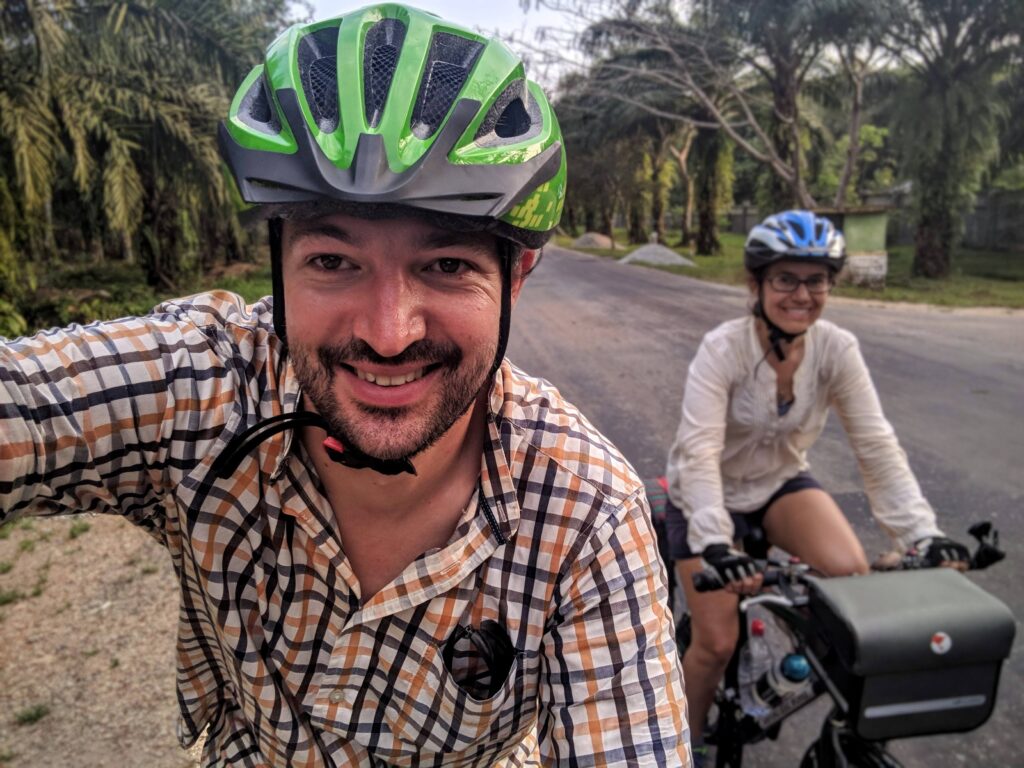
- Meet the Team
- Our Manifesto
- Work with Us
- Budget Travel
- Work & Travel
- Personal Development
- United Kingdom
- More of Europe
- Philippines
- More of Southeast Asia
- More of South America
- More of Central America
- South Korea
- More of Asia
- More of North America
- New Zealand
- Pacific Islands
- More of Oceania
- South Africa
- More of Africa
- More of the Middle East
- Travel Resources
- Travel Gear
Home » Gear » best bikepacking tents
7 BEST Bikepacking Tents of 2024 | Options For ALL Trips and Budgets!
The allure of bike-packing lies in the seamless blend of freedom, speed, and the raw, unfiltered embrace of nature. It’s an odyssey on two wheels, a journey defined by the path less traveled, the pumping of legs and the tent you choose to carry.
A bike packers tent becomes their home and their place of refuge after a long days riding. As you know, the nature of bikepacking trips can mean having to pitch up miles from civilisation and sleeping out in all conditions. But, like tortoises, bikepackers also need to carry these homes with them wherever they go.
As such, the best bikepacking tent needs to be comfortable, durable, easy to pitch and as light as possible in order to facilitate riding. Well the good news that If you’re looking for the best bikepacking tents right now, this list will answer all your questions. We have tried and tested Solo tents, ultralight tents, two and three man tents – whatever you’re after, we got you covered.
On my list of the top bikepacking tents of 2024, I’ve taken into consideration a bunch of different factors to make sure that only the best of the best has made it onto this list — how easy they are to put up, water resistance, price, durability, and more — all to make it easy to find the right bikepacking tent for your travel needs.
I tried a LOT of Bikepacking tents so rest assures that the ones featured here are the very best.
Quick Answer: These are the Bikepacking Tents of 2024
Best bikepacking tents of 2024, #1 – overall best quality bikepacking tent, #2 – best (solo) ultralight tent for bikepacking, #3 – best (solo) budget bikepacking tent, #4 – best 2 person bikepacking tent, #5 – best 3 person bikepacking tent, #6 – best bikepacking tent for the tropics, #7 – best bikepacking tent for europe, buyer guide – how to choose the best bikepacking tent for you, faq about the best bikepacking tents, final thoughts on the best bikepacking tents.
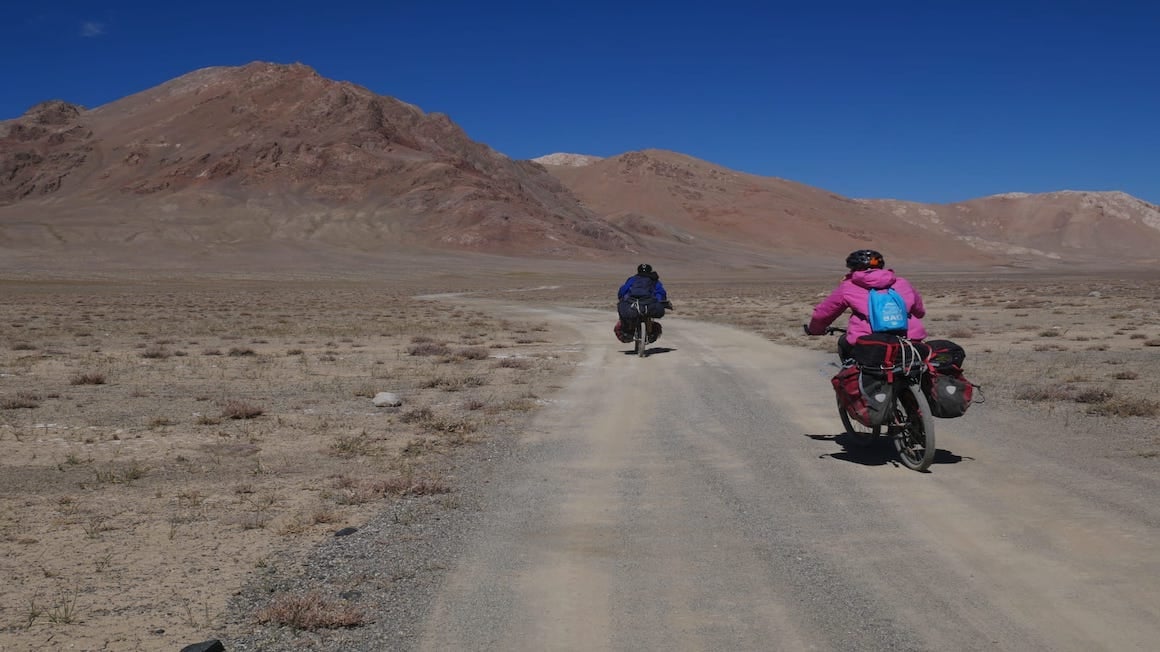
The Broke Backpacker is supported by you . Clicking through our links may earn us a small affiliate commission, and that's what allows us to keep producing free content 🙂 Learn more .
#1 Big Agnes Copper Spur HV UL1 Ultralight Bikepacking Tent – Overall Best Quality Bikepacking Tent
#2 nemo dragonfly osmo 2p bikepack tent – best (solo) ultralight tent for bikepacking, #3 coleman sundome tent – best (solo) budget bikepacking tent, #4 msr hubba hubba 2-person lightweight backpacking tent – best 2 person bikepacking tent, #5 msr hubba tour 3 – best 3 person bikepacking tent, #6 nemo hornet osmo ultralight backpacking tent – best bikepacking tent for the tropics, #7 lone rider mototent – best bikepacking tent for europe.
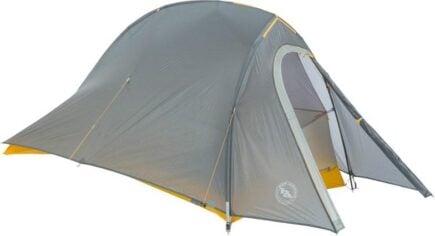
Big Agnes Copper Spur HV UL1 Bikepack Tent
- Price > $499.95
- > Full coverage rainfly
- > Dry entry vestibule
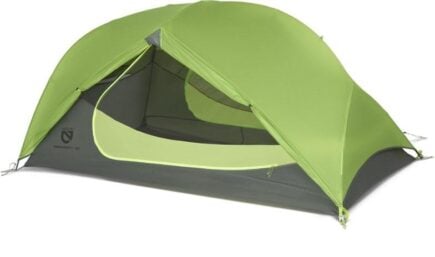
NEMO Dragonfly OSMO 2P Bikepack Tent
- Price > $579.95
- > High arching poles
- > Easy set up
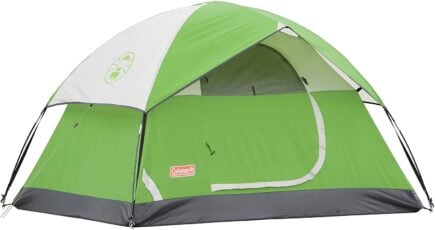
Coleman Sundome Tent
- Price > $89.30
- > It has large door
- > Best for mild conditions
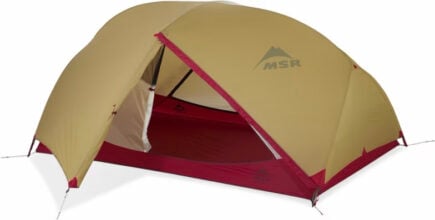
MSR Hubba Hubba 2-Person Lightweight Backpacking Tent
- Price > $549.95
- > 3 year warranty
- > Three-season backpacking tent
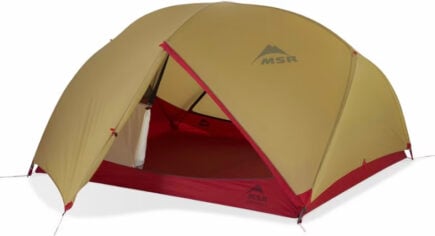
MSR Hubba Hubba 3
- Price > $629.95
- > Plenty of room for three people
- > Massive ceiling pocket & 7 other pockets inside
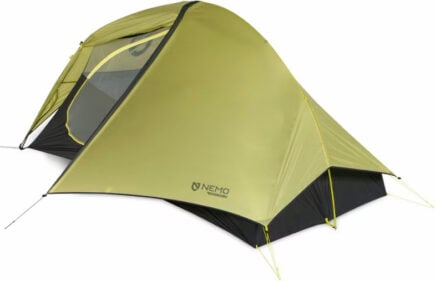
Nemo Hornet OSMO Ultralight Backpacking Tent
- Price > $429.95
- > Designed to be weathertight and rugged
- > Lifetime warranty
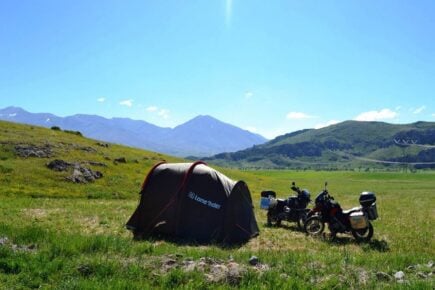
Lone Rider MotoTent
- Price > $599
- > Lightweight
- > 2-year guarantee
Big Agnes Copper Spur HV UL1 Ultralight Bikepacking Tent
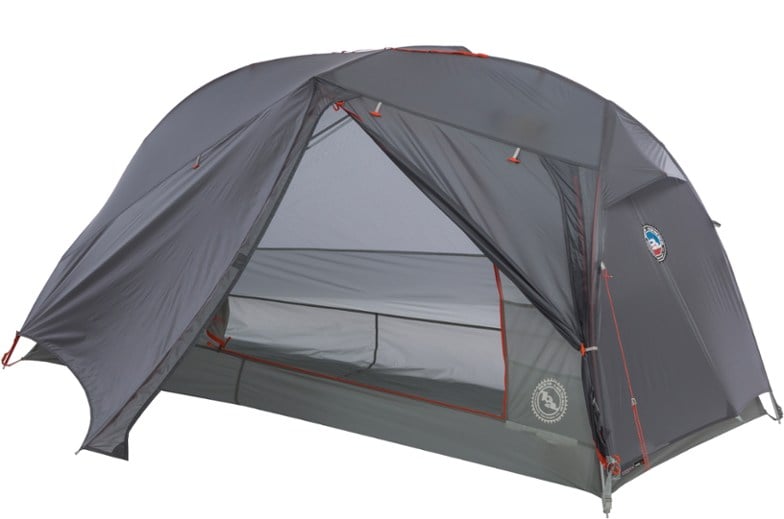
Want a cool bikepacking tent for a European bikepacking adventure ? The Big Agnes Copper Spur HV UL1 Ultralight Backpacking Tent is definitely one that you should be considering, especially if you’re looking for a lightweight tent.
While 2 and 3 person versions are available, for now we’re going to focus on the one-person Big Agnes Fly Creek as we believe it makes the perfect solo bikepacking tent. Though the Big Agnes Fly Creek looks like a simple tent, there are actually a lot of features to this bikepacking tent that we want to shout about so here goes! The tent poles here create an architecture that provides high volume and increases the interior space. The featherlight pole system creates a floor area of 20 square feet, with a head height of 38 inches. For one of the lighter tents on the market, it offers epic storage space.
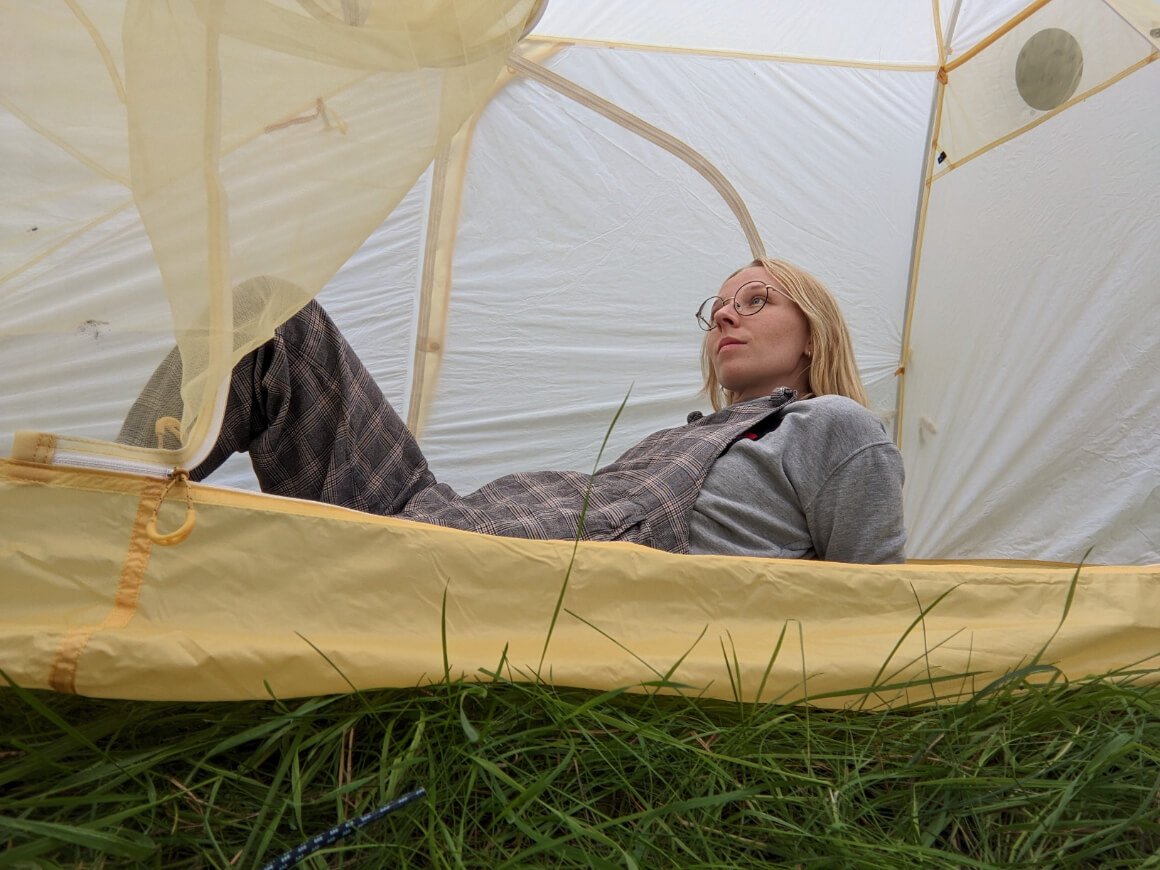
The tent fabric materials are designed to hold up in adverse weather conditions, with a full-coverage rainfly that means you should be sheltered from a storm wherever you happen to set up camp – even in the mountains. There’s also a dry entry vestibule space , which does what it sounds like it might do, keeping your tent dry as you come in and out, but also providing space for you to stash your camping gear.
The packed weight of this top bikepacking tent is a very light 2 pounds 1 ounce, with a super light 1 pound 11 ounces once pitched. It’s the lightest tent on our list, and it’s easy to set up, too. An all-around awesome tent that will provide you with all the protection and comfort you need on your Europe adventure. In short, it’s simply one of the best ultralight backpacking tents there is.
Need more info? Have a look at our more in-depth Big Agnes Fly Creek tent review.

REI is one of America’s biggest and most-loved outdoor gear retailers.
Now, for just $30, get a lifetime membership that entitles you to 10% OFF on most items, access to their trade-in scheme and discount rentals .
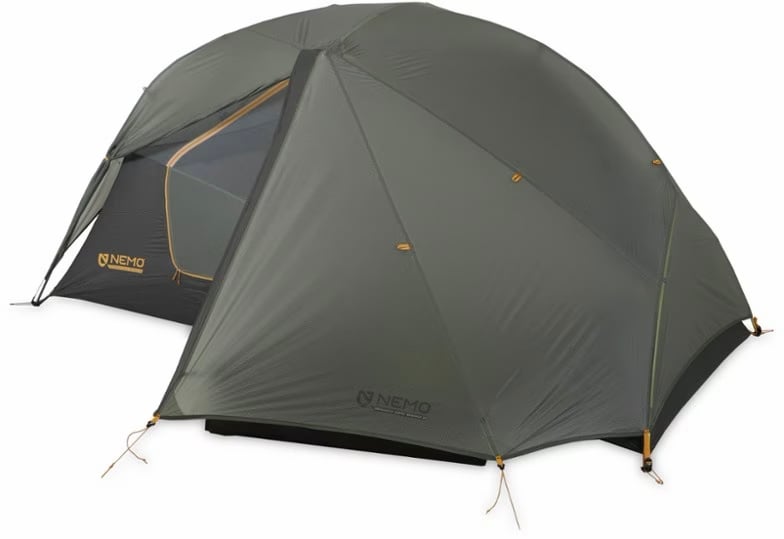
When you’re out on a ride, the last thing you want is to be carrying weight than you absolutely need to and the fact is that tent can really add weight to your load. For this reason we love ultra-lightweight tents for bikepacking trips!
We have tried a lot of differ ultralight tents over the years and consider the NEMO Dragonfly OSMO 2P Bikepack Tent to be amongst the absolute best. It offers a heady combo of lightweight packability along with high comfort levels. This awesome bikepacking tent weighs in at just 2 pounds 1 ounces so you will barely feel it on your bike.
This lightweight model is made from pre-bent DAC featherlight poles making it super easy to pack down to its modest 19.5 x 4 inches. As well as being light, this epic camping tent will fit easily into your frame bag.
Ultralight tents are usually less resilient and durable than other tents as the lighter materials are more sensitive to strains. However, the Nemo Dragonfly is as hard wearing an ultralight tent as there is. This top bikepacking tent is constructed from integrated 20D nylon and 15D nylon ripstop , with waterproof protection and the integrated groundsheet Is also very tough. The canopy is 1200mm waterproof nylon ripstop. The protected strut vents mean humidity can be easily released, too.
It’s actually a very liveable tent ideal for long trips. It’s got high arching poles, for an expansive interior, making it feel quite roomy. You can actually sit up inside the tent (it’s 36″ in height).
There’s also enough room to store your gear and sleeping bag inside, too, as the tent is covered by a large trapezoidal cover – ample room to keep your precious stuff safe, dry and out of the way. It doesn’t block entry to the tent, which is a plus.
The Nemo Dragonfly boasts an easy set-up , which is a godsend. Colour-coded poles make it easy to set up (around 12 minutes) with a rainfly that snaps into place.
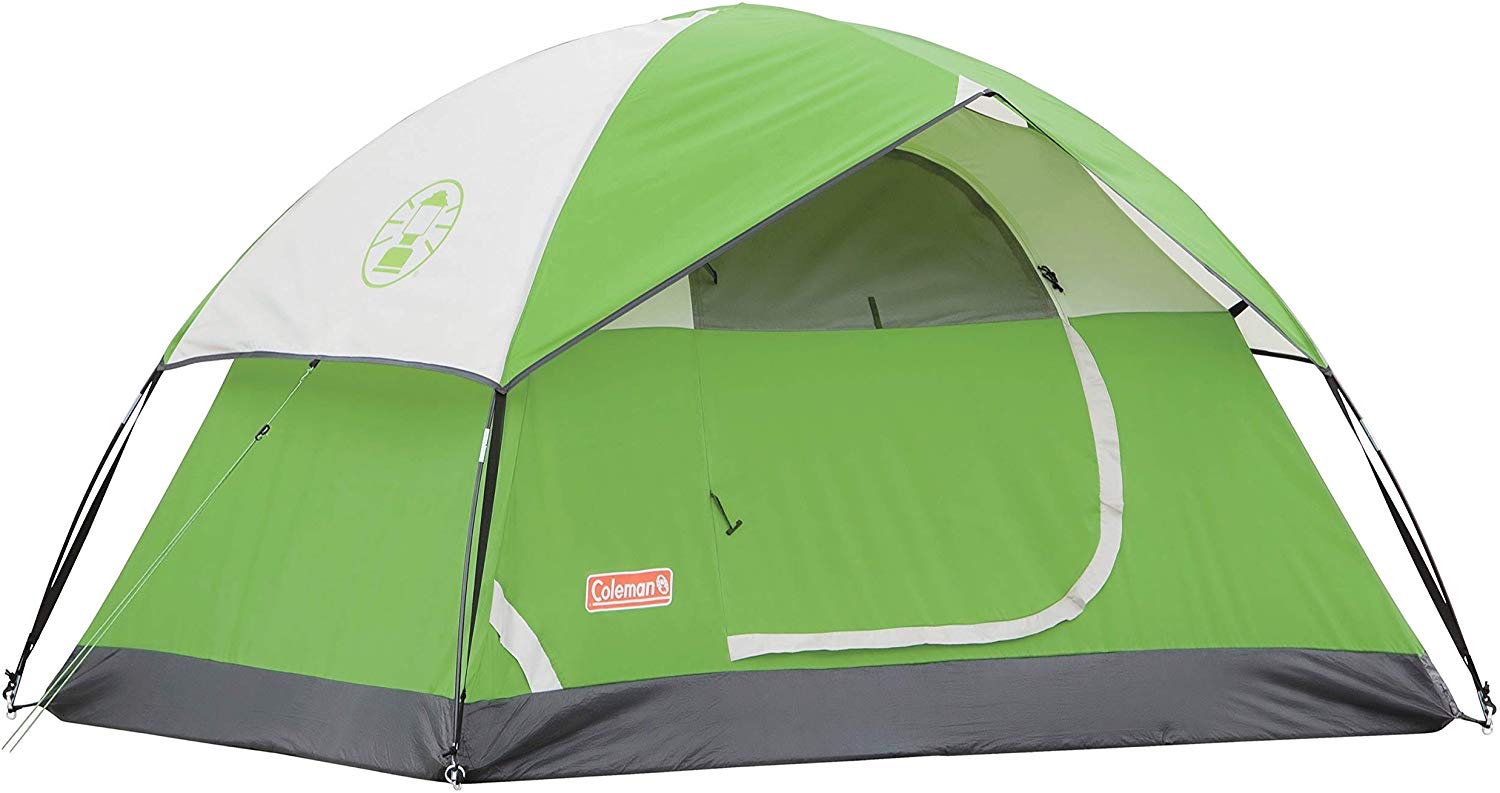
Bikepacking tents generally don’t come cheap. However the Coleman Sundome Tent halves (and then halves again, and then maybe again) the price of most bikepacking tents making it the super budget-friendly bike touring tent option.
You may be thinking, ‘Ok, so it’s cheap, that must mean it’s rubbish.’ And while it is does not perform as well as some other tents in this round up, it’s still a decent piece of travel gear.
Best for mild conditions, this offering from Coleman – depending on which size variation you go for (yes, you have options) weighs in at 7.2 lbs at its lightest and is relatively spacious regardless of which size you go for. It comes in two, three, four and six-man versions.
The tent has a large door, which is nice because no one likes getting tangled up as they try to get settled into their sleeping bag for the night. There’s also a rear hooded window and a hooded fly for extra ventilation. The integrated groundsheet is made of 1000D polythene with welded seams to guard against any leaks; the fly and walls of the tent are coated polyester, meaning they’re durable and shouldn’t let any water in. If you do have to weather a storm in this tent, there are external guy points to keep you stable in high winds.
Not only is this budget bikepacking tent great value for money , but it’s also easy to set up – you should be ready to jump in for some well-deserved rest after around 15 minutes, thanks to the pin and ring pole to body connections. You won’t even have to look at the instructions.
Looking for other reasonably priced tents? Check out our guide to the best budget backpacking tents .
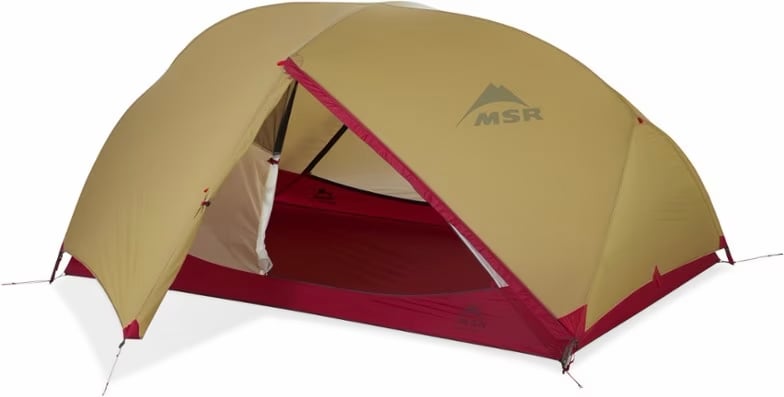
Not all biking tours and cycling excursions are done solo, of course. You may want to hit the road with your mate, or your partner, and if you do that, you’ll want a two-person tent that ensures that you’re as comfortable as can be.
So for the best two-person bikepacking tent out there, we would definitely recommend the MSR Hubba Hubba 2-Person Lightweight Backpacking Tent. This three-season backpacking tent is one of the top tents out there whether for bikepacking or straight up camping.
There is plenty of space for you and whoever to sit inside and share a cup of tea or coffee. The MSR Hubba Hubba is cosy and convenient addition . Size-wise it’s 2.13 metres (84″) in length by 1.27 metres (50″) wide, with room to sleep side by side; the peak of the tent is 1 metre (39″) high. Ample crouching room.
When it comes to rolling up the tent and slinging it on the bike, the dimensions of this awesome bikepacking tent all packed up is 18 x 6 inches – its weight of 3 pounds 14 ounces. You can leave the flysheet or the bottom half of the tent at home for even lighter weight.
The freestanding design of the Hubba Hubba is interesting. This means you get a whole 29 square feet of floor area with no tapering sides stealing away your precious space. There are also two doors on the tent (one for each of you, right?) and an additional 8.75 square feet on either side for storing your all-important gear away from the elements.
On top of all that goodness, the set-up is straightforward (under 5 minutes!) and there’s a three-year warranty , even though this super lightweight tent will no doubt last you for years. You’ll be thankful you got this one!

Do You Want to Travel FOREVER??
Pop your email in below to get a FREE copy of ‘How to Travel the World on $10 a Day!’.
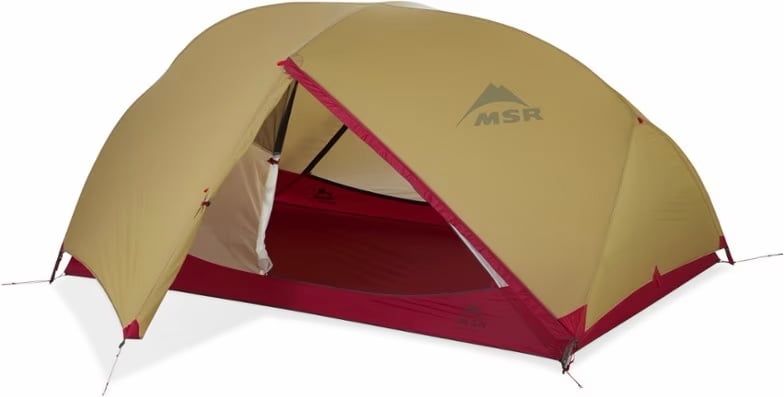
Maybe a two-person tent isn’t enough for you. If you love extra space when bikepacking, or you’re travelling in a group of three, this tent is the one for you!
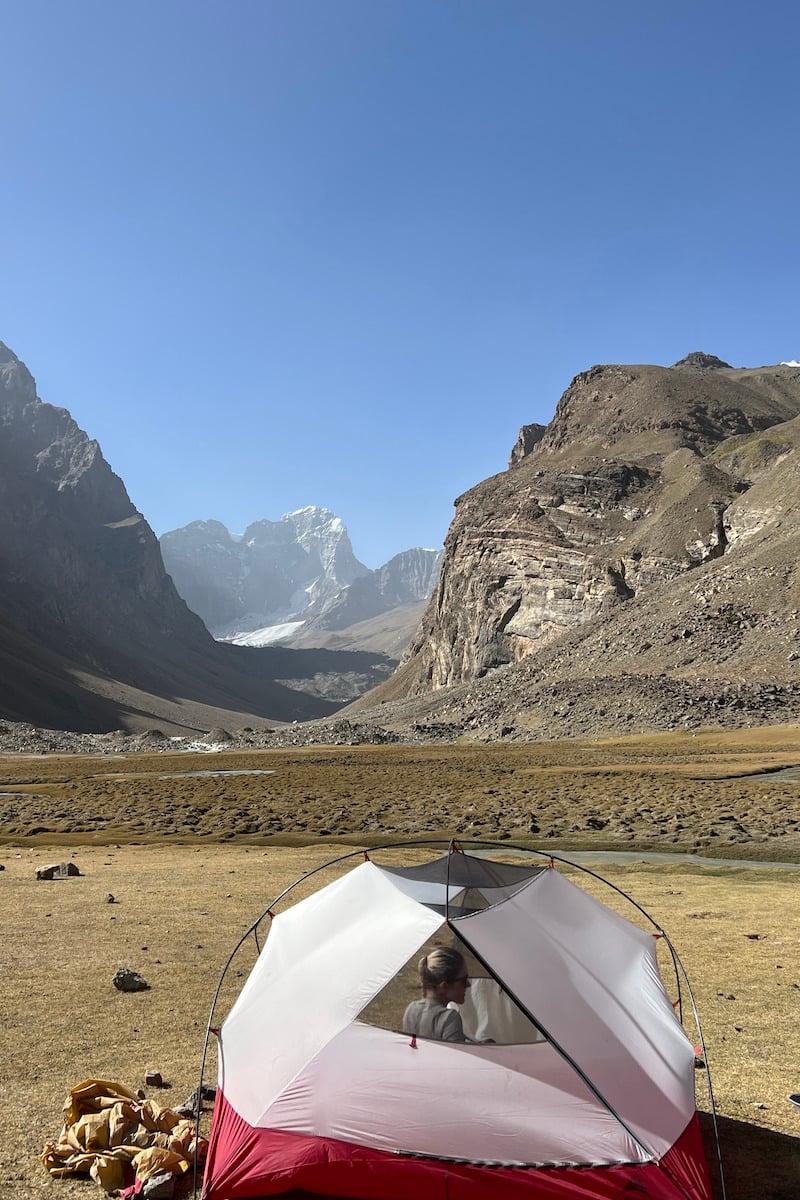
The MSR Hubba Hubba 3 Backpacking Tent really is our top choice for the best 3 person bikepacking tent you’re likely to find at the moment. It’s awesome. Made by the good people at MRS, this tent has been specifically designed for three people in mind – it’s not just a larger version of a two-man tent.
Made for high volume to increase living space without adding weight, the dimensions of this baby are 70 inches by 90 inches, with a floor area that covers 43 square feet – lots of room for everyone in your group to have a good night’s sleep.
This bikepacking tent has one thing we like a lot: steep walls that create a decent amount of living space. Not only that but there’s also room for your gear storage with dual vestibules for keeping your gear nice and dry. There’s also a massive ceiling pocket and seven other pockets inside . We love pockets.
In terms of weight, adding room for one more doesn’t add much to the weight of this tent: it’s a mere 3lbs 7oz. Packed, that’s 6.4lbs with a size of 7″ x 17″. As a fun bonus, it comes in two colourways : a punchy orange and grey combo, and a more muted olive green. Yay.
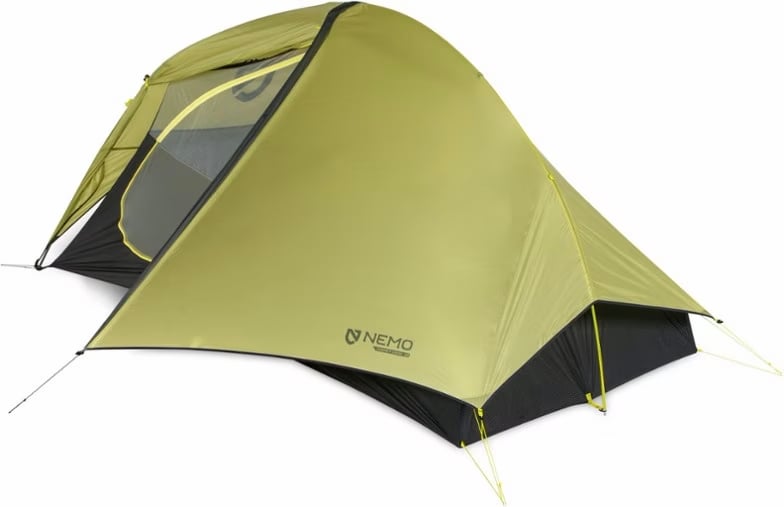
If you’re thinking of a bikepacking tour around Vietnam or Thailand then you’ll want something suited to the hot and humid climate of the region. Less is more when it comes to camping somewhere like this, so the Nemo Hornet Ultralight Backpacking Tent is a bloody good option.
Packing down to a very light (and pretty small) 2 pounds, 19.5 (50cm) inches by 4.5 inches (12cm), it really won’t add much to your kit weight.
This top bikepacking tent for the tropics comes in both one and two-person sizes although we’re focusing on the one-man version for now. It’s got a single vestibule with enough space to keep your precious belongings safe from the elements, be it a downpour or the blazing sun.
Designed to be weathertight and rugged , the Nemo Hornet has a 10D nylon ripstop fly , which makes it durable, water repellent and very light; the canopy, constructed of 10D nylon ripstop as well, has no-see-um mesh to keep those pesky bugs out, but to allow a breeze in (privacy, too). It’s super quick to set up. You won’t have to fiddle around with confusing details and will be lounging inside your tent within minutes.
There are a few nice little added features that we want to talk about – the kinds of things that make your life a little more easy on the road. We like the Diffusing Light Pocket s – slot a torch in here and it becomes a lantern for the tent. There are also guys and struts that pull out the corners, so you and your stuff don’t get covered in condensation. Add to that a lifetime warranty for defects and you have yourself a winner.
Want some more info? Check out our dedicated and more in-depth review of the Nemo Hornet tent .
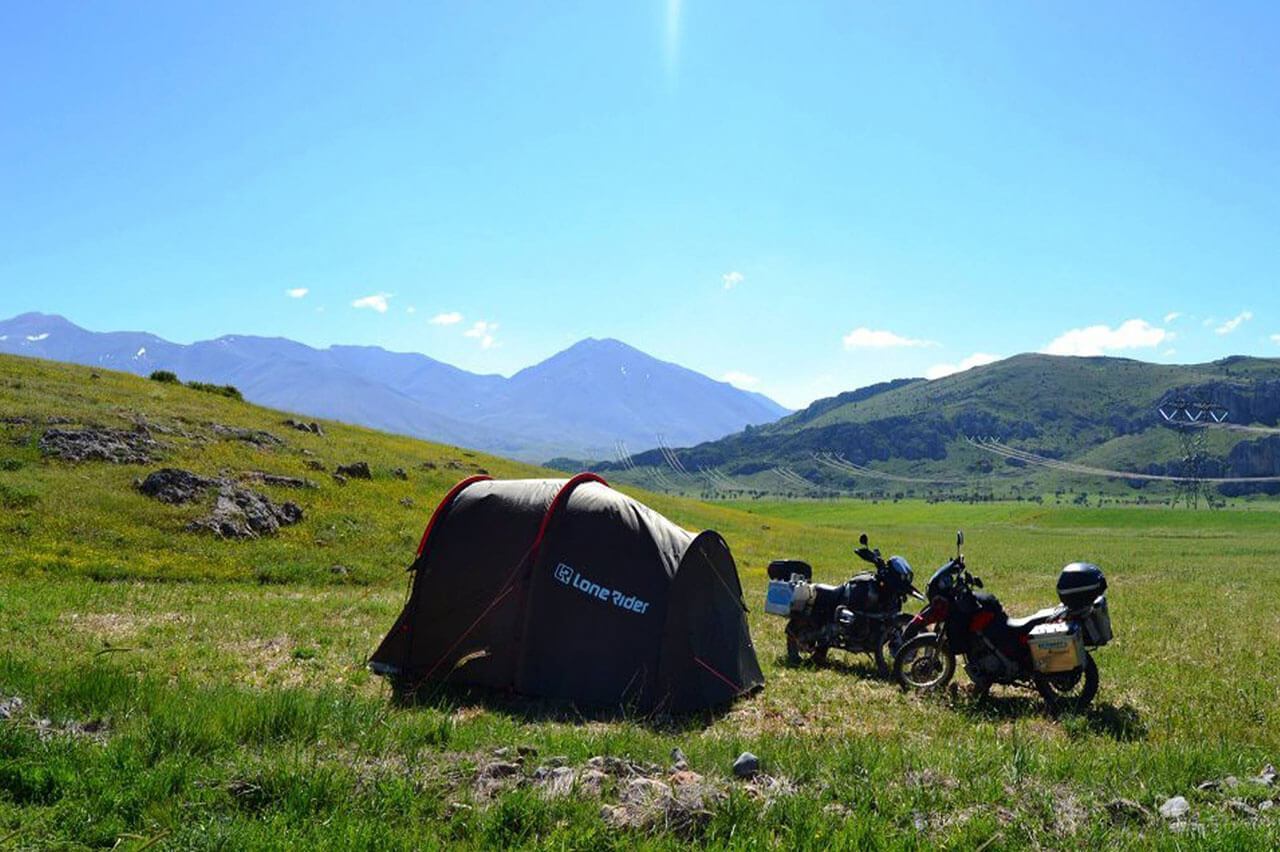
The overall best quality bikepacking tent out there at the moment has to be the Lone Rider MotoTent , for a lot of reasons. Made by bikers, for bikers, the Lone Rider MotoTent is cool because there’s a dedicated space to park your ride inside the tent itself. This means it’s not only kept away from prying eyes, but also from the elements, meaning rain, snow or the sun won’t affect your bike in any way.
There’s enough space for two riders and their gear inside (the porch is 2 metres high – 6’7″ – so you can stand up inside it), with room for panniers as well. The length is 4.15 metres. We love that you can stretch out and keep your stuff dry in this tent!
Though built specifically as a motorcycle tent , it’s definitely possible to use this is if you’re a cyclist, too. Bicycles can be expensive too!
It’s well-built , with a high-quality groundsheet that will keep you dry, and a pretty amazing 7-minute set-up time thanks to colour coded, easy-use pole sleeves amongst other things. It’s also pretty lightweight, weighing in at 5.54kg (12lb), with a bold claim that it’s the lightest tent (with a motorcycle canopy) around.
The lightweight structure doesn’t take away from its durability : it’s got a strong tunnel design that’s constructed of high-quality material, with fly fabric that’s ultralight and UV-resistant with waterproof coating. Even the poles and pegs are made from aircraft-grade aluminium . It’s definitely reliable.
When you want to hit the road again and start the next leg of your adventure, the Lone Rider MotoTent rolls up to a very portable 60 (24″) x 20 (8″) centimetres, so it’ll easily fit on your bike. Last but not least is the 2-year guarantee, which means if your tent should become faulty, Lone Rider will replace it free of charge. Can’t argue with that!

Now, you could spend a fat chunk of $$$ on the WRONG present for someone. Wrong size hiking boots, wrong fit backpack, wrong shape sleeping bag… As any adventurer will tell you, gear is a personal choice.
So give the adventurer in your life the gift of convenience: buy them an REI Co-op gift card! REI is The Broke Backpacker’s retailer of choice for ALL things outdoors, and an REI gift card is the perfect present you can buy from them. And then you won’t have to keep the receipt. 😉
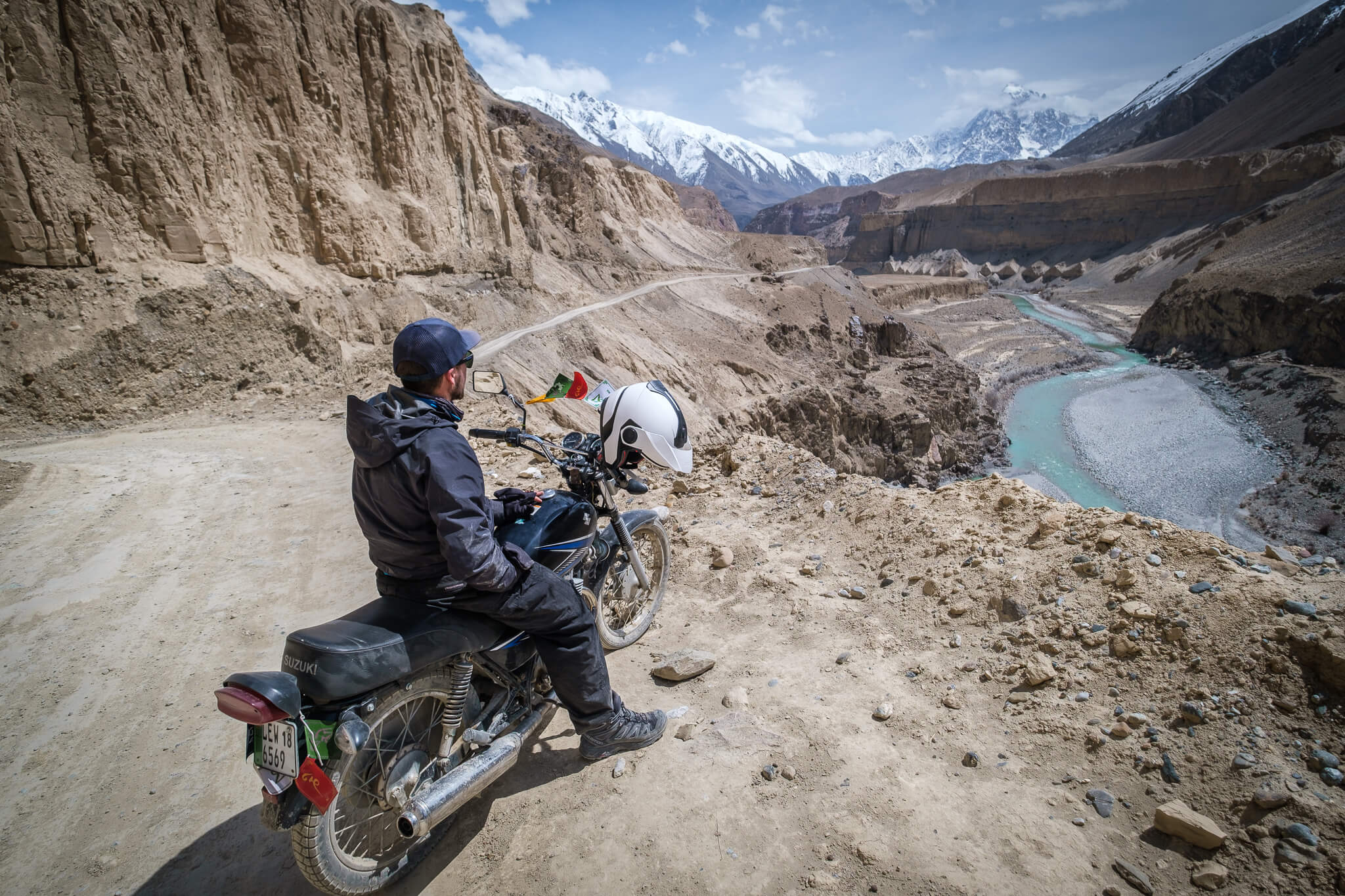
Those were the seven best bikepacking tents going right now, the best you’re likely to find anywhere. But though our handy list puts all these heavy hitters in once place to make it easy for you to make a decision, it’s not always easy to pick the right tent for you. There are a lot of factors to think about.
Don’t worry: as usual, we’re here to help. We’ve put together a handy guide of things to consider when you’re thinking about purchasing a brand new bikepacking tent.
1. Packability
If you’re heading out on the road, not only are you going to be looking for a tent that will keep you dry and safe once it’s set up but one that you will be able to pack away tightly and securely.
There’s no use getting a tent that you can’t pack up and put away onto your bike easily; it will become a hindrance to your trip and that is not what you want at all.
Choose a bikepacking tent that suits how you pack. Do you have a big bag, and don’t mind a bit of extra weight? Then you can afford to go for something larger. If you’re all about keeping extra weight, and space, to a minimum, then something that’s ultralight will be what suits your bikepacking adventure.
Remember, you will want to consider the practicalities of traveling on a bike in each location including having to attach it to buses or ship overland or air, so having a smaller tent can keep costs down in this regard too.
Though tents aren’t exactly well known for being easy to set up, it doesn’t have to be this way! There are a lot of good bikepacking tents out there that are surprisingly easy to set up, making the process of arriving at your destination for the night a relative breeze.
You need to consider what sort of weather you’re be riding in, and what lighting conditions you need to be able to set up a tent quickly. Too many steps and fiddly poles and you’ll just end up frustrated at the end of a long day.
If you’re all about doing speed and getting things done quickly, then you are going to want to focus on looking for a good bikepacking tent that boasts a quick set-up time. Tip : It’s also a good idea to set up your tent in your backyard (maybe a few times) before you set off on your travels, just so you know how it works.
The weight of every piece you pack on a bikepacking trip is important, and as one of the bulkier items you’ll be carrying with you, a tent is certainly no exception.
For that reason, ultralight tents are almost always a good call – especially if you’re also riding a lightweight bike.
However, if you’re only setting out for a few days, or if you’re a relative newcomer to the world of bikepacking, you may not have a need for getting the most super ultra featherlight tent out there, which can run more expensive.
4. Durability
You’re not going to want to fork out hundreds (and hundreds) of dollars for a tent that isn’t worth it’s salt. If you are going to be heading out on adventures a lot with your new bikepacking tent, then you are going to want to choose something that will last.
Value for money is a good idea, that’s for sure, but if you’re racing in more rugged conditions, you might want to splash some extra cash.
If there is a lot of rain and wind in your future, and maybe even rugged terrain, then you should really consider getting something that ticks all the boxes when it comes to weatherproof, durable materials.
If not, you might be ok with a more ‘basic’ tent.
Another thing to consider is the warrantees that a lot of bikepacking tents offer. Two and three years is good, but if you think you’re going to be in the bikepacking game for the long haul, then you may want to consider something that comes with a lifetime guarantee.
It’s an obvious one, but basically, you have to think about two things: the size the tent packs down to (packability) and the size of the actual tent once it’s pitched.
Since we’ve already covered how packability can affect how you choose the best bikepacking tent for you, we’ll focus on the actual size of the tent after it’s been set up.
First of all, you’ll want to think about whether you can stand a one-person tent, or if you want a two-person tent for more room (or if you’re going to be travelling as a couple) – or maybe even a three or four-person might be a good idea for you. It all depends on how many people you’re travelling with – and how much you want to spread out.
If you’ve got a lot of stuff, you’ll either want a big tent, or you’ll want something with a lot of storage space.
Lastly, do you want something with room to stand or are you ok with just sitting? Bear in mind that some bikepacking tents can really be mini. Make sure you check the dimensions thoroughly, as tall people probably won’t enjoy smaller tents!
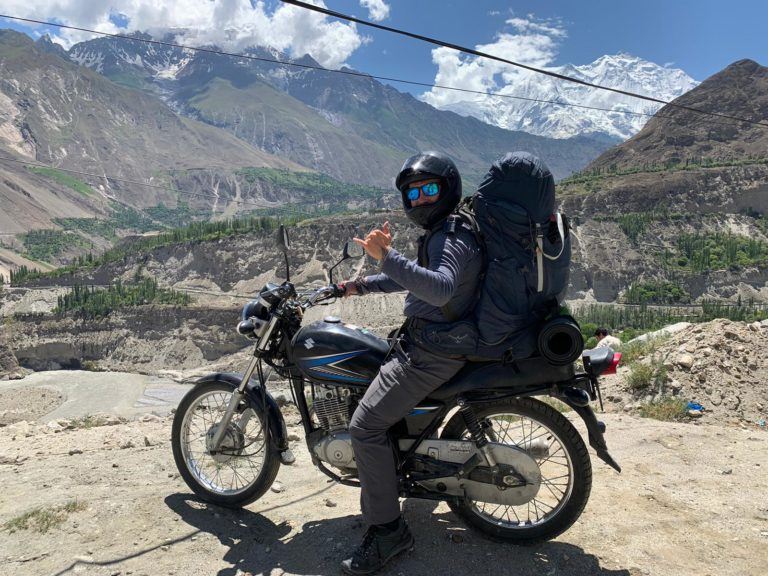
Still, have some questions? No problem! We’ve listed and answered the most commonly asked questions below. Here’s what people usually want to know:
How heavy should a bikepacking tent be?
Ideally, a bikepacking tent should be light so that you could carry it yourself with ease. Luckily, most tents are ultralight nowadays and you can expect a 2-4 pound weight, depending on the size.
How do I choose a bikepacking tent?
Keep these things in mind: 1. Packability and set Up 2. Your budget 3. Size and durability 4. Weight and material
What is the best 1 person bikepacking tent?
We think the NEMO Dragonfly OSMO 2P Bikepack Tent is ideal for solo bikers.
What is the best bikepacking tent on a budget?
A great budget bikepacking tent is the Coleman Sundome Tent . It’s super affordable, yet offers quite a bit of bang for your buck.

Our GREATEST Travel Secrets…
Pop your email here & get the original Broke Backpacker Bible for FREE.
You already know there are so many reasons to go bikepacking . Whatever sort of cycling or motorbike adventure you’re thinking of heading off on, it pays to invest in a bikepacking tent to make sure that your time on the road goes as smoothly as possible. A good tent will definitely be the difference between comfort and annoyance.
We are certain that, whoever you are and however you prefer to travel on your adventures, you will be able to hone in on something on our list of the best bikepacking tents.
There’s a lot to choose from, but we would say that our top choice for the definitive, overall best quality bikepacking tent has to be the Lone Rider MotoTent . That space to store your bike is simply genius.
That said if you don’t care all that much about having a little porch for your bike – and especially if you’re on a budget – a good beginner’s option would be the Coleman Sundome Tent. At that price, this highly reviewed tent is just an amazing purchase.
Let us know in the comments below which bikepacking tent you go for – and tell us if you’ve got a favourite that isn’t on this list!
Hey, carrying a lot of weight on your bike can really make the trip that much more hard work, check the best electric bikes out there if you want to lighten the load on your legs!
You’ll also need a good quality bikepacking bag for your adventure too!
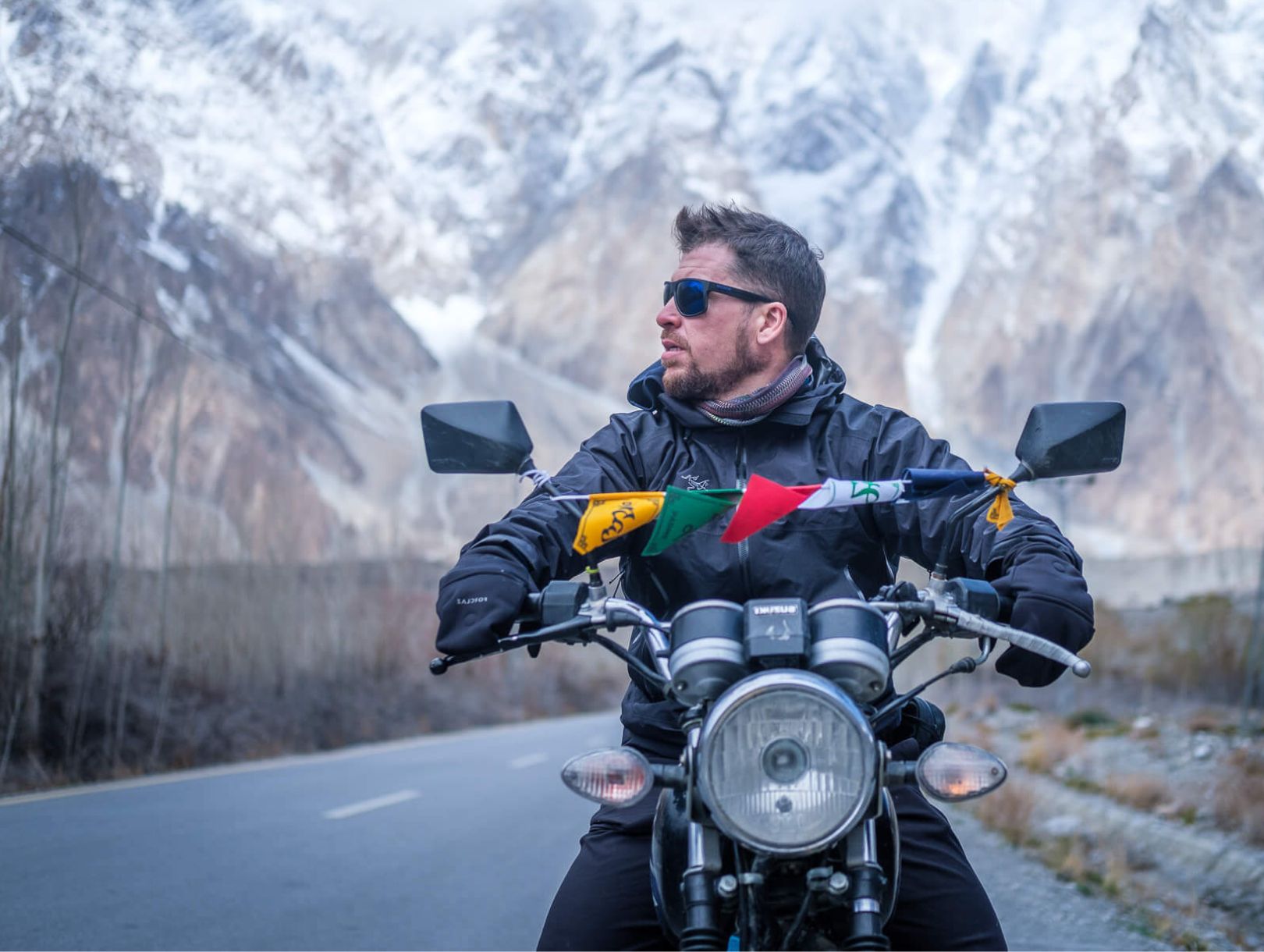
Made it this far? You get 15% OFF to book a place to stay ! Offer valid exclusively for Broke Backpackers 😉

Share or save this post

Leave a Reply Cancel reply
Your email address will not be published. Required fields are marked *
Save my name, email, and website in this browser for the next time I comment.
Notify me of followup comments via e-mail.

- camping gear
13 TOP Tents – Which is the best tent for a bike trip and for bikepacking?

Für evtl. enthaltene Werbe-Links auf dieser Seite zahlt der Händler ggf. eine Provision: Transparenz
What is the best tent for a bike trip and for bikepacking? There is currently a seemingly endless selection of tents on the market. That can be quite confusing! So there are now: Ultralight tents, freestanding tents, tents for 3 or 4 seasons and with or without awning. There are also single and double-walled tents. Some also come with footprints, some without, and certain ultralight tents also come without poles.
In this article you will find a detailed and understandable tent guide. In it you will probably learn everything there is to know about tents. I have written down the knowledge for you in a simple and understandable way.
You will also find an overview of recommended tents from the following categories:
✅ Bikepacking tent : Tents for minimalist bike travel. Here the focus is on low weight and a compact pack size ✅ Tent for bike trip and tent for bike tour : Are tents for (mostly) one or two people and are suitable for short or extended bike tours. The tents are robust, durable and offer comfortable space inside for people and equipment.
With the important topic of price, there are big differences: Premium tents like to cost several hundred euros. Fortunately, there are also very inexpensive TOP tents. For each tent category, I therefore show recommended price tips including their pros and cons. Plus, of course, we take a look at the most popular bikepacking tents and the absolute TOP tents in the tent for bike touring section.
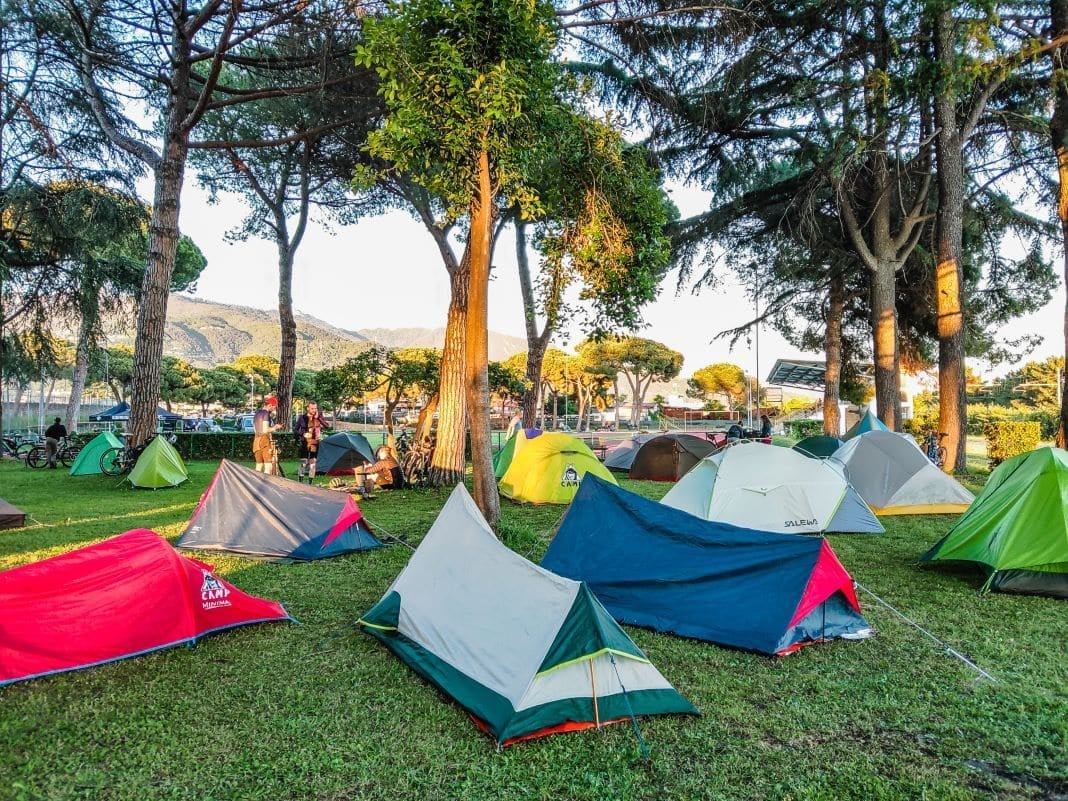
You’re in a hurry? Tent recommendation: MSR Hubba NX
You’re in a hurry? The MSR Hubba NX has proven itself to many bike travelers over the years. It also meets all the above requirements. So my recommendation for the best bikepacking tent and tent for bike touring is the MSR Hubba NX in the green color.

- VienvietÄ— palapinÄ— MSR Hubba NX - Žalia
* Werbung - Aktualisierung am 2024-08-08, Preis kann gestiegen sein, Als Amazon-Partner verdiene ich an qualifizierten Verkäufen, Bild:Amazon
The MSR Hubba NX tent is available in different sizes:
- As a 1-person tent - tent for bikepackers (MSR Hubba NX)*.
- As a 2-person tent - tent for solo bike travelers (MSR Hubba Hubba NX)*.
- As a 3-person tent - Tent for bike travel as a couple (MSR Mutha Hubba NX)*.
I have owned the 1-person MSR Hubba NX myself for 3 years now and am absolutely satisfied with it. It offers the best overall package of small pack size, reliability and robustness and space inside: Even with my 1-person tent I have my 1.84 height enough space to lie stretched out and sit upright. I can still stow some luggage in the tent and the tent has a small vestibule in which two small bike bags and my shoes fit easily. It is also quick and easy to assemble and disassemble.
Some time ago I already created a detailed video test of the MSR Hubba NX:

I bought the tent in 2017 for the Tuscany Trail in Italy. A year later I had it with me on a bike trip from Stuttgart to Istanbul and it still looks like new.
The MSR Hubba NX still convinces me today and it is my current favourite tent. The 1 person version is ideal for me as a minimalist bike traveler or for bikepacking trips. You need more comfort? then the 2-person variant or the 3-person variant is better suited for you.
So the MSR Hubba NX has been convincing me in practice for years. The technical peculiarities are also convincing:
✅ Light weight : Weighs just 1330 grams ✅ small pack size : Ideal as a bikepacking tent. The 2- or 3-person version is suitable as a tent for bike trips ✅ Freestanding tent : So that fast and convenient to set up.
…and much more. I present the MSR Hubba NX in detail in the detailed MSR Hubba NX practical test (test & experiences) .
MSR Hubba NX bei Amazon kaufen*
Now we continue with the ultimate tent selection >>

Determine the requirements for your tent
First, please answer the following question: What kind of bike trip or bikepacking adventure are you taking?
- Do you only need your tent for a few weeks a year for a summer adventure? Or do you want a super reliable tent for a cycling trip around the world?
- Are you travelling as a couple and need a lot of space or are you alone and like to travel minimalistically?
- Do you like to stay at campsites or do you prefer wild camping?
- Are you out in good weather in the summer? Or can it rain sometimes or do you even camp in winter?
So what are your requirements? It is now time to answer these questions.
Have you given it any thought? Super! It will then be much easier for you to find the right tent for you. Read on now
In the last few years, however, I have been watching the market trends at all times. In addition, I was and am on many continents of this world with bike and tent on the road. The following tips ha proven themselves:
- Best tent for bike trip and best tent for bike tour for one person: Free standing, double walled, 2 person tent for 3 seasons, weighs between 1.5 and 2.5 kilos and has an inconspicuous color such as green. Such a tent fits centrally on the luggage rack of a touring bike. The space inside is comfortable: there is enough room for the cyclist and most of the luggage.
- For a couple so two people: A 3-person tent with the same requirements as above.
- best bikepacking tent: For a solo bikepacker, the 1-person variety or alternatively a tarp or bivy sack is suitable.
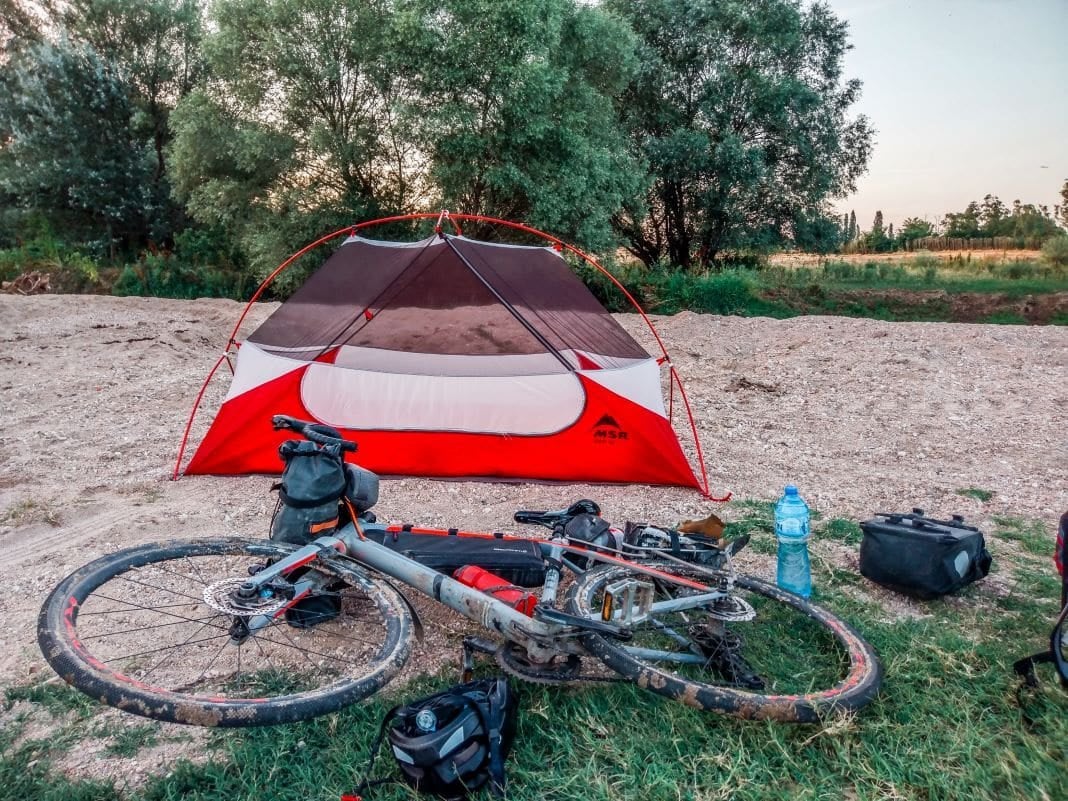
13 TOP tents for bikepacking and bike trips
So I’ve been doing a lot of research. Also, the list is based on my years of experience with different tents. In the process I found 10 tents that are very interesting. Also, I always keep the list up to date. The tents are suitable for bikepacking and also for normal bike trips and for a bike tour.
We start with cheap and simple tents. These are especially suitable for shorter trips and for bike tours in good weather. Then we work our way slowly. To tents that can withstand cycling trips across continents and are even suitable for a cycling world tour. These tents are therefore also suitable for cycling trips lasting several months or years. The list also includes recommended bikepacking tents. These are particularly light and have a small pack size. This means that they can be stowed directly in the frame bag or in the handlebar roller.
For all recommended tents I have also linked you directly to an online shop. This means you can order tents online immediately and have them conveniently delivered to your home.
You miss a tent or have an insider tip? Then feel free to drop me a comment.
Tent for bike trip and tent for bike tour – the TOP 5
The tents in this selection offer a particularly good mix of weight, space and price. These tents are also about weight. However, particular emphasis is placed on the space available. In this category good tents are already very inexpensive to have. So there is also money left over for the trip 😉 with these features, the tents are suitable for many travelers and are the ideal choice as a tent for a bike trip and bike tour.
Tent for bike trip – Overview

* Werbung - Aktualisierung am 2024-08-09, Preis kann gestiegen sein, Als Amazon-Partner verdiene ich an qualifizierten Verkäufen, Bild:Amazon
MSR Elixir 2

Weight: 2.77kg Pack size: 51 x 17 cm Water column (outer tent, floor): 1,500mm, 3000mm Features: since 2018 with more space
The Elixir is one of MSR’s newest tents. The space is intended for 2 people. MSR officially promotes the Elixir 2 as a backpacking tent. This results in a great advantage: the tent has particularly large vestibules on both sides. They’re actually for backpacks. Large bike bags and equipment fit of course just as well underneath 😉 the weight is 2.7 kilos. As a tent for a normal bike tour, the weight is therefore perfectly fine and the equipment is just right for a tour for two.
The price of the MSR Elixir 2 is particularly interesting for a high-quality brand tent: the tent costs just over 200€ at well-known online retailers.
MSR Hubba Hubba NX

Weight: 1.72 kg Pack size: 46 x 15 cm Water column (outer tent, floor): 1200, 3000mm Features:
The MSR Hubba Hubba NX is one of the most popular tents for bike travel and is also great for a bike tour. There are also many bicycle travellers who tour the world with a tent. The tent has also been my favorite bikepacking tent for a few years now. Here you can find my extensive MSR Hubba NX field test . The popularity of the MSR Hubba NX has several reasons:
The MSR Hubba Hubba NX is lightweight yet very durable. MSR has continued to develop and improve the tent over the years. There are also two colors: white and green. In order to remain undetected when wild camping, I bought the green version myself.
In the MSR Hubba series there are different tents for different requirements:
- The Hubba NX is the ideal bikepacking tent – because it weighs only 1.12 kg.
- The Hubba Hubba NX offers plenty of space for a solo bike traveller: With 2 vestibules, there is also plenty of space in front of the tent for gear
- For a couple on a bike tour, the Mutha Hubba NX is the ideal tent for the bike tour: it also weighs only 2.3 kg
Change Pathfinder TL
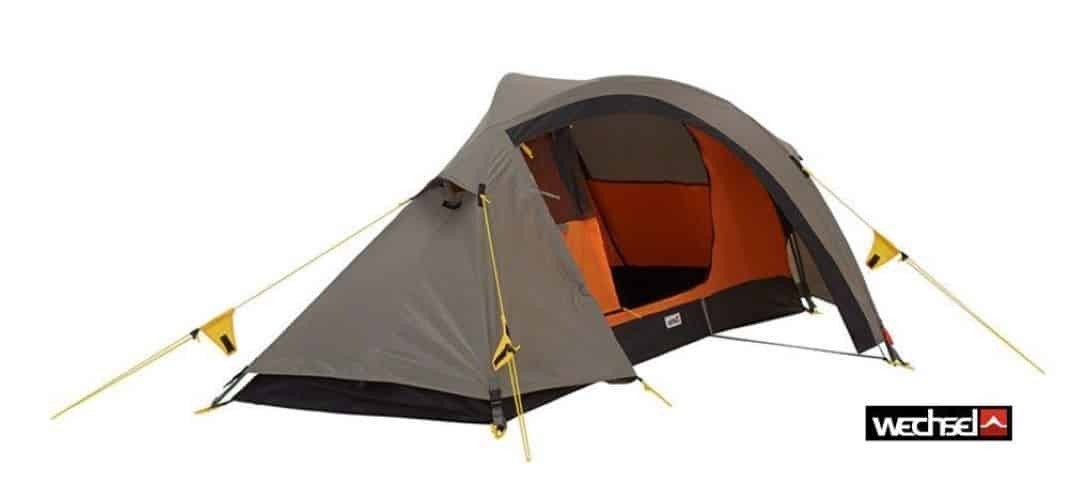
Weight: 2.3kg Pack size: 45 x 15 cm Water column (fly, groundsheet): 5000mm, 7000mm Features: suitable for tall people
The Wechsel Pathfinder is a 1-person tent with extra space. The Pathfinder weighs only 2.3 kg – that’s light for the “tent for bike touring” category. So what does the tent offer? With a length of 2.35 in the inner tent, the Wechsel Pathfinder is especially suitable for tall people. The water column is 5000mm for the outer tent and 7000mm for the tent floor. The height of 75cm is rather low, but with a maximum width of 94cm the tent offers a lot of space for equipment inside. The tent is also free-standing: a great gain in comfort that also saves time during pitching and dismantling.
The price of the Wechsel Pathfinder is unbeatable and therefore the tent is the price tip in this category.
Salewa Denali II
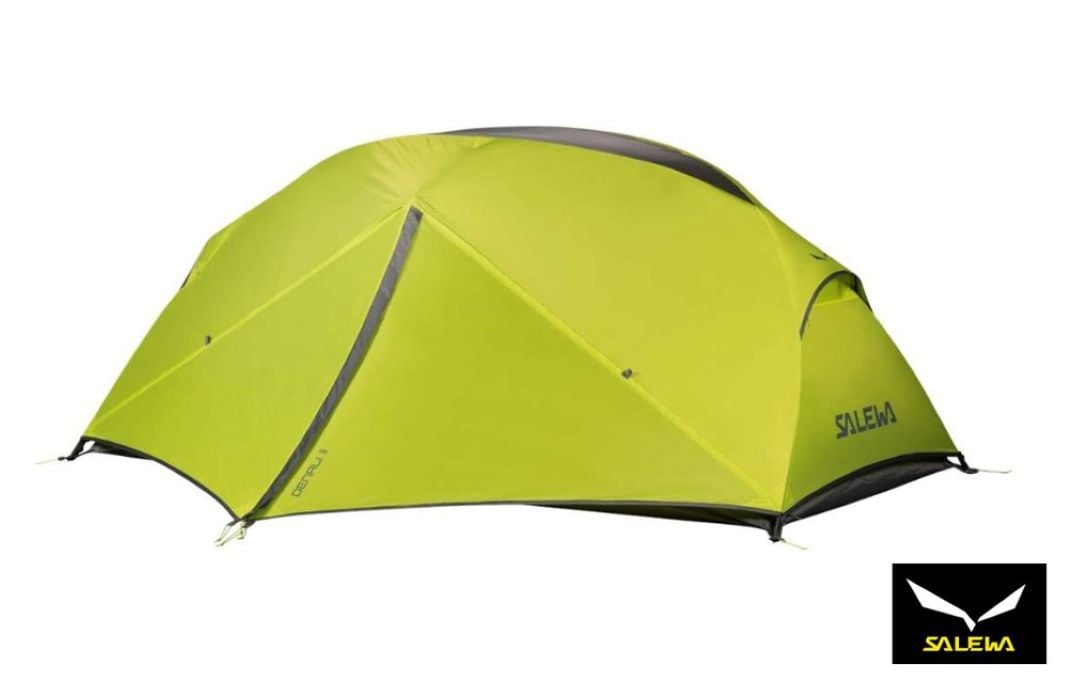
Weight: 2.63kg Pack size: 47 x 20cm Water column (fly, groundsheet): 3000mm, 5000mm Features: Self Standing, Classic
Salewa is a traditional tent builder and brings a lot of experience to the table. The company is known for very good tents. On the one hand, the Salewa tents offer high quality – but are also somewhat heavier.
The Salewa Denali II is nevertheless an attractive tent: it is free-standing, weighs 2.63 kg and is very attractively priced. Thus, the Salewa Denali II is definitely an interesting tent. Especially if you are looking for a reliable tent for a longer bike trip.
The technical data is convincing: The space inside is ample and very comfortable, especially for one person. The length of the lying surface is 2.10 meters. At 1.10 metres in width, there is plenty of room to lie down and carry extra equipment. The seat height is a comfortable 1.05 metres. So you can stay in the tent even longer in bad weather.
I don’t think the yellow colour is ideal: it only attracts unnecessary attention when wild camping.
Nordisk Finnmark 2 SE
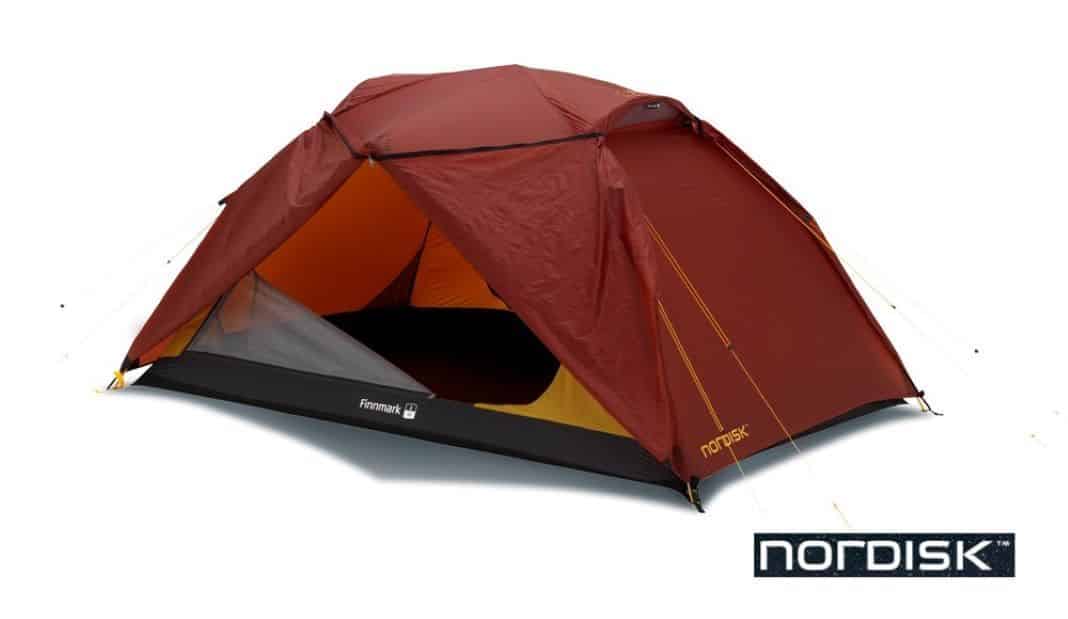
Weight: 3.0kg Pack size: 15 x 50 cm Water column: 3000mm, 10000mm Features:
With the Nordisk you really get a lot of tent for the money: It is a 2-person tent and offers 1.15 metres seat height, 1.50 metres width and 2.30 metres length for the lying area. The ideal tent if you are going on a bike tour as a couple and want a bit more space.
The weight of 3 kg is a good value for a tent with such ample space. As I said, a great tent for those who want a little more space.
Bikepacking tent – the TOP 8
These are the most interesting bikepacking tents. No bikepacking tent on this list weighs more than 1.23 kilos and the lightest comes in at a featherweight 798 grams. Exceptions are the price tips. Here the weight is a little higher. It is often astonishing how resistant the tents are despite their lightweight construction.
A good entry-level bikepacking tent is also available for really cheap. For several hundred euros you get tents from the top class. Many of these tents are designed specifically for bikepackers or have a good reputation in the bikepacking community.
Some of the tents recommended in the list above (tent for bike trip and tent for bike tour) I mention here again. These are then mostly weight-reduced versions of the upper tents or it is simply the 1-person tent instead of the 2- or 3-person version.
Overview – Bikepacking Tent
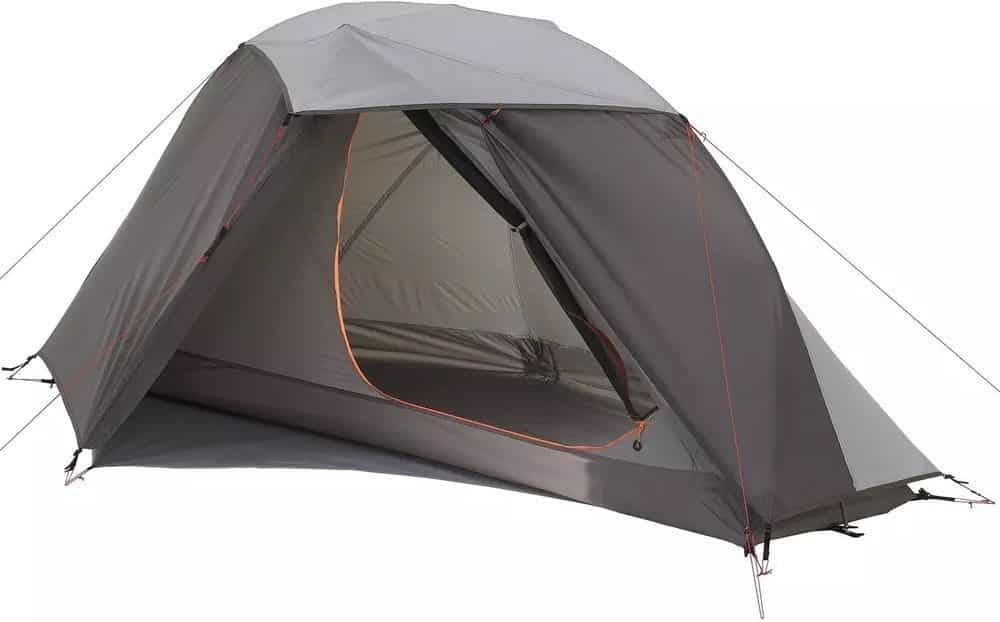
MSR Hubba NX
Weight: 1.12 kg Pack size: 46 x 15 cm Water column: 1200, 3000mm Features: 3 seasons
The Hubba NX is MSR’s best-selling 1-person tent. This tent has been my absolute favorite for several years and I’ll tell you why right now. Before that, a quick note: The Hubba NX is also available as a 2-person tent and is then called Hubba Hubba NX. In any case, I am not the only one who is convinced of the tent: Many cyclists have already made world tours with these tents.
The tent is a 3-season tent and weighs just 1,120 grams complete with all the trimmings. Say: The tent, all the poles and the pegs. A Footprint thus a ground protection tarpaulin I recommend to buy in any case still in addition. However, this only comes to a few grams.
The tent is free-standing and can therefore be erected without tensioning. It is still stable in up to medium-strong winds. If the wind then becomes very strong, the tent should be braced. The ventilation is excellent and also the weather resistance I can confirm: Even in heavy rain, water never came through the tent wall or even the tent floor.
The seat height is 90 centimetres and the reclining width is 76 centimetres. To illustrate: With my 1.84 meters I lie quite relaxed and stretched out in the tent and still have room and a small backpack to accommodate. The rest of the luggage then goes under the vestibule. Check out my extensive MSR Hubba NX field test for even more details on this top bikepacking tent.
The tent was simply very well thought out by MSR: The MSR Hubba NX is a really good tent with many strengths and no real weaknesses.
The MSR Hubba NX is definitely worth the price.
To the detailed MSR Hubba NX field test (test & experiences)
MSR Carbon Reflex
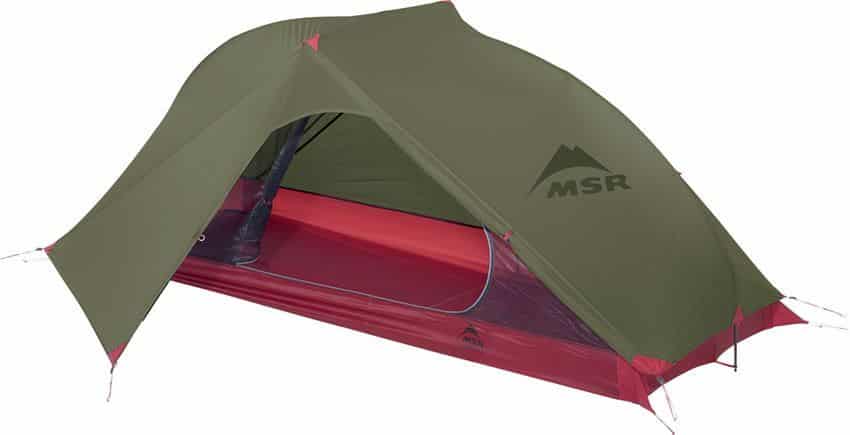
Weight: 798 grams Pack size: 43 x 13 cm Water column: 1200, 1200mm Features: 1 person, 1 entrance & vestibule, UL 7D fabric.
At just 798 grams, the MSR Carbon Reflex 2 is significantly lighter than the Hubba NX. It’s also MSR’s lightest, double-walled tent. To achieve the weight, MSR has used quite thin material: 7D fine material is used for the outer tent. The floor is made of 15D Ripstop Nylon, a slightly stronger material. although the outer tent as well as the floor have a water column of 1200.
There is no zipper at the entrance. A velcro fastener and two hooks are used. Very weight-optimized. The head height of 81 cm is low, as expected. Experience shows that the carbon frame is one of the weak points of the tent.
Naturehike New Cloud Upgrade

Weight: 1,550 grams Pack size: 45 cm x 12 cm Water column: 3000, 3000mm Features: 1 person, 1 entrance & Apside
Probably the most popular replica of the MSR Hubba NX is the “Naturehike New Cloud-Up” or also “Naturehike Cloud-Up upgraded”. The Chinese company has done a really good job here:
For just over 100€ you get a reliable tent with very similar features: The weight is with 1,550 grams about 250 grams heavier than the MSR tent. Otherwise, the workmanship of the zippers is not quite up to the original.
Of course, the Cloud-Up is also freestanding, but you have to unhitch it a little earlier than the MSR Hubba NX. Very pleasing: The high water column of 4000mm for the tent floor and the outer tent. In addition, the scope of delivery also includes a footprint. The buyers on Amazon seem to be very satisfied with the tent. I have also seen the tent live once at friends and could convince myself of the quality. Definitely a price-performance tip.
Naturehike Neues Cloud-Up Upgraded auf Amazon kaufen*
Decathlon Forclaz Trek 900 Ultralight

Weight: 798 grams Pack size: 40 x 12 cm Water column: 4000, 5000mm Features: 1 person, 1 entrance & vestibule, UL 7D fabric.
The Decathlon Trek 900 is another price tip in the bikepacking tent category. The Trek 900 can be bought online at Decathlon for about 120€.
For the price, the Decathlon Trek 900 offers a surprising amount of advantages and has hardly any weaknesses. In principle, it is largely a replica of the excellent MSR Hubba NX.
With a weight of about 1,600 grams, the tent is about 200 grams heavier than the MSR Hubba NX, which is more than twice as expensive. The packing dimensions are 40x12x12 and are absolutely fine.
For a lightest bikepaking tent for one person, you can also be comfortable inside: 95 cm high. Inside you have 60 centimetres of space on the head side and 50 centimetres on the foot side. As usual with a lightweight tent, the sides are not exactly spacious. You should still be able to fit some gear in the tent. If the space requirement is larger then the tent also has a vestibule.
Fortunately, a footprint and a repair kit are included in the delivery.
To the detailed Forclaz Trek 900 Ultralight practical test (test & experiences)
Vango F10 Helium UL 1
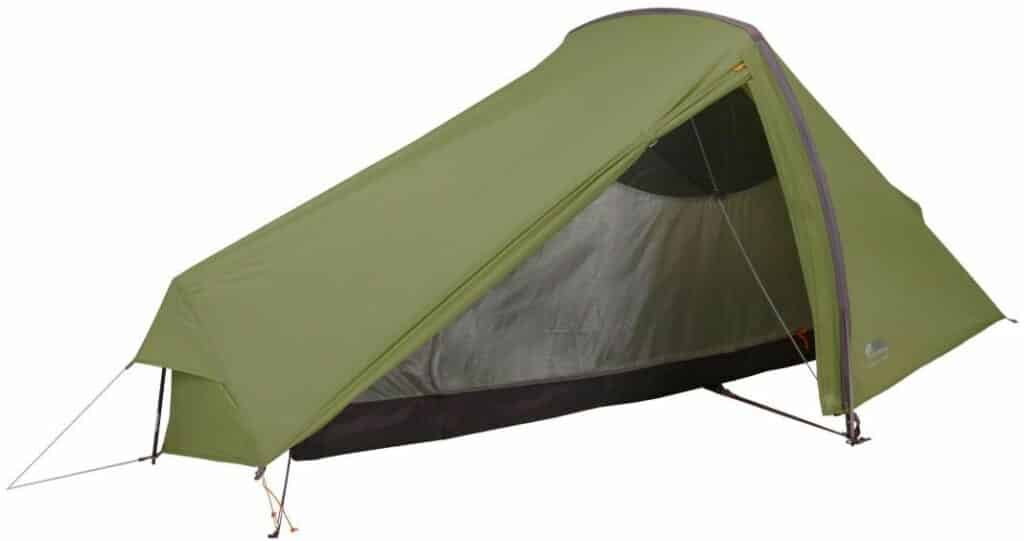
Weight: 1.23 kg Pack size: 43cm x 9cm Water column: 3000mm outer tent, 6000mm floor Features: 1 person, 1 entrance & vestibule, UL 7D fabric.
The Vango F10 Helium has almost all the features you could want in a bikepacking tent. The price remains pleasantly low. Good reasons, therefore, to take a close look at the tent:
The Vango F10 Helium offers extra head and legroom. The outer tent is made of 15D nylon. The base plate is made of particularly robust 70D nylon. This also results in a high water column of 6000mm for both the outer tent and the tent floor – in addition, all seams are factory-taped and therefore waterproof. A footprint is not included, but can be purchased as an accessory.
The interior dimensions promise great space for a 1-person tent. There is space for equipment on both sides: on one side, a triangular area has been added to the inner tent for storage space. There is an apse on the other side.
Big Agnes Fly Creek HV UL1
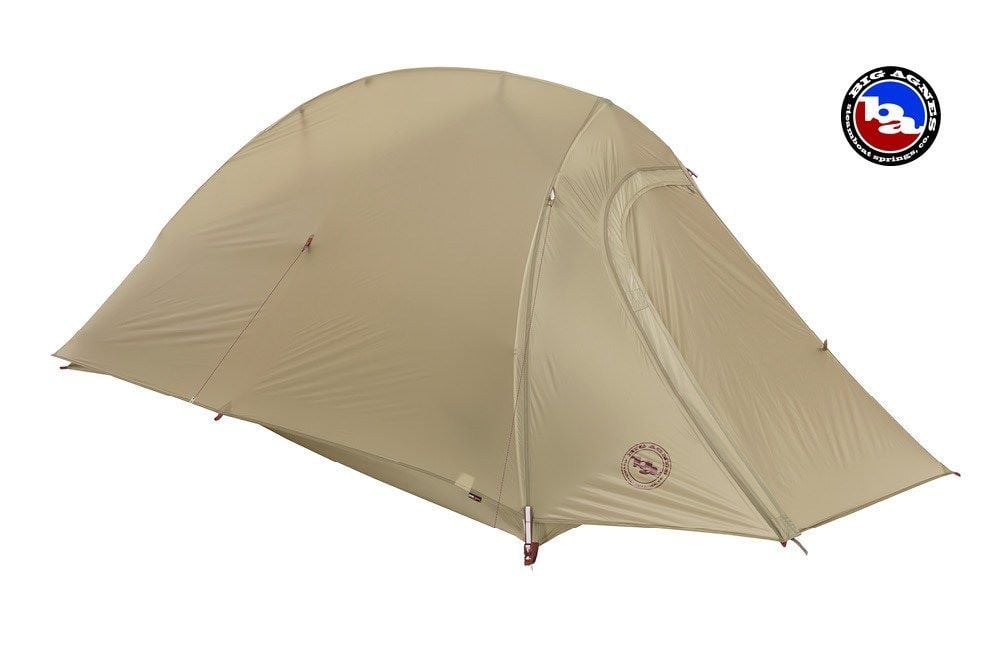
Weight: 0.98 kg Pack size: 48 x 10cm Water column: 1200, 1200mm Features: super light, 3 seasons.
Big Agnes is especially popular with bikepackers and backpackers in the USA. The most popular models are now also available from us. Anyway, there is a whole range of interesting tents from Big Agnes. These combine light weight with a pleasantly large amount of space. Ideal bikepacking tent therefore.
To be sure, the Fly Creek is not completely freestanding. On the other hand, it is particularly light with a total weight of 980 grams. We are dealing with a 1 person and 3 season tent here. The price of about 330 euros is also very fair for what is offered.
There are also 2- and 3-person models of the Big Agnes Fly Creek HV. The 3-person model is still pleasantly light at 1.5 kilos. It is therefore particularly suitable for cyclists with a large space requirement, who nevertheless attach importance to a lightweight tent.
By the way, the addition HV in the product name indicates the revised version of the Big Agnes Fly Creek. In the new HV model, the tent walls have been pulled up more steeply. This makes better use of the indoor space.
Big Agnes Copper Spur HV UL1

Weight: 1.13 kg Pack size: 42 x 10cm Water column: 1200mm, 1200mm Features: very light, 3 seasons.
Another Big Agnes tent in the bikepacking tent category. Compared to the Fly Creek, the Copper Spur is completely freestanding. With a total weight of 1.5 kilos, the tent is still pleasantly light.
As is often the case with freestanding tents: With the Copper Spur, the inner tent can be pitched independently of the outer tent. This optimises ventilation and the view on hot summer nights. Or the outer tent is used as a tarp without the inner tent to save a few more grams. Can also be used for
There is also a 2-person and a 3-person model of the Copper Spur. The weight is then still absolutely within the framework and the space is of course comfortably large.
The same applies to the Copper Spur: the HV suffix in the name identifies the revised version of the bikepacking tent. The tent walls rise more steeply, which increases the space available in the interior.
Nordisk Telemark 2 ULW
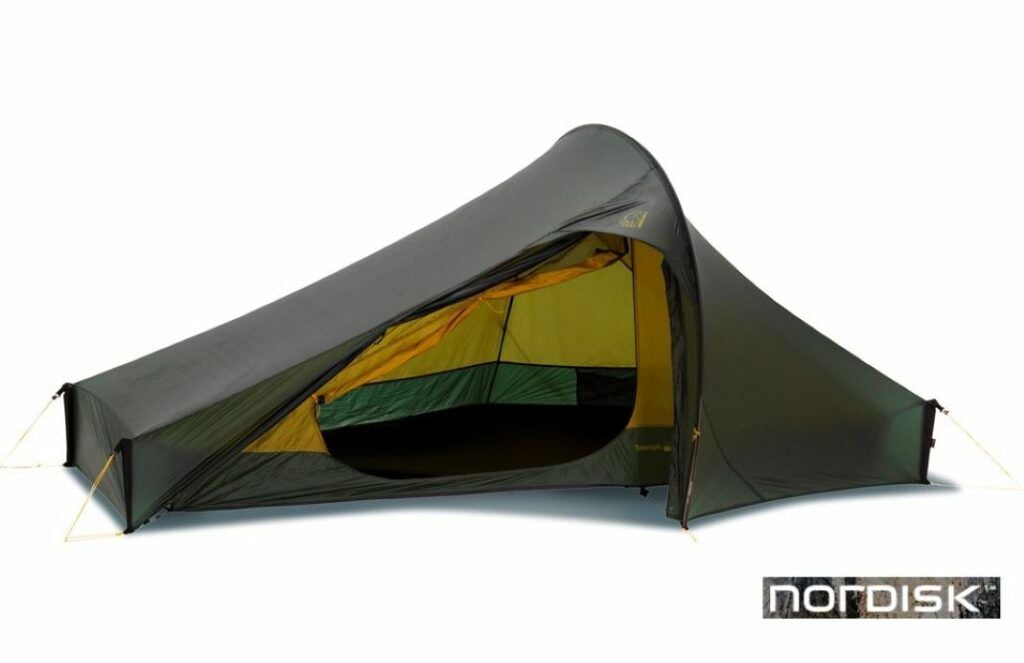
Weight: 0.88 kg Pack size: 41 x 12 cm Water column: 2000mm, 2000mm Features: received multiple awards & Design Award
The Nordisk Telemark 2 ULW has received several awards for its special design. It’s also incredibly lightweight at just 880 grams. For a double-walled tent, that’s a house number. Officially, the Nordisk Telemark 2 ULW is a 2-person tent. However, I recommend using it for only one person.
Then you can also be pleased about the large amount of space: Luxurious 1 metre seat height and 1.02 lying width are offered. Thus also still another some equipment in the tent comes under.
At around 600 euros, the bikepacking tent is not exactly cheap. If you’re looking for a tent that’s both high-quality and lightweight, you should definitely check out the Nordisk Telemark 2 ULW.
Ultralight tent – The TOP 5
Overview – ultralight tent, guide – tent for bike travel and bikepacking tent.
So by now you know what you need your tent for and I have introduced you to the most suitable tents currently available. In this guide, we delve deeper into the topic of bikepacking tents and tents for bike touring.
Important questions before buying a tent
Some important aspects should be considered before buying a bikepacking tent and a tent for bike travel. Let’s get the main points straight. I also give my own practical experience on each point.
Single and double-walled – the type of construction
A single-wall tent, as the name implies, consists of one wall. In such a tent you are less well protected from the weather, insects and dirt. You can also come into direct contact with condensation on the tent wall.
A double-walled tent offers many advantages in comparison: The outer tent provides weather protection and ventilation. The inner tent offers protection from insects, the weather and dirt. In addition, one is much better protected from condensation inside.
In comparison, a double-walled tent therefore offers many advantages. In return, it is about 200 grams heavier. You also lose about 5 inches to each side through the inner tent. In summary, a multi-wall tent offers many clear advantages. Most travelers can certainly get over the slightly higher weight. For most cyclists, therefore, a double-walled tent is probably the best choice. Only if every gram is important, a single wall tent could be an alternative.
With many tents, the inner tent and outer tent can be pitched and packed separately. This opens up many possibilities:
- Building the outer tent without inner tent: Opportunities especially in dry areas without insects. You save weight and have more space.
- Pitching the inner tent without the outer tent: Recommended in Hot regions, indoors, under canopies or even indoors. The inner tent serves as mosquito protection. In addition, one has a better ventilation which can be especially pleasant in hot areas. The view of the starry sky is also free.
- In the event of rain, pack and transport the wet outer tent separately from the dry inner tent.
Type of guy: freestanding or guyed?
Some tents are free-standing, i.e. you do not have to tie them down with a peg. They stand by the tension of the tent poles alone. For even more stability, these tents can be additionally braced with tent cords and pegs. Dome tents and geo tents are representatives of the freestanding category.
Note should be taken: On stony ground or if the ground is too soft or too hard, then no herring holds. Nor indoors. In such a case, a free-standing tent is worth its weight in gold. In addition, you don’t have to unpeg the tent, saving you time and effort.
Free-standing tents are also usually quicker to erect than non-free-standing tents. Especially in rainy weather and at the end of an exhausting day an uncomplicated tent has advantages.
Free-standing tents are usually about 200 grams heavier than non-free-standing tents.
The ideal tent should weigh as little as possible. When you carry less weight on your bike, you move faster and easier – and riding is more fun. At the latest when you have to push or carry the bike, you know what I mean.
Modern tents can be incredibly light. So the best tent for a bike trip should be as light as possible. This is especially true for bikepackers.
The ideal tent for bike trips should have the smallest possible pack size. Then it takes up less space in the bike bags. The sticking point when it comes to tent packing dimensions are often the tent poles: These are the longest items. Unfortunately, especially free-standing tents often have somewhat longer tent poles. This is usually not a problem on a bike trip: The tent poles are then simply fastened securely in the middle of the luggage rack.
Thanks to its small pack size, the ideal bikepacking tent fits in the handlebar roll or in the frame bag. Some manufacturers now sell special bikepacking versions of their tried-and-tested tents: these feature particularly short tent poles, making them ideal for stowing in the handlebar pulley or frame bag.
The longer your bike trip, the more important the durability of a tent. But also in general you want to have a long time pleasure with your purchase. Modern lightweight tents have a limited lifespan. So on a really long bike ride, strictly speaking, you could talk about a consumable. I’m sure many long-term travellers had a number of tents in use at once on their trip. There is a whole series of common sources of faults: zips no longer work, the underbody is less and less waterproof or the tent poles break after a certain time. UV rays also damage the outer tent over time.
Can your bikepacking tent withstand stormy weather? Stormy weather is the exception rather than the norm. However, if the cycling trip lasts for a long time, it can sometimes come to a thunderstorm or squalls. Some regions are also known for particularly unpredictable and harsh weather – for example Iceland.
So the ideal tent should be able to withstand a storm. Even if houses, animals or even cars are blown away in the surrounding area 😉
Two factors significantly influence the stability of a tent: the type of tent and often also the weight.
- Influence of tent design on stability: Geodesic and tunnel tents are particularly stable in windy weather. Always provided they are correctly braced. The direction in which the tent is pitched also plays a role: the tent should be pitched in such a way as to give the wind as little of an attack surface as possible. Ridge tents, which are wedge-shaped tents, are most susceptible to strong gusts of wind. Nowadays, however, tents of this design have largely been superseded by other designs. More about this also further down in this article
- Influence of the tent weight on the stability: Basically, a very light or even a UL tent (Ultralight tent) is often not as storm-proof as a slightly heavier one. As described above, some tents do not need to be braced. These are then so-called free-standing tents. The additional support provided by the pegs in the ground and the guy ropes naturally increases the weather and wind resistance.
In the event of a storm, it is then also worthwhile to unhitch this tent.
Interior space
In the ideal tent there is enough space for more than just a sleeping mat. In the ideal tent, people sleep, unpack and repack travel gear, work, play, change clothes and invite guests.
A tent for a bike trip usually provides space for the sleeping pad and the bike bags.
In a bikepacking tent there is usually room for a small backpack or saddle bag in addition to the sleeping pad. In a very minimalist Ultralight tent there is usually only room for the sleeping pad.
Vestibule – space outside
The best tent for bike touring and bikepacking also has room to keep gear safe and dry. The bike has to stay outside most of the time for space reasons. But even quite small tents usually have a vestibule, i.e. an awning. Larger tents sometimes even have two of them. Additional equipment such as panniers can be stored there. The vestibule is also an ideal place to put your shoes or cook.
With many modern tents, the size of the vestibule can be changed by bracing it accordingly. If the vestibule is correctly tensioned, the equipment will usually only get a few splashes, even in moderately heavy rain.
Color and visibility
The tent color is not only a matter of personal taste. If you would like to go wild camping, for example, then you should remain undetected. An inconspicuous tent color helps a lot. A tent that adapts to its surroundings, almost like a chameleon, is therefore ideally suited.
For the following cases, different colors have proven to be useful:
- Dark green, dark brown and neutral colors: The tent is particularly inconspicuous in nature and you will not be seen immediately.
- Red, light brown, bright orange colors and yellow: The tent is more suitable for the high mountains. Here the tent can be discovered quickly. In dangerous situations such as avalanches or for orientation, this feature can save lives. In desert regions these colors are very inconspicuous.
The choice of colour therefore depends entirely on the environment in which you intend to use the tent most of the time.
Weather resistance
A good tent keeps you dry inside and stays tight even in the rain. The best tents will do that even in monsoon-like rain or if they get washed out. Could you get into a weather situation like this? You should think about this before your bike trip.
The following measures can increase the weather resistance of a tent:
- Footprint: A footprint is available as an accessory for most tents. Sometimes this ground cover is already included in the delivery. The Footprint increases the water resistance of the tent floor and protects it from wear and tear. For some tents there are special large groundsheets. In addition to the tent floor, these also protect the space in the awning so that the equipment in the awning also stays dry.
- Adaptable outer tent: With flexible tents, the outer tent can be pulled down low. Also, the outer tent should generally reach all the way down at the corners. This will keep rain splashes out safely. The side walls can then be left up in good weather and allow pleasant air circulation.
Ventilation
Comfortable ventilation is one of the most important aspects when buying a tent for bike touring and for a bikepacking tent. In the worst case, a large amount of condensation can collect on the tent wall. So much that water drips down and literally makes you wet! Tents with poor ventilation also heat up quickly, even in the early morning.
The following points ensure particularly good ventilation in the tent:
- Double-walled tent: Due to sweating and breathing, condensation forms on the outer tent. With a single-wall tent, you can easily touch the tent wall. In addition, the condensation water can also drip downwards. An inner tent prevents condensation from touching the tent and sometimes keeps water from dripping down.
- Adjustable outer tent: The ventilation of the outer tent should be adjustable. Basically, raised exterior walls provide better ventilation. In the event of bad weather, the outer tent can then be pulled lower for rain protection.
- High mesh content in the inner tent: Large areas of sewn fly netting promote ventilation in the inner tent. In hot weather, only the inner tent can be pitched (without the outer tent). Then a pleasant breeze can blow through the tent. You can also marvel at the starry sky at night.
Privacy in the tent
After a long day on the bike, you’ll probably want to retire for a while. In the ideal tent you should therefore feel safe and secure. Especially in hot weather, the following point can be important: For ideal ventilation, you can only pitch the inner tent without the outer tent. Then you can be pampered by a warm breeze. Not everyone should look directly into your tent? Then an inner tent with a combination of mesh and solid tent makes sense. An inner tent completely made of mesh is very easy to see from the outside.
View from the tent
Your tent should protect you from rain and bad weather. But thou shalt not suffer from claustrophobia in it! But when the weather and nature are at their best, you want to soak it up 🙂 Right out of your tent! For a particularly beautiful view out of the tent: a retractable vestibule (awning) and a fly net (mesh) on the tent door or a high mesh section on the inner tent.
Of course, price is also an important factor when buying a tent! How much tent do you get for your money? Really good tents from well-known outdoor brands cost several hundred euros and are definitely worth the money. However, it is understandable that many people have a price ceiling for buying a tent.
The good news in this case: There are also some good alternatives for just over a hundred euros. In the core, the weight of these tents is then usually a few hundred grams higher. However, compared to the top tents, they cost only about half. I realize that price is an important factor. That’s why I’ve included these inexpensive alternatives above.
What types of tents are there?
In this section I explain in detail the different tent designs. I’ll also list the pros and cons for you, and then give a conclusion on tent construction.
The following designs are possible for a tent for bike touring and a bikepacking tent
The ridge tent is a very simple tent design. It is built in a wedge shape and the tent walls slope steeply towards the outside.
advantages and disadvantages
✅ Special lightweight construction: This construction can be a few hundred grams lighter than other types of tents. There are therefore some UL tents in the ridge tent design. ❌ Steeply sloping tent walls: This also severely limits the space inside.
Because of this disadvantage, ridge tents are only the exception nowadays. This design was superseded by other designs.
Tunnel tent
As the name suggests, these tents look very similar to a tunnel. The tent poles are almost perpendicular to the ground when the tent is erected. This results in the following properties:
✅ Good ratio between floor space and available space as well as seat height Comparatively large vestibule due to the tunnel construction, especially an advantage in comparison with dome tents. ✅ very good space-to-weight ratio ❌ Unfavorable much attack surface for wind and squalls. To minimise the area of attack, the tent should be aligned lengthwise to the wind. ❌ Not free-standing: Must be braced
The walls of the dome tent are almost as steep as those of the tunnel tent. This results in a number of interesting properties
✅ Good ratio between floor space and space available as well as seat height – but somewhat worse than the tunnel tent ✅ good space-to-weight ratio – here also somewhat worse than a tunnel tent ✅ Free-standing: Stands without guy ropes and pegs ✅ Resistant to wind gusts and storms
The geo tent is a complex tent construction, suitable for 2 persons and more and offers a number of unique advantages. If the tent has to be particularly robust, then the geo tent can be a good choice.
✅ Also good ratio between floor space and space available – similar to dome tent ✅ Very robust against wind and storm: Due to the multiple crossed pole construction ✅ Carries snow loads well ✅ Free-standing: Stands without guy ropes or pegs ❌ Complex under construction: Requires at least 2 people
Bivouac tent
Take a bivy sack, add a mini tent to the head end and the bivy tent is ready. Due to the limited space, as well as low comfort, the Biwack tent is a niche product. For a short bikepacking trip, the bivy tent can be an alternative to a bivy sack or a 1-person tent.
Advantages and disadvantages of the Biwack tent
✅ Unbeatable light tent ✅ Unbeatable small tent pack size ❌ Low comfort ❌ Hardly any space: Can only be used for sleeping
A roll-up tent is more suitable for weekend trips by car. I mention this design therefore only for the sake of completeness. The poles are integrated into the tent. The tent practically pops up by itself when it is opened. Thus it stands within a few seconds and is also quickly packed again.
However, due to its construction, the packed tent is very heavy and large. This makes it unsuitable as a tent for bike touring and certainly not as a bikepacking tent. A throw tent is also not wind and weather resistant. Tents of this type are therefore more often found at festivals.
Conclusion – Tent construction
At the beginning of this article we clarified your requirements for a tent. Then we took a close look at the most important features when buying a tent. Now you know the advantages and disadvantages of the different types of tents. So match your requirements with the features of the tent builders and then make a buying decision.
The tents presented in this article can also help you decide. Do you have any questions or suggestions for additions? Then feel free to write me a comment 🙂
Ultralight sleeping pad test & comparison – find your next featherweight companion for trekking, bikepacking and all other outdoor adventures. Great overview and practical test
Wild camping in Europe – where is it legal and where is it illegal? In this article you will find the complete overview with all countries
Das könnte dich auch interessieren
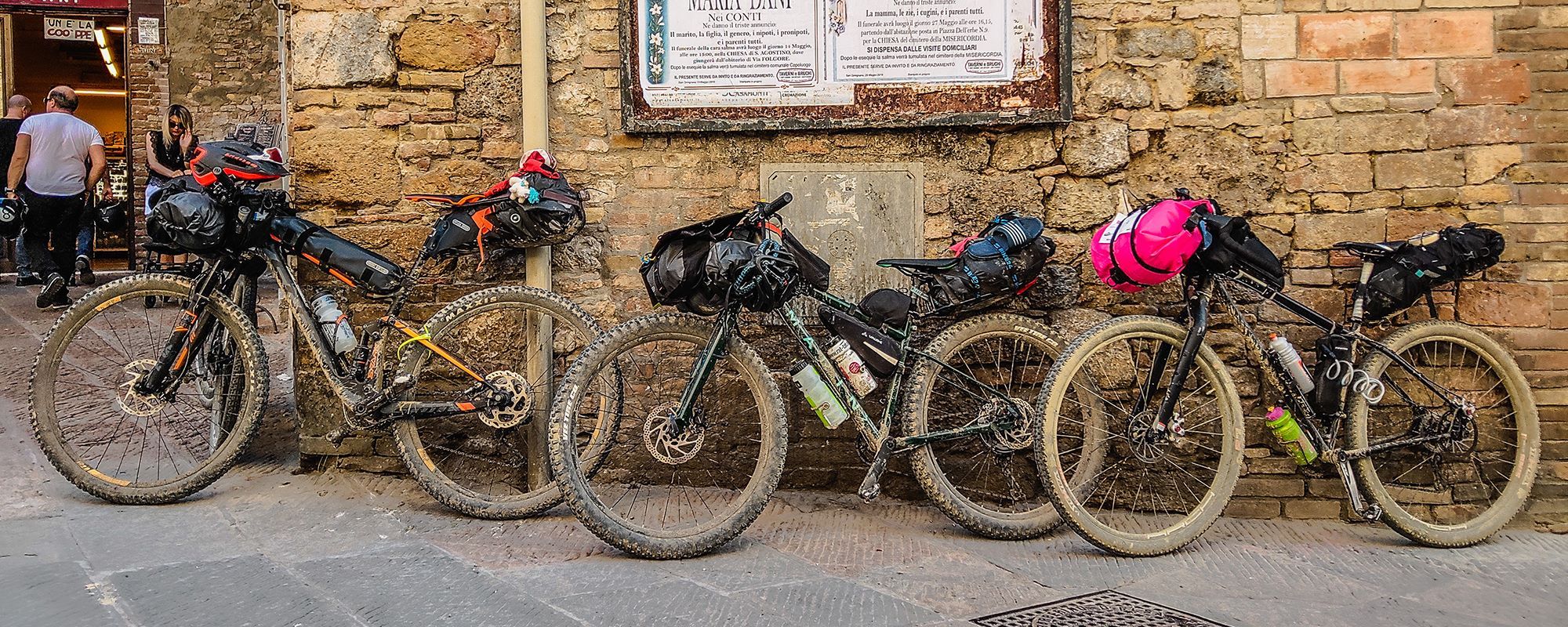
Bikepacking Bags – Review & Comparison (Ultimate…
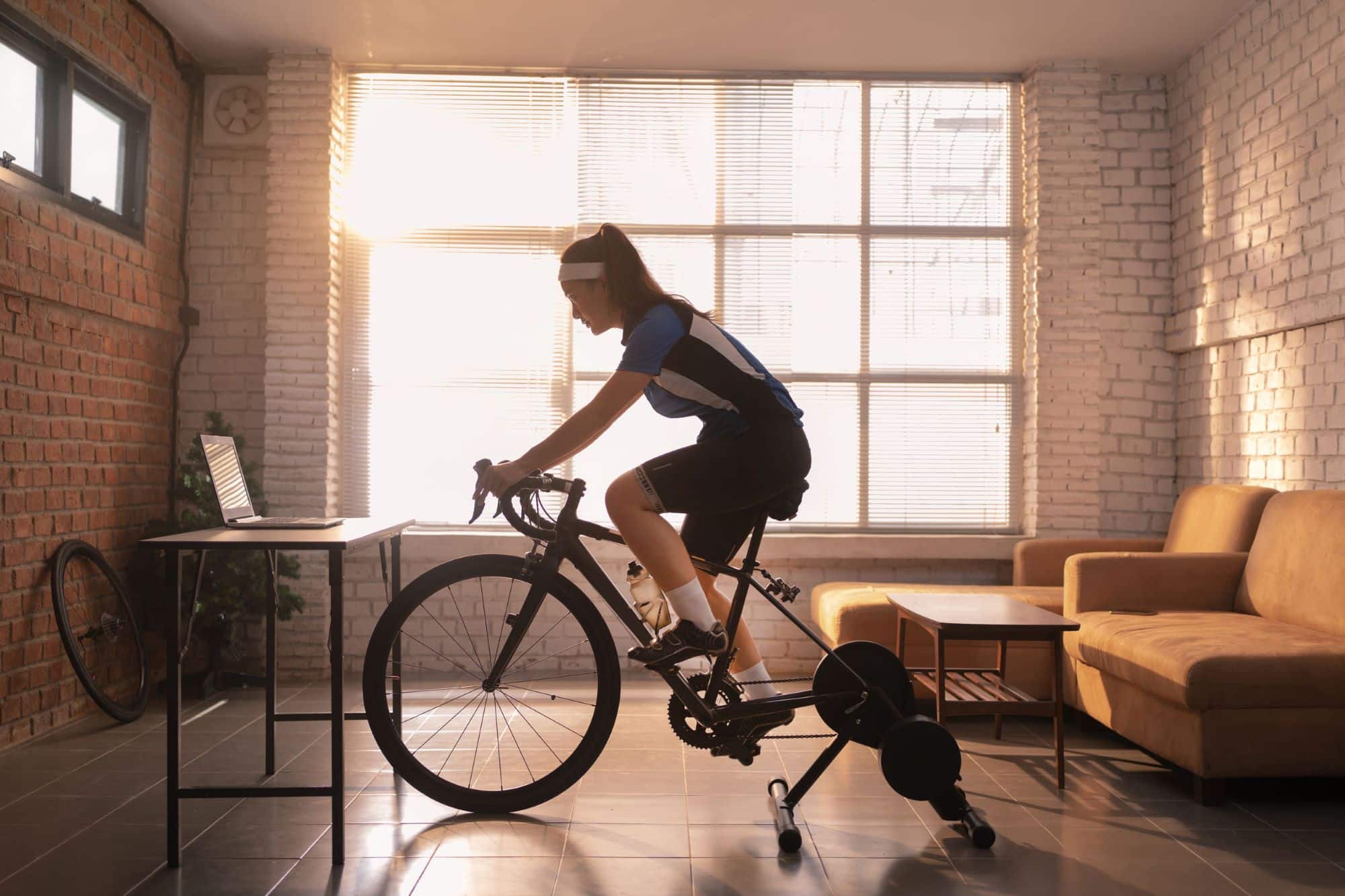
Smart roller trainer test – 16 roller…

SOTO Windmaster Test & Experiences – Wind…
Michael Luplow
Schreibe einen kommentar cancel reply.

The 10 Best Tents For Cycle Touring In 2024

Looking to find out which are the best tents for cycle touring in 2024? You’re in the right place! In this guide, I’ll be showcasing 10 of the most popular and best-loved options, with information on what makes them so great for touring, their weight, price and more.
What tent do I use for cycle touring? I personally use the Quechua Quickhiker Ultralight 2 Tent. It’s super lightweight, quick to pitch and take down, and just an all-around great tent. Sadly, this tent now seems to be discontinued, although the Forclaz Ultralight 2-Person Tunnel Tent is almost identical.

The 10 best tents for cycle touring
Here’s the lowdown on the best tents for cycle touring, including tunnel tents, dome tents and a bivvy-style model.
Vango Nevis 200 (£155)

While the Vango Nevis 200 may not be the lightest tent on this list, it is incredible value for money at just £140. If you’re new to cycle touring and don’t want to spend a fortune on gear, you can’t go too far wrong with this. It’s waterproof, has good ventilation, and would even make a decent wild camping companion, thanks to its low profile and green colour scheme.
Weight: 2.02kg
✔ Great budget option ✔ Good for stealthy wild camping ✔ Easy to pitch and take down
Forclaz Ultralight 2 Person Tunnel Tent (£219.99)

The Forclaz Ultralight 2 Person Tunnel Tent is almost identical to my trusty Quechua Quickhiker, which is why I’m recommending it here. The 1-pole design makes it quick and easy to pitch, plus it’s lightweight and packs up reasonably small. And, at just £220, it’s pretty decent value for money. The 2-berth version of this is a little claustrophobic for 2 people, but it’s plenty spacious for a solo cyclist.
✔ Good budget option ✔ 1 pole design for speedy pitching ✔ Small and compact
Weight: 1.75kg
Winterial Single Person Bivvy Tent (£135)

The Winterial Single Person Bivvy Tent is a real bikepacking tent. Ideal for ultralight solo cyclists, this glorified bivvy bag is super lightweight and low on fuss. Its low profile and forest green colouring make it ideal for stealthy wild camping as it blends nicely into the environment. It’s super easy to set up, taking less than 5 minutes — simply install the two aluminium poles and stake down the corners of the tent. The Winterial Single Person Bivvy Tent is good for 3 seasons, so it will see you comfortably on cycle tours from spring to autumn.
✔ Excellent for stealthy wild camping ✔ Quick to pitch ✔ Ultra lightweight
Weight: 1.31kg
Alpkit Ordos 2 (£219.99)

The Ordos 2 is Alpkit’s lightest 2-person tent, packing down to just 1.4kg. It has collapsible poles so it packs up small and compact — about the size of a 1.5-litre bottle — making it easy to secure to your bike’s handlebars. The central ridgeline design creates a stable yet spacious shelter, offering maximum living space while maintaining its low weight. Plus, the tent has a vestibule for storing luggage, as well as hang loops and pockets in the interior for further storage.
✔ Ultra lightweight ✔ Handle-bar friendly pack size ✔ Spacious with vestibules and interior pockets for storage
Weight: 1.4 kg
Vaude Lizard (€650)

At just 1.13kg, the Vaude Lizard is seriously light. This, coupled with its low profile and green colour scheme, makes it ideal for stealth camping. Despite the compact size and featherweight design, the tent is fully waterproof and rated for three-season use.
✔ Ultra lightweight ✔ Great for stealthy wild camping ✔ Excellent build quality
Weight: 1.13 kg
MEC Spark 2.0 (CA$474.95)

The Spark 2.0 is a dome tent from Canadian outdoor brand MEC. Set up is fast and easy, thanks to the thoughtful design and clear colour coding. It balances weight and size well, providing room for two cyclists, or ample room for a solo rider. And, with two vestibules, there’s plenty of room for luggage storage.
The Spark is also great value for money: it’s designed in-house by Canada’s largest gear co-op, so is quite a bit cheaper than similar tents. You’ll also be pleased to know that this tent is rated for three-season use and holds up impressively well in heavy rain.
Weight: 1.75 kg
✔ Great value for money ✔ Spacious with vestibules and interior pockets for storage ✔ Quick and easy to pitch, thanks to clear colour coding
Big Agnes Copper Spur HV UL2 Bikepack ($579.95)

Given the fast-growing popularity of bikepacking, it’s not surprising to see bikepacking-specific tents start to pop up. The Copper Spur HV UL2 Bikepack from US brand Big Agnes is one such tent, designed to have a handlebar-friendly pack size and a low weight.
The Copper Spur offers a good balance between weight and size, making it a comfortable cycle touring tent for two people. It has two doors and vestibules, plenty of headroom to sit up, and interior pockets for storage. In addition to its spacious interior, it’s also easy to pitch and take down — an all-around great tent.
✔ Specifically designed for cycle tourists and bikepackers ✔ Spacious with vestibules and interior pockets for storage ✔ Handle-bar friendly pack size
Weight: 1.59 kg
Terra Nova Laser Compact 2 (£600)

Another great option for bikepackers and wild campers, the Terra Nova Laser Compact 2 has a low profile and a dark green colour scheme. It’s not cheap at £600, but it’s been tried and tested and has even won awards. It’s safe to say that the Laser Compact 2 will be a long-lasting, reliable touring companion.
The tent pitches all-in-one, with the flysheet and inner attached, making it quick and easy to pitch. With a low weight and a small pack size of 30x15cm, the Laser Compact 2 is ideally sized for a handlebar bag. Despite its low weight and small size, it’s rated for three-season use and has two porches for storing gear. It will be quite cosy for two cyclists but plenty spacious for a solo rider.
✔ Great for stealthy wild camping ✔ Handle-bar friendly pack size ✔ Excellent build quality
MSR Hubba Hubba NX (£540)

The MSR Hubba Hubba NX is perhaps the most recommended series of tents among cycle tourists. It’s lightweight, it packs up small, it’s spacious with plenty of headroom and it has ample vestibule space for storing luggage. On top of that, the tent is very durable, with high-quality weatherproofing, good ventilation, and overall great build quality. What more could a cycle tourist want? The 2-berth version will likely be the model of choice for most cyclists, while the 1-berth model will suit ultralight cyclists and the 3-berth for a pair of riders.
✔ One of the most recommend tents among cycle tourists ✔ Spacious with a vestibule for storing luggage ✔ Excellent build quality
Weight: 1.72 kg
MSR Elixir 2 (£340)

While the above MSR Hubba Hubba NX is one of the very best tents for cycle touring, the £515 price point might not suit everyone’s budget. This is where the MSR Elixir 2 comes in. The Elixir is also a high-quality MSR tent, and the £200 saving is likely worth it to those who aren’t too bothered about saving on weight. At 2.77kg, it’s the heaviest tent on this list, but it doesn’t sacrifice on quality or durability.
✔ Cheaper alternative to the much-loved Hubba Hubba NX ✔ Great build quality ✔ Spacious with a vestibule for storing luggage
Weight: 2.77 kg
More great tents for cycle touring
Not enough choice in my list above? Here are some more options to look into:
- OEX Salamanda Bivi Tent
- Wild Country Zephyros Compact 2
- REI Co-op Quarter Dome 2
- Nemo Hornet 2P
- Sierra Designs Meteor 3000
- Big Agnes Fly Creek HV UL2
- Vango F10 Hydrogen Air Tent
Which tent(s) have you enjoyed using on cycle tours? Let me know in the comments below!

About The Author
Lauren Pears is a freelance travel writer and blogger based in London. She writes about active adventure travel, aiming to encourage and inspire travellers to make the most of the great outdoors.
Thank you for reading! If you found this post useful, I’d be grateful if you would consider using the affiliate links below when planning your travels. I’ll make a small commission at no extra cost to you. This will help me to keep this blog running. Thanks for your support – Lauren. Hotels – Booking.com Hostels – Hostelworld Cheap flights – Skyscanner Travel insurance – World Nomads Outdoor gear – Decathlon / GO Outdoors Cycling gear – Chain Reaction Cycles Alternatively, you could buy me a coffee to say thanks!

Similar Posts

A Complete Bike Touring Gear Guide and Kit List

The 8 Best Panniers For Cycle Touring in 2024
I do cycling camping and touring, and bought a Marmot Tungsten 2 tent about 9 years ago just before Covid, it didn’t get used much till afterwards. The tent was on sale for $149, it seems to have high reviews with 5 stars from most places and 4 from Amazon. I don’t know a lot about tents, I bought it because the reviews were high and the price was right was my motivation for buying it! While it is a 2 person tent, it is only idea for 1, the weight is higher than I would prefer but it kept my wallet heavier too.
Really helpful article. I currently have a Stratospire Li by Tarptent. Pricey but super light. I have used it with my spouse and individually. I am 5’10” and partner is 5’4”. Vestibule on both sides as well as doors on both. Great for storing gear out of the weather if needed.
Thanks for the recommendation Kenn, sounds like a good tent!
Why there is no word for Nemo tents. I feel Osmo by them is worthy of being in the list. Another one is by Druston,(Hope spelled it correct). They are making extremely light weight and durable tents.
Yes I’ve heard a lot of good things about Nemo! Thanks for mentioning them.
Leave a Reply Cancel reply
Your email address will not be published. Required fields are marked *
Best bikepacking tents: overnight shelters for all weathers
Get out for a comfortable overnight adventure on your bike with the best bikepacking tents

The best bikepacking tents should provide adequate shelter in whatever conditions you find yourself in, without taking up too much precious space or weighing you down.
There are many different approaches to bikepacking sleeping systems but the humble tent is one that provides significantly more protection from rain, wind, insects, and other outdoor elements than the rest. While the thought of sleeping out under nothing but a vast canopy of stars might fill us with wanderlust, the reality is that weather happens.
Choosing the best bikepacking tent should guarantee the best possible night's sleep out in the wilderness, however, if your tent is poorly designed, badly made, or too heavy and bulky, it’s going to have a serious impact on your bikepacking enjoyment.
Luckily tents have been getting progressively smaller, lighter and, with the increasing popularity of bikepacking, better tailored to be transported as part of an ultra-light bikepacking setup. There are now a number of tents that either consider or are specifically designed to meet the needs of bikepackers, including features such as shorter pack sizes and added storage space for things like helmets. Keep reading for our pick of the best bikepacking tents, or skip to the bottom of this guide for advice on what to look for when picking a tent.
Jump to: How to choose the best bikepacking tent
- What is bikepacking? The ultimate guide
- Which bike is best for bikepacking?
Best bikepacking tent
Why trust BikePerfect Our cycling experts have decades of testing experience. We\'ll always share our unbiased opinions on bikes and gear. Find out more about how we test.
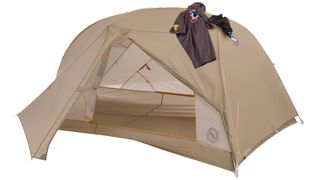
Big Agnes Tiger Wall UL2 Bikepack Solution Dye
Specifications, reasons to buy, reasons to avoid.
We have mostly focused on one-person tents as these are the smallest and lightest however for riders who adventure in pairs or just want a little more living space to spread out, the Tiger Wall UL2 is one of the best options. The double vestibule makes it easier to get in and out for both occupants or gives more pitching flexibility if being used by a single person. If the company of another person isn’t enough and you prefer a crowd, Big Agnes also does a three-person version of the Tiger Wall.
Big Agnes uses a Shortstik Poleset to help keep pack size down and the whole tent packs up into a compression sack that features daisy chain webbing loops for attaching to handlebars, frames or racks with the poles lashed to the outside of the stuff sack.
Gear organization is easy as the Tiger Wall not only has the vestibules but also internal pockets and helmet-specific storage too so your gear should be easy to organize and out the way once you are in camp mode.
Finally, Big Agnes uses its new Solution-dyed fabric for the Tiger Wall which it says is not only better for the environment as it uses 80 per cent less energy, 80 perc ent fewer chemicals and 50 per cent less water to produce, but is also more durable and UV resistant.

Terra Nova Laser Pulse 1
Terra Nova is known for making ultra-lightweight kit and the Laser Pulse 1 is the lightest tent on our list. If the staggering 545g weight, with an equally impressive pack size, still seems a bit heavy, Terra Nova does an Ultra version which is claimed to be the lightest tent in the world at just 490g. That 55g saving does come at a serious premium so for most riders the regular Laser Pulse 1 is probably light enough.
Despite its light weight the Laser Pulse is still big enough to almost sit up in and has a little porch space to store a few bags and your shoes. Pitching is straightforward too and the outer and inner can be erected together, so if it's pouring with rain you will be able to quickly get set up and under shelter. The inner and outer can also be pitched separately too should you only want to use part of the tent.
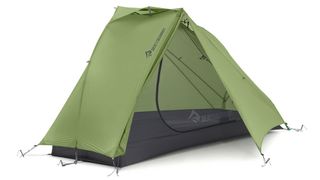
Sea to Summit Alto TR1
Sea to Summit has clearly spent a lot of time thinking about the features that are important to making a tent that is extremely user-friendly. For a start, thanks to the TensionRidge cross beam the tent has one of the best living areas as the walls are steeper, providing more shoulder and head space when sitting up. This also benefits entering and exiting the tent as the doors are taller as well as allowing the front to be completely opened up. The TensionRidge isn’t just structural either, as Sea to Summit has built exit vents around the top of the tent to give better air circulation and improve condensation management.
The Alto can be erected rainfly first and the DAC poles are all color-coded with the aluminum machined Quick-Connect pole feet for simple setup. Sea to Summit's Quick-Connect system uses these special clips to simply hold the inner tent or tent footprint to the flysheet outer layer.
Attention to detail is superb even down to the stuff sack design. The tent itself packs into three separate bags which can either be linked together or split into three parts for more versatile packing arrangements. Once the tent is set up, the stuff sacks clip into the inside of the tent for internal storage and the pole bag can be turned into a diffusing overhead light source when paired with a head torch for even illumination.

Vango F10 Hydrogen Air Tent
For bikepackers the most inconvenient part of a tent is the poles. Without a large backpack or the option of substituting your walking poles to the tent structure, they have to be short enough to fit in a frame bag or between the handlebars. However what if you just got rid of the poles entirely? Well, that is exactly what Vango has done with the F10 Hydrogen Air. By swapping out rigid poles for an inflatable pole Vango has created a tent that packs down into a staggeringly small 1L stuff sack. For comparison, that's about as small as some bivy bags.
Going poleless has other advantages as well. The F10 Hydrogen Air can be set up extremely quickly as, despite being a double-wall tent, the inner and outer are attached so it's just a case of picking your sleeping spot, laying the tent out, pump up the AirBeam pole and stake it out. While your bike pump will likely be your go-to for inflation, Vango says you can also use a CO2 canister. When it comes to breaking camp the tent can just be deflated, unpegged and stuffed away quickly.
Space is on par with other low profile one-person tents and the side entrance with inner mesh door opens out wide making it easier to access the tent. In terms of weatherproofing and durability, Vango is one of the most recognized tent manufacturers around so it should last for many years to come.
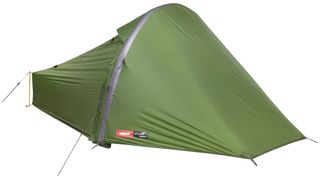
Alpkit Aeronaut 1
Another inflatable tent, the Alpkit Aeronaut follows the same recipe as the Vango F10 using an inflated tube as the main method of holding the shape of the tent. The main difference between the two is price, Alpkit is well known for its very competitive pricing and the Aeronaut retails for considerably less than the Vango. This does come at a compromise though, as the weight plus stowed volume is noticeably larger. It still packs down relatively small, so for space-conscious bikepackers looking for a tent on a budget, the Aeronaut is a great option.
The inner and outer are connected to make pitching quick and simple by just inflating the pole sleeve using the Schrader valve and pegging the tent out. Last thing you want is a deflation through the night and Alpkit provides a puncture repair kit with the tent should you spring a leak. A wide side entrance door makes easy work of entry, exit and general campsite hanging out.
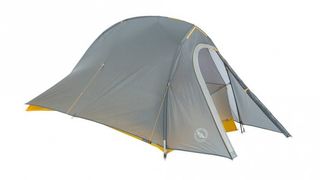
Big Agnes Fly Creek HV UL1
Big Agnes is quickly cornering the market as one the the main players when it comes to bikepacking tents. This is in part thanks to the Fly Creek range which is becoming a classic for those tackling multi day adventures by bike and looking for a balance in durability, pack size and features. The HV is the updated version of the Fly Creek UL1 and takes all the features that were so popular with the original while tweaking the structure to provide improved liveable space. A more square profile makes the living space feel larger without actually increasing square footage, and reworked mounting points on the inner help hold the tent more tightly.
It gets the same beefed-up stuff sack as the Big Agnes Tiger Wall which can be mounted directly to the bike. You also get internal shelves and pockets for your gear as well to keep everything dry.
While the Fly Creek HV UL1 is more than competitive in weight and pack size, Big Agnes does a ‘crazylight’ version for those who want to save even more grams. It’s almost half the weight although over double the cost and does not pack down as small due to the folded length of the carbon Easton poles.
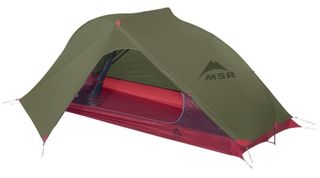
MSR Carbon Reflex 1
MSR is another big name in the outdoor equipment world and its Carbon Reflex 1 tent is an ultralight option that's great for bikepacking. Despite being a fully featured tent it still packs away small thanks to the lightweight fabric of the rainfly sheet and the Easton Carbon poles. The inner is mostly made from mesh, so ventilation and moisture management is great, although be careful when packing as it's easy to snag and damage the mesh material. Like some of the other tents here the use of mesh on the inner and ability to be pitched in separate parts means, weather permitting, you can opt to sleep without the outer and enjoy the stars.
The MSR has a narrow pitch size so it's great if you often find yourself struggling for space. Despite its small footprint there is a good amount of vestibule space for shoes and bags to be brought under cover. MSR has chosen to make the vestibule zipper-less, instead choosing two strips of Velcro for closure to save overall weight and space. While this is easy to use, it's worth considering your pitching position in case a gust of wind blows it open in the middle of the night.
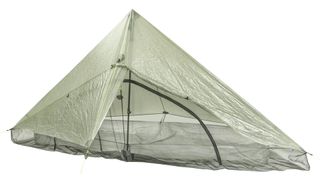
Zpacks Hexamid Solo Tent
While Terra Nova has the world record for the lightest tent, Zpacks' Hexamid Solo tent’s modular design is giving it serious competition. In its lightest format the Hexamid is a staggering 294g although once you add the Zpacks bathtub ground sheet and required 48 inch pole the weight will be around 480g. This is mostly down to the Dyneema fabric which is incredibly strong and lightweight and is used in a single wall design, the bathtub groundsheet is also Dyneema although twice as thick as the canopy to ward off punctures from below. Inside the tent there is a fully enclosed insect screen to keep the bugs out.
As we all know lightweight always comes at the cost of features and there are a few quirks with the Hexamid Solo you should be aware of. Firstly and unsurprisingly there is no storage other than the vestibule which does not exactly get close to the ground. Number two is that the Dyneema fabric is a little translucent, that means during the day people will be able to see your silhouette moving about inside and you will be able to see outlines of the outside, Zpacks is a glass-half-full brand describing it as “a more immersed outdoor experience” but light sleepers might want to bring a sleeping mask.
- Bikepacking essentials : our tips to get ready for a bikepacking adventure
- Lightweight bikepacking : top tips to save weight on your bikepacking rig
How to choose the best bikepacking tent
1. Why choose a tent?
For some, the idea of choosing a tent means adding unnecessary weight and packing complications to the bike. However, these days tents have dropped a lot of weight and greatly reduced pack size so if you are looking for some extra comfort it might only cost you 100g over a tarp and bivy setup.
Where a tent excels is that they can be free-standing for a simpler setup and provide far more protection from the elements than a tarp could, greatly increasing your chances of getting a good night’s sleep and feeling refreshed for the next day ahead. Ultimately bikepacking, whether it's just for fun or at the pointy end of an ultra-endurance race is a game of attrition, a guarantee of a reliable night’s sleep could easily be worth the little extra weight to ultimately ride faster or have more fun.
2. Different types of tent
Tents are usually broken up into a few different styles: freestanding, semi-freestanding and non-freestanding. The difference between these three types of tent comes down to how they are erected. Freestanding tents don’t require pegging out as the poles hold the tent’s shape, this means you can build it and then move it easily to find the perfect sleeping spot. Generally, a freestanding tent will have a double-wall construction, meaning there is a separate rain sheet, although single-wall versions do exist. Freestanding double-wall tents usually provide better protection from the rain and wind and offer more ventilation too. Semi-freestanding tents use the poles for a portion of the structure with additional sections needing to be pegged out to achieve the full tent sizes. True non-freestanding tent designs are less common for bikepacking as they are designed with hiking in mind and use hiking poles as part of the structure although they do exist using short auxiliary poles. The advantage of non- or semi-freestanding tents is a lower pack size and weight.
3. Pack size
While plenty of tents on the market meet the weight and weather protection requirements, bikepacking has a unique limitation that will rule out a large number of ultra-light tents. Pack size of a tent needs to be compatible with your best bikepacking bag setup. If you are using drop bars or storing the poles in a frame bag, double-check that the packed tent and poles will actually fit. It’s also worth erecting the tent before you embark on your first trip as it will allow you to learn how to put it up and most importantly, how to put it all away again.
4. Comfort levels
In bikepacking, there are two things that very rarely go hand in hand, comfort and lightweight. Ultimately the fewer creature comforts, features and space your tent has, the lighter it is going to be. For some, the space to sit up in your tent or easily get out the door is well worth the extra weight while others are just wanting a lightweight shelter to crawl inside for 40 winks. Think about the time you spend at camp, if having a semi-liveable area will make your trip more pleasurable it’s probably worth it. If your sleeping time is counted in minutes rather than hours, being able to read a book in your sleeping bag is not a concern.
It’s worth noting that while a tent says that it comfortably fits one human being, that isn’t always the case. While petite bikepackers probably won’t have any problems it can be an issue even for relatively average-sized people, so it’s worth double-checking the floor dimensions of any tent you are thinking of buying to make sure you are getting the amount of space that you expect.
5. What's included?
Some tent companies aren't just deceiving when it comes to real estate, so make sure you check what is actually included with the tent and confirm whether the stated weights and pack sizes actually include all the items that you need for camping. Otherwise, you won't be able to make a realistic comparison between the tents that you are interested in. While all the main parts of a tent will be included, like outer and inner layers, some brands don’t include items like pegs and poles, and they rarely come with a groundsheet included. Whether you need to purchase a groundsheet very much depends on the tent’s material and the ground that you are camping on.
- Best bikepacking bags : carry your gear and supplies with ease
- Best bikepacking saddles : comfy saddles for multi-day adventures
Graham Cottingham joined the BikePerfect team as our senior tech writer in 2020. With over 20 years of riding experience, he has dabbled in downhill, enduro, and gravel racing. Not afraid of a challenge, Graham has embraced bikepacking over the last few years and likes nothing more than strapping some bags to his bike and covering big miles to explore Scotland's wildernesses. When he isn’t shredding the gnar in the Tweed Valley, sleeping in bushes, or tinkering with bikes, he is writing tech reviews for BikePerfect .
Rides: Cotic SolarisMax, Stooge MK4, 24 Bicycles Le Toy 3, Surly Steamroller
Height: 177cm
Weight: 71kg
Best mountain bike clipless pedals 2024 – the top-rated clipless MTB pedals for XC, trail and gravity riding
Best MTB saddles for comfort 2024 – 6 top-rated butt-pleasing perches for mountain biking and off-road cycling
We loved this budget full-suspension MTB and it's on sale right now with a huge 42% discount
Most Popular
- 2 Crankbrothers Stamp 1 Gen 2 flat pedal review – a plastic fantastic composite pedal
- 3 Spiralling costs, COVID-19 and bike industry woes cited as leading UK mountain bike festival announces closure
- 4 Hutchinson Python 3 Racing Lab tire review – more versatile than the name suggests
- 5 Attaquer All Day 2.0 jersey review – maximum comfort without sacrificing performance or style
Really Big Bike Ride

The Best Bikepacking and Bicycle Touring Tents And How To Choose One
Choosing the right tent can make or break a cycle touring or bikepacking trip.
Bikepacking tents are a relatively new concept. Just a few years ago, this uber-niche category of tent didn’t exist.
Even now, cycle touring is still a relatively niche activity. However, the recent resurgence of interest under the guise of bikepacking has exploded the marketing of lightweight, bike-based kit.
Due to this influx of popularity, there are now specific bikepacking and bicycle touring tents available on the market.
Which makes selecting the best bikepacking tent for cycle touring all the more subjective. More choice = more confusion.
What are the important characteristics of a bikepacking or cycle touring tent?
To help answer this question I’ve decided to offer guiding principles for choosing the best bikepacking tent based on my experiences cycle touring in over 40 countries.

What’s the difference between a tent for hiking and camping and a cycle touring or bikepacking tent?
Before we jump into the best tents for bikepacking and cycle touring, it’s important to understand the industries from which we choose a tent. Tents are made for many specialist reasons and hiking is a popular one.
The best tent for hiking would be super lightweight and portable. Since a hiking tent is carried by one or two people in a backpack, weight is a major consideration.
Bikepacking tents vs tent for hiking
That may not necessarily be the same criteria for cycle touring. Since you have a bicycle to bear the load you may prefer the extra space of a larger tent.
A tent for climbing on the other hand would be designed for strength and durability. Pitching a tent on the side of a mountain requires additional ruggedness and toughness. Arguably, the best tent pegs money can buy would come in handy too.

Essential questions to ask yourself before buying a tent for cycle touring
First up, where are you going and how long for? Do you even need a tent?
When I cycled from Vietnam to the UK , I immediately realised once in Vietnam that a decent hammock would have been WAY more appropriate for cycle touring in South East Asia.
Stubbornly, I persisted with the tent and found out the hard way that ‘camping’ is not such a big thing. It essentially looks like you’re hiding in the bushes. Not cool in a place like Vietnam.
The humidity was stifling, which made the tent so unappealing that in the end, I simply slept on top of the tent using the canvas like a bivvy bag.
What is the best tent for bikepacking and cycling touring?
The point I make here is that the first consideration when choosing the right tent is context. How will you use the tent?
Is it a long-distance solo journey or a multi-month family cycle tour?
Are you a couple going on a short bikepacking jaunt in the UK or a multicountry ‘world cycle’?
Start to think about what you want from a night under canvas. There are many ways to sleep out at night. There is little to recommend the best tent for cycle touring except the requirements of your trip.
When I collected my Dawes Galaxy from Spa Cycles in 2011, the chap that built the bike, Andrew, recommended that no tent or bedding were required. Simply visit a local supermarket and pilfer a pile of cardboard – bed and shelter all in one move.
That said if you still need recommendations on the qualities of a decent tent for cycle touring, here’s a shortlist of the best tents for bikepacking and cycle touring according to dozens of experienced cyclists, adventurers and bikepackers.
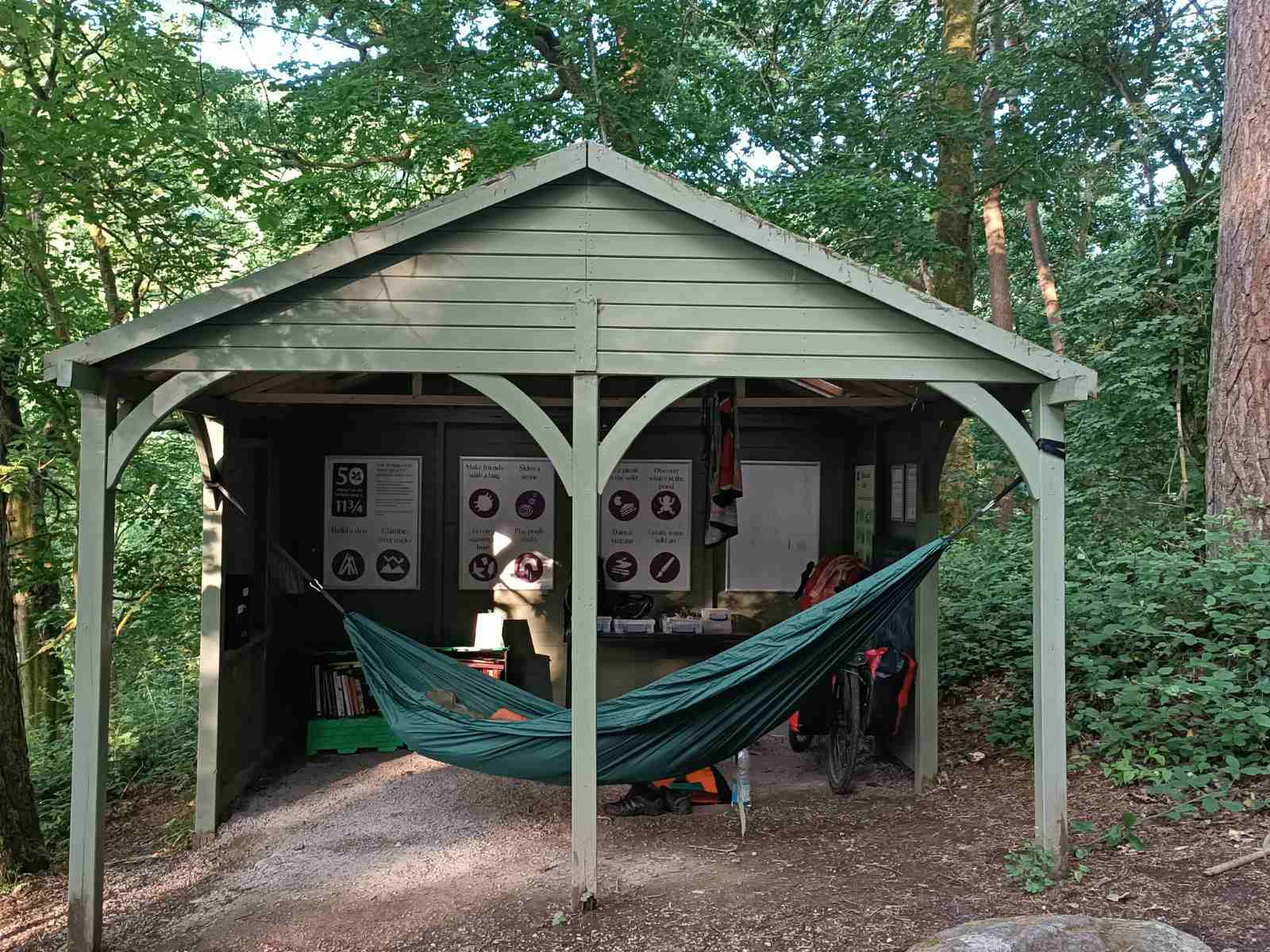
Expert Buyer’s Guide: How to Choose the Perfect Bikepacking Tent for Your Adventure
As you embark on your epic bikepacking adventure, the importance of choosing the right tent cannot be underestimated. Your tent will be your home away from home, providing shelter and comfort after long days of pedaling.
With so many options on the market, finding the best bikepacking tent that suits your needs can be overwhelming. But fear not!
We’ve reviewed the bikepacking kit that we feel offers the best bang for your buck – to help you make an informed decision.
Consider these essential factors when reviewing bikepacking tents:
Packability: As a bikepacker, efficient use of space is paramount. Look for a tent that not only offers reliable protection when set up but also packs away neatly and securely.
Opt for a size and weight that complements your bikepacking style. If you have a large bag and don’t mind a bit of extra weight, a roomier tent may be suitable.
However, if you prioritize minimizing weight and space, go for an ultralight option. Remember, a compact tent is also practical when attaching it to buses or shipping it during your travels, potentially reducing costs.
Set up: A quick and hassle-free tent setup can make a world of difference, especially after a long day of riding. Consider the weather conditions you’ll encounter and the lighting available for setting up camp.
Look for a bikepacking tent with a straightforward setup process, as complex procedures and fiddly poles can be frustrating and time-consuming.
Pro tip: Before embarking on your adventure, practice setting up your tent in your backyard a few times to ensure you are familiar with the process.
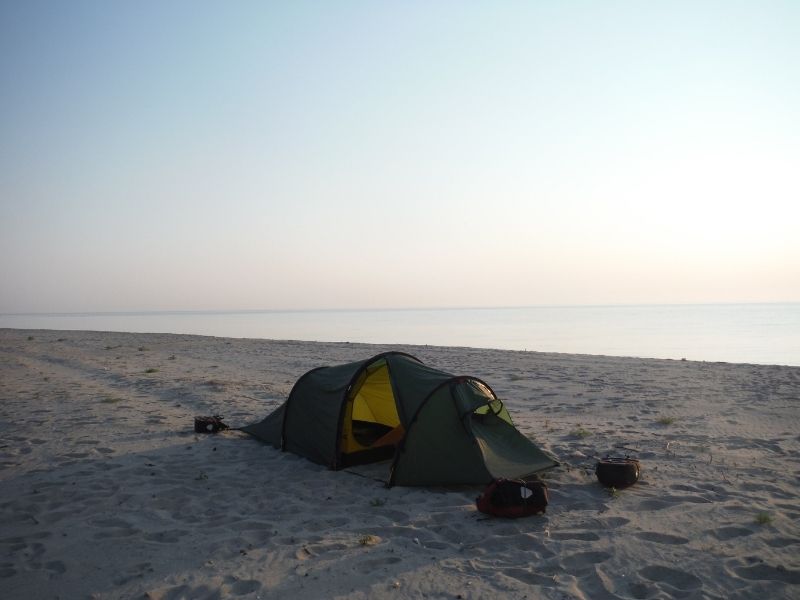
Size matter with bikepacking tents
Weight: Every ounce counts when you’re on a bikepacking trip, so the weight of your tent is crucial. Ultralight tents are an excellent choice, particularly if you ride a lightweight bike.
However, if you’re going on a short trip or are new to bikepacking, you may not need the lightest tent available, which often comes at a premium price.
Durability: Investing in a sturdy and long-lasting tent is a wise decision, especially if you plan on frequent bikepacking adventures.
Focus on finding a tent made from weatherproof and durable materials, particularly if you expect to encounter challenging conditions like rain, wind, or rugged terrain.
Some bikepacking tents come with warranties, with options ranging from two to three years or even a lifetime guarantee.
Size: When it comes to size, consider both the packed-down dimensions and the tent’s actual size once pitched. We’ve already discussed the importance of packability, so now let’s focus on the tent’s interior space.
Determine whether you prefer a one-person tent for solo adventures or if you need more room with a two-person tent for couples or friends travelling together.
For individuals with ample gear, a larger tent or one with plenty of storage space might be necessary. Additionally, consider the height of the tent, as taller individuals might not be comfortable in smaller, more compact tents.
By carefully considering these factors, you can confidently choose the best bikepacking tent for your unique adventure, ensuring a comfortable and memorable journey. Happy riding!
Bikepacking Tents Reviews – The Best Bike Touring Tents of 2022/3
Big agnes copper spur hv ul ultralight bikepacking tent.
The Big Agnes Copper Spur HV UL Ultralight Bikepacking Tent* is an ultralight tent that recently underwent a redesign, offering steeper walls and more interior space.
It’s a practical choice for weight-conscious adventurers who prefer proper tent poles over trekking poles.
While it might not suit taller and broader individuals sharing it, this tent excels for solo hikers seeking a lightweight option for summer and spring tours.
The North Face Stormbreak 1
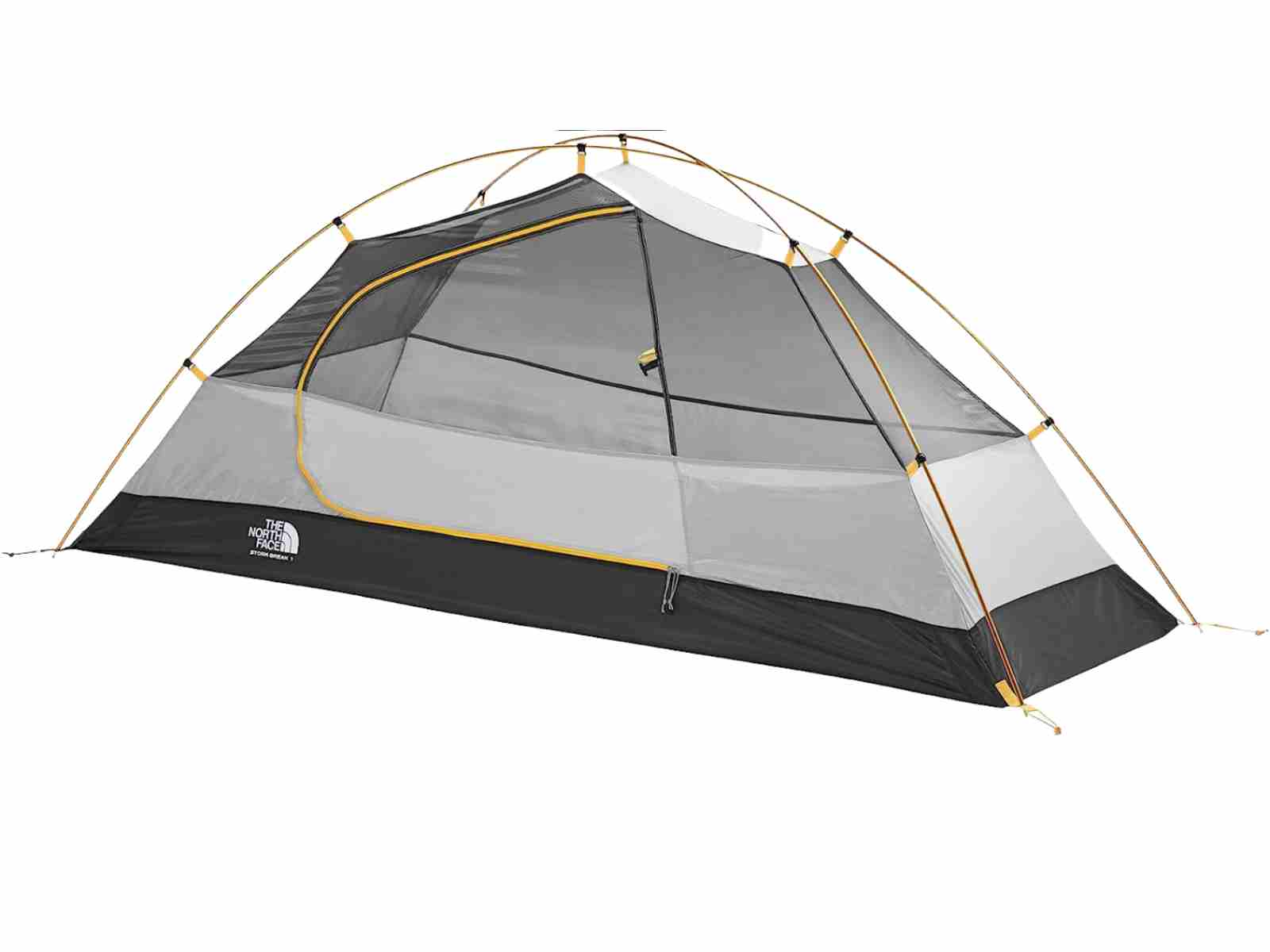
If you anticipate windy and wild weather on your tour, The North Face Stormbreak 1* is an ideal choice. Its X-pole design provides structural stability against strong winds, while the mesh netting ensures good ventilation.
With a lightweight package and clever colour coding for easy assembly, this tent is perfect for solo bike tourers looking for a reliable and quick-pitch option.
MSR Hubba Hubba NX 2-Person Lightweight Backpacking Tent

For the luxury bike tourer seeking extra space for both gear and themselves, the MSR Hubba Hubba NX 2-Person Lightweight Backpacking Tent is a great choice. Its exoskeleton frame allows for quick and easy pitching, and the unified rainfly keeps the inside dry in wet weather.
Despite not being the lightest on the list, its spaciousness and small packed size make it a fantastic option for bike packing.
Winterial Single Person Bivy Tent

Budget-conscious adventurers will appreciate the Winterial Single Person Bivy Tent. Weighing under 3 pounds and packing into a compact bag, this bivy tent offers a cost-effective solution for bike touring.
Its 2 hoop design simplifies pitching, and the inner mesh material ensures proper ventilation for warmer months. With a rain fly for rainy days, this tent is a valuable choice for three-season adventures.
MSR Hubba Hubba 3-Person Lightweight Backpacking Tent
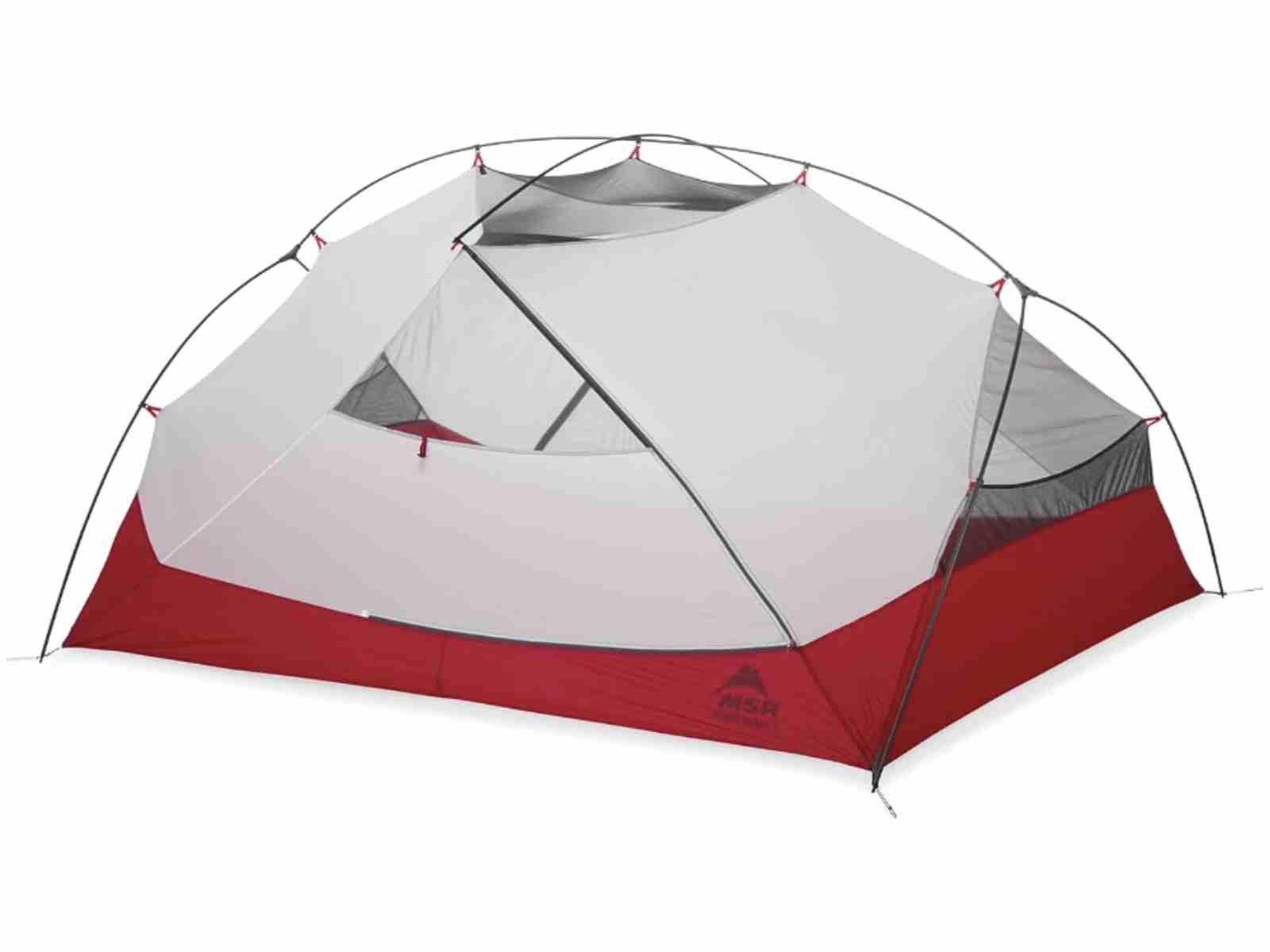
Planning a summer bike-packing adventure with friends or want to share space with your gear? The MSR Hubba Hubba 3-Person Lightweight Backpacking Tent is perfect for such scenarios.
Although made for backpacking, this hardwearing three-person tent is spacious enough for a trip of adventurers to feel comfortable. Plus, the Easton Syclone poles are virtually indestructible. It’s fully waterproof too.
Remember: Things to Consider When Buying a Bikepacking Tent for Cycle Touring
- Weight: Choose lightweight tents to reduce the burden while cycling.
- Tent Style: Consider bivy tents, single pole designs, or exoskeletal frame tents based on your preferences and requirements.
- Internal Tent Space: Determine how many people and gear you want to fit inside the tent.
- Packed Size: Ensure the tent fits onto your bike without hindering your movements.
- Features Explained: Familiarize yourself with tent shells, ventilation options, pitching methods, stakes, and pole designs.
The Best Bikepacking Tent is the one fits your adventure
Finding the best tent for cycle touring and bikepacking is essential to ensure a comfortable and enjoyable journey.
The options we’ve listed above cater to various preferences and needs, from ultralight solo hikers to adventurers seeking extra space.
While material and construction technology has moved on, I still consider the Hilleberg Nallo 2GT a great all-rounder. Failing that, a hammock is also a great choice depending on the climate.
Consider your requirements, and select the perfect tent that will be your reliable companion on your next bike touring adventure. Happy riding!
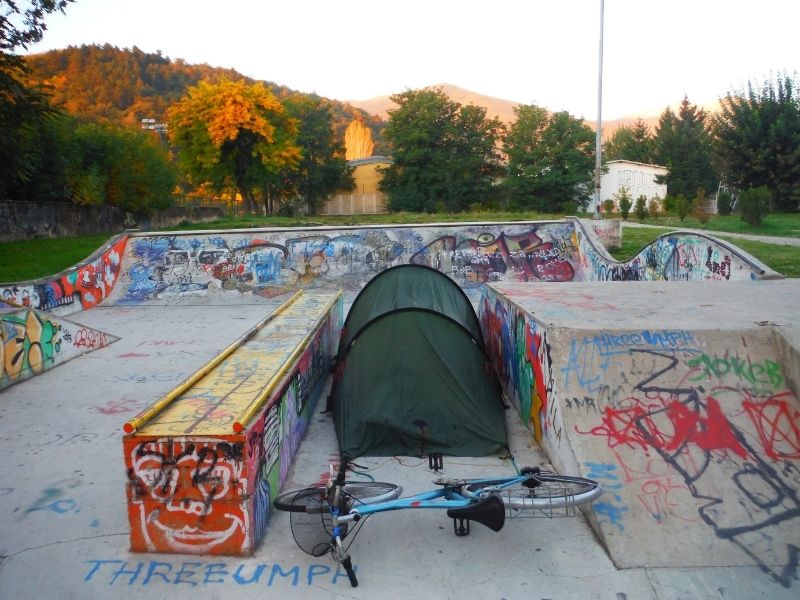
Have you got a recommendation for the best bikepacking tent? Share your favourite below:

Bikepacking & Adventure Cycling
Best Bikepacking Tents For Your Next Adventure
Are you planning a bikepacking adventure and in need of a reliable and comfortable tent? Look no further! In this article, we will be showcasing the top 10 bikepacking tents on the market. From ultralight options to spacious designs, there is a tent on this list for every type of bikepacker.
We’ve done the research and rounded up the best of the best, so you can focus on hitting the trails with confidence and comfort. Whether you are a seasoned bikepacker or new to the game, these tents are sure to meet your needs and exceed your expectations. So grab your helmet and saddle up, because it’s time to hit the trails with one of these top-rated bikepacking tents.
When considering a tent for your next bike adventure. There are some things worth considering before you jump right in a buy just any tent. Ideally serving your personal preferences and needs, depending on your type of adventure.
How long are you travelling for? Are you going on a multi-year trip? You might need a spacious tent to store all your gear and high quality to last the test of time. The great thing about bikepacking tents is that they offer some subtle differences from standard tents. With vestibule storage space for all your gear, mounting straps on the tent to hang up your helmet for the night, while also offering a lightweight solution and smaller packed size for storing on the bike.
Below is the criteria I go through with each tent to compare them and see which one stacks up on top!
What to look for in a bikepacking tent
- Pitch instantly
- Size (1 person, 2 person or 3 person)
- Stay up in heavy winds
- Suited for all climates
- Space to live
- Room for all of your luggage
- Even vestibules or gear shed
- Possibility for taking in amazing views
- Keep you dry from wet weather
- Dry out quickly
- Can pack wet
- Last for along time
- Pitch anywhere
- Number of entrances
- Ventilation
- Stealthiness and Colour
- Ground sheet
- Packed Size
What types of tents are suited for bikepacking?
When looking at a tent for bikepacking the weight is one of the more important factors. You need something that is going to be light enough, it is becoming easier and easier nowadays with companies making tents suited for this ultralight style of travel.
The packed volume of the tent is another thing that makes a tent suitable for bikepacking. Depending on the bikepacking bags you have. Generally, a tent is stored in the front handlebar bag on a normal bikepacking setup. Getting a tent that fits in these dry bags with extra room to store other gear is ideal. Most bikepacking-specific tents offer a stuff sack which easily fastens to your bike.
Big Agnes Copper Spur HV UL Bikepack
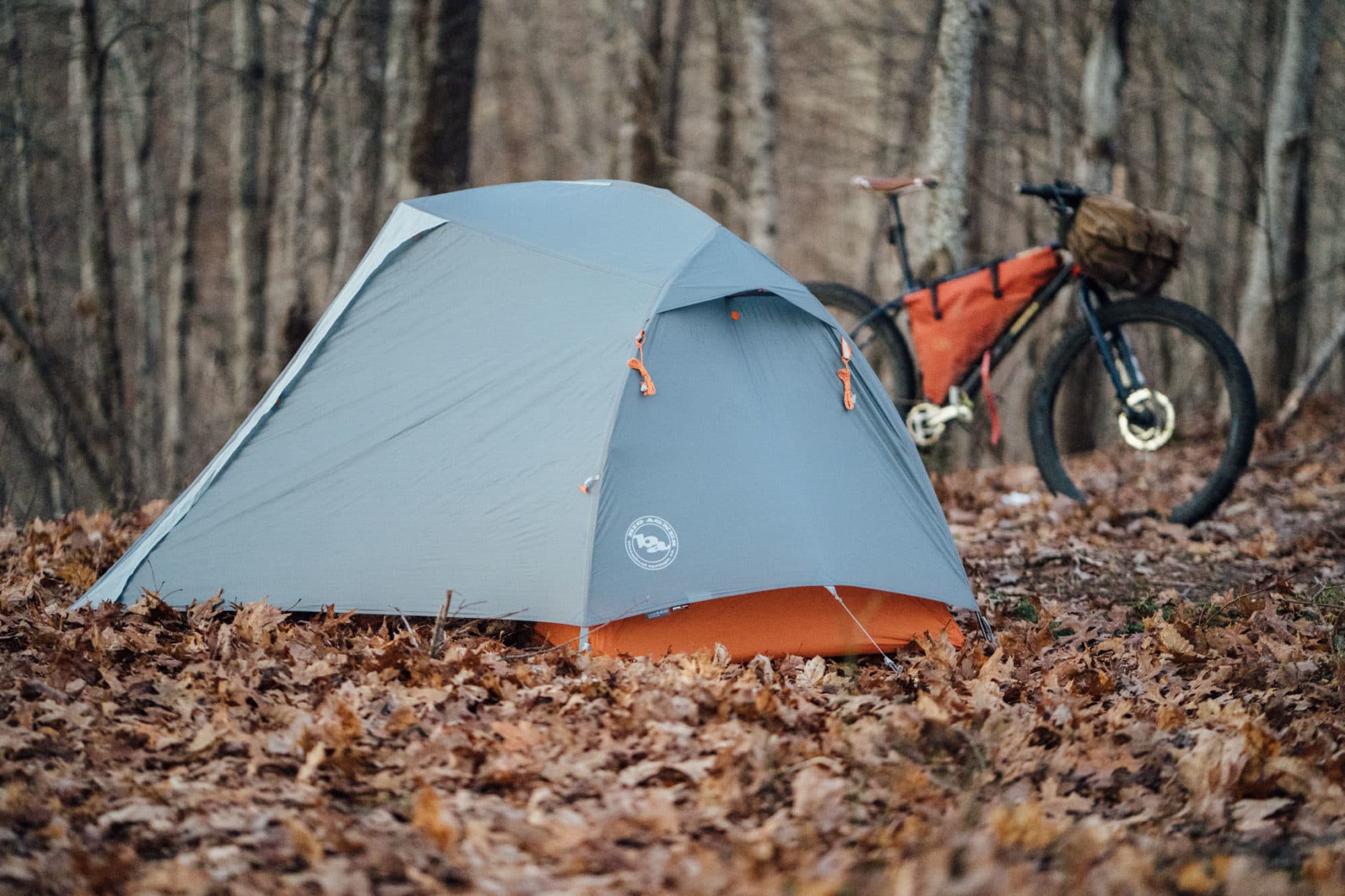
The Big Agnes Copper Spur HV UL is ultralight, with the 1-person weighing 2 lbs. 13 oz (1.28 kg) or the 2-person option weighing 3 lbs. 8 oz (1.59 kg). For that little weight increase, you are worth getting the larger tent, perfect for solo trips and gear storage. It has a high-volume design that provides plenty of headroom and space for gear storage. The tent is also easy to set up, with a single hubbed pole structure and color-coded setup. Quality build with more than enough storage (inside pockets and vestibules)
It’s surprisingly durable for how delicate the material appears. Holding up well in rain, as the rainfly will soak, but the inside will stay dry (unless there’s high wind, then droplets will flick). But super packable for bikepacking thanks to the shorter poles. And comes with a compression stuff-sack with daisy-chain webbing that allows for multiple bike attachment configurations. Check Price
REI Co-op Quarter Dome SL1
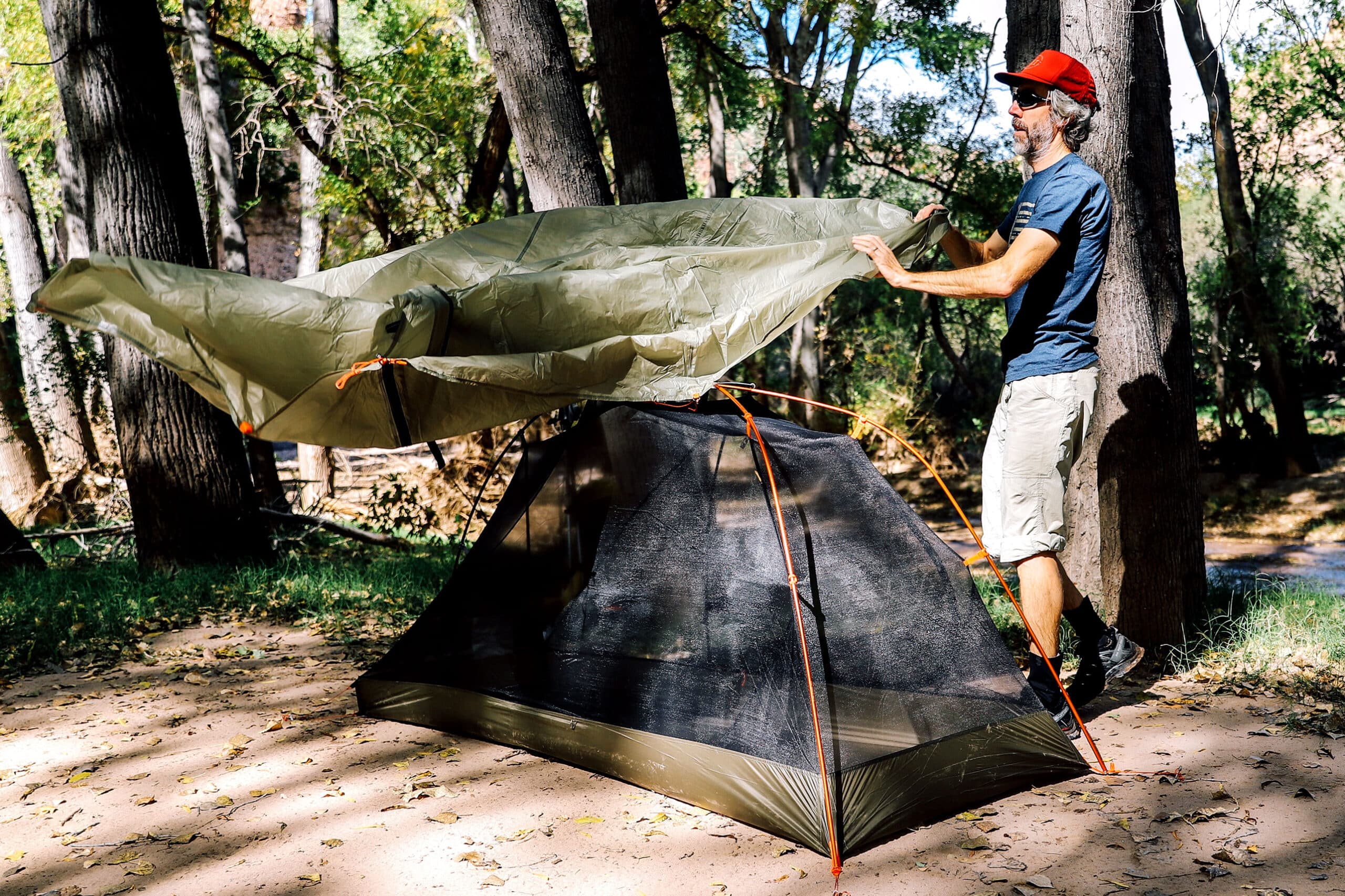
This tent is another ultralight option that is great for bikepacking weighing in at 2 lbs. 6 oz which is slightly lighter than the Big Agnes above. It is however discontinued so it won’t be sticking around for long. Featuring a single-pole design that is easy to set up and a unique shape that provides plenty of headroom and interior space. The tent also has a waterproof rainfly and is made with durable materials.
Designed for solo backpackers, would want to pack light but not sacrifice on a comfortable night’s sleep. It is a semi-free standing tent. But for the price , it’s amazing value.
Nemo Hornet Elite OSMO Ultralight
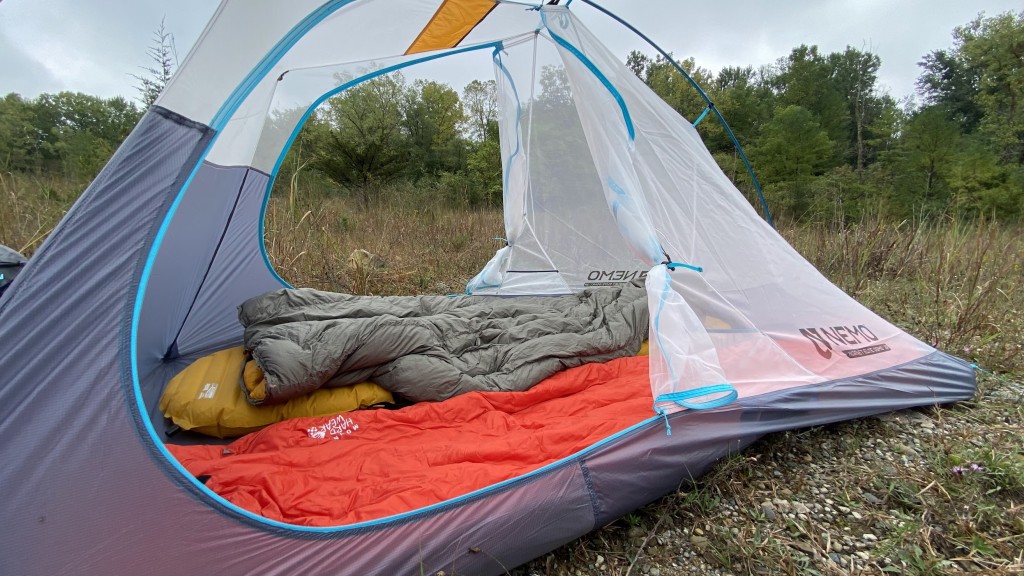
This tent is another ultralight option that is perfect for bikepacking. Featuring the all-new OSMO™ fabric. Delivering 4x better water repellency and 3x less stretch when wet, our new OSMO tent fabric is also made from 100% recycled yarns. The tent has a single-pole structure and a waterproof rainfly, as well as a unique shape that provides plenty of interior space and headroom. The tent is also made of durable materials and has high-quality construction.
Nightlight Pockets turn your headlamp into a tent lantern while removing blue light and casting an even glow. The 1-person model weighs 1 lb 13 oz / 812 grams and the 2-person 2 lb 1 oz / 935 g.
Sea To Summit Telos Bikepacking TR2
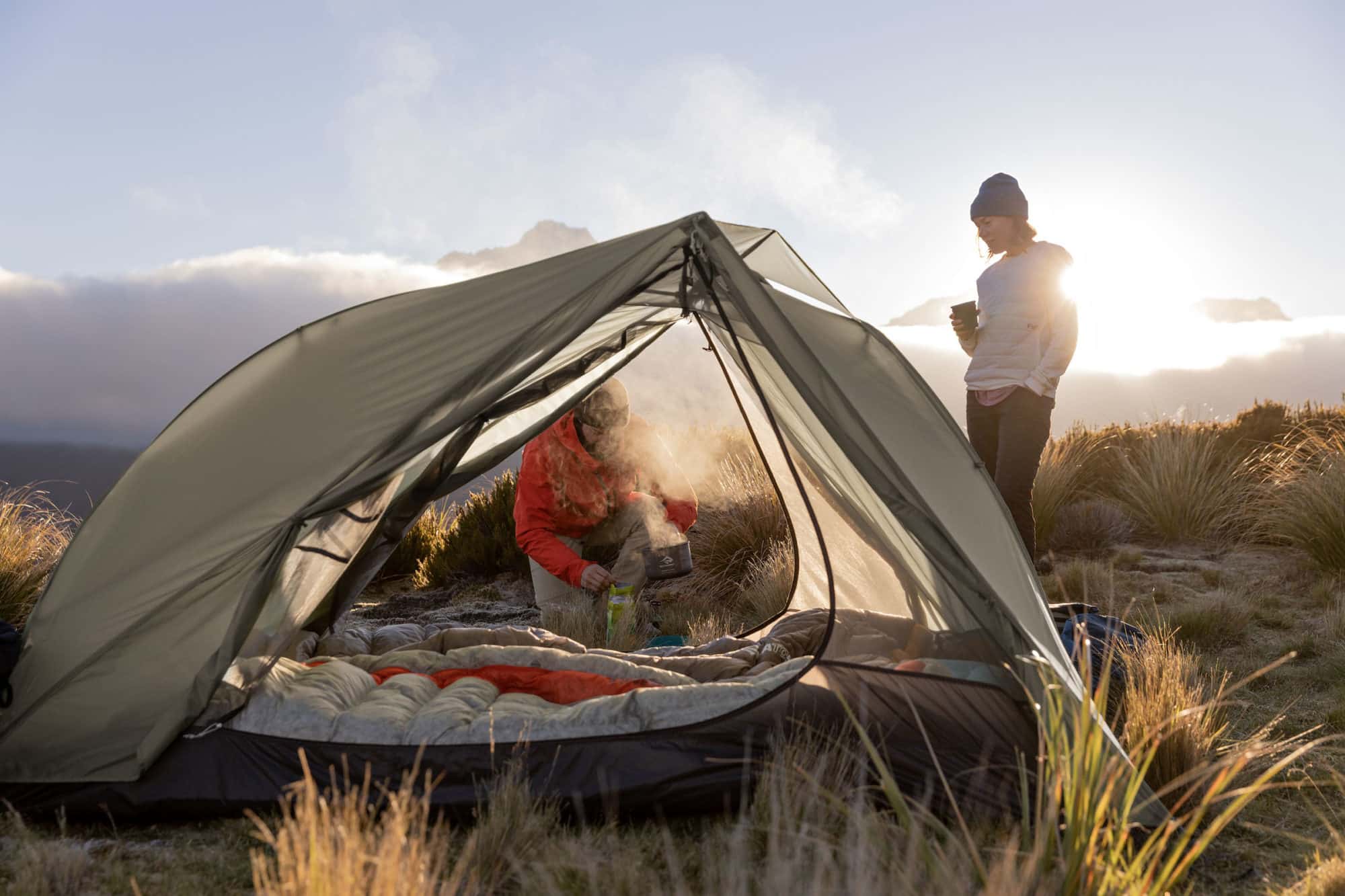
Sea to Summit has taken their award-winning Telos TR2 tent and made some improvements to better suit those looking to explore by bike while having somewhere comfortable to sleep. Equipping the tent with a pole set, with shorter pole segments. The tent comes ready to mount on your bike with a bike-specific storage system. Packing into two 420D waterproof and durable eVent Dry Sacks with Stretch-Loc Straps for reliable mounting.
A free-standing tent weighing 1.9 kg or 4.18 pounds which is a little on the heavier side. Ideal for bicycle touring as it takes up two fork bags when stored on the bike. You might have to compromise on your bikepacking setup to make it work. Check Price
Big Agnes Blacktail Hotel 3 Bikepack Tent

Looking for a hotel on wheels? This has to be the most comfort you can experience on a bikepacking trip. Even garage space for the bikes? The Blacktail Hotel 3 Bikepack by Big Agnes is a 3-season, free-standing tent with extended vestibules, offering two vestibules with 28ft²/ 9ft² or 2.6m²/ 0.8m² in space.
A bit of a heavier tent than most others in this list at almost twice the weight comparatively, at 7 lbs. 6 oz (3.35 kg). But that’s expected for a larger tent. As they say, it’s light enough for the backcountry and strong enough for the front country.
Featuring those short 12″ Shortstik Pole set for easy storage on handlebars, in bike bags or panniers. Including most other bikepacking features available in the Big Agnes bikepack tent range. You also get maximized storage options with an oversized ceiling pocket and multiple interior loops for use with gear lofts, and accessories.
Nemo Dragonfly Bikepack Tent

A ten made specifically for bikepacking. Comes with a durable diamond ripstop roll-top stuff sack featuring reinforcements and tie-down straps perfect for fastening to your bike. It can attach to your handlebars, under the seat, to any rack, or inside the frame. The poles are also made of shortened segments that keep the packed size small. The poles are also color coded with matching webbing for an intuitive set up.
The tent itself uses premium materials and a tapered floor plan to save weight without sacrificing livable space. A large vestibule with our new Landing Zone™ storage tub offers plenty of gear organization and space to put riding gear out of the mud. Weighing 3 lb 8 oz / 1.6 kg for the 2-person model.
Naturehike Cloud-Up 2

Looking for a tent that doesn’t break the bank? Super affordable while still backed up with quality and positive user experiences in the field. Including, mesh interior pockets, fairly durable rip-stop fabric materials, and a full-coverage rainfly, in a firm lightweight structure (1.7 kg or 3.75 pounds) that holds up well in windy conditions. But the price is really where this tent shines, check the price.
MSR Carbon Reflex
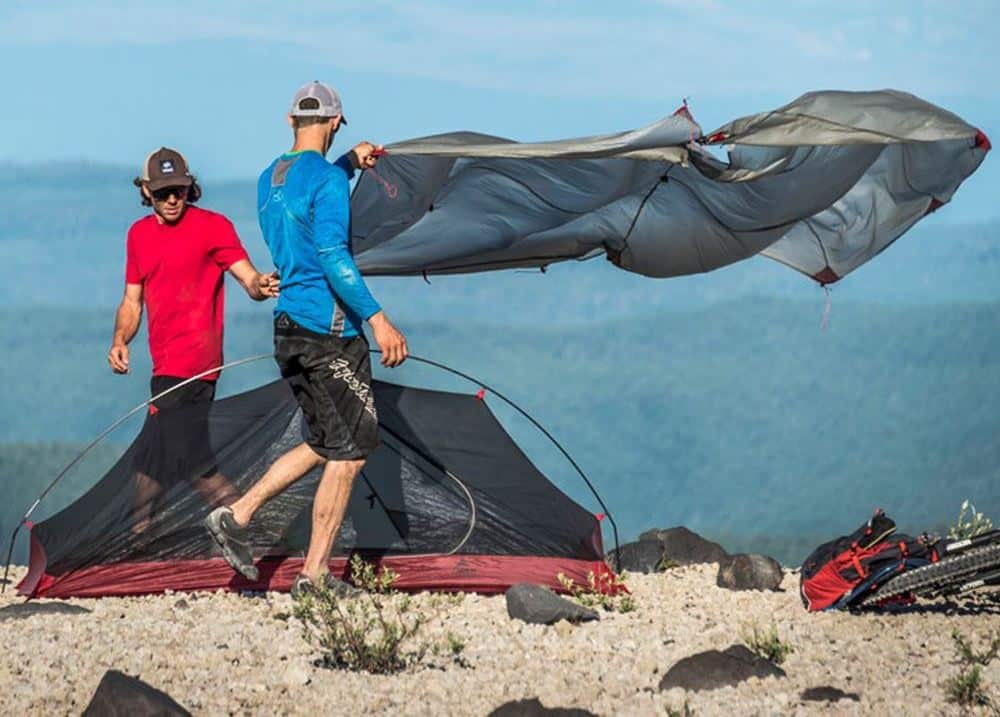
This tent is designed specifically for bikepackers, with a lightweight and packable design that is easy to carry on your bike. It has a single-pole structure and a waterproof rainfly, as well as plenty of ventilation to keep you comfortable in any weather.
The lightest full-protection, solo tent in the MSR lineup at 1 lb. 13 oz (822 grams) with double wall protection and maximum interior space. a simple, nonfreestanding design featuring a weight-saving, zipper-free vestibule. If you want to go even lighter weight in mild weather, leave the tent body behind and use the rainfly and footprint (sold separately) with the poles and stakes.
This tent does have some drawbacks as some users have complained about the pole failing multiple times and the hood ripping. Not the highest recommended tent in the list but worth mentioning.
Overall, these are some of the best bikepacking tents on the market. Whether you are looking for an ultralight option or a tent with plenty of interior space and headroom, there is a tent on this list that will meet your needs.
About The Author
Codey Orgill, a seasoned bicycle adventurer, has been exploring the world on two wheels for over 10 years. Since embarking on his initial cycling journey, Codey Orgill has traversed numerous countries, experiencing a series of epic adventures.
See author's posts
- Bikepacking Videos
- Adventure Stories
- Latest Arrivals
- Bikepacking Bags
- Camping Gear
- Accessories
- Rigid & Plus Bikes
- Drop Bar MTB
- Full Suspension
- Folding Bikes
- Cargo Bikes
- Commuter Bikes
- Bike vs Bike
- Bike Builds
- Handbuilt Bikes
- New Zealand
- United States
- Bikepacking Guides
- Bikepacking Gear Lists
- Bikepacking Food / Hydration
- Navigation & Route Planning
- Capturing The Adventure
- About Codey
- Work With Me
Related Post
Best synthetic sleeping bags, best ultralight sleeping pads – bikepacking camping gear, best sleeping bags & quilts for bikepacking and touring, bikepacking hammock : the only guide you need, 9 best bikepacking tarps – bike tarps for your next adventure, bikepacking stoves | best camping stove for bikepacking.

- Travel Gear
Bicycle Touring Tents: Everything You Need To Know
Tents are my home away from home. They are my space to take a well-deserved break and relax after a long day in the saddle.
Having spent hundreds, if not thousands of nights under sheets of expensive, lightweight, waterproof nylon – this is what I know about bicycle touring tents.
Tent Classification
In this article I will reference three different types of tent:
Ultralight: This type of tent favours weight over all other factors. Ultralight tents are great for short trips in good conditions – so don’t expect them to last a long time or be brilliant in wet and windy conditions. A typical problem with ultralight tents is broken poles, so always carry a splint. Typical weight: 800-2000g.
Backpacking: These mid-weight tents pick up some of the key durability features of 4-season tents and place them in a lighter weight and better ventilating package. Backpacking tents are often great for the average bicycle tour, or for longer journeys in warmer climates. Typical weight: 1500-2800g.
4-season: These tents tend to be most suitable for cool-mid climates and adverse weather conditions. If you’re planning on hitting sub-zero temperatures, snow and strong winds – this is what will work best. 4-season tents are often great for six-month or longer bicycle trips because of how durable they are. Typical weight: 2500-4000g.
Horses for Courses
Ok, so there is no best tent; different tents are better in certain situations.
Most of the time, you’ll need to strike a balance between weight (ultralight tents) and durability (4-season tents). With durability also comes better performance in the wind, tougher, more waterproof floors, and additional insulation properties in cooler climates.
High-quality 4-season tents tend to be expensive, twice the pack weight/size of an ultralight equivalent and perform poorly in warmer climates where heavier fabrics (and reduced mesh) limit the tents ability to ventilate well.
In summary, look for a tent that will suit both the climates you intend to travel through, the types of places you will camp and the number of times you’ll need to use it.
Freestanding vs Tunnel Tents
A great way to reduce your options is to decide whether you’re after a tunnel or freestanding tent.
Why should you buy a tunnel tent? – Tunnel tents are undoubtedly better in the wind at any given weight (eg. a 2kg freestanding tent vs 2kg tunnel tent). – The vestibules are often large and great for entertaining/cooking under. – They’re easy to set up (especially in the wind).
Why should you NOT buy a tunnel tent? – Tunnel tents rely on being staked out, limiting where you can set them up. – They’re 20-40% longer in length (bigger footprint) than a dome tent for the same inner size, again limiting where you can set them up. – Not as good at supporting snow on their roof. – They’re most of the time single entrance. – They have a lower, sloping roof; two people sometimes can’t sit up at once, or at all. – Poorer ventilation than most freestanding tents, especially if your gear is stored in the front and rear.
Why should you buy a freestanding tent? – They stand without staking, allowing you to pitch them anywhere. – You can easily pitch just the inner. – Two entrances is common. – They often have great ventilation. – You can pick up the tent, move it, shake it out, clean it etc – The roof can often withstand snow. – They’re more spacious internally (eg. headroom).
Why should you NOT buy a freestanding tent? – Not as good in the wind as a tunnel tent – you’ll need a comparably heavy freestanding tent to do well in adverse conditions.
My take: I cannot imagine travelling with a tunnel tent because I sleep on many surfaces which will not allow pegging – such as a concrete pier or basketball court. Heavy objects can be laid out to hold up a tunnel tent, but I prefer to pop up my freestanding tent anywhere without hassle.
Tents suitable for bike touring can be as lights as 800g or as heavy as 4000g. When comparing similarly priced products, the weight of a tent is often a good indicator as to how durable it will be.
Heavier 4-season tents employ more poles (that are reinforced) and thicker materials for the fly and inner. As a result, you will probably find a 4-season tent that lasts longer than an ultralight.
Size (1, 2 or 3-Person?)
What size tent is best for bicycle touring? It depends on how long you’re on the road.
On shorter tours (less than six weeks), you’ll be fine with a tent designed for the number of people you’re travelling with (eg. a solo traveller in a 1-person tent, or a couple in a 2-person tent).
On longer tours (more than six weeks) it’s worth getting a tent with a bit more space (eg. a couple in a 3-person tent). The space is nice; I can even fit all of my bags inside my 3-person tent inner with another person, giving me quick access to everything I carry.
If you will be camping in adverse weather conditions, you may want to consider a tent with large, usable vestibules (or a gear shed). They are great for entertaining, cooking, cleaning or repairing your bike in the rain.
Most freestanding ‘dome’ tent vestibules are actually pretty useless when it comes to their space being usable – tunnel tents with a gear shed are much better. If all you need is to store your bags, dome tents will of course be fine.
I’ve found that floors are one of the most important features of a tent in wet weather conditions. This is because the pressure applied from your body weight and bags is enough to force groundwater through the floor of most tents with a 5000mm (or less) Waterhead rating.
This is a common problem when you camp on surfaces that don’t absorb water well (gravel, clay, rock, concrete), as the water tends to run under your tent floor and permeates inside.
Ventilation
In general, ultralight and backpacking tent inners have more mesh, and 4-season tent inners employ more nylon. As a result, lighter weight tents tend to be better in warmer climates.
Some 4-season tents have nylon panels that zip away to expose large areas of mesh, which increases their ventilation and makes them more versatile. If you’re planning to use your tent in various climates, look out for this feature.
Depending on who you’re travelling with, the number of entrances in and out of your tent may be something to consider. It is no doubt less obstructive to have two side doors, where people can enter and exit the tent without climbing over or zipping near somebodies head.
If a tent with two entrances is important to you, you’ll find mostly freestanding tents with this feature.
Clips, Straps, Guy Ropes
The rule here is that simpler is better – complex clips and straps are just asking for trouble and are almost never field repairable.
Ideally guy ropes should attach at two locations on the tent poles, which dramatically increases the stabilisation of the tent in windy conditions. You’ll notice that all 4-season tents have this feature, and high end companies such as Hilleberg, have this feature on almost all of their tents.
Some tents are able to be pitched in the rain without getting the inner wet – such as my Mountain Hardwear Skyledge.
The way it works is that the groundsheet and fly can be pitched together, and the inner is brought in later and clipped to the poles. This has been handy for us from time to time but isn’t 100% necessary.
If you’re wild camping like me, you’ll find that light green or sandy coloured tents are great for a mixture of climates, from desert to forest. Darker green tents are great in thicker wooded areas.
Yellow and red tents do stand out, so only use them if you don’t need to be discreet.

Groundsheets
I love tent groundsheets. These thick material sheets keep my tent inner clean, protect the tent floor from sharp objects and are great to use as a picnic blanket at lunch time .
When I pitch my tent for days in a row, I also throw a groundsheet over the fly to protect it from the sun’s harmful UV rays. They are truly multipurpose.
Pick a bicycle touring tent which best suits your needs.
If you’re camping in warm climates, an ultralight or backpacking tent will be much more comfortable than a 4-season given the liberal use of mesh.
In adverse weather conditions or if you’re travelling for a long time, a 4-season bicycle touring tent with a gear shed may be beneficial.
Recommendations
For someone…
Who will spend 2-3 weeks touring per year in good weather conditions? A sub-1500g ultralight freestanding tent designed for the number of people travelling together. Check out the Tarptent Double Rainbow .
Who is on a three month trip in good weather conditions? A freestanding backpacking tent with space for one more person. Try the MSR Nook, Vaude Hogan , Mountain Hardwear Skyledge or Mont Moondance .
Who is on a three month trip in a cooler climate with a high chance of adverse weather conditions? A 4-season freestanding or tunnel tent with a gear shed. Try the Hilleberg Nallo GT or Vaude Hogan XT.
Who is riding through lots of deserts? A 4-season freestanding or 3-season tunnel tent for sure. Deserts are windy! Check out the Hilleberg Nallo or Allak .
Who is on a 12-month plus trip? Either: Invest, invest, invest in a high-end 4-season tent. A Hilleberg Staika or Exped Venus freestanding tent will cost an arm and leg but you will almost definitely get 1000+ nights out of it. Or: If your trip will take you through predominantly warmer climates, an ultralight or backpacking tent will be cooler, but less durable. You may have to replace it sometime on your journey. Check out the Mountain Hardwear Skyledge , Vaude Hogan or Mont Moondance .
Reputable Brands
Exped: High quality, high-end tents. Hilleberg: This company is world-renowned for making some of the best, most durable tents. Don’t expect to end up with change after purchasing one. Mont: Australian tents which have the magic combination of a 10,000mm floor and lots of inner mesh. Mountain Hardwear: Although I broke poles and clips on my original Skyledge 3 tent, the replacement tent is very light, easy to pitch and super ventilated. MSR: Highly popular for a reason – good range, decent quality and ok price. REI: Great budget tents. Tarptent: Ultralight tents at a decent price point. Terra Nova: Super high quality, renowned for their waterproofness. Vaude: A decent range, high quality and popular for many world tourers.
Related Posts
- Review: Mountain Hardwear Skyledge 3 Tent (2011)
- Review: Salewa Sierra Leone II Tent (2013)
- Mont Moondance Tent Review: Tough Enough For The Americas?
- Use Your Tent Groundsheet as a Picnic Rug on Tour
- groundsheet
- tent review
- wild camping
I had a light weight summer hiking tent but it devoloped a hole in the mesh so I am planing on buying a new one. I wasn’t sure if I should get a 3 or 4 sesson tent so I statred to look at some bivys becasue they are small and light, and can be rolled out and climbed into after a long day. They are good for quick sleeps but don’t afford much room for extened stays. I want to ride through the Snowy Mountains and do some hiking just before the ski season. I know a 4 season tent is required and I will buy one, but I still think I should get a bivy sac as well.
There is a tent that really deserves attention, the american-made Tarptent Scarp, It is basically a tunnel tent with central arcg like the iconic Hilleberg atko, but with many improvements, it has entrances and vestibules on both sides, rectangular rather than wedge-shaped and a bit more spatious, they make it for one or two persons bur the solo version can reportedly accomodate two. It is cheaper and lighter than the atko but lighter wieight comes at the cost of less durable materials. It has the wind resilience of a tunnel tent but with two optional bars can be reinforced and transformed into a free standing tent, the best of both worlds type of thing. On the down side, they make only a greyish white colour which may be good to reflect off the sun but doesn’t hel to blend in anywhere.
Thanks for the suggestion!
A very comprehensive guide and Mont is grateful for the mention. Thanks Alee!
Mont Adventure Equipment
The most important change in tents in decades is just around the corner and it’s name is Dyneema. When Hilleberg makes a big tunnel tent with vestibule and they build the fly out of Dyneema I will Jump on it. 2/3 the weight, totally waterproof and only twice the price!
No mention of Wilderness Equipment out of Fremantle? I used one of their Second Arrow tunnel tents on two long trips – first from Perth to Brisbane and then half-way up South America. In all weathers, it never let me down. Admittedly not the two person tent they claimed it to be, but a very livable tent for one person. It can be pegged out with just three pegs, the floor of the inner can be rolled back for plenty of room for cooking, and the ventilation options make it suitable for almost any climate. Mine’s nearly twenty years old and not as waterproof as it once was, but I’d certainly buy another.
There’s too many tents to mention! Thanks for the recommendation.
Comments are closed.
- Hiking Shoes
- Hiking Boots
- Hiking Sandals
- Trail Runners
- Base layers
- Hiking Shirts
- Fleece Jackets
- Softshell Jackets
- Rain jackets
- Down Jackets
- Hiking Pants
- Hiking Shorts
- Base Layers
- Rain Jackets
- Hiking Bras
- Baby Carriers
- Cookware Sets
- Water Filters
- Water Purifiers
- Sleeping Bags
- Sleeping Pads
- Hiking Poles
- GPS Devices
- Solar Chargers
- Dive Regulators
- Dive Computers
- Dive Watches
- Dive Wetsuits
- Dive Gloves
- Dive Lights
- Dive Knives
- Spearfishing Wetsuits
- Spearfishing Masks
- Spearfishing Fins
- Spearfishing Watches
- Freediving Wetsuits
- Freediving Masks
- Freediving Fins
- Freediving Watches
- Sit On Top Kayaks
- Inflatable Kayaks
- Fishing Kayaks
- Tandem Kayaks
- Touring Kayaks
- Kayak Paddles
- Kayak Seats
- Kayak Roof Racks
- Kayak Carts
- Stand Up Paddle Boards
- Touring SUPs
- Inflatable SUPs
- Fishing SUPs
- SUPs For Yoga
- SUPs For Surfing
- SUP Paddles
- Climbing Boots
- Belay Devices
- Climbing Shoes
- Women's Climbing Shoes
- Bouldering Shoes
- Approach Shoes
- Climbing Pants
- Bouldering Pants
- Mountain Bikes for Men
- Mountain Bikes for Women
- MTB Handlebars
- Bike Saddles
- Bike Computers
- Bike Lights
- MTB Jackets
- Bike Helmets
- Bike Packing Gear
- Fat Biking Gear
- Ski Bindings
- Ski Helmets
- Ski Goggles
- Ski Jackets
- Snowboarding Bindings
- Snowboarding Boots
- Snowboard Helmets
- Snowboard Goggles
- Snowboard Pants
- Snowboard Jackets
- Snowshoe Poles
- Avalanche Beacons
- Avalanche Probes
- Avalanche Shovels
- Ski Backpacks
- Surfboards For Beginners
- Surfboards For Kids
- Surfboard For Small Waves
- Soft Top Surfboards
- Foam Surfboards
- Body Boards
- Boogie Boards
- Kiteboarding Kites
- Kitesurfing Boards
- Kiteboarding Harnesses
- Surfing Wetsuits
- Men's Rash Guards
- Women's Rash Guards
- Board Leashes
- DLSR Travel Cameras
- Mirrorles Travel Cameras
- Point and Shoot Travel Cameras
- Fuji Travel Lenses
- Nikon Travel Lenses
- Tripods for Travel
- DLSR Landscape Cameras
- Mirrorles Landscape Cameras
- Point and Shoot Landscape Cameras
- Fuji Landscape Lenses
- Nikon Landcape Lenses
- Canon Landcape Lenses
- Tripods for Landscape Photo
- Wildlife Cameras
- Wildlife Lenses
- Wildlife Tripods
- Wildlife Monopods
- Birdlife Cameras
- Birdlife Lenses
- Surfboards For Small Waves
Best Tents for Bike Touring of 2024
The map is spread out on your dining table (or more likely your computer screen) and you are planning your next epic adventure. The roads less travelled, destinations you’ve only dreamed of, and adventures into the wilderness.
But wait…the wilderness doesn’t have hotels!!
So it’s time to find a suitable shelter that you can take with you. What is the best tent for bike touring, you ask? It’s a tent that can be packed up small enough to fit on the handlebars of your bike, one that is lightweight so you aren’t carrying too much weight, and one that can handle any weather conditions you might encounter along the way, anything from rain and wind through to hot summer nights.
We scoured high and low to find the best tent for bike touring. There are plenty of options to choose from; tiny tents, spacious tents, tents with storage, multi-person or single person tents. We shortlisted the best options with varying qualities to help you find the perfect tent for your next bike touring adventure.
For more of our top bike touring gear recommendations, check out the Best Stoves for Bike Touring .
Quick Answer - The Best Tents for Bike Touring
- Big Agnes Fly Creek HV UL2 View at REI
- The North Face Stormbreak 1 View at Backcountry
- MSR Hubba Tour 1 View at Moosejaw
- Winterial Single Person Bivy Tent View at Amazon
- Nemo Apollo 3P View at Amazon
Comparison Table - Best Tents for Bike Touring
Reviews - the best bike touring tents, big agnes fly creek hv ul2.
- Canopy Material : Nylon/polyester mesh
- Capacity : 1P / 2P
- Design Type : Semi-Freestanding
- Floor Area : 28.0 sq ft
- Weight : 2 lbs 04 oz
- Season : 3-Season
- Sleeping Capacity : 2-Person
- Waterproof? : Yes
- Packed Dimensions : 5.5” x 12”
- Pole Material : Aluminium
- Multiple Internal Pockets For Storing Gear
- Durable Rain Fly For Protection In Bad Weather
- Tent Designed Specifically For Bike Packing With A Small Packed Size
The Big Agnes Fly Creek HV UL2 is an ultralight tent that has been recently redesigned to give it steeper walls and more interior space than the older model. It’s a great option if you’re looking to cut weight but aren’t willing to splurge on a high end, super light tent.
What we loved the most about this tent is it is light but still can be set up with proper tent poles. Some other ultralight tents on this list need to be pitched with trekking poles, which is resourceful but it puts some people, especially new backpackers off.
The Fly Creek HV UL2 might not cut it for true ultralight hikers who count every ounce. Our biggest drawback is the single door. That’s fine if you’re going to use this tent for solo adventures but it’s a real pain for two people. On that note, unless you and your partner are short and slim, sleeping two people in this thing is going to be a struggle.
In conclusion, this is a good option for solo hikers who are looking for a practical lightweight tent to use in summer and spring.
The Fly Creek HV UL also comes in a 1-person version
The North Face Stormbreak 1
- Canopy Material : Polyester Taffeta
- Design Type : Freestanding
- Weight : 3.2 lbs
- Sleeping Capacity : 1 Person
- Packed Dimensions : 7” x 9” x 21”
- Small Design Keeps It Lightweight
- Mesh Netting For Good Ventilation
- Simple Design Makes It Easy To Pitch
BEST FOR: WINDY AND WILD WEATHER
Heading out when there may be some wind and wild weather? The North Face Stormbreak 1 is an ideal choice for you. It has an X pole design, where the poles cross over each other, giving it plenty of structural stability to stand up to strong winds. The aluminium poles and minimal design keep this tent a lightweight package.
The mesh netting allows for good ventilation, while the rain fly holds up to rain. The North Face thought of some clever tricks to make this tent easy to assemble by color-coding the corners of the main shell with the rain fly so you will easily get it right every time. The tent also features a small vestibule allowing you to store your packs and any other small items you want to keep dry.
This tent is specifically designed to sleep one, and for the price point paired with a good quality package it would be hard to go wrong selecting this tent for your next adventure.
MSR Hubba Tour 1
- Canopy Material : DWR Coated Ripstop Nylon
- Design Type : Semi Freestanding
- Weight : 4.7 lbs
- Packed Dimensions : 7” x 17”
- Pole Material : Aluminum
- Short Poles Allow For Small Packed Size
- Spacious Vestibule For Storing Gear Overnight
- Unified Rain Fly For Quick Pitching
BEST FOR: THE LUXURY BIKE TOURER
If sliding into a small bivy tent is not your idea of a good time, and you’re looking for something that is a little more spacious for both you and your gear, then the MSR Hubba Tour 1 could be the tent for you.
While this tent is not as light as some of the others on this list, for its spacious size it is still a light-weight package. Additionally its packed size is a mere 5.5” x 17” which makes it a great choice for bike packing.
The specially designed tent, with an exoskeleton frame (meaning the poles are on the outside of the tent) makes pitching this tent quick and easy. Paired with the unified rainfly, the main canopy is also waterproof, meaning even in wet weather the inside of the tent will stay clean and dry. The large vestibule allows plenty of space for your gear or lots of space for you to wait out a bad storm.
Winterial Single Person Bivy Tent
- Canopy Material : Nylon
- Weight : 2.9 lbs
- Packed Dimensions : 18" x 4.5" x 4"
- Includes Cords And Stakes To Secure The Tent
- Ventilated Mesh Inner Walling To Keep You Cool And Comfortable
BEST FOR: BUDGET CONSCIOUS ADVENTURERS
The Winterial Single Person Bivy Tent is an excellent choice for those who don’t want to spend too much money. This is the lowest cost option on the list, however it is not lacking in all the key areas that you would look for when purchasing a tent for bike touring.
Weighing in at under 3 pounds and packing up into a relatively compact bag, it’s perfect for strapping onto your bike and hitting the road. This is a bivy tent (see Features Explained section below for more explanation) which means it is short and you will not be able to stand or sit in the tent. The benefit of the small bivy design is that it uses less material and makes this tent super lightweight.
Pitching the tent is easy as it uses a 2 hoop design, where the lightweight poles simply snap together and thread through the tent loops to create the structure. The inner mesh material allows for plenty of ventilation, perfect for the warmer months. Plus it has a rain fly for when the weather turns bad, making it suitable for heavy rainfall. This tent will see you through three seasons and is a great value for cost option.
Nemo Apollo 3P
- Canopy Material : Ripstop Silnylon
- Design Type : Non-Freestanding
- Weight : 1.11 lbs
- Sleeping Capacity : 3-Person
- Waterproof? : No
- Packed Dimensions : 5.1” x 18.9”
- Lightweight And Small Packed Size
- Adjustable Pole To Change The Height Of The Tent
BEST FOR: SUMMER ADVENTURES WITH FRIENDS
If you’re headed out for a summer bike-packing adventure with some friends, or headed out solo but want to keep you bike and gear in the tent with you, then the Nemo Apollo 3P is just what you need.
The simplistic adjustable center pole design makes this tent extremely quick to set up with the ability to vary the height based on your requirements. The single wall construction and floorless design paired with the single pole makes this an ultra-light tent especially considering it will fit up to 3 people.
Travelling with a friend? You can easily share the weight by splitting up the poles, stakes and tent shell, which will leave each of you carrying less than 1lb of shelter weight. While not completely waterproof, this tent is designed with durable materials and is able to withstand light winds, making it perfect for summertime when the weather is typically more mild.
THINGS TO CONSIDER WHEN BUYING A TENT FOR BIKE TOURING
When bike touring , every ounce matters. The more weight you have, the harder you have to work to carry it around. Lightweight tent options are plentiful and there are plenty of multi-person tents available to share the weight of the tent with your fellow bike tourers.
There are three main styles of bike touring tents:
These are the smallest style of bikepacking tent. They have minimal height and are very compact and lightweight. This style will generally only fit one person and their sleeping gear. You will not be able to sit up inside the tent. Read more about Bivy Tents and Bivy Sacks here.
Single Pole
This style of tent has a single main pole in the center and the edges are staked out to give the tent its shape. Single pole tents come in a variety of sizes. They can be lightweight but do take some practice to pitch.
Exoskeletal Frame
Tents with an external frame use poles that snap together to form the skeleton (structure) of the frame. They can come in either multi-hooped design, X- design, or T-section. These tents are quick to pitch and semi-freestanding. They still require staking but will hold their structure even without being staked down, making set-up super easy.
INTERNAL TENT SPACE
How many people do you want to fit in the tent? Do you want to fit your gear and packs in there too? These are all questions to ask yourself as they will help determine the best tent option for you.
An advantage of choosing a multi-person tent instead of each person on the trip having a solo tent is the overall weight is not doubled from a single to double person tent. This means you can share the weight of your tent with your bike touring buddy, helping to reduce the overall weight each of you are carrying.
PACKED SIZE
Typically the length of the poles has the biggest impact on the length of the packed size. Ensure the packed tent can fit onto your bike, whether it’s inside bags or perhaps on your front handlebars. Alternatively you can store the poles and stakes separately to the canopy and rainfly to help distribute the weight.
FEATURES EXPLAINED
Tent shells.
This is the outer shell that is designed out of waterproof material and will often have additional waterproof coatings. The seams on the rainfly will also be specially sealed to increase the waterproof qualities. This shell is attached over the top of the tent.
Ventilated Mesh Inner
This is often the inner layer and main component of the tent shell. It’s made from a mesh material which allows for ventilation, helping you stay cool and comfortable while camping in the warmer months. During the warmer months and in good weather these can be used on their own. If used in conjunction with the rainfly, a mesh inner allows for airflow which decreases the chance of condensation forming. Less condensation = more heat so you can stay toasty in the cooler months as well.
Unified Rain Fly
This is a single shell that integrates the rainfly into the main component of the tent shell. Tents with a unified rainfly can be pitched without getting the inside wet even if you’re setting up in the rain.
This is the term used to describe putting the tent up.
These are made from metal or strong plastic and are used to hold the tent to the ground.
These are most commonly made from aluminium and will either dismantle or be adjustable so they can be stored in short lengths for easy transport. The aluminium poles that dismantle are very easy to use, simply by sliding them in or out of one another to create longer poles that are used in the exoskeletal tent design.
POLE DESIGNS
There are a variety of designs that use aluminium poles that join together. The advantage of this is the poles are compact yet when joined together they form a flexible yet strong structure. The tent shell is then attached to this structure. There are a variety of ways these poles can be used:
Hooped designs use lengths of aluminium poles that create a flexible semi circle. A tent with a hooped design will feature 2 or more hoops that are placed at either end of the tent, which creates the structure of the tent.
X-Style designs use equal lengths of aluminium poles that create a flexible semi circle. Two of these poles are crossed over one another to create an X shape and form the structure of the tent.
T-Style designs use two varying lengths of aluminium poles. The longer length pole forms a semicircle while the shorter length poles connect to the middle of the long pole to form a T-shape.
Freestanding tents are a sturdy structure that do not require stakes to be inserted into the ground to hold them upright.
Semi-Freestanding tents are a sturdy structure that can stand on its own when pitched. However, they require staking into the ground to hold them in place.
Non-Freestanding tents have no independent structure and can not stand on their own without being staked into the ground.
For more of our top bicycle touring gear recommendations, check out these popular buyer's guides:
Touring Bikes
Bike Handlebar Bags
Touring Tires
Panniers for Touring
Touring Saddles

Bicycle touring. Outdoor adventures. Solo female travel.

The best tents for bicycle touring in 2024- buyer’s guide
Cycling tours are a great way to explore new places and get some exercise. But after spending a lot of time on your bike, getting a good night’s sleep is crucial. A good tent is one of the most essential pieces of gear.
There are a lot of different tents on the market, so it can be tough to know which one is right for you. But don’t worry – I am here to help. In this article, I’ll give you a rundown of the best tents for bicycle touring so you can choose the best one for your next adventure.
This post may contain affiliate links and I may earn a small commission when you purchase products by clicking on the links (at no additional cost to you). It will help me keep working on this blog. Thank you for your support!
How to choose a tent for bicycle touring?
I am going on my first trip by bike. Can you recommend a good tent for bicycle touring? I’ve heard and seen this question a thousand times. The problem is there is no right answer .
Every tourist and cyclist has different needs and a different budget. A perfect tent doesn’t exist. Finding the best one involves trade-offs between weight, sturdiness, price, and a few other factors.
Are you planning to wild camp or stay on official campsites?
If you’re not planning to wild camp but only stay on official campsites or in people’s gardens (yes, that’s possible thanks to great initiatives like Welcome to My Garden! ), you don’t need to think about the colour of your tent.

If you’re going to stealth camp, you definitely want to stay unseen for your safety. In this case, dark green or brown will always be better than flashy yellow or red tents that look cool on Instagram.
What weather are you expecting?
Before choosing a tent for your bicycle tour, consider the weather you can expect. If you plan to cycle the Pamir Highway or Trans Patagonia, your tent must handle unpredictable mountain weather. Some nights will likely be windy and rainy, so you want a sturdy and resilient shelter.

If you’re travelling to the tropics, you want a tent with good ventilation. It also shouldn’t get too hot, so brighter colours that reflect the sun will be an advantage. Especially in countries where Malaria is common, it’s good to have a tent where you can use the mesh separately, without the rain fly. This will protect you from mosquitoes while giving you extra ventilation.
How much money can you spend and how long will you use the tent?
Outdoor gear is expensive. If you are only beginning your bike touring and camping adventure, you don’t want to spend a few hundred bucks only to find out you don’t enjoy it. Many of us also have a very limited trip budget and can’t afford to buy an advanced ultralight tent.

Luckily, there are some decent, cheaper options on the market. Most solid low-budget tents are heavier than the more expensive ones with similar features. Going for something really cheap and ultralight can be a recipe for disaster: breaking poles, leaking fabrics, unstable construction… So, if your most important criterion is the price, look rather at a bit heavier tent. In my rundown below, I will include some low-budget options recommended to me by other bike tourists and outdoor enthusiasts.
There are also other ways to save money when buying a good, cheap tent:
- Shop after the season. September/October offers many great deals, with savings of up to 60 %.
- Buy second-hand. There are many websites and Facebook groups where people sell their used outdoor gear. You can read more about it here .
How important is comfort for you?
Are you looking for a tent that will be only a shelter, a place where you survive the night? Or do you want something where you can sit down, play cards, and feel a bit more at home ?
Every person has different expectations when it comes to comfort when camping. If you plan to travel for many months, you’ll probably need a bit more space. Are you more of a weekend traveller, someone who goes for short but intense bike trips? Then you’d rather want to save weight instead of carrying a big comfy tent.

Tent specs explained
Waterproof rating.
Nobody wants to wake up in a tent with water dripping on their head. That’s why you should always check the waterproof ratings before buying a tent.
They express how much millimetres of water the tent can withstand before it leaks. For example, a tent with a waterproof rating of 1000mm can withstand the weight of 1000mm of water. Theoretically, the higher the waterproof rating, the more water the tent can withstand.

Yet waterproof ratings only tell part of the story. You need to consider the quality of the materials and the construction of the tent. A high-quality tent with a lower waterproof rating can keep you dry for as long as a tent with higher ratings made of cheap materials. Wear and tear, and abrasion also play a role, so it’s important to maintain your gear.
As a rule of thumb, you should choose a tent with at least a 1000 mm waterproof rating.
Packing weight vs trail weight
Most online shops list two values for weight in the tent specs: packing weight and trail weight. Which one is more important, and what do they mean? The trail weight is just the weight of the poles, the body, and the rainfly, unlike the packing weight, which also includes the pegs, guy lines, sack, and other accessories (like a repair kit).
Long story short, you should rather look at the packing weight, not the trail weight.
What are the best tents for bicycle touring?
It would make sense if I start with the tent I use myself. On my bicycle tours, I sleep in a Fjord Nansen Tromvik II . It’s a light (2 kg) 2-person tent that’s pretty spacious (even if I travel with someone, we can put our stuff in the tent).

I am not including it on my recommendation list for two reasons:
- It’s sold out in all the shops I’ve checked.
- I had a few issues with it – the fabric is quite fragile, and the poles let me down a few times. To do justice to the manufacturer, since I complained and received a replacement with an improved design, I haven’t had any problems. But the adventures with Fjord Nansen Tromvik II gave me enough experience to write an article about how to fix the most common issues with a tent .
The pros of this tent are magnificent weather resistance. I survived a few heavy storms in Normandy and windy mountain nights.
So let’s move on to the other tents I chose, based on recommendations from fellow bicycle travellers.
I will start with the “premium” tents between 300 and 600 euros. Later, I will present a few less expensive tents between 49 and 250 euros.
Premium tents for bicycle touring
Big agnes copper spur hv ul 2-person bikepacking tent.
An ideal tent doesn’t exist, but Big Agnes Copper Spur HV UL 2 is as close to perfection as it gets. Many 2-person tents are not spacious enough to provide a comfortable shelter to two people, but not this one! At the same time, it only weighs 1,59 kg.
As one of the first manufacturers, Big Agnes offers a special edition for bikepacking and bike touring. These tents have shorter poles to better fit on the handlebar or in the panniers. The stuffing sack has special loops enabling you to attach it with straps to your bike.
Buying an ultralight tent like this comes with a price: the materials are quite fragile, and you must handle the Copper Spur gently. For this price, many people would expect a more durable tent. The weak spots seem to be the floor and the poles.
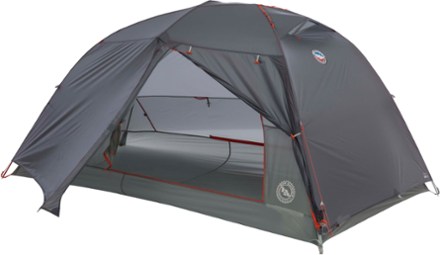
The regular version is about 50 euros cheaper than the bikepacking one. If you don’t care much about shorter poles and all the bike-specific gadgets, it can be a good way to save money.
Big Agnes Fly Creek UL2 Bikepacking
Another great alternative from Big Agnes is the Fly Creek UL2 Bikepacking . It’s also a two-person tent but significantly smaller than the Copper Spur. It’s a great option if you are willing to trade comfort for weight (only 1,19 kg) and price (about 450 euros).
Fly Creek also comes in a cheaper backpacking version with longer poles and as a 1-persons tent .
This model has many cool pockets and solutions to help you organise your stuff inside the tent and under the rain fly. If you are messy like me, you’ll definitely appreciate that.
Besides the limited living space, another downside of Fly Creek UL2 is the colour. The yellow tent looks awesome in the pictures. But, if you’re camping not far from civilisation, it doesn’t help you to be an invisible ninja.
NEMO Dragonfly 2
If you are looking for a lightweight 2-person tent, Nemo Dragonfly 2 is a great option. Weighing only 1,41 kg, it has enough space for two people with many pockets and large vestibules to store your gear. A special bonus for stargazing lovers: on rainless nights, you can camp without the fly and the non-transparent will still give you a sense of privacy.
Nemo Dragonfly is easy to set up, and the colours blend well with the landscape. The only downsides are the high price (about 450 euros) and the ventilation, especially when two people are in.

Tarptent Moment DW
The Tarptent Moment DW is a lightweight tent perfect for fast-moving adventures.
This one-person tent is easy to set up (it shouldn’t take more than 2 minutes). It is completely freestanding which is super useful when camping on hard ground. The Moment DW is also very light – 993 grams (about 2 lbs.), so it’s easy to carry with you on your travels.
It’s also very water resistant – even in storms – so you can stay dry and safe even when things get rough out there! It has enough space to keep your gear inside.
The best low-budget tents for bicycle touring
In this section, I will present the cheaper tents for bike touring. I will start with the cheapest option.
Quechua MH100
This basic tent from Decathlon costs only 50 euros and is a decent option if you’re on a shoestring budget. It is sturdy and reliable compared to similarly priced tents (like the Vango Soul 100, which is known for its faulty poles).
Quechua MH100 is a two-person tent, and although it’s not very heavy (2,4 kg), it’s rather bulky. It should keep you dry and safe even during heavy rains, but the ventilation is poor when two people are inside.
Vaude Campo Compact XT 2P
If you are looking for a weather-resistant two-person tent for reasonable money, the Vaude Campo Compact XT 2P is a good option. It has excellent waterproof ratings and costs about 160 euros.
It is pretty spacious and has many inner pockets to store your belongings. The construction is simple and easy to set up, ensuring stability even during windy nights. It is available in two colours: red and green, the latter perfectly blending in with the environment when you are wild camping.
Unfortunately, Vaude Campo Compact XT 2P is quite heavy (3 kg) and has only 1 entrance, which is annoying if you share the tent with another person.
VANGO-Nevis 200
The Vango-Nevis 200 is a great low-budget tent for bicycle touring. It has great waterproof ratings (6000 mm floor, 3000 mm fly), is lightweight (2kg), and easy to carry around. And it’s green—perfect for discrete wild camping!
This tent can fit two people with gear, but it won’t be comfortable. The tunnel design can feel a bit claustrophobic, like a coffin.
You’ll have to be careful in windy conditions—the tent can be flappy in strong winds.
Big Agnes- C Bar 2
The Big Agnes C Bar 2 – 2-man tent is the best option if you want lightweight but don’t want to spend too much money. It’s not the most expensive tent on the market, but it’s not cheap either.
It’s light at 1810g and sets up easily, which means you won’t have to waste time fiddling around with poles. It’s also free-standing and has good head clearance, which makes it nice for tall people.
The only downside is the light colour of the fabric, which makes the tent easy to spot and get dirty.
What tent do you use on your bicycle tours? If you have good recommendations for a reliable bike touring tent, share them in the comments!
Share this:
Related posts.

Cycling in Estonia: Practical bike touring guide

Best Cycling Routes in Gdańsk. Biking adventures in Tricity and Around

Cycling solo in Norway. Through tunnels and fjords
Skomentuj cancel reply, 3 thoughts on “the best tents for bicycle touring in 2024- buyer’s guide”.
Great article. I realize your directing your article at Europeans but for my tent for biking and camping Sierra Designs which along with Northface started the camping backpacking industry/experience here in US had Sierra Designs Clip Flashlight 1. 2.5 kgs. This lasted me 15 years. The Clip Flashlight 2 was manufactured and then for some reason discontinued about 2 years ago but I called SD and last year luckily found a retailer in US who still had some in stock. About same weight and more plastic parts but still great tent. Glad I had it last December camping in a rainy tropical park in Colombia. Dennis
Thanks Dennis for your comments and the recommendations! So lucky for you they still had your favourite model in stock, a tent that lasts 15 years is a rare bird these days. Hope the new one will last you as long too!
Pingback: Camping alone as a woman - are you gonna die? - Wobbly Ride
Privacy Overview
SORT CONTENT BY LOCATION
CLICK TO DRILL DOWN BY COUNTRY/PROVINCE
Your browser is ancient! Upgrade to a different browser or install Google Chrome Frame to experience this site.
Inspiration
- Bikepacking 101
- Join/Support

- View Latest/All
- Bikepacking Videos
- Your Stories
- Rider's Lens
- Field Trips
Popular Tags
- #bikerafting
- #Tour-Divide
- #family-bikepacking
- #winter-bikepacking
- #1Q5V (1 Question 5 Voices)
Gear/Reviews
- Bikepacking Bags
Camping Gear
- Accessories
- #Editors-Dozen (Our Favorite Gear)
- #Gear-of-the-Year
- #MYOBG (DIY)
- #Decade-in-Review (Best of All Time)
The Gear Index
Latest indexes.
- Mini Panniers
- Saddlebags & Top Openers
- Cargo Cages & Anything Bags
- Gravel Bars
- Drop Bar 29ers
Bikepacking Bikes
- Rigid & Plus Bikes
- Drop-bar & Gravel
- Full Suspension
Rigs & Roundups
- Rider & Rig
- Race/Event Rig Roundups
- Worthy Builds
- Handbuilt Bikes
- #29+ (29-plus)
- #vintage-mountain-bikes
- #cargo-bikes
- Readers' Rigs (Dispatch)
- New Bikes (Dispatch)
Plan Your Trip
- Bikepacking Guides
- Bikepacking Food
- Gear & Pack Lists
- Bike Photography
Essential Reading
- Leave No Trace (for Bikepackers)
- Guide To Bikepacking Bags
- Bikepacking Gear That Lasts
- #Bikepacking-Awards
- Power Of An Overnighter
- Advice For New Bikepackers
- Our Favorite Bikepacking Routes
-
Where to Begin
We have over 300 original and curated bikepacking routes in our global network spanning nearly 50 countries.

Start at our worldwide routes map to dig into our detailed guides with GPS maps and inspiring photography.
By Location
- The United States
- Latin America
- Middle East
By Length (days)
- Overnighters & S24O
- Weekend Routes (2-4)
- Week-long Routes (5-10)
- Odyssey Routes (11-30)
- "Freakouts" (31+)
Local Overnighters
The Local Overnighters Project is a unified effort to document and map one-night bikepacking routes all over the world—by locals, in their own backyards.
The Bikepacking Journal is our biannual printed publication. Each issue features a collection of inspiring writing and beautiful photography. Find details on the three most recent issues below, join the Bikepacking Collective to get it in the mail (anywhere in the world), or click here to find a collection of selected stories in digital format.

For Issue 11, we head to Iceland with two contributors and photographers, plus share a handful of brilliant adventures from Mexico, Spain, the Republic of Georgia, and riders' own backyards...

The special edition 10th issue of The Bikepacking Journal is one you won’t want to miss! It features 25% more pages with extra stories, bonus art and maps, and much more...

Issue 09 takes readers on trips through time—one to the early days of bicycles—and offers several reminders to be grateful for supportive friends and family, and strangers we meet along the way...

Trading Space for Comfort: Gear for a Semi-Minimalist Bike Tour
Space (and weight) versus comfort is a tricky (and expensive) battle that we cyclocampers fight regularly. Tents, sleeping bags and pads make up the majority of heft and bulk that has to be packed and stowed. In an effort to go as ultralight as possible for an upcoming trip, with minimal luggage, I put together a kit using The Mother of Comfort.

PUBLISHED Oct 24, 2013
There are many forms of cycle touring that differ by the type of luggage used, nature of the terrain covered and the amount of gear carried. On our last tour we were ‘fully loaded’ with four panniers per bike, and then some. While we were still able to push these weighty rigs through some mountain biking style routes, we decided to make our next tour more about ride and route quality than quantity. In December we depart on a trip through South and eastern Africa, and our plan is to bikepack with as little gear as possible, light enough to have fun exploring some off-road routes, but still have the gear to camp comfortably. Because we’ll be covering a lot of ground, we also intend to skip some of the big monotonous stretches by relying on a few rides as well as a train or two. This mountain-hitchbiking method of touring requires careful consideration of gear and luggage. Space is key for a bikepacking setup, as well as ease of public transport, and sleeping gear is always the capacity hog. In a previous post I mentioned sleeping pad options for bike touring ; we’ll both be taking the Big Agnes Q-Core Superlight pads stowed in fork-mounted cages to cut down the bulk in our saddlebags. Through trial and review we’ve settled on tents and sleeping bags as well; here’s what I’ve found:
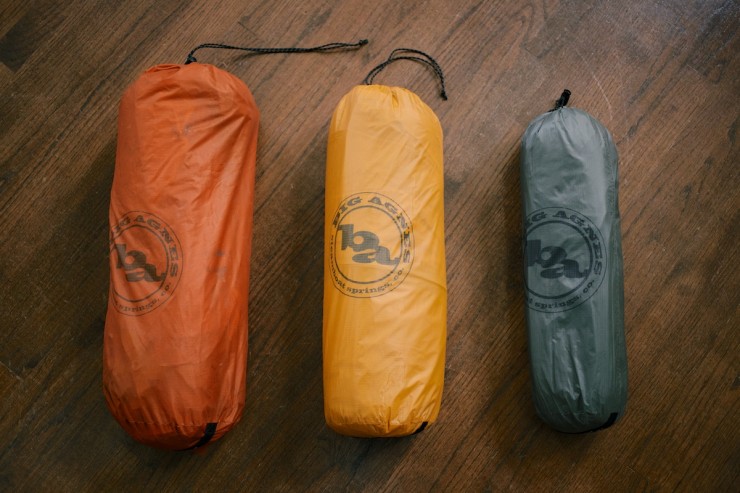
Tents for Bike Touring, Bikepacking and In Between
For two people traveling over several months, a solid and spacious tent is a must. There are couples that tour and get by with two-man tents, but in my opinion, a two-person tent is really a one-person tent. This is especially obvious when attempting to stow gear inside. Not to mention if it is 90 plus degrees outside, close quarters are none to pleasant. Here are my comparisons and contrasts regarding three tents, as well as the reasoning for choosing the one that’s going with us:
Big Agnes Copper Spur UL3 – Perfect Tent for a Big, Loaded Bike Tour
2,128 grams or 4.69 lbs / 7″ x 22″ packed / 44 sq ft interior / 9 sq ft vestibule
The Copper Spur is a fairly popular option amongst bike tourists, because of its large floor plan within a fairly lightweight package. It is, in fact, the most spacious three-person option within Big Agnes’ ultralight and superlight lines. The most pleasant feature, that makes it perfect for a couple, is the fact that each person can lay claim to their own door and vestibule. When folks are traveling together for an extended period of time, it’s nice to retain some personal space.
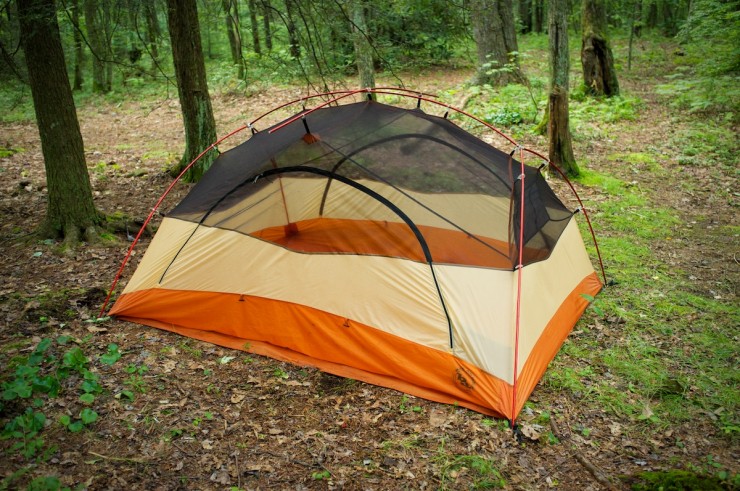
Although the Copper Spur is made from thin and ultralight materials, it proved to be very tough on our tour of Mexico and Central America. However, we decided not to bring it on our upcoming trip for the sake of packing space. I plan to carry a tent, or at least part of it, within the long flap of a saddle bag, and the Copper Spur UL3 is just too bulky.

Another small con worth mentioning about this tent is that it’s fairly difficult to maneuver in and out of it’s shallow doors and encumbering vestibules. But, that’s camping, and that’s just one of those sacrifices you make for the weight savings. It’s perfect for a fully loaded tour and served us well in Mexico and Central America.

Big Agnes Fly Creek UL3 – Solid Tent for Lightweight Adventure Cycling
1662 grams or 3.66 lbs / 6″ x 19″ packed / 39 sq ft interior / 12.5 sq ft vestibule
I was torn between the Fly Creek UL3 and the Slater UL2+, but after erecting them both and wallowing around in their not-so-vast chambers, this is the one. The UL3 has a nice long and spacious layout, but it’s shining star are the steep sidewalls and front door. The Fly Creek also has a larger vestibule that the two on the Copper Spur combined.

One thing that immediately impressed me was the inner clip system that attaches to the rain fly, then allows it to be pulled and staked to create a perfect space between the fly and the tent body. One issue I found with the Copper Spur was that it was rather difficult to get it set up perfectly taught; on several rainy occasions the fly brushed the tent mesh causing water to wick inside. I don’t think that will be a problem with the Fly Creek.

Another plus to note is that the rain fly is a neutral color that will blend in with the surroundings when wild camping. There are a view pieces of orange trim, but it’s not nearly as loud as the Slater.

Big Agnes Slater UL2+ – Great Minimalist Shelter for Bikepacking
1361 grams or 3 bs / 5″ x 18″ packed / 37 sq ft interior / 8 sq ft vestibule
For short trips, a tarp or fast-fly setup could work, but if bugs run amok or there is threat of significant rainfall, a tent it is. The Slater UL 2+ is almost as minimal a two-part tent as you can get and is perfect for short bikepacking trips. As much as I love the idea of this minimal shelter, I just couldn’t talk myself into using it for our Africa trip. The low sidewalls leave you feeling pretty constricted. Again, fine for a few nights, but for several months it could get old. Also the fact that it requires stakes to setup would make it difficult in the off chance we had to set it up inside, or on a concrete pad (both of those situations presented themselves in Central America). Another con for wild camping is the fact that the rain fly is orange which could attract attention.
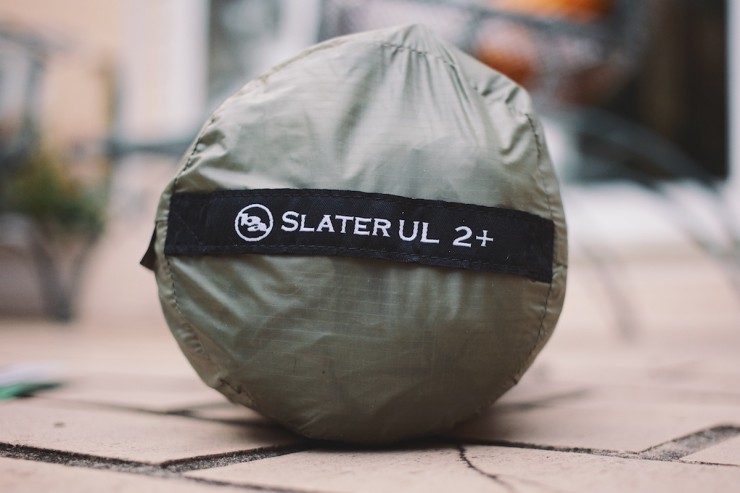
I will be taking it out this weekend and will learn how it works on a full-suspension bikepacking setup. I’ll also have the pleasure of seeing how it fares in sub-freezing temps. One plus for the Slater line is instead of having a large percentage of mesh on the main tent body, they use a very thin ripstop nylon, which adds a little more warmth, and makes it almost a 3+ season tent. At 5×18″, the Slater packs up tiny considering it has 37 square feet of interior space.
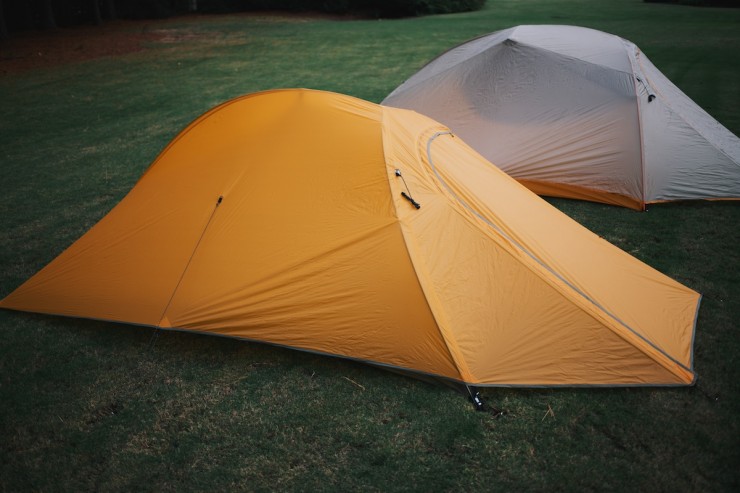
Another plus for the the Slater is that with ripstop nylon replacing mesh, although not thoroughly tested, it seems like it could be tougher in the long run.
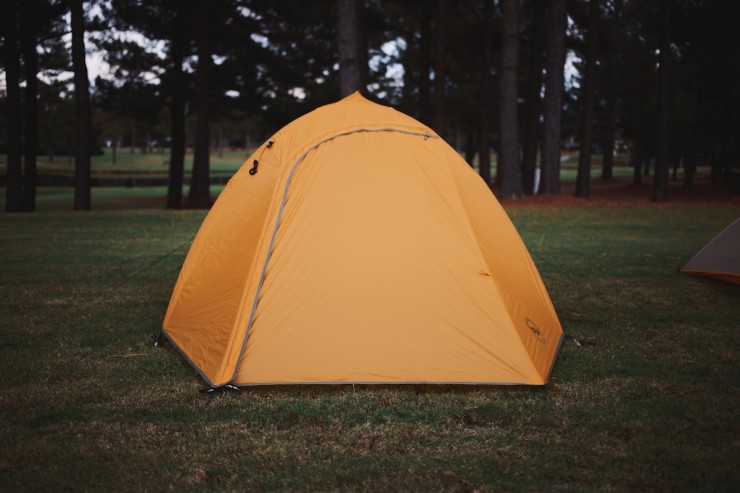
Two Ultralight Down Sleeping bags for Bikepacking or Bike Touring
These two down sleeping bags from Big Agnes pack fairly small and weigh in super light. I’ve spent a fair share of nights in each of these bags and have been impressed. For our trip to Africa in December, I’ll be packing the Pitchpine and Gin, who’s a little more cold-natured, will be using the Lost Lake.
Big Agnes Pitchpine UL 45
45 degree rating / 567 grams or 20 oz / 6″ x 15″ / 78″ model
I bought the Pitchpine for our Central America Tour and have used it in both ridiculously hot temps and below freezing. At 20oz/567 grams, this bag is a featherweight, and there are a few reasons why. One is the fact that there is no bottom-side insulation. You must depend on the R-factor of your sleeping pad. But that is not a bad thing. It actually made room for Big Agnes to add a generous 72.5″ girth to the shoulder area so you don’t feel like a mummy while you sleep. The sleeve on the bottom is designed to fit a 20″ wide sleeping pad so it doesn’t slide out from under the bag during the night. The other thing missing from the Pitchpine is a hood, typical of mummy style bags. It’s a warmer weather bag, so there is just no reason to have a hood.
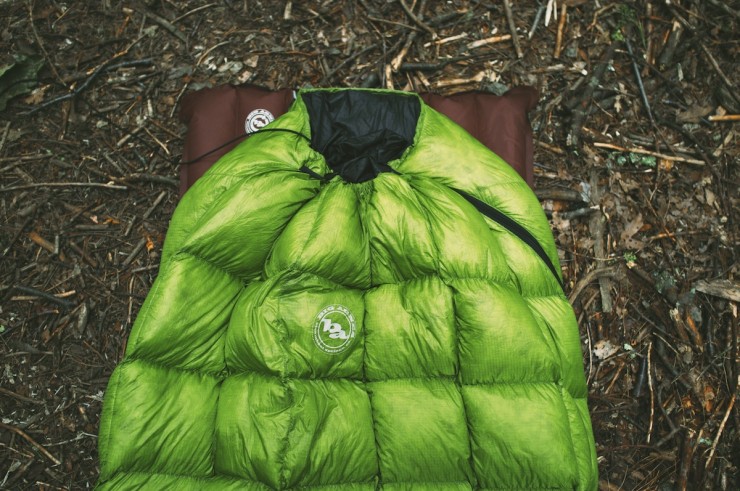
This bag comes in a 6×15″ stuff sack, but can easily be compressed into a 5L dry bag at about 5×12″, which is the perfect size for a fork-mount Anything cage.
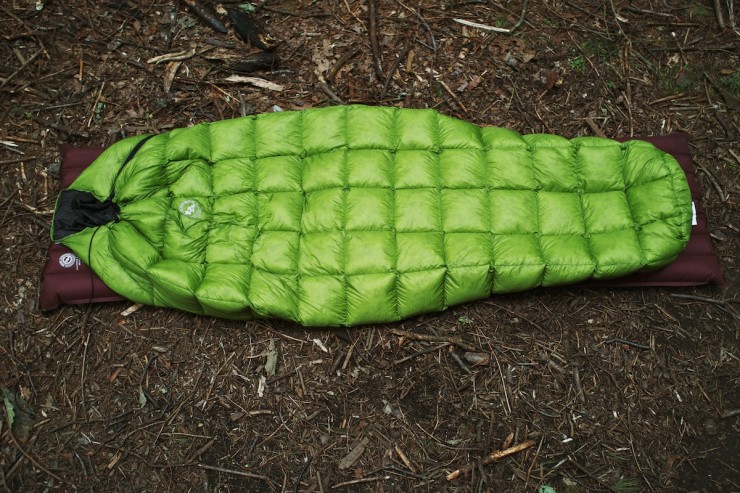
In temps ranging from 40-80 degrees, this bag is perfect. There were a few nights where it got rather sticky in the heat, as does any sleeping bag. And there have been a couple nights where it got below freezing and I was slightly chilled even wearing a wool under layer. Not an ideal bag for winter bikepacking, but perfect for a tour during the other three seasons in moderate climates.
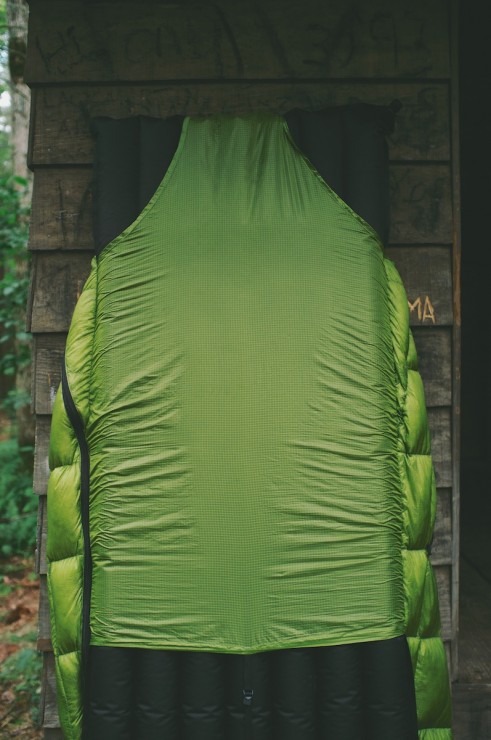
Big Agnes Lost Lake SL 30
30 degree rating / 850 grams or 30 oz / 6″ x 15″ / 72″ model
There are lighter bags in this category and price range. Barely. The 6′ model weighs about 30oz/850g. But, some old-school tricks and new school tech make up for the few extra grams. The Lost Lake SL has a full-length big #8 zipper, which you don’t see very often, but is nice when it’s warmer than anticipated. The Big Agnes proprietary DownTek™ purportedly keeps the moisture out of the stuffing during damp nights. I haven’t tested it in a wet environment, but if it acts as claimed, it’s a great feature. A wet bag is a heavy bag.
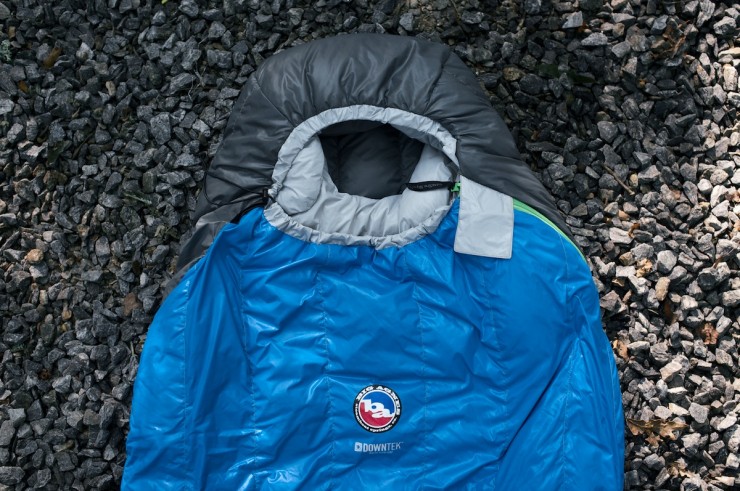
The sleeping bag is very well baffled and seems to maintain heat from head to toe. My wife, who is pretty cold natured when sleeping, kept very toasty and comfortable during a recent night in Vermont where it got close to freezing.
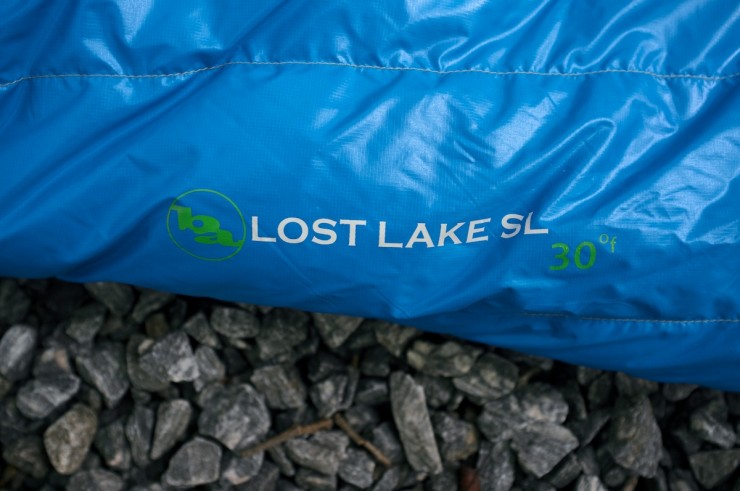
The bag comes in a stuff sack that’s 8×17.5″ and doesn’t quite compress into a 5L Sea To Summit River Bag, but still gets small enough to work on a fork-mount cage.
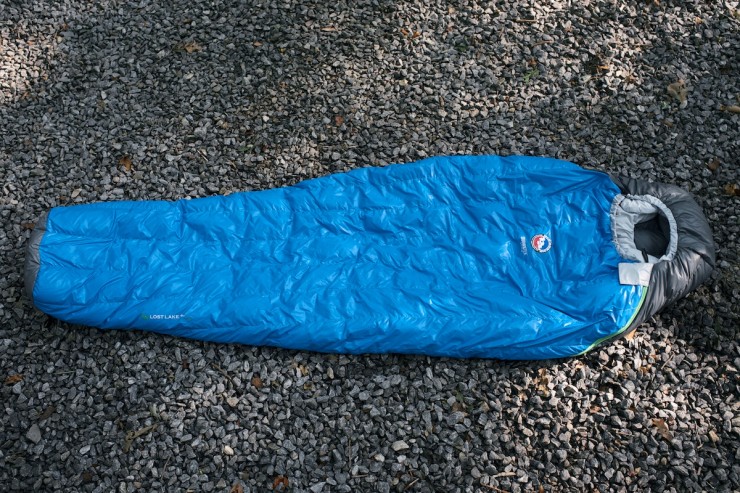
FILED IN (CATEGORIES & TAGS)
Bikepacking gear.
Please keep the conversation civil, constructive, and inclusive, or your comment will be removed.
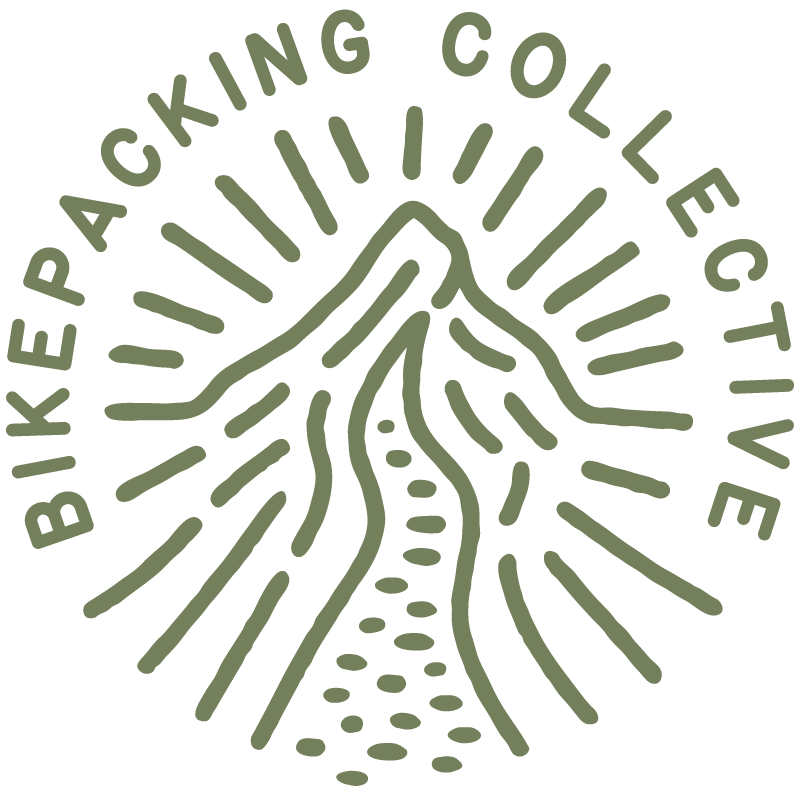
We're independent and member-supported. Join the Bikepacking Collective to make our work possible:
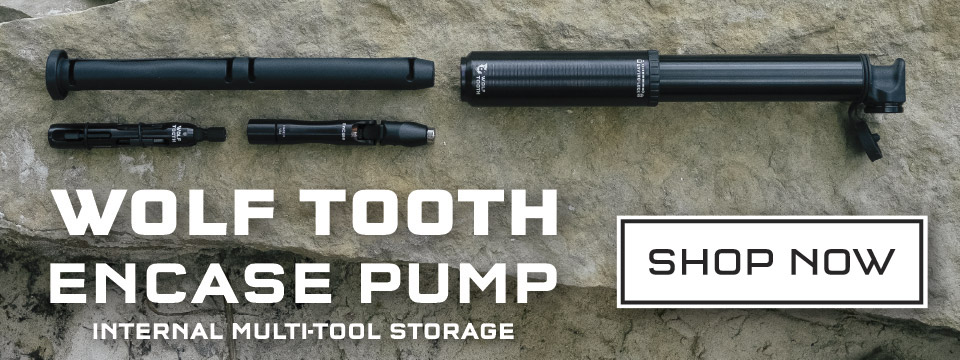
Rad Companies that Support Bikepacking

You need to be logged in to use these features. Click here to login , or start an account if you’re not yet a member of the Bikepacking Collective…
Ultralight Bikepacking Tents – MSR FreeLight, Marmot Superalloy
How light is right for a bikepacking tent.
My first bikepacking tent was an REI Half Dome —a roomy two-person tent with two doors and a bomber build that handles rainy nights and gusty thunderstorms with ease. But at 4.75 pounds, it’s not exactly an ultralight tent. Nonetheless, I packed it for several multi-day bikepacking trips, including the Oregon Outback , and always appreciated its interior space, weather protection and easy setup.

REI Half Dome 2-Person Tent
However, since those early bike adventures, I’ve worked to lighten my bikepacking setup. As much as the REI Half Dome tent served me well, it’s a big tent to carry on a bike. I’ve been able to trim pounds of weight and significantly reduce the overall volume of my bikepacking kit by upgrading to an ultralight bikepacking tent.
Lightweight Versus Ultralight Tents
Choosing a bikepacking tent is just like choosing a lightweight backpacking tent. Once you’ve decided whether you need a one-person or two-person tent, key factors to consider are packability, durability and how well it withstands the elements. Your available storage space, riding ambitions, weather and bug protection needs, plus the amount of money you are willing to part with, will all guide your choices.
When weather, bugs and critters are of limited concern, the lightest weight shelter option will always be a minimalist tarp or floorless single pole style shelter . Tarp shelters are the go-to option for gram counters and ultra-endurance racers. But simple tarp shelters are not always practical. More often than not, concerns like mosquitos, midges, and foul weather are a reality, and a fully enclosed tent is your best option.
Generally, bikepacking tents fall into two broad categories: Lightweight and Ultralight. Looking at two-person tents, lightweight refers to tents like the REI Half Dome that weigh four to five pounds. The weight and volume are manageable when split between two people, and these tents work best for bikepacking when using small rear panniers and or a rear rack for storage.
The two-person ultralight tent category includes tents that generally tip the scales in the two to three-pound range. These tents pack small and are decidedly minimalist in feel and design. If you’re traveling in true go-light bikepacker fashion with only a frame, handlebar and seat pack on your bike, an ultralight tent is the way to go.
Short of moving to a tarp shelter , there aren’t many full tents that weigh under two pounds. They exist — but as with most ultralight gear choices, there is a trade-off in durability and features. And when it comes to tents, durability is directly related to the ability to withstand foul weather.
The Best Ultralight Bikepacking Tents
After using a variety of tents over the last few years, two ultralight bikepacking tents stand out: the MSR FreeLight and the Marmot Superalloy . Both are available as two-person tents and weigh under the three-pound mark. The Marmot Superalloy weighs 2 lb 10 oz / 1080 grams, and the MSR FreeLight weighs 2 lbs 3 oz / 1000 grams (weights include stuff sacks, poles, stakes, cordage and patch kit).
It’s possible to find a two-person tent that shaves a few more ounces off your load, but the MSR and Marmot tents offer a reasonable balance between weight, durability and cost.

The MSR FreeLight 2-Person Ultralight Tent for Bikepacking
The MSR FreeLight 2-Person tent is impressive. It’s Marmot’s lightest 2-person tent and is full-featured with two doors, decent headroom and well-placed interior mesh pockets to keep you organized for the night.
Like most ultralight tents, it’s semi-freestanding, which means the poles give it structure and shape, but it requires staking out to maximize the floor space and create a usable setup.
The pole structure uses a simple Y-shaped central pole plus a small cross-bar pole. The body is mainly mesh with a typical bathtub-style floor. It’s easy to set up and reasonably robust, given the somewhat delicate feel of the mesh and nylon materials. Weighing just over two pounds (2lb 3oz as weighed in the bag), the FreeLight is one of the lightest two-door tents on the market.

MSR FreeLight without the rain fly
Where does MSR save weight?
The first thing you’ll notice when setting up the FreeLight is it just feels light and, dare I say, delicate. Like most lightweight tents, weight savings come from many things: pole configuration, body and fly materials, ultralight cordage and mini stakes. The FreeLight saves a few ounces, in part due to its rainfly design. The rainfly is cropped on one end, saving on material use and shaving a few ounces. As a result, the head end of the tent runs a full nylon panel higher than the mesh on the rest of the tent.
In use, the tent works great. The setup is simple. The zippers feel great. The zipper length limits door access, but there is still plenty of room to enter and exit. There’s plenty of venting, thanks to the mostly micro-mesh walls.
Despite its lightweight feel, the FreeLight has weathered multiple bikepacking trips with no obvious issues and has handled modest wind with ease. I have yet to weather a blustery rain storm to thoroughly test its weather protection. However, it did pass the yard sprinkler test without issue. Nonetheless, this is what I would call a two-season tent.
How’s the Interior Space?
While not exactly roomy, the MSR FreeLight is on par with any other ultralight two-person tent for space. Its overall footprint is a true rectangle and measures 84 inches x 50 inches, offering 29 square feet of space. The headroom height is 39 inches. It’s a shoulder-to-shoulder situation inside the tent for two average-sized adults, but it’s still very livable.
The double vestibule adds about another 15 square feet in total. The double door design and, thus, individual vestibule space for each person is key to having extra personal space. There’s just enough room for keeping your shoes, helmet and a small bag under each vestibule.
The poles are compact, though not necessarily designed with bikepacking in mind. Folded pole length is 19 inches, which gives you options for where to stow them.
The tent is factory seam-sealed and includes stakes and guy lines for a proper setup. There is an optional 40-denier nylon groundsheet. If you’re into saving grams (and cash), we recommend sourcing a scrap piece of Tyvek house wrap and cutting it to match the tent footprint as your groundsheet.
Light and Fully Featured
The Marmot FreeLight checks all the ultralight tent boxes. It’s light. It’s easy to set up. It packs down small. And it’s fully featured for an ultralight design with two doors and nice internal pockets. It’s a solid choice for bikepacking (or backpacking).
Check price and availability of the MSR FreeLight direct from MSR – $450
Support offpistemag.com by following any of the product links in this review. W hile the website is partially funded through affiliate sales, we only review and promote products we test and believe merit being highlighted.
The Marmot Superalloy 2-Person Ultralight Tent for Bikepacking

Marmot Superalloy ultralight bikepacking tent
The Superalloy is Marmot’s lightest two-person tent. Like the MSR FreeLight, it’s a semi-freestanding design, which means that while the poles do give it structure and shape, it requires staking out to maximize the floor space and create a stable setup.
The setup is pretty simple. It features a long, Y-shaped pole similar to the MSR FreeLight, plus a separate overhead cross pole. The body is made almost entirely of mesh with a typical bathtub-style floor. Color-coded tabs make connecting the fly easy, and integrated line tensioners help make it taught.
Inside the Ultralight Superalloy
The Superalloy is a two-door tent, which means there’s vestibule space on both sides to stow a bike bag or two and your shoes. The footprint has a slightly trapezoidal shape and measures 87 inches x 42 – 50 inches. The total interior space is 28 square feet, which is adequate, though not exactly spacious for two average-size adults.
Inside, the near-vertical walls help create space, but headroom is limited to 39 inches. A few mesh pockets help with internal organization, though the side pockets are at an odd angle that kind of encourages stuff to slide out. An overhead pocket works well for small stuff like a headlamp, watch or deck of cards.
Like the MSR FreeLight, the poles are relatively compact, though not designed specifically for bikepacking. At 18.5 inches folded, they can be stowed in multiple locations on most bikepacking setups.
Lightweight Materials
While the mesh body and fly material feel light and delicate, the tent has withstood repeated weeklong trips with no rips, punctures or split seams of any sort. It has been used exclusively with a ground cloth, and while I haven’t abused the tent, I haven’t babied it either. It has weathered damp nights with good results for such a lightweight build.
Bikepacking Minimalism
The Marmot Superalloy’s minimalist design maintains all the functionality you need for lightweight bikepacking adventures. It comes seam-sealed and ready to use with all the stakes and guy lines you need for a proper setup. The footprint is available separately.
Check prices and availability of the Marmot Superalloy ultralight bikepacking tent – $430
Planning a bikepacking trip? Check out all of our bikepacking gear reviews : Salsa Everything Cage Review Salsa Handlebar Bag Review Ortlieb Handlebar Bag Review Platypus Waterfilter Review Portable Solar Panel Review Showers Pass Apex MTB Pants Review Tubeless Tire Setup Tips
Support offpistemag.com by using the product links in this review. T he website is partially funded through affiliate sales, and we only review and promote products we test and believe merit being highlighted.

Related Posts

adventure ride essentials , bikepacking , Tents

11 Best One-Man Tents for Bikepacking & Cycle Touring: 1-person lightweight shelters
Last Updated on 30 September 2023 by Cycloscope

11 Ultra-Lightweight one-person tents for solo bikepacking & bicycle touring The best one-man camping tents for your hikes and bike adventures
Welcome to the freshly updated guide for the best bikepacking tent for solo cycle touring. All 1-person tents have been updated in August 2023 to give you the best option for 1-man ultralight tents available in the market – from cheap & affordable, to budget-friendly, to the very top in the market.
Choosing the best bikepacking tent for your needs is not an easy task. The outdoor and camping world is becoming bigger every day – along with well-established brands producing backpacking, cycle touring, bikepacking , and ultralight tents in general – new brands pop up every year, sometimes with great products, sometimes with reliable, cheap bike tents that will do their duty without breaking your bank account.
In this blog post, we’ll compare 11 ultralight tents and shelters from the cheapest to the top-notch . We’ll list only 1-person bikepacking tents here, if you want more space take a look at the best bikepacking 2-person tents .
The tents mentioned in this list are all well-suited for bicycle touring, long hikes, and adventurous bikepacking trips.
So, let’s first dive into the comparison of the best cycle touring tents, updated for 2023.
After the products, you’ll find our buying guide, have a look at what factors you should consider when buying a one-man ultralight tent.
Disclosure: Some of our articles contain affiliate links. This comes at no additional cost for you and helps us keep this website up and running. (as Amazon Associates we earn commission from qualifying purchases)
How we compile our gear guides: during the almost 10 years of cycloscope.net our team personally tested dozens of similar pieces of gear. For what we can't test personally, we involve other people in the cycling community to give their feedback and opinion about gear they have used. Our decade-long experience in bicycle touring enables us to find the key cons and pros of every product we mention.

11 Best Bikepacking Tents in a Nutshell
6 best freestanding and semi-freestanding 1-person tents for bike touring, new entry 2023, msr hubba nx 1 | +/- $470.
- Big Agnes Fly Creek HV UL 1 | +/- $370
EDITOR’S PICK!
Lightest 1-man bike touring tent on a budget, msr freelite 1 | +/- $350, 2 great non-freestanding ultralight bikepacking tents, terra nova laser competition 1 | +/- $550, ferrino sintesi 1 | +/- $250, 3 best 4-season 1-man tents for bikepacking, msr access 1 | +/- $680, hilleberg akto 1 | +/- $650, the lightest cycle touring tents compared.
Here’s our list of the best bikepacking tents updated for 2023, if you think some great ones are missing please feel free to contribute in the comment section.
REI Co-op Trailmade 1 | +/- $160

REI Co-op Trailmade is the heir of the mythical Quarter Dome, REI’s legendary 1-man tent best sellers.
The Trailmade is indeed very similar to its predecessor but with an improved aero profile that allows it to stand firmer against strong wind, although sacrificing some innner space.
Many bike travelers are fond of REI tents, they have been tested in rough conditions and have surely proven their good quality and great value for money.
This 1-man version is definitely not the lightest one-person tent nor the best available but it’s a fairly good compromise between price and quality. It’s fully freestanding, meaning you don’t need any stakes to pitch it so it can be used on every kind of surface.
PROS : Fully freestanding, large vestibule, roomy CONS : Not great against strong winds. Cheap zippers
- Freestanding
- Size: 88 x 36 x 41″ | 223.5 x 88 x 105 cm
- Packed: 6 x 18.5″ | 15 x 47 cm
- Weight: 3 lbs. 8 oz./ 1.5kg

The MSR Hubba Hubba 1-person is another extremely popular option among solo cycle tourer – it tent presents itself as a solid option for bikepacking, but it’s not without its drawbacks.
Crafted by a brand known for its outdoor expertise, the Hubba Hubba is a testament to quality.
Its durable construction and reliable weatherproofing ensure you stay protected from the elements, even in challenging conditions, and its simple setup is appreciated after a long day on the saddle.
While its reputation precedes it, boasting quality and durability and a trail weight below 1kg, the high price tag might give some pause. It’s an investment that demands careful consideration, especially considering that the footprint is sold separately.
Another thing to consider is that some users have reported issues with condensation buildup due to the tent’s ventilation design, leading to dampness during the night. This might be a dealbreaker for those seeking a consistently dry and comfortable sleep even in hot and wet climates.
PROS: Fully freestanding, large vestibule CONS: no footprint, pricey, condensation issues
- Inner dimensions: 85x30x36″ | 216 x 76 x 91.5 cm
- Packed: 6 x 18″ 15 x 46 cm
- Weight: 2 lbs 2 oz / 10.9 kg
Big Agnes Fly Creek HV UL 1 Tent | +/- $370

This ultralightweight backpacking 1 person tent by Big Agnes is a great one. Half-freestanding (needs stakes to tension the corners), big entrance, pretty wide at its widest point, and well under 1kg.
The mesh is very aerated ensuring optimal ventilation even with only one entrance. The vestibule is smaller than the competitors but the more aero-friendly design makes it behave better in windy weather.
Like most ultralight tents, the Fly Creek HV’s floor is prone to tearing so the footprint is absolutely a must, for this price it should come with the tent but it doesn’t, you’ll need to add 60/70 bucks more and that’s a shame.
PROS: ultralight, good living space, half-freestanding CONS: weak floor, footprint not included
- Semi freestanding
- Dimensions: 86 x 38/28 x 40″ | 218 x 96.5/71 x 101.6 cm
- Packed: 5 x 18.5″ | 12.7 x 47.5 cm
- Trail weight: 1lb 11oz / 765g | w. footprint (not included) 2 lbs / 900g
NEMO Hornet Elite 1P | +/- $550

My absolute favorite, the Nemo Hornet Elite is the best lightweight 1 person tent in the market, in my humble opinion of course.
It weighs nothing, is almost freestanding, has a wide living space, a big enough vestibule, packs small, it’s quite affordable… what else might you ask from a 1-man tent?
The NEMO Hornet Elite 1 is ultralight for a double-wall shelter, weighing just 1 lb 7 oz, perfect for solo backpacking or bikepacking. It offers better wind and weather protection than a bivy sack while maintaining a compact size.
The tent features a single hubbed Y-pole, providing stability to the inner tent when staked out.
There’s ample room for a 72″ x 25″ sleeping pad, with cross ventilation facilitated by the rain fly and partially unzipped door. The tent has gear loops, mesh pockets, and ambient lighting options for convenience.
The 10 denier Sil/PeU Nylon Ripstop inner tent floor is durable, though a footprint is recommended but not included.
The marigold-colored 7 denier PeU Nylon Ripstop rain fly offers privacy and maximizes tent stake utility. The front vestibule accommodates a few bags, while toggles enable sides to roll back in favorable weather. Additional guylines and guy-out points enhance wind stability.
While the tent excels in many aspects, its lateral rain coverage near the zipper could be improved.
Overall, the NEMO Hornet Elite 1 Tent is a lightweight and versatile option for solo adventurers seeking a balance between minimalism and weather protection. Not recommended for cold winters.
PROS: everything mentioned above CONS: A bit costly
- Dimensions: 87 x 40 x 38″ / 220 x 102 x 96.5 cm
- Packed: 19 x 4″ / 49 x 10 cm
- 1 lb. 14 oz. / 850 g
Naturehike VIK | +/- $130
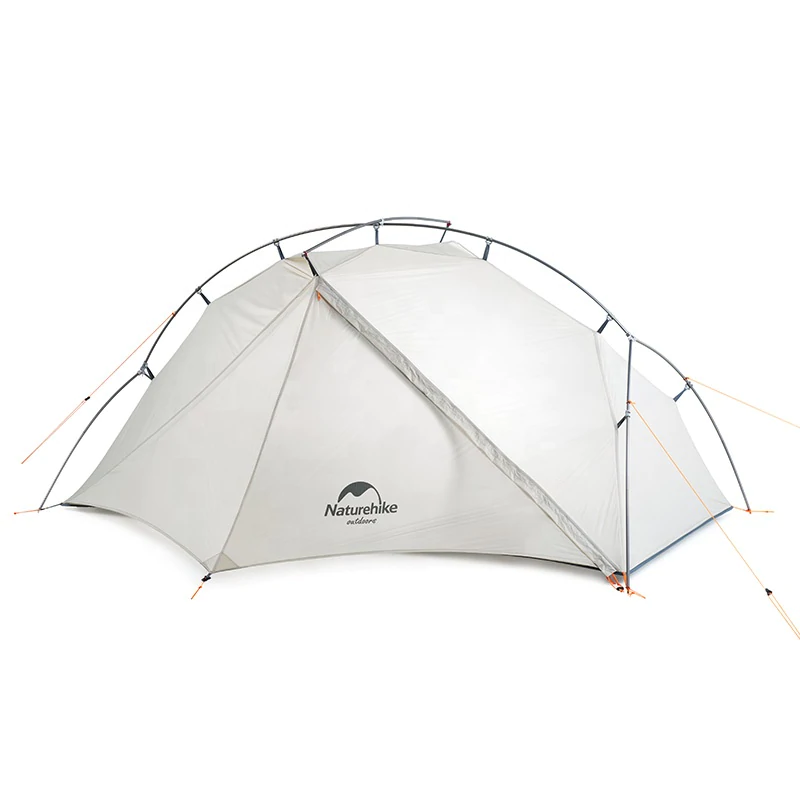
For those who want to stay really minimal, here’s the lightest tent on this list. Naturehike does its magic again, coming out with an ultralight 2-person tent under 3lbs (1.35kg) that paks as small as 18*6 inches (46*16cm).
The secret? This is a one-layer tent, so no separated flysheet and inner mesh. I can hear some of you shouting “condensation!” but hear me out.
A little condensation does occur, but the vents and the possibility of slightly opening the access door while leaving the door mash close will solve the problem in any condition that is not too cold.
This is a summer/spring tent, that can be used for temperatures as low as 45F or 6/7C. Besides that, it’s a quite sturdy camping tent for its weight, bikepackers and minimal trekkers would love it, and the price is super-appealing. I purchased a one-person version as a second, spare tent to use when I really want to pack next to nothing.
Despite being a single-walled tent, the Naturehike Vik handles heavy rains properly, thanks to the 15D nylon-coated silicone/PU 2000mm fly and 20D/PU 4000mm floor, a footprint is also included in the purchase.
Like Naturehike tents? Check: > Naturehike Tents REVIEW! 11 Tents Compared for 2022

The lightest semi-freestanding, full-featured backpacking tent for 1 person in the MSR lineup, the 3-season FreeLite 1 tent offers generous room to fit a wide sleeping pad and all your gear on solo cycle touring trips.
With only 1.1 kg the Freelight is one of the lightest freestanding tents in the market, although it still needs two pegs to tension the corners.
MSR has received some bad press lately, with some complaining of a drop in manufacturing and materials quality. We still consider this tent to be one of the best deals out there for solo backpackers or cycle tourists though.
PROS: Lightweight and roomy, Semi-freestanding CONS: Flysheet gets caught in the zipper
- Semi Freestanding
- Dimensions: 86 x 30 x 38″ / 218 x 76 x 91.5 cm
- Packed: 18 x 6″ / 15 x 47 cm
- 2 lbs. 7 oz. / 1100 g

The Laser Competition 1 has become the classic one-person bikepacking tent and has received multiple industry’s ‘Best In Test’ awards.
The tent is designed for bike travelers and backpackers looking for a tried and tested weight-saving kit with a good balance of low weight and durability. Its low profile shape and design make it ideal for wild camping.
PROS: great waterproofness and high-quality construction CONS: Small and expensive
- Non-freestanding
- Dimensions: 220 x 62 x 100 cm | 86.6 x 24.4 x 39.4″
- Packed: 16.5 x 4.7″ | 42 x 12 cm
- Weight: 2 lbs. 1oz. | 930 g

Ferrino is an Italian outdoor brand that has been leading the local market for more than one century, providing gear for some epic expeditions.
Unfortunately, their manufacturing quality has dropped recently, but the price still makes it worth considering.
Sintesi 1 is their ultra-light, basic 1-person tent with a minimum trail weight of 830 grams, a good mid-range shelter for hiking and bike touring.
PROS: Lighter & larger than other shelters CONS: Not freestanding, small condensation issues
- Dimensions: 93 x 39 x 31.5″ / 235 x 100 x 80 cm
- Packed: 12 x 5.5″ / 30 x 14 cm
- Weight: 2.2 lbs. 997 g
NEMO Tracker OSMO | +/- $430 – new entry 2023!
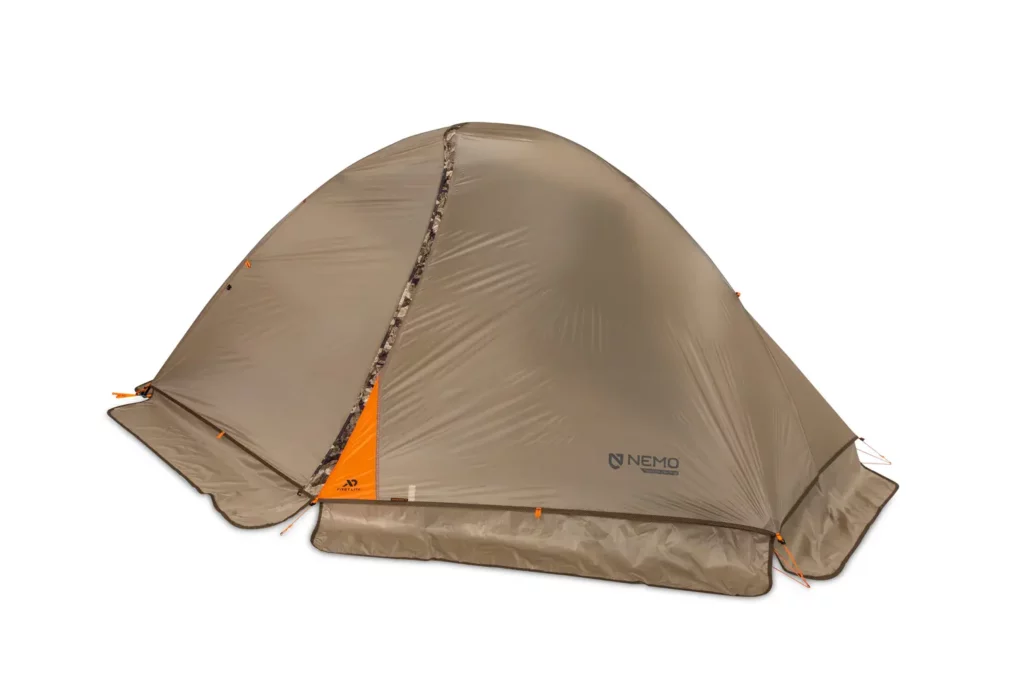
The Tracker OSMO™ tent offers a versatile shelter solution that could potentially be used in snowy conditions.
Although not a 4-season tent, the Tracker comes with a snow skirt that keeps the warmth inside and the snow outside, while Its unique blend of nylon and polyester yarns in the OSMO fabric provides superior water resistance and waterproofness, all without harmful PFAS chemicals. This fabric also exhibits minimal stretching when wet and boasts exceptional strength compared to similar materials on the market.
Maintaining an asymmetrical design, the Tracker tent maximizes headroom and gear storage without compromising weight. The Flybar™ pole clip enhances interior volume, while the Landing Zone™ waterproof gear tub in the vestibule adds practical storage options. The tent’s durability is evident through features like a silicone-coated floor, full-coverage rainfly with snow skirt, and the use of Easton Syclone® poles for swift setup.
Its thoughtful design includes internal storage pockets and a gear loft, catering to organization needs. The full-coverage rainfly with a waterproof rating of 1200mm ensures protection against heavy rainfall.
While the tent’s single vestibule offers valuable storage space, a footprint is not included, highlighting the importance of additional floor protection, especially in rugged terrains. The tent is available in various sizes to suit different preferences.
PROS: versatile for most climates CONS: footprint not included, not fully freestanding
- Semi-freestanding
- Dimensions: 90 x 43/31 in x 39 / 228.6 x 108/79 cm x 100
- Packed: 19.5 x 4.5/ 50 x 12 cm
- Weight: lb 2 oz / 970 g

Another MSR masterpiece, not exactly a lightweight tent but it is something that can seriously withstand heavy snow and low winter temperatures.
This 1 person 4-season backpacking tent is completely freestanding and roomy enough to comfortably sit in and also store some gear. It even features a nice vestibule wide enough to use your bikepacking stove in case of bad weather (always be careful of course).
The inner tent is almost entirely made of canvas, which guarantees high insulation but may result in condensation (very normal) and low ventilation. Although MSR has recently improved on this by making the vents wider, this tent might still turn into an oven in summer.
PROS: Strong construction, 4-seasons, freestanding, roomy CONS: Expensive, relatively heavy
- freestanding
- Dimensions: 84 x 33 x 41″ / 213 x 84 x 104 cm
- Packed: 6 x 18″ / 15 x 46 cm
- Weight: 3 lbs. 8 oz. / 1590 g

Hilleberg’s quality is indisputable, if you are really looking for the best cycling tent that will last you a lifetime you should really consider this brand.
The Enan has a huge vestibule (0.8sqm), a decently sized livable area (60 to 95 cm wide), great ventilation, and top-notch materials.
The Hilleberg Akto is one of the best lightweight 1-person tents suitable for all 4 seasons. The Akto features some of the most innovative venting options available to defeat internal condensation.
The large vestibule, and high-quality construction and design, make this a very comfortable bikepacking or cycle touring shelter to take on long-term trips.
The inner is hung to the fly so that they can both be pitched together, or you can first put the fly up and then hang the inner, so to avoid it getting wet.

Stay Powered On The Go: 9 Best Power Banks For Bikepacking, Backpacking, And Cycle Touring
PROS: Hilleberg quality, the best camping tents in the world. Great ventilation, huge vestibule CONS: Expensive, not freestanding, might be small for big guys.
- Dimensions: 86 x 64 x 36″ | 220 x 165 x 93 cm
- 3 lbs. 12 oz. | 1700 g
How to choose the best bikepacking tent
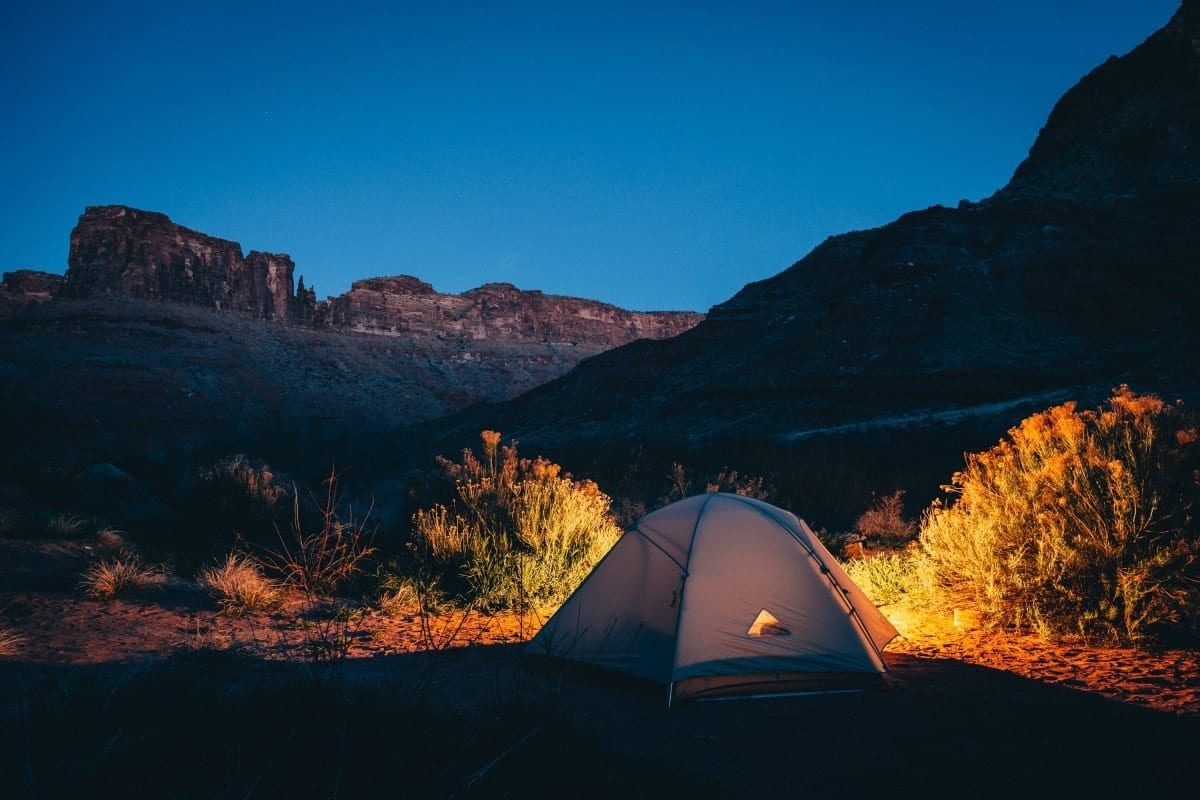
Comfort: 1-Person tent VS 2-person tent
One could assume that a 1-man tent is good for 1 person but that’s not always true. Depending on how much time you’ll spend into your tent, a tight living space may result in a loss of comfort and a drop of your love for camping.
We would advise taking with you the most spacious tent possible, especially for bike touring, when weight is less a concern than when backpacking or bikepacking, and you likely will carry more gear and stay out more days.
25 inches (63cm) per person is what is usually considered enough width for one person, but it’s honestly a bit too narrow in my humble opinion, particularly in hot climates.
My opinion is to consider at least 80cm , the wider the better, especially if you plan to keep some gear inside with you. Since some of the lightweight tents listed here are narrower than that, you could think about getting the 2-person version, which is available for many of these models.
Another important and often overlooked spec is the length of the tent . Although 210cm (85″) may seem enough, keep in mind that this information indicates the length at floor level.
Depending on the design of the tent, if the walls are very slanted this length might be much shorter at your head’s height, resulting in it touching the walls, which is not pleasant. Consider buying a longer tent if you are a tall person.
Have a look at this list of 17 lightweight 2-person tents under 200$
Use: Cycle Touring Tents VS Bikepacking Tents VS Backpacking Tents
Although it may seem a specious distinction, the needs of a bike tourer are a bit different from those of a bikepacker or hiker. First of all, the long-distance bicycle traveler usually has more gear, spares, tools etcetera add up to the bulk. So, an ideal bike touring tent should have large vestibules for gear storage .
Besides that, when bike touring you use your tent more. Your tent will be your home for most of your trip, especially if it is going to last a while, so you’ll want a comfortable and reliable home to live in. Adding a few hundred grams in exchange for a bigger and stronger tent might be a good choice.
When bikepacking or mountain-bike camping for a shorter time span, let’s say less than a week, those considerations above are less important, you’ll have to endure the discomfort only for a few days, so you could go for the lightest bikepacking tent.
Maybe you’d like Bikepacking VS Cycletouring: the ultimate verdict
Backpackers tents , on the other hand, should ideally be ultralight and small when packed. The weight of your tent will be on your shoulders instead of a bike rack, and shouldn’t take too much space in your single piece of luggage, your backpack indeed.
Climate and weather
read our article about > 3-Season Tents VS 4-Season Tents
Terrain: Freestanding Tents VS Not-Freestanding
Tents can be free-standing (no need to pitch it to the ground), half-free-standing (only need a few pegs), or not-free-standing (doesn’t stay up if not pitched).
We sincerely like freestanding tents much more, it’s very common to find perfect sheltered camping spots where is impossible to plant a stake (or peg), it may be concrete, wood, or whatever you can also find kinds of soil where pitching is really complex, like hardened soils or sand.
We suggest taking with you a half-freestanding tent like this (you can use ropes and tight it somewhere), or even better a completely free-standing one. Don’t forget also to bring a few spare pegs (stakes), soon or later you’re going to lose at least one.
Another important factor to take into consideration when choosing a camping tent is the possibility to pitch its inner igloo alone , without necessarily needing to put the fly on it. Pitching just the inner tent is great in hot weather and, if the tent is mostly made of mesh fabric, can allow some great stargazing without being bothered by mosquitos.
The Elements: Waterproofness, Wind Resistance, & Snow Handling
The waterproofness rate of a fabric is measured in millimeters (mmH 2 0), indicating the pressure at which water is able to break through the material.
The standard waterproofing test is done by applying water pressure on top of a fabric sample until three drops of water have passed through.
For example, a 1500 mmH 2 0 rating means the fabric can sustain 1,500 mm of water on top of itself before leaking.
So how many millimeters of waterproofing does a bikepacking tent need to be waterproof?
Well, the secret here is that this measure really states the durability and reliability of your bike tent.
The amount of stress the tent materials undergo during a cycle touring expedition is intense, the fabric, both of your flysheet and especially your footprint, will be subject to abrasion.
A higher mmH20 rating means you’ll be able to stay dry in your tent even after years of use – any cheap pop-up tent is able to keep you dry under one thunderstorm, but you want a durable tent.
Read more in-depth about the topic on Wikipedia .
Wind resistance instead, is given by a few different factors, mostly the strength of the poles, the quality of the stakes, and the aerodynamics of your tent’s design. While a tall tent might seem very comfortable if the walls are too vertical is more than likely that it will be blown off by strong gusts of wind, this is especially true for one-person tents, which are narrower. Be sure to properly pitch your pegs if you expect strong winds. Learn more about wind resistance here .
4-season winter bikepacking tents are designed to withstand heavy snow loads, they usually have even more slanted walls to avoid the snow piling on the top.
FAQs about bike tents
Do you need vents in your camping tent.
Vents are a very important characteristic to consider when buying a tent. Some tents have one or most commonly two vents in the rain-fly, they are meant to improve the ventilation and are fundamental to avoiding condensation.
Do I need a footprint for my bike tent?
The footprint is an additional sheet to put between the tent’s floor and the ground, to provide better insulation and avoid the terrain’s asperities tearing a hole into the floor’s fabric. A footprint will triple the lifespan of your tent, so yes… you really need to carry those few extra grams.
How heavy should a bikepacking tent be?
A good rule of thumb is to aim for a bikepacking tent that weighs around 2 to 4 pounds (0.9 to 1.8 kilograms) or less. This weight range strikes a balance between portability and comfort. However, some ultralight enthusiasts might opt for even lighter options, closer to 1.5 pounds (0.7 kilograms) or less, sacrificing a bit of space and convenience for reduced weight.
It’s important to consider the durability and features of the tent as well, more often than not, ultralight also means ultra-fragile. Look for materials that are lightweight yet durable enough to withstand the rigors of the trail even if that means investing more. The saying goes: lightweight, durable, affordable: you can only pick two of these.
Can you use a backpacking tent for bikepacking?
Yes, you can use a backpacking tent for bikepacking. Many backpacking tents are suitable for bikepacking due to their lightweight and compact designs.
- 11 Best Bikepacking Saddles
- Bikepacking Saddle Bags Compared
- The Best Handlebar Bags Reviewed
- Bike Top Tube Bags for all disciplines
- Framebags for bikepacking, which one to buy?
- The best grips for MTB
- Bikepacking Bags! The Best For Each Category from CHEAP to TOP
More bikepacking stuff > 10 best ultralight budget sleeping bags > Top Sleeping Pads Compared > Camping Gear Essentials List > Bicycle Touring Checklist > Best Solar Panel Chargers > How to find sponsorship for outdoor adventures > Beginner’s guide to bike touring > How much does it cost to cycle around the world
Sharing is caring!

I think your readers would be served better if you broke this list down to several other lists. Example: Best freestanding, best non-freestanding. Best under $300, best over $300. $700-$500 for a 1 person tent!?!? Holy shamoley. Not in this cowpokes budget!
Thanks for the propositive comment. You’re right, indeed we often do this in our buying guides. I promise will try to break down this ASAP.
Leave a Reply Cancel reply
Your email address will not be published. Required fields are marked *
Yes, add me to your mailing list.
This site uses Akismet to reduce spam. Learn how your comment data is processed .

Bikepacking > Bikepacking Gear > Bikepacking Camp Gear
Bikepacking Shelters: Tent, Tarp, Bivy, or Hammock?
Few parts of a bikepacking gear list inspire as much deliberation as the shelter. We ask a lot from our bikepacking shelters: weather protection, ventilation, privacy, and comfort, all while being exceptionally light and packable.
With all the great options out there, how do you know which type of bikepacking shelter will suit you best? The first step is to ask yourself where you ride most often and what the conditions are like, how much you care about weight and packability, and what kind of feeling you’re looking for when you crawl into your shelter at night.
Many bikepackers eventually find ourselves with multiple shelters. You can certainly find a bikepacking shelter that works for most trips you might want to take, but no single shelter is ideal for all trips. I wouldn’t carry my roomy freestanding tent for a fast-and-light bikepacking race , and I’d never dream of taking a multi-month international tour with my ultralight bivvy (ugh!). It’s all about choosing the right shelter for the location, objective, and style.
This post covers the pros and cons of the four most common bikepacking shelter types: tents, tarps, bivvies, and hammocks. Whether you’re just getting started with bicycle camping or you’re an experienced bikepacker looking to try something new on your next trip, I hope it helps you sleep peacefully on the road or trail.
Shop Adventure Kits
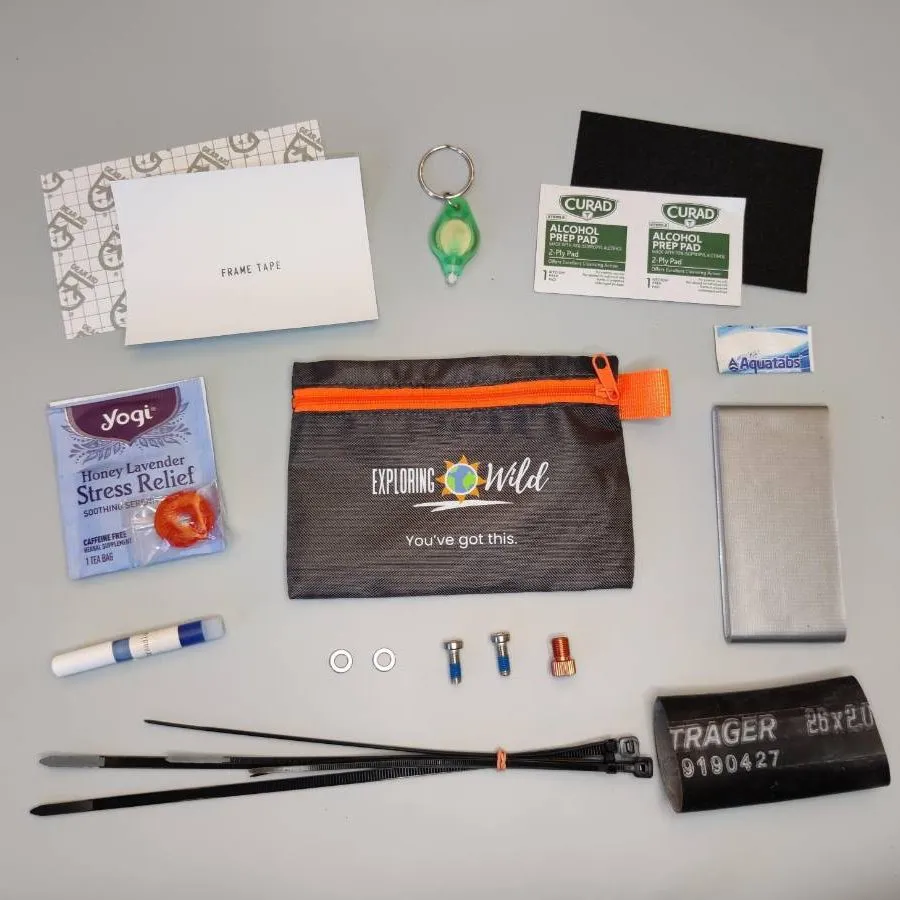
Bikepacker’s Fix It Kit

Tub e less Tire Repair Kit

Small & Light Containers Kit
When you buy through affiliate links in this post, I may earn a small commission. Thanks for your support! I always offer unbiased opinions based on real experience from the road and trail. Learn more .
What to Consider
The best type of bikepacking shelter for you depends on many factors: where you’ll be riding and with whom, your bike travel style , how much weight you’re willing to carry, and what kind of campsite vibes appeal to you most. As you read about the various bikepacking shelter types below, think about your personal answers to these questions:
- What will the weather be like in the places you want to bikepack? Warm and humid, cold and windy, mild and dry?
- What is the terrain like? Do you expect ample flat spots for tents, trees for a hammock, or just a small patch of land for a bivvy?
- How much time will you spend in your shelter? Is it your home away from home for months, or just a place to lay your head for a few nights?
- Will you be camping in public areas or around other people and needing some private space, or will you be out in the wilderness alone? Many bike travelers find it relaxing to be out of sight while sleeping after being so visible on the road all day.
- Do you want to share sleeping space with a significant other, kids, or a pet?
- How much do you prioritize comfort at camp versus a lightweight load on this particular trip?
With that in mind, let’s jump into the four main types of bikepacking shelters, starting with the most popular: tents.
Ideal for : versatility, long trips Less good for: ultralight riding or racing
Tents are the most common and versatile type of bikepacking shelter. A good tent provides protection from weather and bugs, privacy in busy campgrounds, and a fully enclosed place to sleep and hang out. This versatility and convenience makes tents especially popular with long-term bike travelers, families, and many couples. If you can only have one type of bikepacking shelter for any and all trips, especially for bikepacking abroad in a variety of countries, it should probably be a tent.
The most obvious reason to choose a tent for bikepacking is protection from the elements. While it may be possible to stay warm and dry with a tarp or hammock, it usually takes a bit more practice. Some tents can be fiddly to pitch, especially ultralight ones, but tents generally don’t take much skill once you learn the basics. Nothing sets up faster than a simple freestanding tent, which can be a huge relief when trying to make camp in howling wind and pouring rain .

The “livability” of tents is another big benefit for bikepackers, especially on longer trips. In a perfect world where the weather is always nice and your campsite is always an idyllic private spot, your shelter is just for sleeping. But stuff happens on bikepacking trips: unplanned rest days, camping in the busy town park, waiting out a storm… If you have to spend a day hunkered down in your shelter, a tent offers a private, dry, bug-free space with room for your gear and freedom to move around (at least a little bit).
The mental aspects of a fully enclosed shelter are often overlooked, but they can be a big benefit (or for some folks, a drawback) of tents. Those new to sleeping outdoors often prefer the coziness of familiar tent walls over a view of the dark landscape. Anyone who feels vulnerable because of their size or appearance may prefer the anonymity of a tent; I know I do when I bikepack solo . Traveling by bicycle in populated areas can feel really exposed, and it can be a relief to crawl into a completely hidden space at the end of a long day on busy roads.
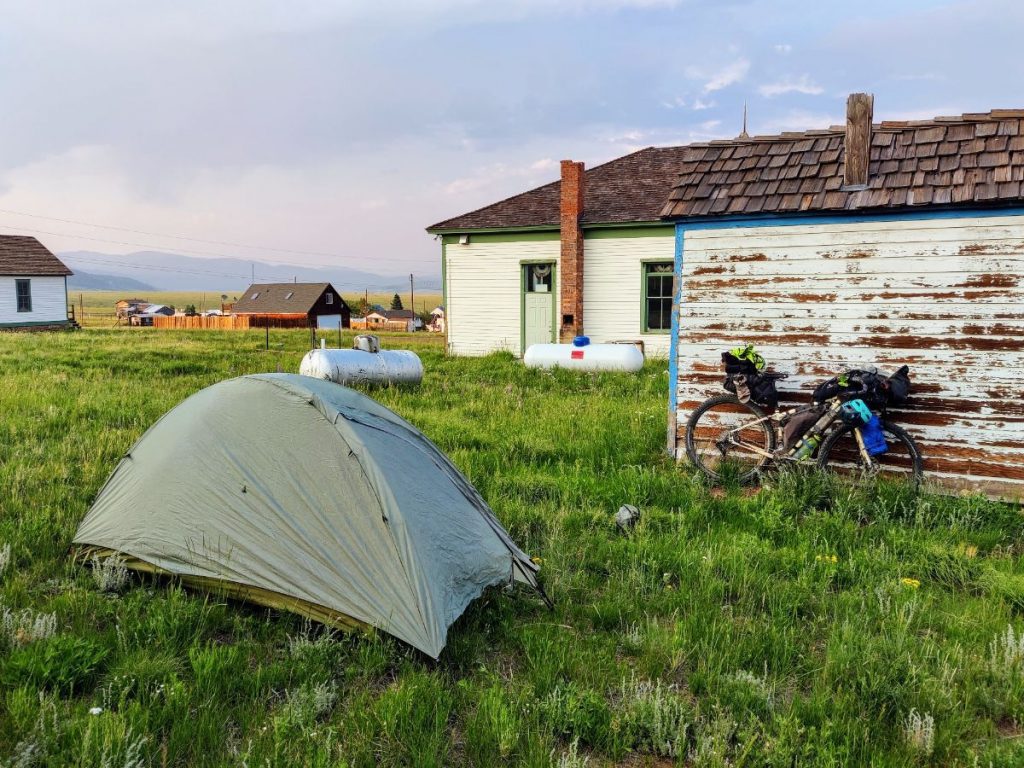
Bikepackers have a wide range of tents to choose from. Depending on your trip location and gear style you might choose anything from a sturdy four-season, double-wall, freestanding tent to an ultralight single-wall pyramid tent. Bikepackers often use backpacking tents, which work well since they’re designed to be lightweight and compact. Recently a few tent manufacturers have started offering bikepacking-specific tents with handy features like shorter folding poles, durable stuff sacks, and stealthy colors.
Related: How to Choose a Bikepacking Tent
Advantages of tents for bikepacking:
- Most versatile type of shelter, adaptable to most climates and terrain
- Popular, many options to choose from
- Most thorough protection from bad weather
- Fully enclosed for bug protection
- Most privacy in busy campgrounds or when stealth camping in populated areas
- Room to bring gear inside to deter theft or protect from rain
- Shared sleeping space with friends, partner, family, or pet
- Feels cozy, enclosed, and familiar
Disadvantages of tents:
- Heavier and bulkier than some other options
- Tent poles can be hard to carry on a bike (though here are several solutions )
- Requires larger flat area to pitch, and soft ground for stakes (except freestanding tents)
- Can be poorly ventilated in hot or humid climates, depending on the model (single wall tents especially)
- Higher-end models are quite expensive
- Feeling of being isolated from the landscape and surroundings
Popular Bikepacking Tents : There are many options to choose from; for more see my detailed post on bikepacking tents . Here are a few selected highlights:
- Big Sky Soul 1P : simple lightweight freestanding solo tent ( full review here )
- Big Agnes Copper Spur HV UL : fully-featured yet lightweight line of highly livable tents ( full review here )
- Zpacks Plex Solo : Ultralight pyramid-style single wall tent
Ideal for : lightweight weather protection Less good for: bug-infested areas, hard ground
A tarp is like the minimalist cousin of the tent. Any non-essential fabric is stripped away, leaving only a waterproof layer positioned above and extending down toward the ground at the sides. In many ways, tarps are the best of both worlds as a bikepacking shelter. They offer a moderate amount of protection, privacy, and sense of coziness in exchange for lighter weight and less bulk.
Most tarps are lighter and smaller than most tents, which is a plus for space-constrained bikepacking bag setups . To create the ridgeline you’ll probably need one or two lightweight poles or guy lines between well-paced trees, though some creative bikepackers incorporate their bike into the pitch for a flexible pole-free setup.

Tarps offer fairly good weather protection if pitched properly, but this takes a bit of skill (considering wind direction and fabric angle, for example) and depends on the tarp’s design. In a truly nasty storm a tarp is generally less warm and dry than a tent. In warm weather the pitch can often be adjusted for excellent ventilation. Tarps work especially well as light rain protection in mild climates, or as an emergency shelter on a short trip with a dry forecast. They can even be combined with a breathable bivvy (see next section) for a very flexible yet lightweight sleep system.
If camping in extremely buggy areas, a tarp’s biggest weakness is its lack of bug netting. You could add a bug bivvy inside, but these can feel constrained and may not offer enough space for eating, changing clothes, etc. If you need respite from swarms of mosquitoes or biting flies, or are squeamish about creepy-crawlies in general, a tent is a better choice.
Another major drawback of tarps compared to freestanding tents is the challenge of pitching on hard surfaces. Stakes and guy lines are absolutely essential. This is why you rarely see long-term bike travelers using tarps; you can’t pitch them on a patio or in a parking lot, or many other hard surfaces where bike travelers find ourselves sleeping. Tarps work best when you expect to be camping out in nature away from towns and people.
Tarps come in a variety of shapes, from simple rectangles to fancier cuts with curved edges to fully shaped designs with zipper doors. As with tents you can opt for ultralight fabric or go a little heavier for more durability and a lower price. A basic rectangular tarp is probably the most cost-effective bikepacking shelter out there, as long as you’ll be camping in suitable places and conditions.
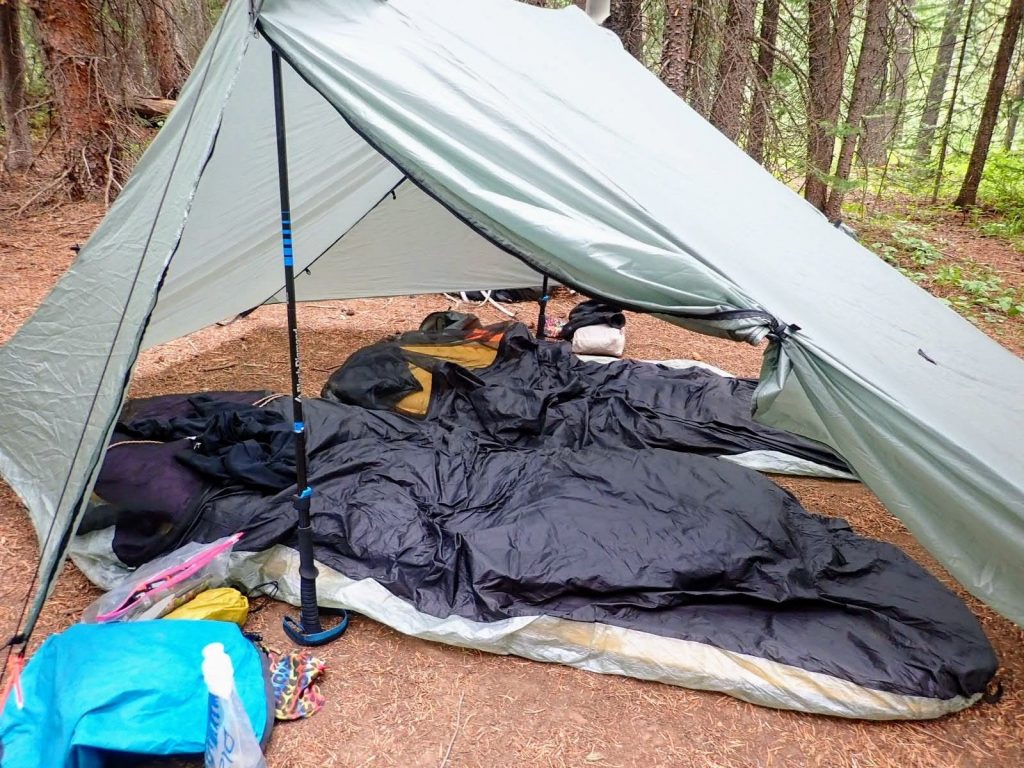
Advantages of tarps for bikepacking:
- Lighter and more compact than a comparable tent
- Flexible, can be pitched to enhance ventilation, weather protection, privacy, or view of surroundings
- Cheaper than a comparable tent
- More living space and privacy than a bivvy or hammock
- Well ventilated in warm or humid weather
- Suitable for pairs or families who want to share sleeping space
- Good balance of coziness and connection to surroundings
Disadvantages of tarps for bikepacking:
- Less weather protection than a tent, especially in high wind
- Fussier to set up than most tents
- Usually requires a pole or two
- Stakes required, along with soft ground to anchor them into
- No mesh to keep bugs out (though you can add a “bug bivvy” inside, and some models offer integrated mesh inners)
- Less privacy than a tent
Popular bikepacking tarps:
- Borah Gear Silpoly Solo Tarp : Simple, light, and affordable rectangular tarp
- MLD Grace Tarp : Ultralight catenary-cut ridgeline tarp for easy pitching
- Six Moon Designs Haven Tarp : A bit heavier but conveniently shaped, weatherproof, and easy to set up

Bivvy Sacks
Ideal for : fast-and-light riding or racing Less good for: long trips, bad weather
Ah, the bivvy sack. No one ever loved spending a stormy night in a bivvy, but we can’t deny its utility as a lightweight bikepacking shelter. A bivvy (or bivy) sack is essentially a waterproof sleeping bag cover, like a solo tent minus the poles, designed to provide the bare minimum weather protection needed for safety. Fancier and comfier bivvies may include a small arched pole to keep the fabric off your face, while others simply cinch or zip around your head.
If your shelter is only for sleeping, the convenience of a bivy is hard to beat. They’re lightweight and compact, super-quick and dead-simple to set up (just throw it down on the ground), easy to hide at stealth campsites, and require only a small patch of flat space. They add some warmth to your sleep setup, keep creepy-crawlies out, and are generally cheaper than a comparable tent. Many people come to appreciate the feeling of sleeping out under the stars and being more in touch with their surroundings, though this can take some getting used to for beginners.

Lack of “livability” is the biggest drawback of a bivvy. Some people find them claustrophobic and restrictive to sleep in (though others don’t mind). You can’t eat, change clothes, or even sit up in a bivy when it’s fully closed. If the weather is nice and your campsite is private you can do all these things out in the open, but when you want some privacy or need to hunker down inside your shelter a bivy’s disadvantages become clear in a hurry. This is not the place to spend a lazy day waiting out a storm; you’ll probably choose to keep moving and ride in the rain .
I find bivvies are best for shorter trips in remote areas where I’ll be wild camping in nature. I don’t like them for busy campgrounds or spots where I could be discovered in the night — they feel too exposed. They don’t offer much space for bringing gear inside, which can be an issue in bad weather or areas where theft is a concern. If you’re interested in a bivvy purely for the weight savings, it’s worth noting that the lightest ultralight tents (like the Zpacks Plex Solo) weigh about the same as a bivvy like the OR Helium.
Of all the bikepacking shelter types, bivvies struggle the most with ventilation and breathability. Waterproof breathable fabrics are improving, but a truly waterproof bivy collects condensation from your body and breath. (Pro tip: Unless it’s raining, keep your nose and mouth outside your bivy to reduce the moist air trapped inside.) You’ll probably wake up to a damp sleeping bag, and if the insulation is down, packing it away wet will reduce its lifespan. A water-resistant bivvy like my favorite from Borah Gear is much less condensation-prone but doesn’t offer full weather protection.
Bivvies are commonly used as emergency shelters by bikepacking racers and other fast-and-light types, especially when the forecast is relatively clear. A true standalone bivvy shelter must be waterproof, but water-resistant bivvies and bug net bivvies are much more pleasant (less clammy and prone to condensation). A good option for fair weather is to pair a lightweight non-waterproof bivvy like the Borah Gear Bivy with an ultralight tarp or SOL emergency bivvy in case of unexpected rain.

Advantages of bivvy sacks:
- Light and compact
- Quick and easy to set up and pack up
- No stakes needed
- Minimal ground space needed, widest choice of camp spots
- Good for stargazing and feeling connected to surroundings
- Very stealthy
- Generally cheaper than a tent
Disadvantages of bivvy sacks:
- Can feel claustrophobic and restrictive for some people
- No fully enclosed private space to eat, change clothes, move around, etc.
- Can feel unpleasantly exposed if you’re not comfortable sleeping outdoors
- Very prone to condensation buildup
- Can’t be shared with others like a tent or tarp, though you can easily lay two out side by side.
- Limited space for protecting gear from rain or theft
Popular bivvy sacks for bikepacking:
- OR Helium Bivy : full-featured bivy with optional short pole to keep fabric off face
- Sierra Designs Backcountry Bivy : roomy boxy shape with mesh window over face area
- Borah Gear Ultralight Bivy : water-resistant bug bivy that’s ultralight and breathable ( full review here )
- SOL emergency bivvy : commonly used by racers, great as an ultralight “just in case” backup when you expect a clear forecast

Ideal for : forested areas, warm weather Less good for : deserts and high alpine, very cold weather
Hammocks are the most unusual bikepacking shelter I know of, and usually a love-it-or-hate-it situation. I’ve never camped in a hammock but I know Patrick from Bikes or Death loves them, so I reached out to him for help with this section.
For those who love hammock camping, the biggest advantage is often comfort. As Patrick says, “I’m not exaggerating when I say that I almost always sleep better in my hammock. It feels like I’m being hugged all night and when the wind is blowing it will rock you gently to sleep.” Comfort does depend on a good setup though, so new hammock campers need to go through a learning curve. (Pro tip: Hammocks are designed to be laid in on the diagonal.) For some people, hammocks just never feel as comfy as a flat surface.
When it comes to bikepacking specifically, the pole-free nature of hammocks makes them easy to pack in space-constrained bikepacking bags. The entire setup can be quite lightweight and compact in warm weather. In cooler weather more accessories are needed, but all are flexible and stuffable.

A hammock’s unique campsite requirements — properly spaced trees instead of flat ground — can be a major strength or weakness depending on the circumstances. In the desert or other treeless areas, hammock camping is obviously not an option. In forested areas on steep slopes, however, a hammock vastly increases your campsite possibilities. This makes hammocks ideal for shorter trips where you can research sites ahead of time using pictures, satellite imagery, or community advice. You won’t see long-distance bike travelers using hammocks, at least not without a backup plan for sleeping on the ground, because they’re not as versatile as other options.
In terms of livability a hammock falls somewhere between a tarp and a bivvy. If hammocks are comfortable for you, you won’t mind spending a few hours hanging out (literally) in one. But if you need to spend a day in a hammock, you may notice a lack of space to cook, move around, or keep your gear at arm’s length depending on your setup. Hammocks are also the least companion-friendly of all the bikepacking shelter types. You can’t comfortably share one with a partner, and depending on the trees you may or may not be able to hang next to each other.
Hammocks are excellent for warm weather, but it takes a bit of work and some extra accessories to make them suitable for cold weather. Unlike a tent, which traps your body heat inside, warmth can easily escape from your hammock into the surrounding air. Hammock campers can add warmth with an under quilt and top quilt, but may still struggle to stay cozy when temps dive toward freezing. The right rainfly / tarp setup can make hammocks an excellent choice in the rain, since there’s no chance of water running into your shelter from wet ground. Bug protection can be added with netting, but that’s yet another accessory to buy and set up.

Perhaps the biggest barrier for aspiring hammock campers is the learning curve. It takes some knowledge of the area, practice with setup, and the right accessories to make a hammock effective and comfy. But once you get it down you may come to appreciate the freedom, imaginativeness, and playfulness of this unique option.
Advantages of hammocks as bikepacking shelters:
- Very comfortable for some people
- Can be quite light and compact, no bulky poles
- Breezy and well ventilated, great for warm weather
- No need for a flat space or soft ground for stakes
- No concern about punctured sleeping pads or rocky tent sites
- Feeling of connection to surroundings, great for stargazing
- Multi-use: can double as a camp chair or place for mid-day nap
- No worries about wet ground in the rain
- Relatively inexpensive (but accessories like bug net and under quilt can add up)
- Some people, mostly men, can pee at night without needing to get out of bed (jealous!)
Disadvantages of hammocks:
- Limits campsite selection to places with trees
- Limited privacy
- No enclosed space to move around in
- Limited space for protecting gear from weather or theft
- Extra accessories (under quilt, bug net, rain fly, etc) can add up in cost and weight
- Can feel exposed if you’re not used to sleeping outside
- Can harm trees if not attached properly
- Best for sleeping solo
- Not usually very stealthy
- Steep learning curve for ideal setup
- Uncomfortable sleeping position for some people
Popular hammocks for bikepacking:
- ENO Sub6 Ultralight : minimalist hammock for short or fast trips
- ENO SuperSub : more spacious and comfortable than the Sub6 for just 3 more ounces of weight
- Dutchware Chameleon : lightweight modular system with lots of options and accessories

Sleeping Without a Shelter
Ideal for : short trips in fair weather Less good for : everything else
Sleeping with no shelter at all, sometimes called “cowboy camping,” is a totally viable option in some cases. Personally I love to cowboy camp in the desert where the sky is big and the stars are bright. I love it less in dark spooky forests, but either way it offers a strong sense of connection to the natural environment.
If you’re planning to camp without a shelter, make sure the forecast is reliably clear! It’s not a good strategy on a long trip where the weather may change, unless you also carry a shelter for emergencies. You’ll probably want a lightweight ground sheet to protect your sleeping pad if it’s inflatable; Tyvek is a popular and cheap option. Otherwise all you need is your sleeping pad, sleeping bag or quilt, and a flat space big enough for your body.
Advantages of sleeping without a shelter:
- Lightweight and minimalist
- Strong feeling of connection to natural surroundings; great for stargazing!
- Great ventilation; no issues with condensation
- Super quick and easy to set up and strike camp
- Works for any size group
- Appealingly simple
Disadvantages of sleeping without a shelter:
- No weather protection
- No bug protection
- Can feel exposed and stressful if you’re not used to sleeping outdoors
Final Tips for Choosing Your Bikepacking Shelter
Still trying to choose the best bikepacking shelter for your goals? If you’re brand new to bikepacking, you can’t go wrong with a lightweight freestanding tent. It’s the most versatile option and likely to work for any trip you may want to take as your interests evolve.
Curious about lightening your load and trying something more minimalist? A tarp is a good next step with relatively few sacrifices. If you ride in an area where it’s practical, a hammock can be a fun and different option. If you’re moving fast and light and no other shelter option works for you, it’s time to try a bivvy.
Many of us acquire several bikepacking shelters as we’re drawn further down the rabbit hole of pedal-powered travel. I use one type of tent when solo, another with my partner, and an ultralight bivy for bikepacking races and short ultralight trips. My choice also depends on the weather, terrain, whether I’m touring or bikepacking , and what my goals are for the trip (relaxation versus challenge, for example).
Whatever you choose, the most important part is to get out there and try it! Whether overnight or multi-month, the best way to refine your bikepacking shelter and other gear is to spend time using it and learning what works for you. With this in mind I wish you many peaceful and comfortable, or at least educational, nights under the stars in your bikepacking shelter of choice.
More Bikepacking Resources
If you found this article helpful, you might also like these:
- Bikepacking Food Guide
- Bikepacking Morocco’s Route of the Caravans
- Salsa Fargo Long-Term Review
Or visit the bikepacking section for lots more.
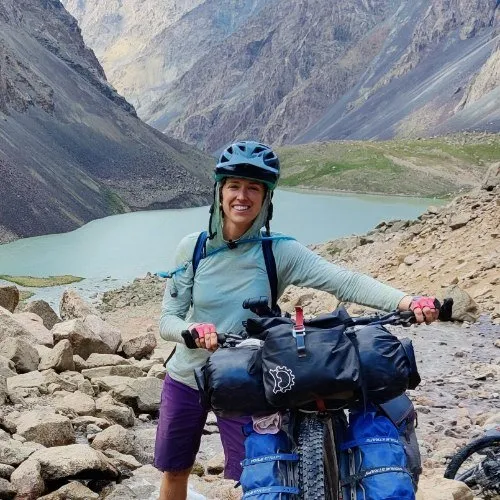
About the Author
Hi there, I’m Alissa, founder of Exploring Wild. I’ve traveled over 20,000 miles by bike and still can’t stop planning my next ride (and helping you plan yours). Pavement and panniers or singletrack and seat bag, I love it all. On my bike I feel free. Learn more about me here .

Bike resources in your inbox?
There’s more where this came from! Sign up here for occasional emails full of inspiration and information about bikepacking and bicycle touring .

Town Day Checklist!
Sign up to receive the free downloadable bikepacking town day checklist to help with your resupply stops:
You’ll also receive occasional emails with other bikepacking and touring resources. I think you’ll like them, but you can unsubscribe at any time.
1 thought on “Bikepacking Shelters: Tent, Tarp, Bivy, or Hammock?”
Morning. I love your article on bikepacking shelters. I have zeroed in on the same dilemma myself; there’s no perfect solution. Thus I’m in development of a shelter I think will be the best solution. I have a US provisional patent. I’d like to discuss it with you for your input. Please reach out. Thanks
Leave a Comment Cancel reply
New in bikepacking & touring.

8 Trail Meal Mix-Ins for More Protein, Calories, and Nutrients

Review: MLD Ultra X Double-Ended Handlebar Bag

Why Single-Sided SPD Pedals Are Perfect for Bikepacking

Loading a Hardtail for Bikepacking: Gear and Tips for a Dialed Setup
Bikepacker's Companion eBook
Your experienced riding buddy in digital form: 140 mobile-friendly pages packed with how to's, problem solving tips, and hard-earned wisdom from the trail and road.
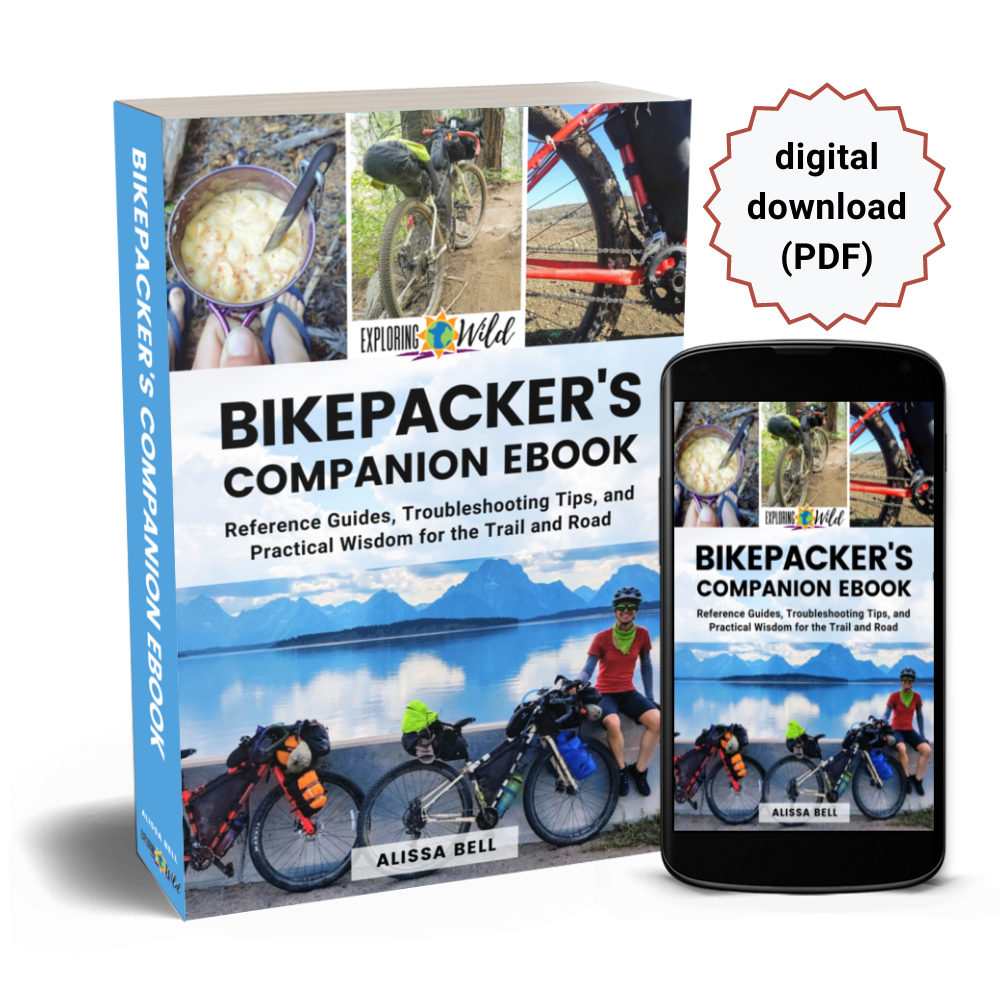
Follow Exploring Wild on socials:
Bikepacking
Backpacking & Hiking
Adventure Travel
Donate to Tip Jar
Adventure in Your Inbox?
Resources and inspiration to support your wildest dreams:
Recent Posts
About Exploring Wild
Privacy Policy
Trust & Transparency Policy
This site participates in affiliate programs, including Amazon Associates.
Copyright 2024 Exploring Wild, All Rights Reserved
Privacy Overview
10% off bikepacking kits.
Enter your email for a 10% discount on all Adventure Kits . Also, bikepacking-related goodies and new posts in your inbox!
Your privacy will be respected and you can unsubscribe any time.
The Best Pop-up Tents We Tested and Recommended
These shelter shades are worth the investment for beaches and tailgates.

Gear-obsessed editors choose every product we review. We may earn commission if you buy from a link. Why Trust Us?
The best pop-up tents are lightweight, portable, and made of UPF (ultraviolet protection factor) materials. While pop-up tents shine in the summer on the beach they’re just as useful during tailgate season and good for year-round park hangs. We even used them for my nephew’s birthday party in the backyard to give the little ankle-biters some shade between playing.
With all my beach days and afternoons drinking in parking lots waiting for a football game to start, I wanted to test out pop-up tents. Tents that were a bit more elevated than the standard budget ones you grab the day before and may not make it past the weekend. I tried a couple of pop-up tents along with Cat Bowen, Senior Editor at our sister publication Best Products , to find models that are durable, easy to transport, and are likely to hold up year after year.
Best Pop Up Tents

Soli Air Canopy
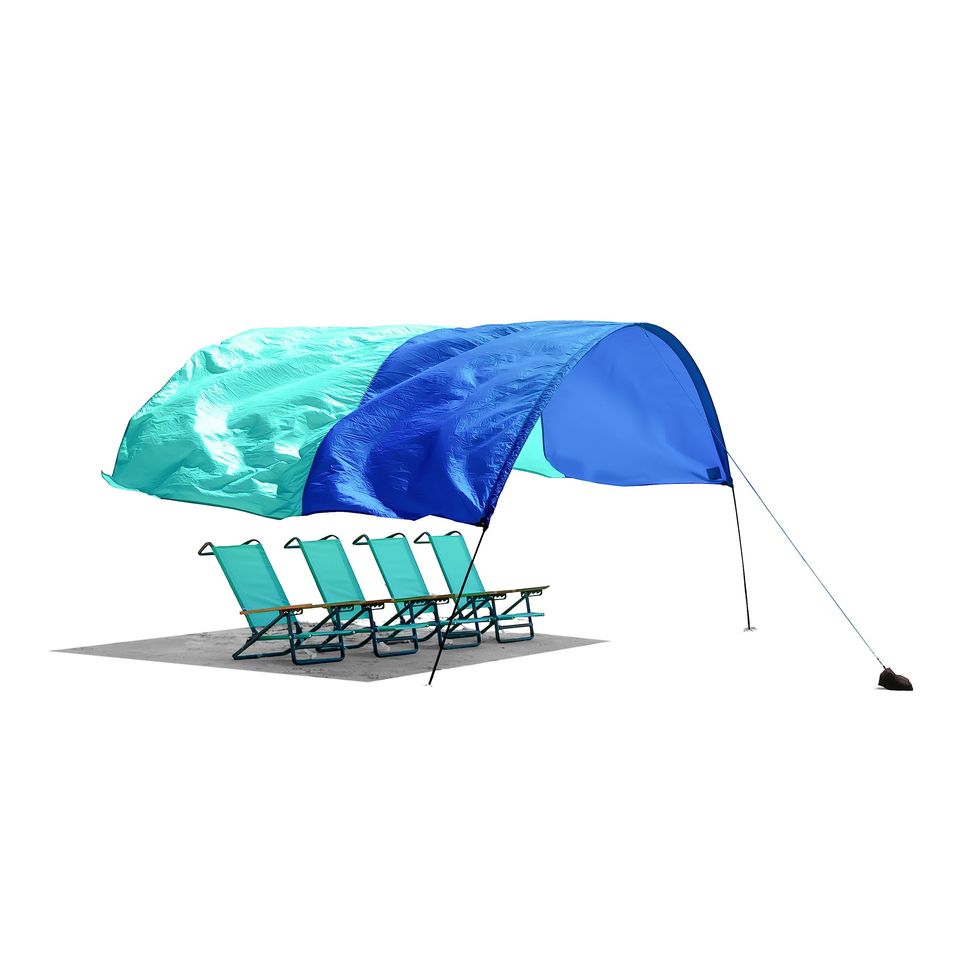
Shibumi Shibumi Shade Wind-Powered Canopy

Veer Family Basecamp
What we looked for.
If you look at a lot of pop-up tents, it doesn’t take long to realize that the vast majority have the same design: an aluminum frame that pinches fingers when it’s folded in and a canvas top that fits around the corners. It’s a design that’s tried and true and we respect the staying power, but we wanted something better.
We searched for pop-up tents that were supremely compact, easy to carry, and a snap to set up and takedown. The tents we decided to test have carrying cases included that are compact and under 20 pounds, whereas traditional pop-up tents can weigh as much as 40 pounds with cumbersome cases up to 4-feet long.
The ones we landed on have different ways of assembling that are a lot easier whether you’re by yourself or with a group. The pop-up tents we tested can be set up using just a couple of tent poles, an included air pump, or even just the wind and some sand in a bag.
What We Found
The pop-up tents we write about admittedly aren’t cheap. They’re upper echelon options that are an investment to use year after year at the beach and outside of the stadium. These pop-up tents are made of durable materials with considered design to make setup and takedown fast and simple. While a traditional pop-up tent is good in a pinch—and we use them frequently as well—these pop-up tents are worth considering and worth the money.
Best Pop-up Tent Reviews

The Soli Air Canopy opened my eyes past the standard folding tents I used for years at tailgates and beach house weekends with family. Whereas other pop-up tents are heavy, cumbersome, and hard to drag in the sand, the Soli is super portable. It packs down neatly into the included backpack and takes up very little space in the car. It’s comfortable to walk down the beach with while trying to find just the right spot.
Setting up the Soli is as straightforward as blowing up an air mattress . It takes a couple of minutes to fully inflate with the included rechargeable air pump and then stake down. The stakes that come with it are quite sturdy—they’re basically large, heavy-duty plastic screws that turn easily into the ground to secure the canopy in place. Even in high winds the Soli stays in place: On a particularly windy day on the beach in the Gulf Coast, our traditional pop-up tent was blown off kilter and we had to jump to grab it before it tipped. Meanwhile the Soli was unaffected as was my cousin who stayed comfortably seated under it, not even putting aside his beer. My coworker Cat also has the Soli and is a pro at setup and takedown.
“We use the Soli consistently whenever we’re bringing our whole family to the beach – which is pretty often.” she says. “ It sets up in seconds, and between the mesh wall and the solid wall, we can configure it for maximum shade and sun filtering.” She likes that there’s enough room to stand (and she’s quite tall) and the overall ease of use. Taking down the canopy admittedly isn’t as easy as blowing it up but still simple. You have to get all the air out so that it can fold and fit back into the backpack as compactly as it came. She suggests laying it flat as you pump out the air, and then roll the arms in toward the center to get the remaining air out when taking it down.
The domed shape provides ample shade for a group of six though the legs come in towards the center top and can encroach on standing room. Luckily, the arms of the canopy are filled with air after all so they’re soft—bumping your head happens but isn’t so much bumping your head as it is pressing it into a pillow. The zip-in shade wall is also handy to have and we used it to shade my nieces and nephew while they napped in the sand. All these included accessories make the Soli well worth it in my opinion. Sure, it’s expensive, but with the bundle you get is everything you need.
Shibumi Shade Wind-Powered Canopy

The Shibumi Shade is tailor-made for the beach which is probably why I see at least eight to ten, no exaggeration, every time I bike to the Rockaways. The sand is dotted with these sea-colored tents that look more like banners flowing in the wind declaring each beachgoers own territory. After a summer and half of eyeing these, I wanted to try one.
The Shibumi is the most lightweight pop-up tent I’ve ever tried. At just 4 pounds, a kid can carry it and it isn’t awkwardly long or cumbersome. It fits in my backpack riding to the beach but I can’t close it all the way. I position it to fit straight up and close the zippers around it so it stays in place—it’s not a perfect fit but most other pop-up tents wouldn’t be able to travel by bike, period.
I was skeptical about setup initially but it was as easy as the reviews I read. You just assemble the single pole (it’s basically a single tent pole) and thread it through the shade; it was easier than expected and didn’t snag along the way and the pole never came apart. Then you fill the carrying case with sand to anchor the arch to the floor which keeps things consolidated but also messy. At the end of the day, no matter how much you shake the carrying case/sandbag, there’ll still be sand in it.
The shade catches the wind pretty fast and only requires three-mile-per-hour winds to be functional. Using this in minimal wind on a partly cloudy day was still a breeze (had to). It provides ample coverage for up to eight people so there was plenty of shade for my three friends and I with beach gear in tow: coolers, speakers, towels, and chairs.
The main complaint with the Shibumi Shade is that it can be noisy as it flaps in the wind—a complaint I frankly don’t understand. Yes, I can faintly hear the tarp in the wind but I’m mostly hearing waves crash, the Bluetooth speaker we brought along with us, and our own conversation more than the Shibumi Shade. Even on a weekday when the beach would be less crowded, it’s still a pleasant cacophony that the sound of the wind in the tarp wouldn’t affect.
I like the ample coverage of the Shibumi and the ease of setup. It’s super lightweight and easy to transport to the beach on a bike. If you’re driving it’ll take up minimal space (virtually none) in a car. While the Soli Air Canopy is easier to set up in terms of steps, the Shibumi is just as fast and simple but requires you to do some of the work instead of an air pump.

I personally haven’t tried the Base Camp but it’s a favorite of Bowen’s. Here’s why:
“The Basecamp is our go-to sun shade. It’s just enough room for two adults and two kids, and putting it up and taking it down couldn’t be simpler. The mesh bottom is a particular favorite bit as sand flows right through it, keeping it off our feet and away from our snacks. The zippable walls allow for tons of air flow while keeping the shade, and since the whole thing is so light, I’ll take it out even if I’m going to the beach alone.
Depending on how precise you are when you take it down, it can be a huge pain in the ass to get it back into its case because the case is sized so specifically for the tent when it’s folded perfectly. My issue with the Soli is that you have to be pretty diligent about getting all of the air out of it before you roll it up.”
More Pop-up Tents We Recommend
We haven’t had a chance to try out these pop-up tents, but based on our intel from getting our hands on several models and from rigorously vetting specs, we stand behind them.

Sun Ninja Beach Tent Sun Shelter
The Sun Ninja is easy to set up and is similar to the Shibumi Shade in that it incorporates sand from the beach to keep it in place.

Sport-Brella Premiere XL Umbrella Shelter
The Sport-Brella is perfect if you’re escaping to the beach for some alone time or for couples. It’s compact and can be setup by one person.

WhiteFang Beach Tent
This tent gives you coverage on three sides, has good venting, and even a ground mat to keep the sand off of you.
Danny Perez is a Commerce Editor for Popular Mechanics with a focus on men's style, gear, and home goods. Recently, he was coordinator of partnership content at another product journalism outlet. Prior to that, he was a buyer for an independent men's shop in Houston, Texas, where he learned all about what makes great products great. He enjoys thrifting for 90s Broadway tees and vintage pajama sets. His spare time is occupied by watching movies and running to impress strangers on Strava.

.css-cuqpxl:before{padding-right:0.3125rem;content:'//';display:inline;} Outdoor and Adventure Gear .css-xtujxj:before{padding-left:0.3125rem;content:'//';display:inline;}

Tested and Reviewed: The Solo Stove Mesa Fire Pit

The 9 Best Yeti Products, According to Our Staff

The Best Gear Totes We Use and Love

Prime Day Yeti Deals 2024

The Best Portable Fire Pits for a Bonfire Anywhere
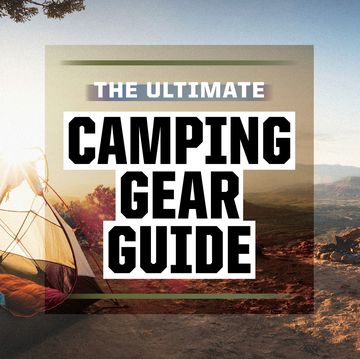
The Ultimate Camping Gear Guide

The Best Solar Chargers to Keep You Plugged In

The 7 Best Inflatable Standup Paddleboards of 2024

Nab Major Deals During Cotopaxi’s Current Sale
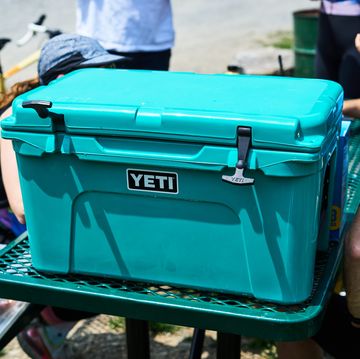
The Best Camping Coolers for Summer Adventures
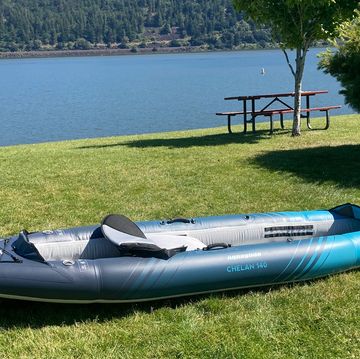
The Best Inflatable Kayaks
Moscow Bike TOur
- Page active

Description
Highlights:.
- Find adventure at every turn
- Take pride in covering Moscow in record time
- Enjoy the icons in style
- Explore off the beaten path routes of Moscow
- Expert commentary as you travel around the city
- Test your nerve, driving on crazy Russian roads
- Get an Endorphin Rush
- Savour delicacies from different regions of Russia in a traditional restaurant
Only in Moscow for a short time and want to get the most out of the city and have fun? Then a 3-hour bike tour in Moscow is what you need! You won’t hear much about Russian history or become an expert on Russian art, but you will experience all the rest of Russian culture! This tour gives you a unique perspective of a little bit of everything in 3 or 5 hours: must-see tourist sights, local hangouts, Russian food, a glimpse of the modern Moscow life, amazing photo opportunities, a bit of Russian history, and a lot of fun!
This is a great opportunity to cut the usual all day tour down to only 3 or 5 hours and get the most out of the city while having fun and being fit in the greatest locations around Moscow!
A bike trip is sure to capture your heart. It enables you to see the heart of Moscow within the Boulevard Ring and to explore some non-touristic areas of the city, to get an image of the city centre and to work out at the same time.
Our tours differ and depend on whether you are interested in city scenery or nature-like landscape. A variety of places in Moscow are great for riding a bike: these are large parks, yards with old mansions, and historical streets in the centre.
Let’s see what’s waiting for you!
Here are 4 suggested itineraries for a 3-hour tour:.
Moscow Bike Route #1
St. Basil's Cathedral, GUM, Kazan Cathedral, State Historical Museum and Lenin's Mausoleum
Revolution Square and Theatrical Square
Bolshoy Theatre, Metropol Hotel, Chinese Wall, State Duma of Moscow
Alexander Garden
The Tomb of the Unknown Soldier, fountains, the Grotto, Central Exhibition center, Kutafya tower, Kremlin wall and towers
Historic City Center
Tverskaya street with its beautiful historical architecture, China town (Kitai-gorod), an old historical area of Moscow
Beautiful City bridge leading to Gorky Park with scenic views of Christ the Savior cathedral and the Moscow River. Explore all the beauties riding a bike along the riverside pathways.
Sculpture Park
Peaceful Crimean embankment is one of the quietest area of Moscow city with painters' works at the Vernisage , close proximity to new Tretyakov Gallery and good views of Christ the Savior Cathedral , Peter the Great monument and the Crimean bridge.
Delicious lunch at a café/restaurant
Arbat street + Stalin Skyscraper
The Arbat has existed since at least the 15th century and is proud of being the oldest surviving street of the Russian capital. Nowadays, it is now an entertainment and event mecca for Muscovites and tourists alike.
Victory park
Get thrilled with 142 metres Obelisk and Victory Park museum , which is an open-air museum dedicated to the Russian victory of 1945, built in 1995 to celebrate 50 years of victory
Moscow Bike Route #2
Pyatnitskaya street - the Tretyakov Gallery - Luzhkov Bridge - the Cathedral of Christ the Savior - the Gogolevsky Boulevard - the Nikitsky Boulevard - the Tverskoy boulevard - Teatralnaya street - the Bolshoi Theatre – the Kitai - Gorod - Red Square and GUM store - the Bolshoi Moskvoretsky Bridge
This route is the best one if you want to see the heart of Moscow. It goes right through the major places of interest and touches upon the most exciting and vibrant areas of Moscow such as part of the Boulevard Ring, which is absolutely loved by everyone.
Cozy streets of Zamoskvorechye will never leave you indifferent. This district has a long and vivid history and is full of old baroque houses along with Stalinist buildings. It includes three theatres, three museums and sixteen churches.
Back in the 18 th century Zamoskvorechye was known as a quiet, country-like land of single-storey houses and conservative businessmen. It remained country-like and is much more filled with business than before, as this area is just right in the city centre.
You’ll learn:
- what was previously on the site of the Novokuznetskaya metro-station;
- names of four abandoned metro stations and how to find these stations;
- what is the oldest bridge among all the bridges in Moscow;
- how old was Pavel Tretyakov when he decided to collect paintings, that are now exhibited in the Tretyakov gallery;
- what does the real form of the Boulevard Ring in Moscow look like;
- what tricks did the Russian government used to save the houses and buildings from bombing during the World War II;
- what unofficial name the Bolshoi Moskvoretsky bridge has
Moscow Bike Route #3
View over the Kremlin - The Luzhkov Bridge – The Strelka Institute – The Muzeon Park – The Gorky Park – Neskuchny Garden – Sparrow Hills – The Luzhniki Stadium - Novodevichy Convent – The Arbat Street – The Gogolevsky boulevard - The Cathedral of Christ the Savior – The Bolotnaya Square
This route includes the most popular city-sights and goes along the Moskva-River. It starts with an observation point, from which you may enjoy the view over the Kremlin, and covers all the most beautiful green areas of Moscow. Historical sites are included into the route so you can feel the historical vibes of ancient Moscow.
- where is hidden an island Moscow;
- where in Moscow you can get printed music of the most sweet masterpieces like “Chocolate waltz” and “Cake-gallop” along with a box of chocolates of the 18 th century;
- why the Luzhkov bridge is also called “the bridge of kisses”;
- the place where the famous Olympic symbol – the Olympic Bear of the Olympics-1980 was flown from;
- the stage where Rolling Stones and Madonna performed when they came to Moscow;
- why the Krymsky bridge was Stalin’s favourite bridge and what musical instrument it represents;
- where living statues in Moscow could be found in 1740s;
- myths and legends about inhabitants of the main building of Moscow State University;
- story about why Sparrow Hills were called that way;
- how Napoleon was cheated when he was going to burn down the Novodevichy convent;
- what was supposed to be on the site where the Cathedral of Christ the Savior is now;
- why Moscow was nearly burnt down in the 15 th century and which role the Arbat street played in it.
Moscow Bike Route #4
Starting with wide area of the VDNKh, you are to learn interesting and fun facts about this spectacular part of Moscow.
- where is a hidden the secret bunker under Moscow (and no, it’s not a famous Bunker 42 everybody knows about;
- why the number of golden statues at the fountain is more than the number of Soviet republics, although it is said to correspond them;
- why one of the Stalin statues was called “matryoshka” (Russian doll);
- what was Picasso’s favourite statue at the exhibition in Paris in 1937.
You’ll see:
- the world’s first light-music fountain that was built in 1950-1954;
- pavilions that symbolize Soviet republics;
- the Botanic garden which is twice as big as the Principality of Monaco;
- the largest green-house in Europe (for the opening day in 1945);
- English garden at the Ostankino mansion;
- Ostankino Tower, one of the tallest structures in Europe;
- the most beautiful flowers in hidden places of the parks.
Biking through VDNKh, Botanic garden and the territory of the Ostankino park will definitely be appreciated by nature-lovers and all those who are keen on speed, who knows no limits and want to explore off the beaten path of Moscow.
We can customize your bike adventure to meet your individual interests.
Our bicycle tour in Moscow gives you a chance to have a s pectacular ride with wonderful photo opportunities and an unforgettable cultural experience!
What you get:
- + A friend in Moscow
- + Private & customized tour
- + An exciting tour, not just boring history lessons
- + An authentic experience of local life
- + Flexibility during the tour: changes can be made at any time to suit individual preferences
- + Amazing deals for breakfast, lunch, and dinner in the very best cafes & restaurants. Discounts on weekdays (Mon-Fri)
- + A photo session amongst spectacular Moscow scenery that can be treasured for a lifetime
- + Good value for souvenirs, taxis, and hotels
- + Expert advice on what to do, where to go, and how to make the most of your time in Moscow
*This tour can be modified to meet your preferences
Write your review
- Ford Mustang Mach E
Ford Mustang Mach-E breaks Guinness World Record after 569 mile-trip on a single charge
The Ford Mustang Mach-E just set a new Guinness World Record after traveling over 569 miles on a single charge. After driving for over 24 hours, the journey was verified by vehicle tracking and fleet management firm Webfleet.
Ford Mach-E breaks Guinness World Record for EVs
“This record is a testament to the hard work and dedication of everyone involved,” Beverly Wise Webfleet, UKI regional director for Bridgestone, said after the event.
Webfleet sponsored the attempt, saying it was “meticulously documented with independently verified video footage, odometer readings, GPS, and battery level data.”
The drivers, Kevin Booker and Sam Clarke, with co-pilot Richard Parker, set the Guinness World Record for the longest journey by an EV on a single charge in a Mustang Mach E.
Ford’s Mustang Mach-E Premium Extended Range (RWD with 18″ wheels), equipped with a 91 kWh battery, boasts a WLTP range of 373 miles. Fitted with Bridgestone tires, the Mach-E outperformed, averaging 6.25 miles per kWh on public urban and rural roads in the UK.
After the Mach-E’s battery reached 0%, Clarke and Booker were able to squeeze out another 21 miles.

The drive took over 24 hours, with 569.64 miles (916.74 km) traveled on a single charge. Wise said the record “represents a significant milestone showing the potential of EVs.”
Top comment by Kris
Why does the article not mention the insanely low <24 mph they were averaging? It would be more impressive if they got the Mack-E to do 400 miles in 6 hours.
Clarke and Booker have broken previous records for energy consumption and fuel economy. Booker said he hopes the achievement “inspires more people to consider electric vehicles for their everyday travel.”

China’s ZEEKR previously held the title with a 563.97-mile trip in Hangzhou last September. Meanwhile, NIO’s CEO William Li live-streamed a 14-hour trip covering 650 miles (1,044 km) in its new ET7 with a 150 kWh semi-solid state battery pack. However, Guinness did not verify this.
With many automakers and startups racing to introduce more efficient battery tech like Lucid and Rivian, expect more attempts at the record soon.
Source: Bridgestone
FTC: We use income earning auto affiliate links. More.

The Ultimate Guide to the Ford Mustang Mach-E

Peter Johnson is covering the auto industry’s step-by-step transformation to electric vehicles. He is an experienced investor, financial writer, and EV enthusiast. His enthusiasm for electric vehicles, primarily Tesla, is a significant reason he pursued a career in investments. If he isn’t telling you about his latest 10K findings, you can find him enjoying the outdoors or exercising

Manage push notifications


IMAGES
VIDEO
COMMENTS
Wild Country Zephyros Compact 2 (UK, £230) Wild Country is the budget marque of the premium British manufacturer Terra Nova. The 1.95kg Zephyros Compact 2 takes more than a little inspiration from Hilleberg's Akto, a favourite high-end tent for minimalists since it was popularised by TV outdoorsman Ray Mears.
Best Bikepacking Tents of 2024. #1 - Overall Best Quality Bikepacking Tent. #2 - Best (Solo) Ultralight Tent for Bikepacking. #3 - Best (Solo) Budget Bikepacking Tent. #4 - Best 2 Person Bikepacking Tent. #5 - Best 3 Person Bikepacking Tent. #6 - Best Bikepacking Tent for the Tropics. #7 - Best Bikepacking Tent for Europe.
Best tent for bike trip and best tent for bike tour for one person: Free standing, double walled, 2 person tent for 3 seasons, weighs between 1.5 and 2.5 kilos and has an inconspicuous color such as green. Such a tent fits centrally on the luggage rack of a touring bike. The space inside is comfortable: there is enough room for the cyclist and ...
MSR Elixir 2 (£340) While the above MSR Hubba Hubba NX is one of the very best tents for cycle touring, the £515 price point might not suit everyone's budget. This is where the MSR Elixir 2 comes in. The Elixir is also a high-quality MSR tent, and the £200 saving is likely worth it to those who aren't too bothered about saving on weight.
Rides: Cotic SolarisMax, Stooge MK4, 24 Bicycles Le Toy 3, Surly Steamroller. Height: 177cm. Weight: 71kg. Get out for a comfortable overnight adventure on your bike with the best bikepacking tents.
The Marmot Catalyst is a high quality tent that is also perfect for those who are balling, er… should we say bikepacking on a budget! This finance-friendly tent offers 3-season use, 2-person capacity, and easy setup. You'll find that the Marmot Catalyst boasts a great amount of interior space for its cost, as well.
Best Bikepacking Tents of 2023. JUMP TO: BIG AGNES COPPER SPUR HV UL / NEMO HORNET / ZPACKS ALTAPLEX / TARPTENT DOUBLE RAINBOW LI / NATUREHIKE CYCLING TENT / BUYING ADVICE Author: Tristan Ridley The Short Version. Best Overall Double Wall Tent: Big Agnes Copper Spur HV UL Best Ultralight Double Wall Tent: Nemo Hornet Best 1-Person Single Wall Tent: Zpacks Altaplex
The MSR Hubba Hubba 3-Person Lightweight Backpacking Tent is perfect for such scenarios. Although made for backpacking, this hardwearing three-person tent is spacious enough for a trip of adventurers to feel comfortable. Plus, the Easton Syclone poles are virtually indestructible. It's fully waterproof too.
Equipping the tent with a pole set, with shorter pole segments. The tent comes ready to mount on your bike with a bike-specific storage system. Packing into two 420D waterproof and durable eVent Dry Sacks with Stretch-Loc Straps for reliable mounting. A free-standing tent weighing 1.9 kg or 4.18 pounds which is a little on the heavier side.
Backpacking tents are often great for the average bicycle tour, or for longer journeys in warmer climates. Typical weight: 1500-2800g. The Hilleberg Staika is not light, but is durable and able to withstand any weather conditions. 4-season: These tents tend to be most suitable for cool-mid climates and adverse weather conditions.
Quick Answer - The Best Tents for Bike Touring. Big Agnes Fly Creek HV UL2. View at REI. The North Face Stormbreak 1. View at Backcountry. MSR Hubba Tour 1. View at Moosejaw. Winterial Single Person Bivy Tent. View at Amazon.
The Dragonfly bikepack tent has a rated weight of 4 lbs., 1 oz—about a half pound more than the Copper Spur and significantly more than the 2 lbs., 15 oz weight of our overall winner the Big Agnes Tiger Wall. The Nemo Dragonfly Bikepacking Tent loaded onto the author's bike.
VANGO-Nevis 200. The Vango-Nevis 200 is a great low-budget tent for bicycle touring. It has great waterproof ratings (6000 mm floor, 3000 mm fly), is lightweight (2kg), and easy to carry around. And it's green—perfect for discrete wild camping! This tent can fit two people with gear, but it won't be comfortable.
Here are a few popular ultralight tents for bikepacking. All weigh in at under 2 pounds. They vary in price from under $300 (Six Moon Designs is a great value) to over $800 (ZPacks is the premium pick). Six Moon Designs Lunar Solo. Gossamer Gear The Two.
Tents for Bike Touring, Bikepacking and In Between. For two people traveling over several months, a solid and spacious tent is a must. There are couples that tour and get by with two-man tents, but in my opinion, a two-person tent is really a one-person tent. ... Perfect Tent for a Big, Loaded Bike Tour. 2,128 grams or 4.69 lbs / 7″ x 22 ...
Both are available as two-person tents and weigh under the three-pound mark. The Marmot Superalloy weighs 2 lb 10 oz / 1080 grams, and the MSR FreeLight weighs 2 lbs 3 oz / 1000 grams (weights include stuff sacks, poles, stakes, cordage and patch kit). It's possible to find a two-person tent that shaves a few more ounces off your load, but ...
Copper Spur HV UL Tent. MSR elixir 1 tent: A livable tent for solo backpackers and campers. The Lynx 1 Tent: Easy Assembly and Ventilation. The Kelty Late Start 1P is a fast and easy to set up tent. ALPS Zephyr. You have therefore made the decision to attempt bikepacking and now need a tent.
The best 1 man bike camping tents. Waterproof Topeak Bikamper alternatives 4 cycling. Ultra-Lightweight one-person tents for solo bikepacking & bicycle touring! The best 1 man bike camping tents. ... Your tent will be your home for most of your trip, especially if it is going to last a while, so you'll want a comfortable and reliable home to ...
Tents are the most common and versatile type of bikepacking shelter. A good tent provides protection from weather and bugs, privacy in busy campgrounds, and a fully enclosed place to sleep and hang out. This versatility and convenience makes tents especially popular with long-term bike travelers, families, and many couples.
In the end, Maple and his titanium Bearclaw Beaux Jaxon bicycle dodged the last of the cacti and copious number of rattlesnakes and arrived in Antelope Wells at the U.S. - Mexico border on July 13 ...
Sign in to get trip updates and message other travelers.. Moscow ; Hotels ; Things to Do ; Restaurants ; Flights ; Vacation Rentals ; Travel Stories
The Soli Air Canopy opened my eyes past the standard folding tents I used for years at tailgates and beach house weekends with family. Whereas other pop-up tents are heavy, cumbersome, and hard to ...
Moscow Bike Route #3. View over the Kremlin - The Luzhkov Bridge - The Strelka Institute - The Muzeon Park - The Gorky Park - Neskuchny Garden - Sparrow Hills - The Luzhniki Stadium - Novodevichy Convent - The Arbat Street - The Gogolevsky boulevard - The Cathedral of Christ the Savior - The Bolotnaya Square.
Sign in to get trip updates and message other travelers.. Moscow ; Hotels ; Things to Do ; Restaurants ; Flights ; Vacation Rentals ; Travel Stories
FIELD TRIP Lyrics: This ain't cheddar, this quiche / Got a bitch to ride or die / Ride it just like it's on my bike (Woah-woah) / Do this all to circulate / Fuck her, just feels like you're like
Vnukovo. Vnukovo District is an administrative district of Western Administrative Okrug, and one of the 125 raions of Moscow, Russia. Most of the district is occupied by Vnukovo International Airport, a small adjacent residential area, and a separate residential micro-district. Photo: Ssr, CC BY-SA 3.0. Ukraine is facing shortages in its brave ...
Dan Gentile is the senior culture editor at SFGATE, where he has covered music, movies and San Francisco subcultures since 2019. Previously he was the founding editor of Thrillist Austin and ...
[Intro] Wheezy outta here [Chorus: Don Toliver] Got a bitch to ride or die Ride it just like it's on my bike Do this all to circulate Fuck her, just feels like you're like Throw it just so I can ...
Belgium's Remco Evenepoel made history on Saturday, becoming the first male cyclist to claim gold in both the road race and time trial at the same Olympic Games. Paris, a city well-versed in ...
Meanwhile, NIO's CEO William Li live-streamed a 14-hour trip covering 650 miles (1,044 km) in its new ET7 with a 150 kWh semi-solid state battery pack. However, Guinness did not verify this ...